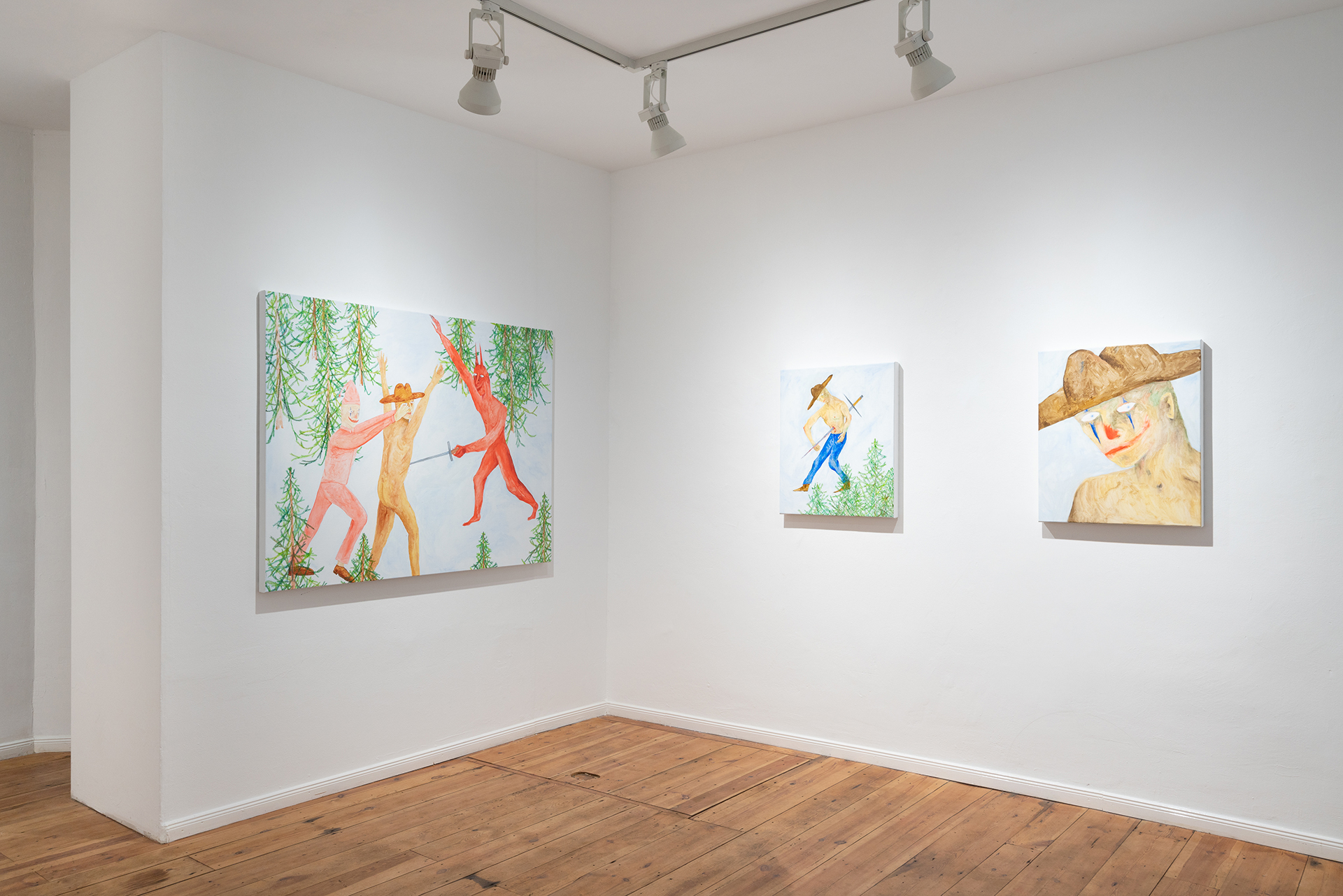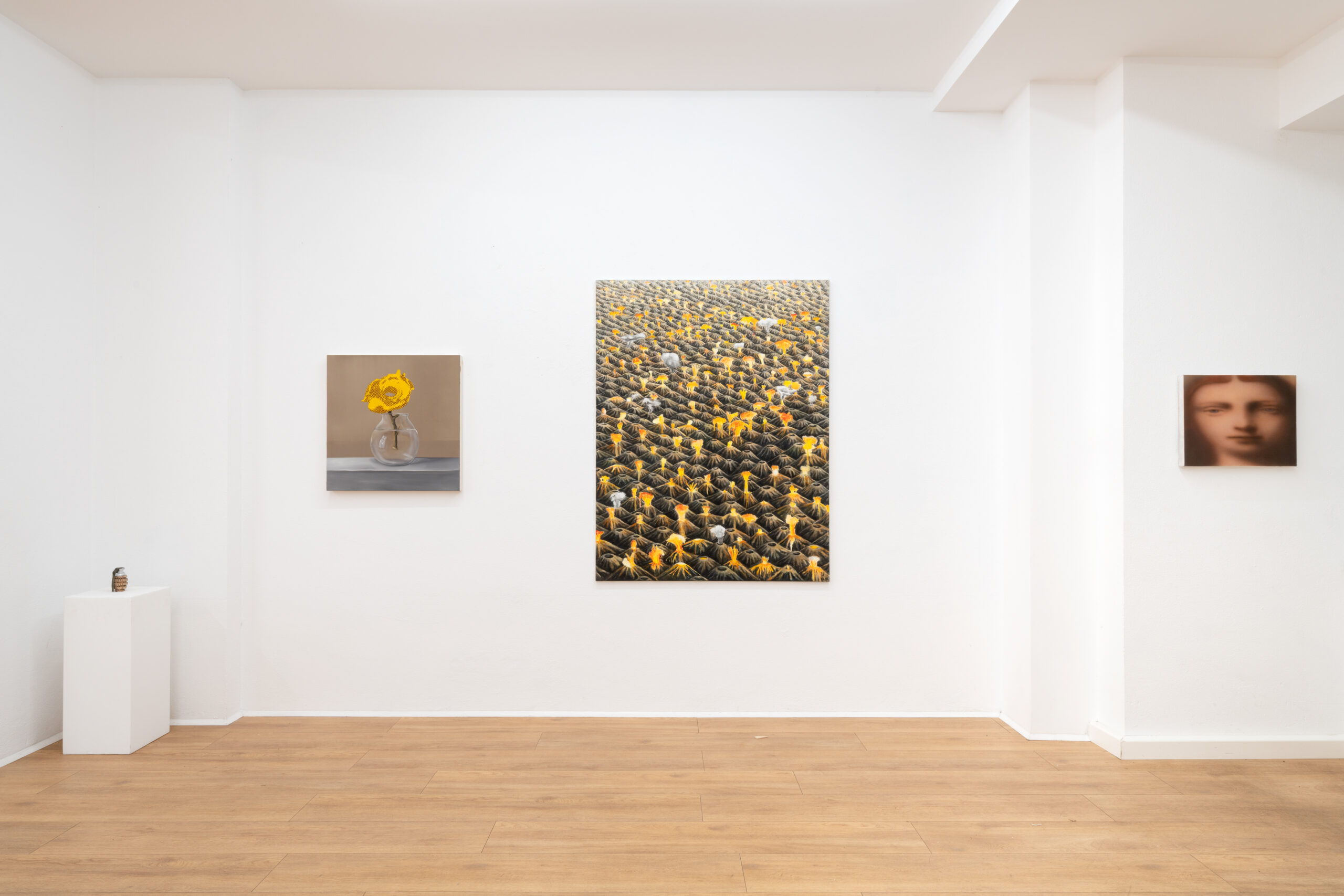
Welcome to Weserhalle Art Auction 12, co-curated by artist Jochen Mühlenbrink and art historian Lena Winter. This week-long auction is divided into two parts:The physical exhibition at Weserstraße 46 allows you to experience the artworks in person. The digital aspect allows you to bid on each of the artworks in our online auction here at weserhalle.com.
The auction ends June 30th, 8pm CET. The auction is now closed.
Artists
Alexey Shahov
Amer Al Akel
André Wendland
Andy Kassier
Anna Lisei Math
Anna-Maria Podlacha
Anton Kalmysh
Armin Pichler
Aske Alexander Hvidtfeldt
Azim F. Becker
Bella Bram
Björn Knapp
Camille Theodet
Christian Retschlag
Dupont Clément
Friedrich Herz
Jan Babucke
Johannes Unger
Julia Obermaier
Justus Johann Köbsch
Kevin Lüdicke
Nari Jo
Peter McRury
Roman Manikhin
Ross Hansen
Sabine Dietrichkeit
Simon Gilmer
Simone Rudolph
So-Yeon Kim
Sophia Domagala
Sophie Olive-Kuipers
Tom Früchtl
Yewon Lee
Photos @ dotgain.info
Guest Curators
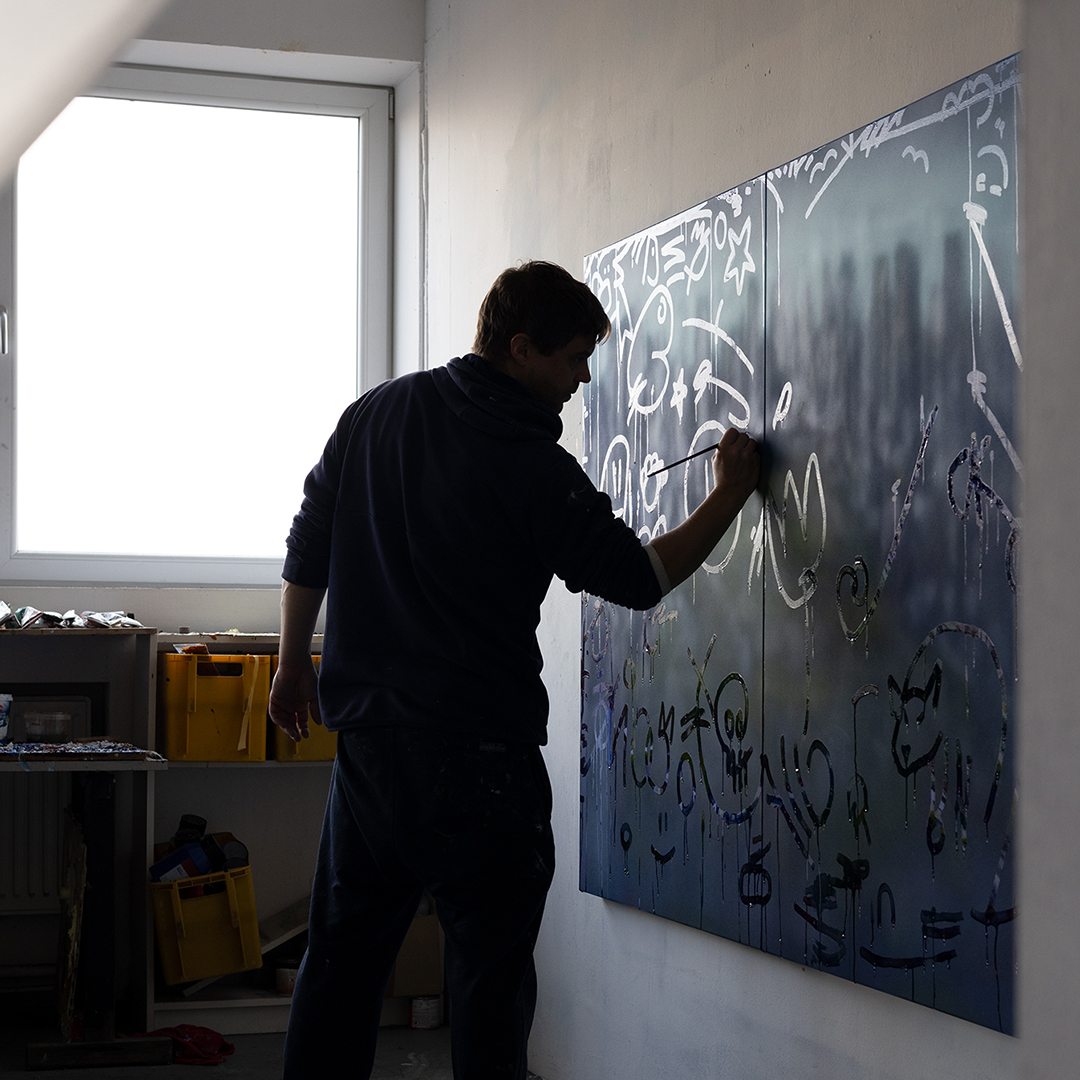
Jochen Mühlenbrink (DE, 1980) studied painting at Kunstakademie Düsseldorf (2001-2006). Known for his Trompe-l’œil technique, Mühlenbrink leans on theories to investigate reality within the aesthetic principles of modernist painting and classical art. Since 2005 his work has been exhibited in galleries and institutions in Germany, across Europe, in Asia and North America. Jochen Mühlenbrink is represented by ASPN, Leipzig (DE), Galerie Thomas Fuchs, Stuttgart (DE), Gerhard Hofland, Amsterdam (NL), Gether Contemporary, Copenhagen (DK) and Long Story Short, NYC (USA). Link.
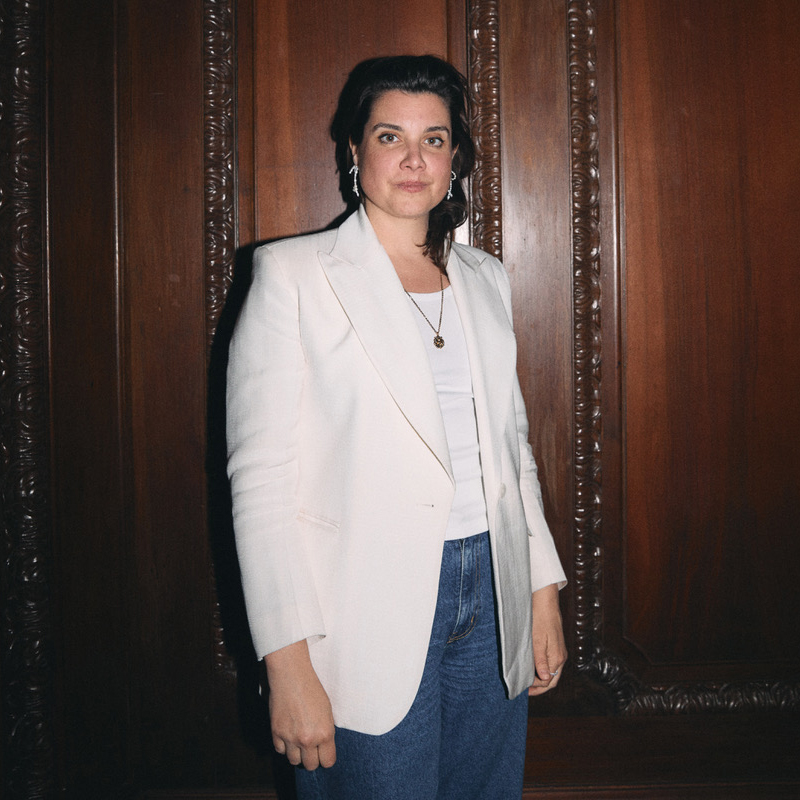
Lena Winter grew up in an artistic household. After studying art history in Cologne and Zurich, she worked for the renowned German auction houses Grisebach and Ketterer for around ten years. She has been an auctioneer since 2016. In 2021, she established the art trading platform misa.art together with König Galerie. Together with Sebastian Greber, she has been the head of Auktionshaus am Grunewald, which focuses on contemporary art, since the beginning of 2023. Link.
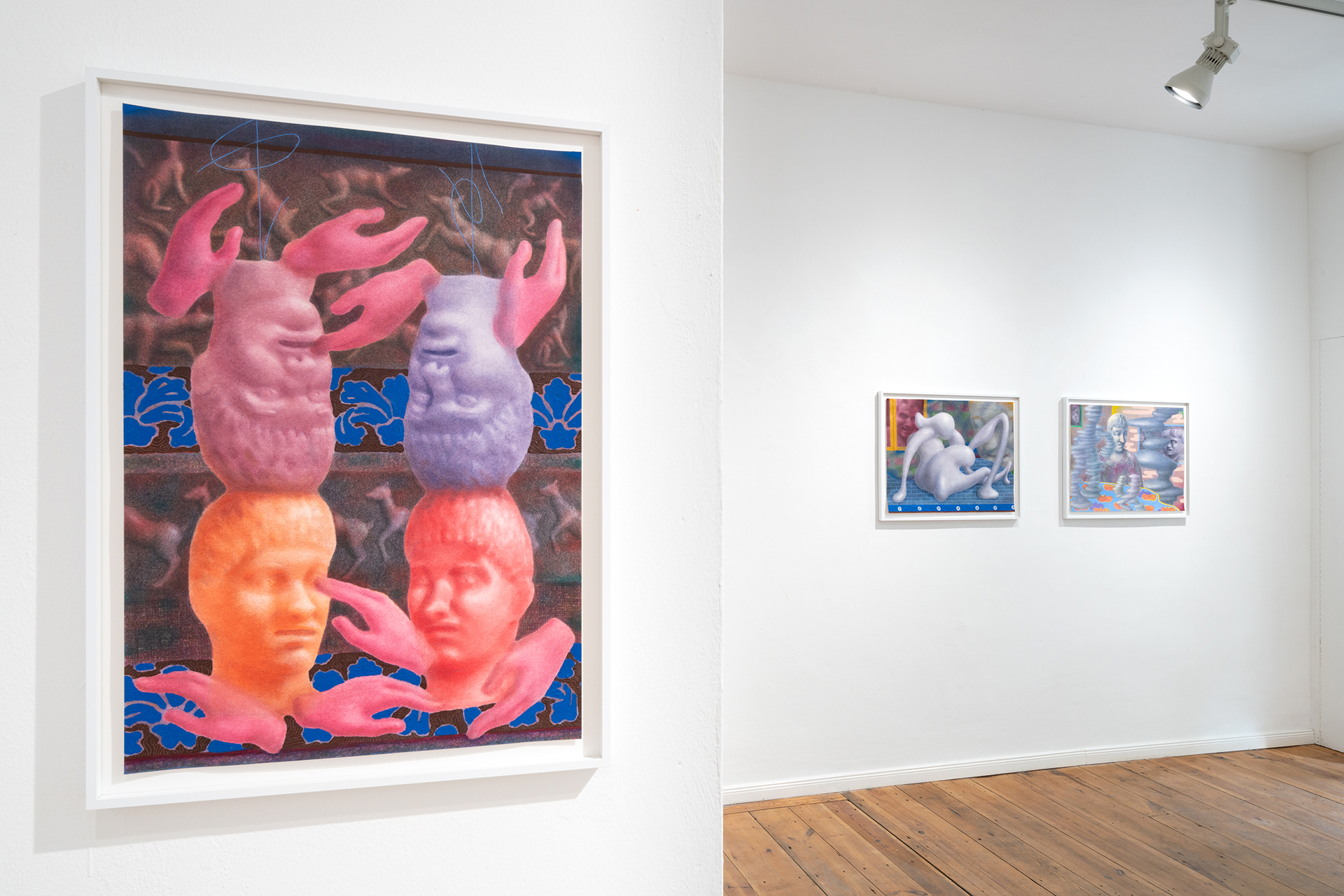
Lucas Kaiser’s debut solo exhibition at Weserhalle, titled “Appropriate Illusion,” invites viewers to immerse themselves in the intricate relationship between figure, pictorial space, and observer. This exhibition culminates Kaiser’s profound engagement with sculptural traditions and the act of “creating figures.” Drawing on both historical and contemporary influences—such as Hans Arp, Anna Uddenberg, Barbara Hepworth, Bruce Nauman, Donatello, Louise Bourgeois, Brancusi, Tony Cragg, and Henry Moore—Kaiser reimagines virtual concepts into tangible forms.
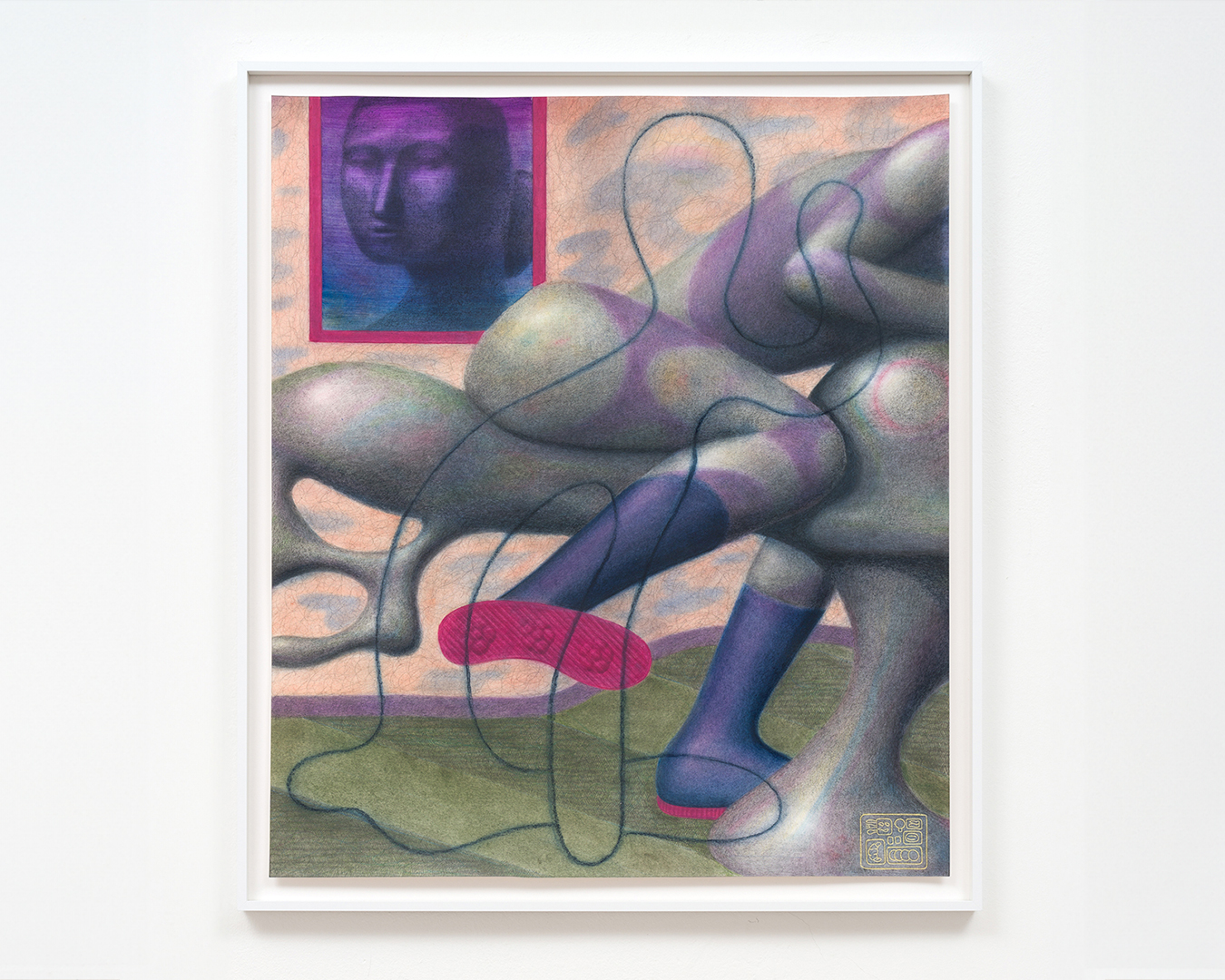
Kaiser’s work oscillates between two-dimensional representations and simulated plasticity, forging a space that blurs the lines between abstraction and naturalism, and identification and empathy. A central theme in his work is guiding the viewer along the threshold of empathy, with a particular focus on the concept of the “uncanny valley.” This theory posits that as a human-like figure becomes more realistic, it can elicit feelings of eeriness and discomfort when it is almost, but not quite, lifelike. Kaiser’s pieces navigate this delicate interplay of proximity and distance, inviting viewers to experience both connection and detachment.
To enhance the viewer’s need to constantly reassess their position relative to his work, Kaiser builds layers into his artwork. These layers add depth and complexity, compelling continual engagement and perspective shifts. They also slow down the viewing process as only after a certain amount of time the details start to unfold and the viewer needs a moment to unpack the work.
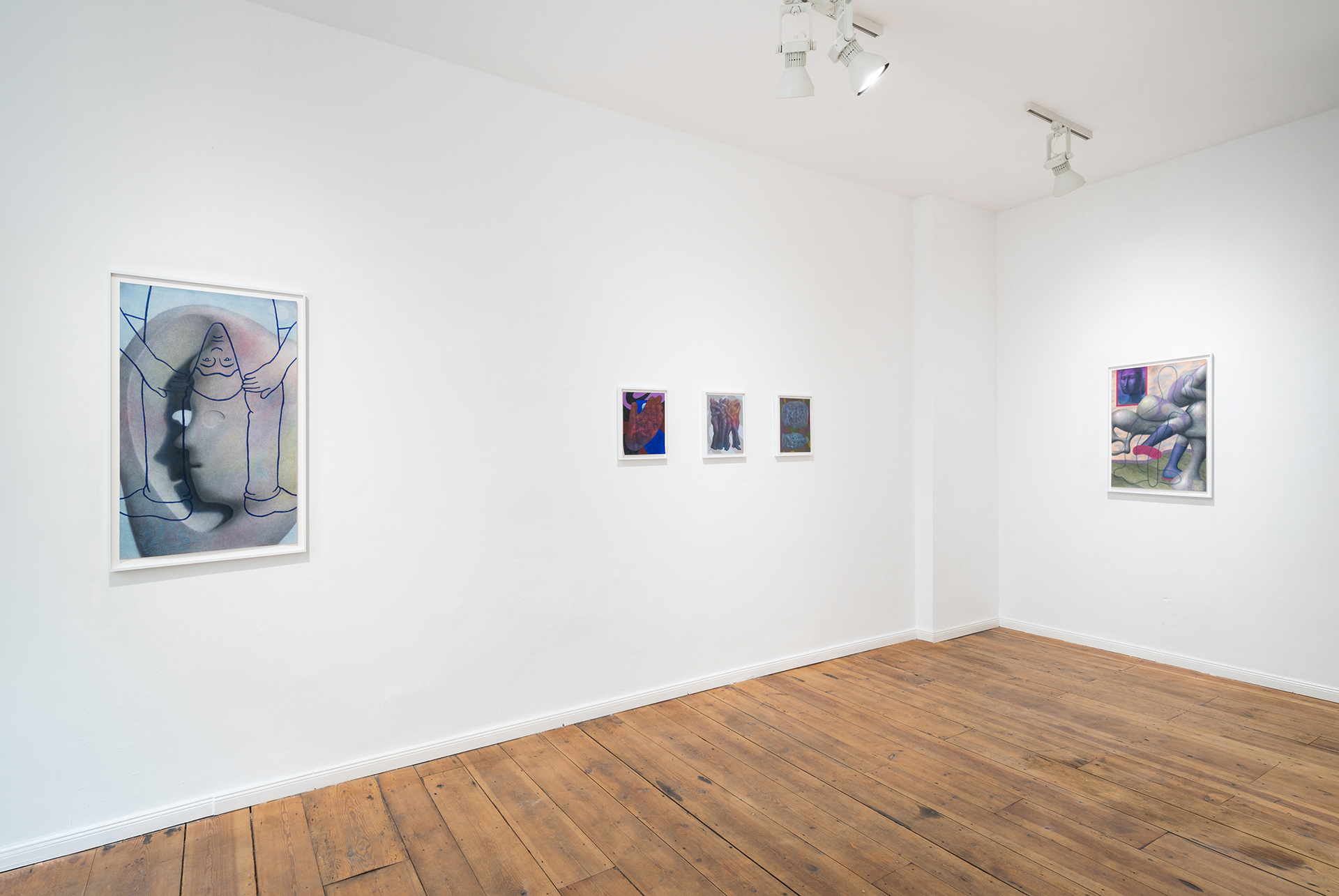
Kaiser examines several dichotomies in his work: figures as illustrations (e.g., pictograms) versus figures as simulations of counterparts with plastic traits; figures as stimuli for form-finding versus figures as depictions of potentially real persons; two-dimensional versus three-dimensional representations, images as windows, and explorations of the trompe l’oeil technique; and when a figure becomes something associated with humanity. His fascination lies in juxtaposing the uncanny with aesthetic allure, built on a meticulously calculated relationship between the figure and pictorial space. By engaging with clichés of the idyllic, he seeks aesthetic innovations through formal interventions that disrupt familiar realms.
“Appropriate Illusion” offers a profound reflection on the artistic process, urging viewers to question their perceptions of reality and representation with the concept of the “figure” at its center.
Lucas Kaiser is based in Leipzig, born in 1994. He graduated from HGB Leipzig and is known for his exploration of the contrast between the uncanny and aesthetic in his work. Kaiser focuses on clichés associated with the idyll, aiming to reinvent them through formal interventions that disrupt familiarity. He is interested in the polarity between generic and special, influencing his approach to figure representation. Kaiser hand-draws his figures, deliberately contaminating the generalisation of the human figure in his art.
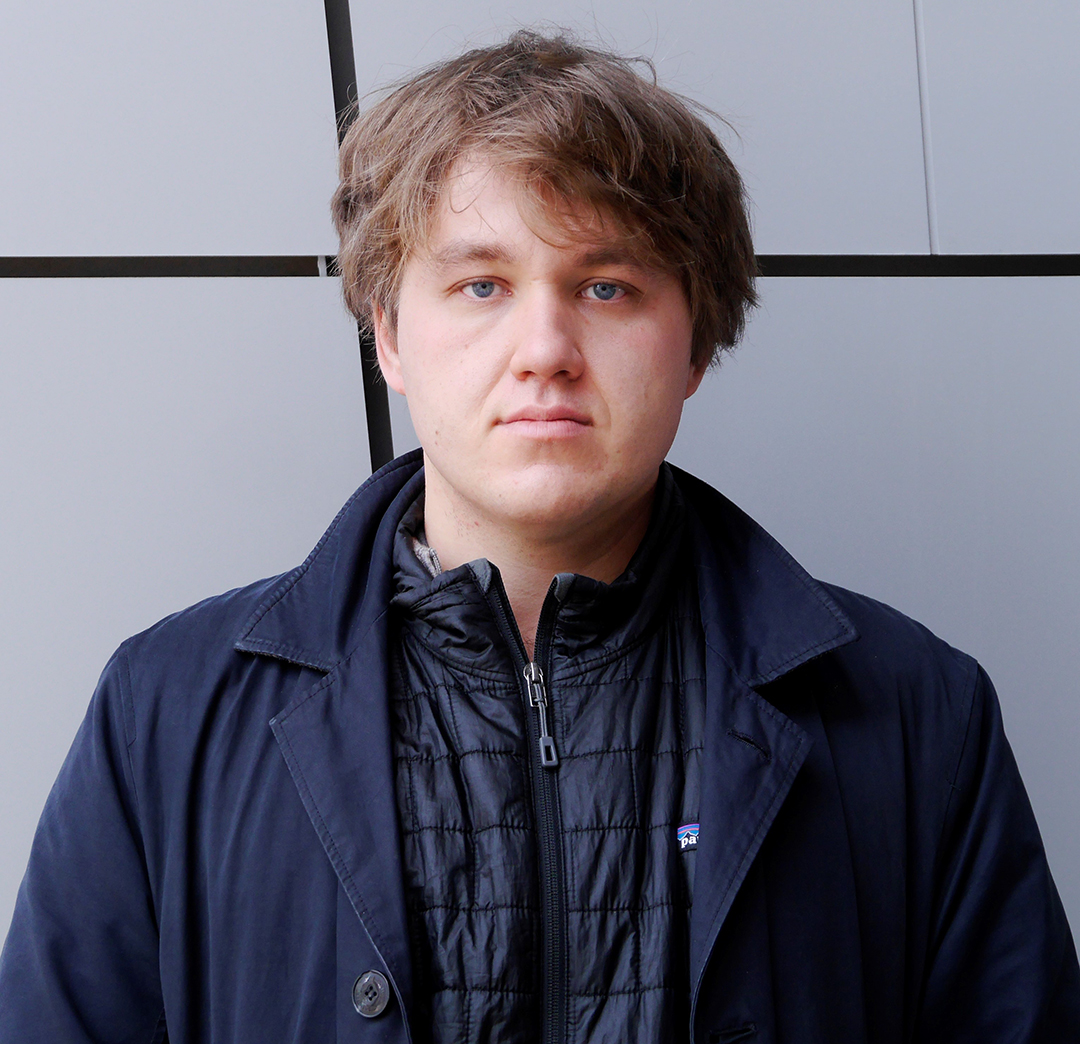
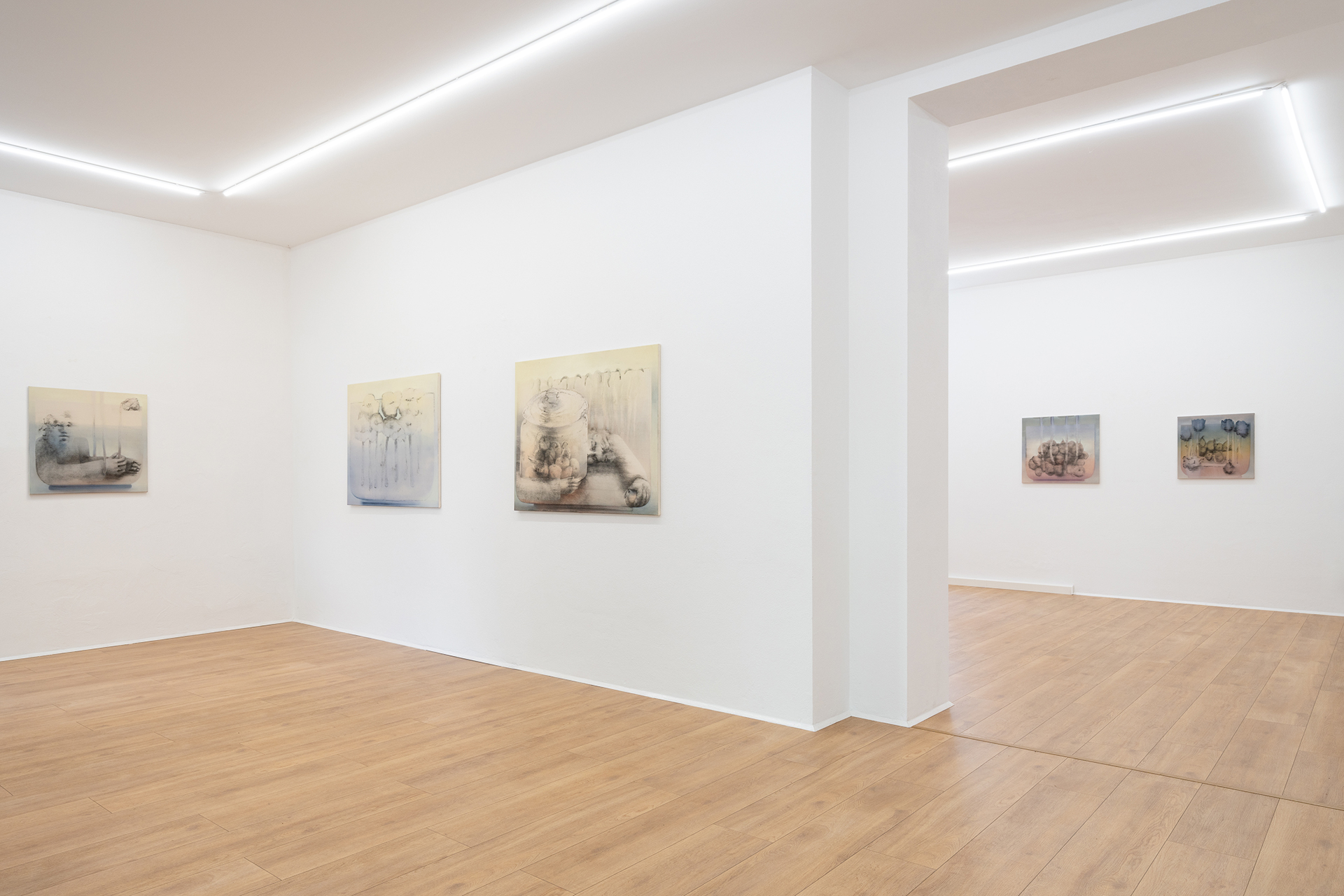
We find ourselves in a world that builds the perception of its realities around an assumed set of boundaries and lines. We are constantly reminded to consider these lines, walk along these lines, accept not to overstep these lines. Yet, we frequently find ourselves compelled to resist them.
Emil Urbanek’s work invites us to play with the lines of containment, offering an imaginative worlding where we seek the intimate corners of existence. Every subject and form allows us to explore powerful attachments. The scenes they show us are soaked with a strange calmness. Vases and forms, shoulders and arms, pears and plants intertwine, creating a world of shifting perspectives that play with the sharpness of surface.
In their second solo exhibition at Weserhalle, Urbanek opens portals to a realm where forms and ideas converge in unexpected ways. The vase serves as a reliable form that provides support to figures, flowers and subjects. At the same time, it plays with the canvas’ inherent lines, inviting our imagination to weave scenes beyond. The flowers, sometimes faintly outlined and barely perceptible, are the only elements that extend the contours of the vase. It is not always clear what surrounds the scene. Color gradients may suggest water. Similar to the photographic lens, the vase holds a delicate balance between what is seen and what remains hidden. Fragile is not the scene, but what we allow ourselves to see, for what we see can easily disappear.
In one painting that stands out, the vase is empty. Depicted through a mere shift in gradient it is a reminder for absence. An absence that holds space for contemplation upon the fleeting nature of moments. Perhaps this confrontation with a void also carries a fear of the potential impermanence of plants. The pears, a recurring element in Urbanek’s work, impart trust and reliability on the other hand. It is not clear whether we are invited to take a bite – perhaps in the past, perhaps in the future, perhaps not yet. As for now, they simply lie there, together, sometimes with twisted and bizarre shapes, nestling against each other, reflecting in glossy surfaces. It is an invitation to allow closeness. An invitation to accept affection, from oneself and one’s surrounding.
In another painting we see pears collected in a glass within glass. In their interplay with the figure, forms and plants, the pears unfold napping as an almost curated practice. This interplay transforms into a mystical threshold between the sharp and gentle contours of memories. As a person at rest gently embraces the jar of collected pears, the plants too, momentarily release into a posture of ease, napping on the rim of the vase: who is sleeping; who is holding whom while asleep; who wakes up first?
Being-with these paintings, we are not simply spectators, amused by the depiction of a small world. We are part of a collectively imagined whole, emerging from the vibrant interplay of many small granulations. A confrontation with forms of affection and blur, material softness, and glassy sharpening pushes our boundaries beyond a detached and closed self, towards curiosity for the discovery of a concealed and yet, spreading place. Does this evoke a feeling of overwhelm? Put your head down. Take a nap.
Text by Lilian Mauthofer
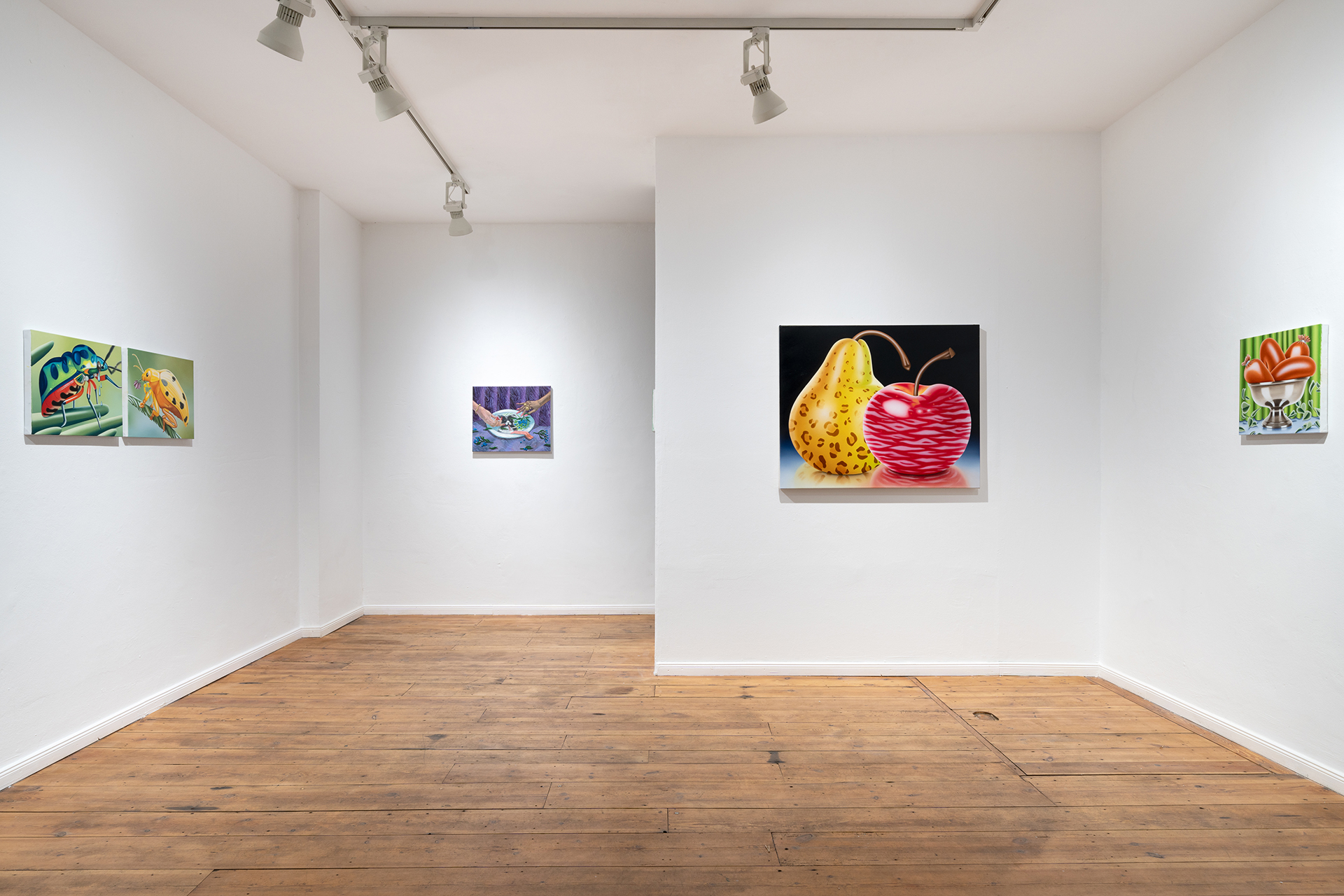
Broschár does Ukkonen, and Ukkonen does Broschár. For this unusual joint exhibition two painters are inspired by, influenced by, steal, borrow, copy, reinterpret, recreate, appropriate and pay homage to each other’s work. While remaining true to their own approach in terms of artistic process, techniques and style, the motif and composition reference existing works by the other. To rule out any influence, the paintings selected will remain secret until the opening.
Mona Broschár and Heidi Ukkonen knew of each other long before their first encounter in Paris in 2021. Both artists had been admiring their respective works from afar, following each other’s social media accounts. The title Only Fans is nod to this virtual courtship, a voyeuristic exchange that takes place without any physical contact. But the reference also applies to the reciprocal infusement – each artist taking possession of a piece of the other, deepening their connection and understanding of each other in the process.
Despite the obvious differences, there is a unifying quality to their work. Firstly, the humor: a love of the absurd, the joy of the clashing the seemingly incompatible. Then the almost intrusive materiality of things, the way their surfaces thrust outwards, imposing themselves on the observer. Lastly, a predilection for the abysses of consumer culture, the seductiveness of objects – candy-coloured, female-coded and fashionable. Maybe it is best described as a vibe, rather than an aesthetic: a dreamy abundance, that appears quirky and girlish in one moment, and monstrous and obscene in the next.
Like in any good relationship, both artists have characteristics the other is lacking. Mona Broschár, who studied painting and printmaking at the Academy of Visual Arts in Leipzig and the Camberwell College of Arts in London, works thoughtfully and precise. Each canvas must be perfectly measured, her compositions are painstakingly created with layers upon layers of oil-paint, leaving little room for alterations or last-minute decisions. Broschár’s painting appear corporeal, almost like sculptures, while Ukkonen’s work can be compared to the expressionism of Edvard Munch. Her process is impulsive and immediate. She prefers fast-drying acrylic paint, but also works with egg tempera and pigments. Originally born in Sweden, Ukkonen has since relocated to Antwerp, where she studied at the Royal Academy of Fine Art. The city’s deep connection to the glamorous world of high fashion shines through in the fantastic garments of her figures.
In the end, Broschár’s lush still life’s and Ukkonen’s elegant daydreamers represent two sides of the same coin: chaos and order as escape strategies in a disturbing present. The question of the right measure arises in many forms. Do the glittering offerings of consumer culture give cause for joy or rather despair? When will we have had enough? For the artists, the challenge lies in making the other’s work distinctly their own, while neither compromising their unique vision, nor erasing its origins.
Text by Diana Weis.
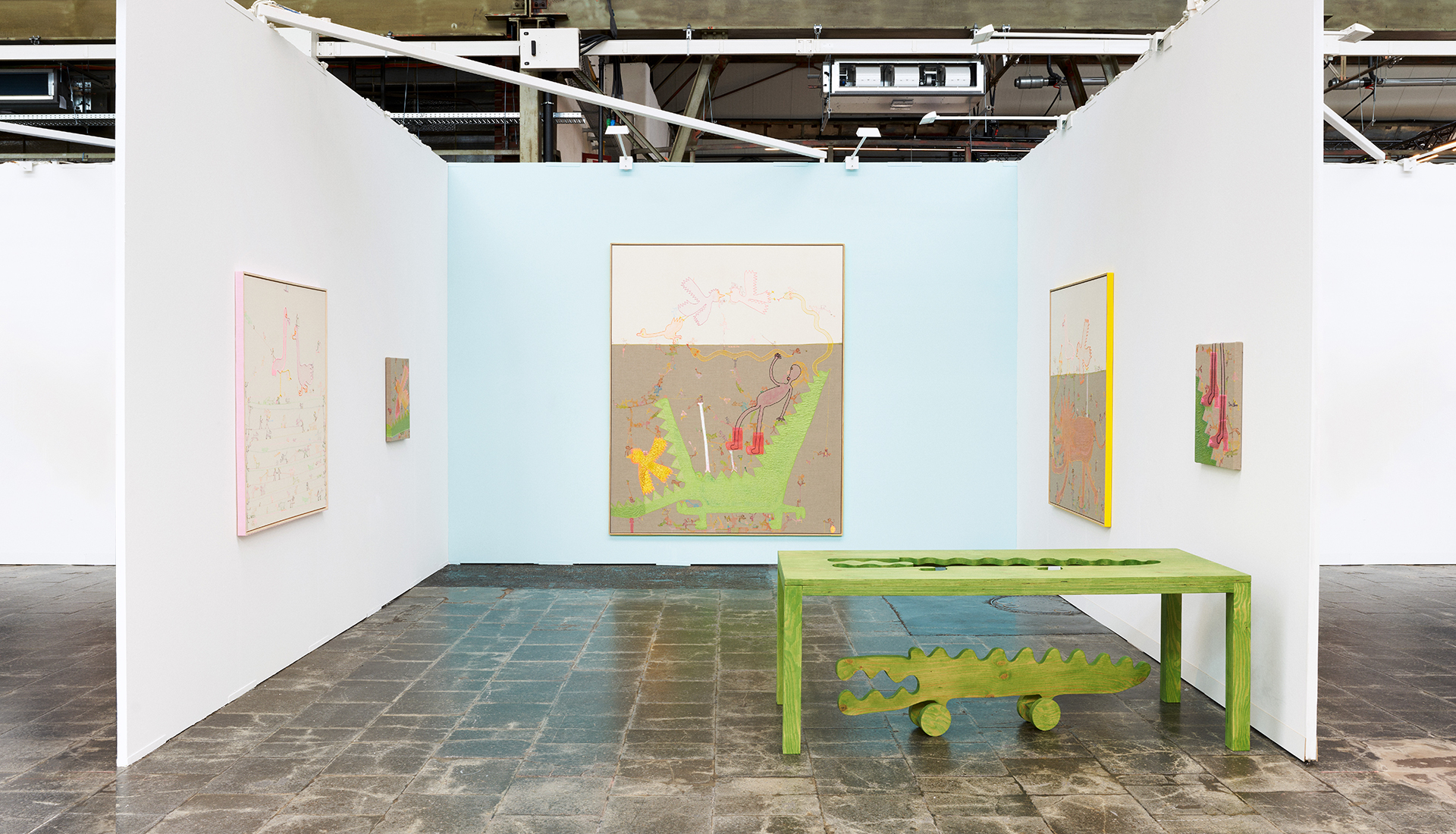
We are excited to announce that we will be displaying the artwork of Georg Haberler at this year’s Art Düsseldorf. Animals, objects, and architectural structures bustle about in Haberler’s signature imagery, embroidered with black and white thread on unprimed canvas. Visit us at booth D05. We hope to see you there!
From art-dus.de;
“Discover art, artists, and galleries, and engage in discourse and discussions with us. Since 2017, we have aimed to be a leading platform for talents and a diversity of perspectives of backgrounds; whether young or established, artists or gallerists, collectors or curators, the fair offers a stage for progressive positions, relevant ideas, and engaging concepts. This is reflected not only in the exhibitors’ programs but also in the fair’s digital presence and in all events staged in addition to the gallery presentations.”
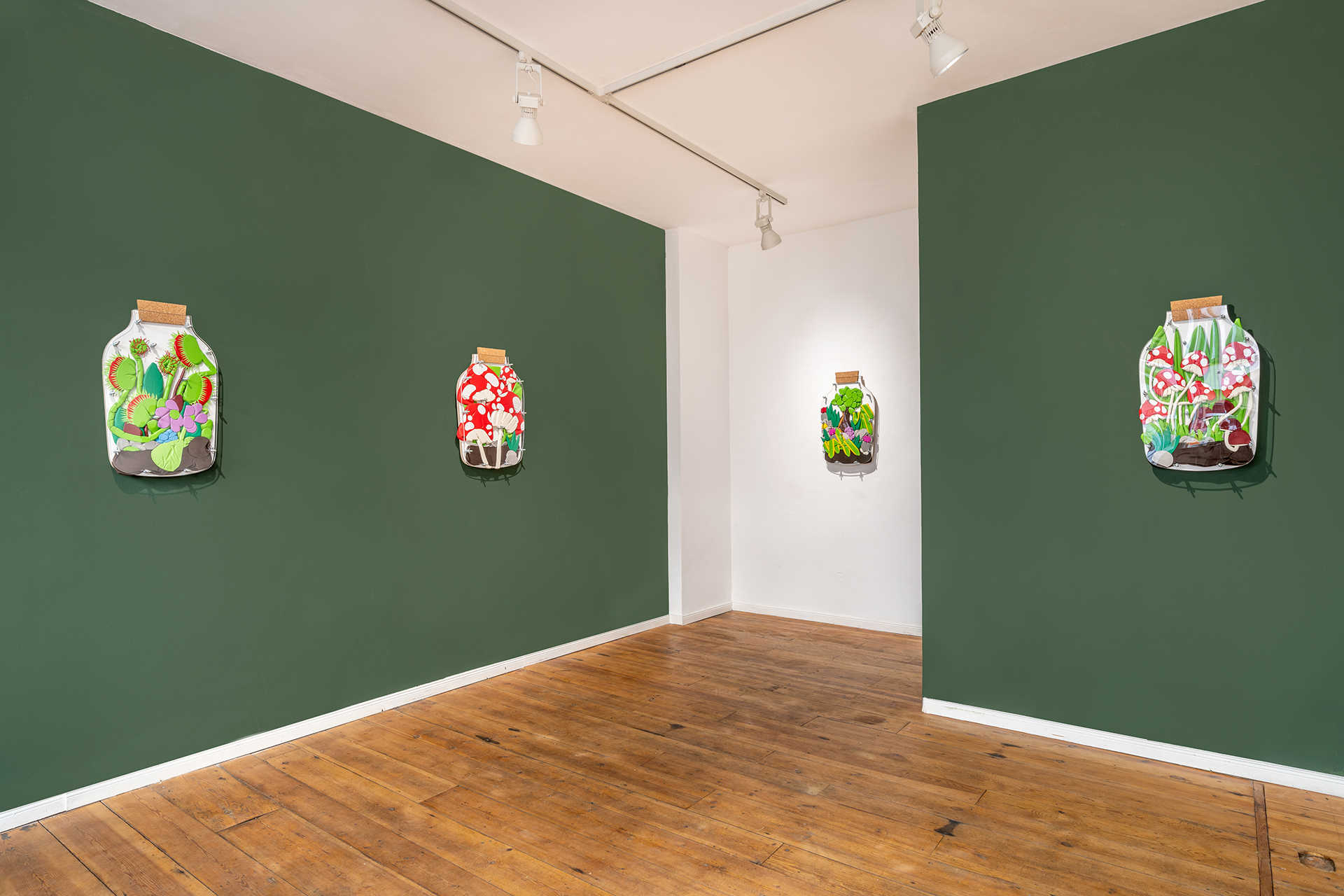
Terrariums, a magical accident of the Victorian era, act as Ant Hamlyn’s main point of reference for this series of work. Creating ‘miniature worlds’, Hamlyn captures these ecosystems, as botanicals hand-sewn of soft velvets and polyurethane-coated fabrics are pressed tightly behind Perspex. Simultaneously, they appear to lean into and repel their confines. Paused in motion, they threaten to spill from the sides but instead are caught, teasing the edge of a petal or limb.
Chilling. Freezing. Sugaring. Salting. Canning. Pressing. Pickling. Sealing. Grasping something in the act of turning – right at the peak of its existence. The sweetest taste of the ripest fruit, the perfect bloom of a flower or unfurled leaf. To press pause on perfection is an endeavour of human desire that unrelenting persists. The problem with preservation is that in pursuing it, we can alter what we seek to capture, turning it sickeningly sweet or salty with brine. Retaining its condition at the cost of its presence, beyond touch or smell, held apart from us to maintain its perfection.
In constructing these little worlds. Meticulously sewn succulents, fungi, and flowers bow into and under one another across the works, reaching outwards in the suggestion of an endless expansion. In one work, a collection of carnivorous plants (Venus fly traps and sundews) push back at their encasement. Flytraps are pinned at their most animated and vulnerable. Mouths perpetually a-jar in an uncanny stillness. Behind the Perspex, the texturally complex work is held back from touch. Sharp cactus spines made of wooden sticks protrude from the sewn forms, but the threat of their spikes is dulled behind the screen. These contrasts are ever-present in Hamlyn’s work, spikey and smooth, joyful and morbid, the garish colour of PVC against the seductive quality of velvet.
The works explore terrariums as domestic objects but also delve deeper into ideas of temporality. Preservation, the action of pause, makes the presence of time even more persistent. In refusing mortality, the ever-looming threat of death presses closer. The works encapsulate the human need to keep things, to maintain beauty and to halt the passing of time. Hamlyn’s bright fabrics create a cheerful façade that is underpinned by a longing for a moment that doesn’t exist.
Text by Olivia Rumsey
Photos by dotgain.info
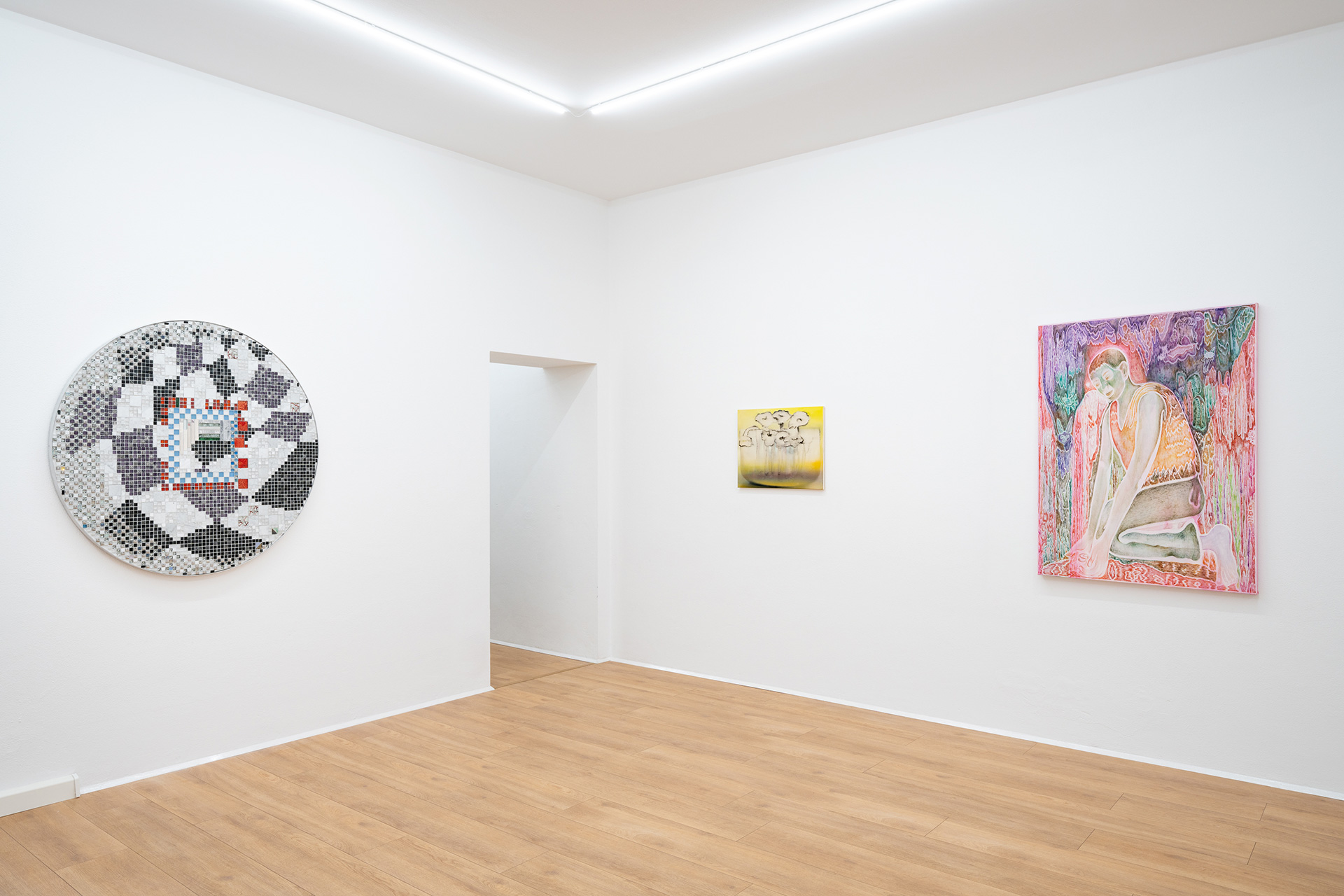
This group exhibition aims to explore the notion of the ‘in-between’: in-between states of consciousness, states of energy, reality, and imagination, the past and future. It is in this spirit that the title of this exhibition is a sound;
This title is our clumsy attempt to capture this liminal space—a challenge that defies the constraints of language as we usually use it, forcing us to come up with our own approach. Not only did we think this might make for an intriguing title, but it also highlights the difficulty of grasping or articulating this intangible place. However, where our title for this group show possibly fails, we feel that the artists’ artwork, through their materials, technique, and focus, succeeds. The works, in their individual styles, have a common trait in that they exude a tension that allows the spectator to move between definitions, experiencing a space that can feel familiar yet also foreign. The exhibition showcases a diverse range of artistic styles, spanning from abstract and figurative to semi-sculptural works. Featured artists include Jung A Lee, Sacha Grandemange, Emil Urbanek, Kolja Kärtner Sainz, Line Lyhne, Maxim Brandt, and Eliza Wagener.
The works by Jung A Lee approach the in-between states of consciousness or unconsciousness through a dynamic process. The artist works mostly in the mornings, immediately after waking, in an attempt to capture the reminiscence of a sleep state. Using wax pastels allows her to work intuitively and have an unfiltered extension of her mind. A mix of abstract colour fields and plant-like objects sprawl across the canvas, and through her choice of colours and contrast, she creates an intricate scape of layers that draws the spectator into the work.
In Eliza Wagener’s work, intuition also plays a leading role. She initially works with highly water-based paint, letting it flow across the canvas, creating an abstract base from which hazy silhouettes of intertwined bodies emerge. The figures and animals in Wagener’s work seem to have come forward only for a short glimpse, ready at any moment to fade back into their environment.
A similar approach to the interplay of abstraction and representation can be found in the works by Kolja Kärtner Sainz. The artist seeks an ideal intermediate state where representation and abstraction can coexist. Deeply exploring this intersection, he tries to freely interpret states of nature and the artificial, not to capture rigid moments, but rather blurs, movements, and changes in perception. Working with oil and ink in many layers, his paintings appear to render the conflicting forces of abstraction and figuration intertwined in futuristic states of never-ending change.
This sense of restlessness draws parallels to the works by Emil Urbanek. Their work evokes a sense of timelessness through their characteristic blurry style. The surface of the works suggests a graininess reminiscent of analogue photography paired with an exploration of vanitas subjects. This nostalgia is countered by details such as color and composition choices. In their work, the flowers are seemingly floating in a vase that seems much too big to hold them. Yet they levitate unbound by time and space. This depiction also speaks to their continuous exploration of bodily autonomy and the right to refuse definition through one’s environment.
In Line Lyhnes work the motifs draw from a mix of ornaments and hand-drawn patterns, creating a fluid imagery blending figuration and abstraction. Line Lyhne’s tiled reliefs utilise industrially produced tiles, dismantled and reassembled to imbue them with a handmade, worn aesthetic. This juxtaposition of industrial and handmade elements highlights the friction between them and challenges perceptions of labor and craftsmanship.
Maxim Brandt crafts surreal, poetic realms, blurring the lines between reality and fiction, present and memory. Mundane subjects undergo deconstruction and fusion, yielding enigmatic, dreamlike images with a self-contained logic. Each painting is an exploration of personal imagery, assembling disparate elements into cohesive 3D compositions akin to theatrical sets or poetic verses. Throughout the process, colors shift, lighting evolves, and compositions refine, culminating in a poetic expression of incoherence, acausality, and discontinuity.
Sacha Grandemange’s work navigates the blurred line between dreams and reality, distorting bodies and perceptions in a creaking waltz of intertwined silhouettes—playing, loving, fighting. His art reflects a profound quest for identity and explores power dynamics among people and their environments, whether urban or wild, real or hallucinatory. Through layers of physical and psychological issues, his pieces often veer toward the nightmarish, challenging perceptions of sweet dreams with dystopian undertones. Sacha’s creations reside on the delicate boundary between the present and internal perceptions, prompting contemplation of our direction and place in the world.
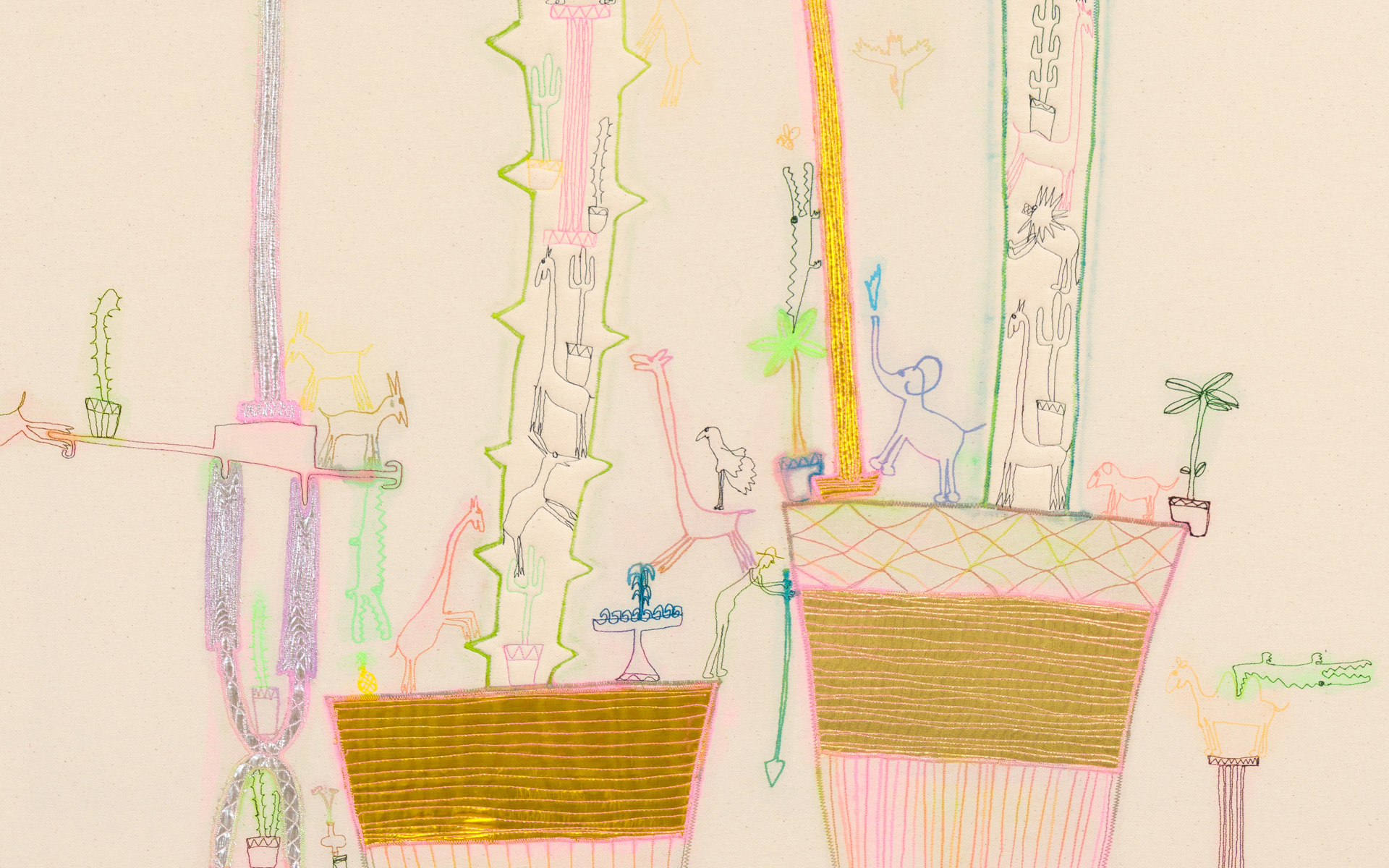
We have updated our website to make it easier to navigate through our available artworks. Click on the filter and have a play. To celebrate this technological achievement, we have curated a ‘showroom collection‘ at Weserstraße 56, including art from Georg Haberler, Lucas Kaiser, Jiwon Choi, Vasil Berela and Larissa Rosa Lackner.
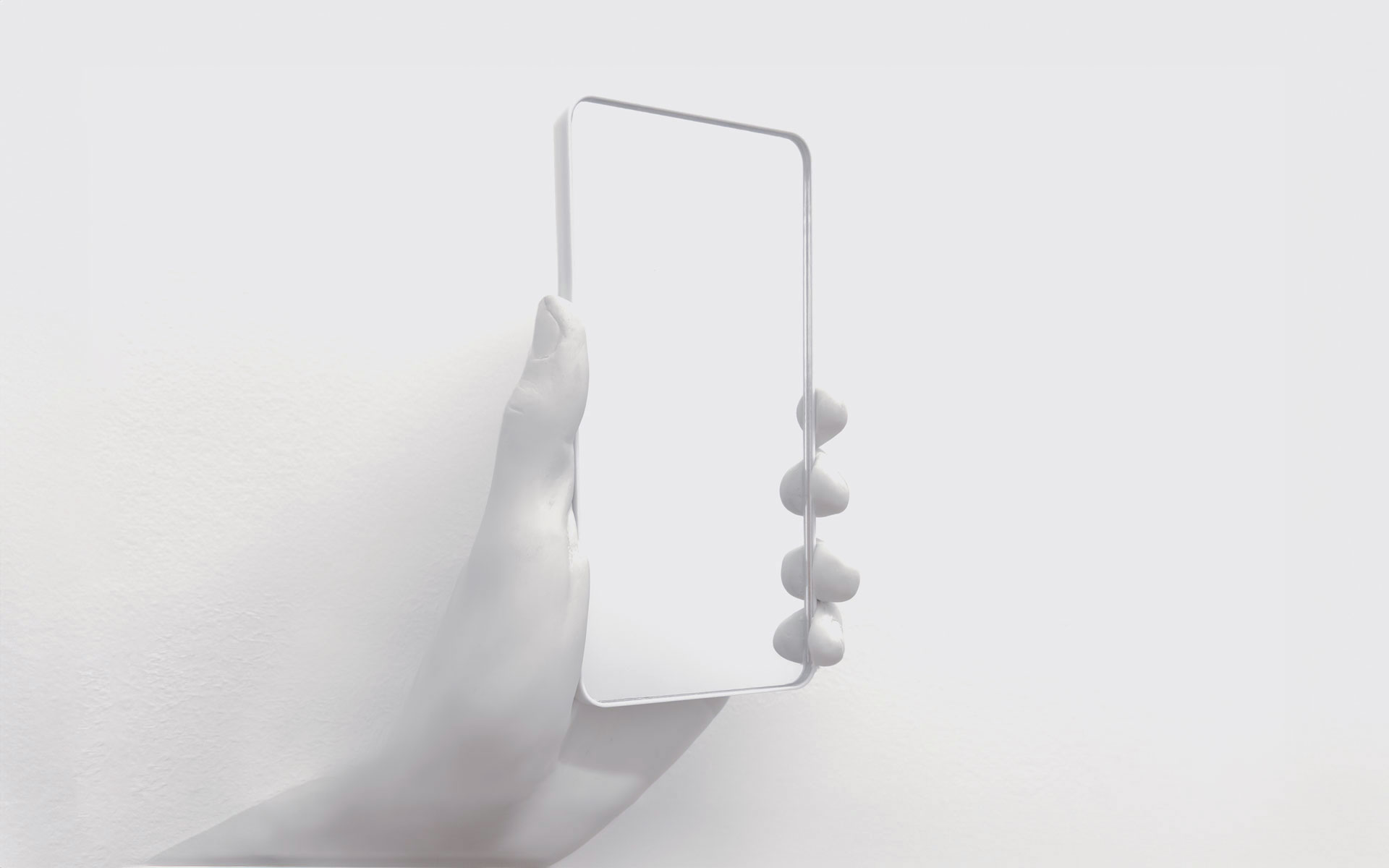
In Vasil Berela’s exhibition, Mirror Mirror, the visitor is shown a gesture that defines our contemporary world: A woman lays on the podium, raising her arm in the typical selfie pose. While her naked body remains colorless, a projection of her face on a monitor beside her is displayed in dynamic moving light blue and pinkish skin tones. In this presentaion, which suggests the smartphone perspective, the woman is depicted in an undefined, fluid environment. Her skin reveals geometrical structures that lend her reproduction a cyborg-like character.
Signup here to our early preview list.
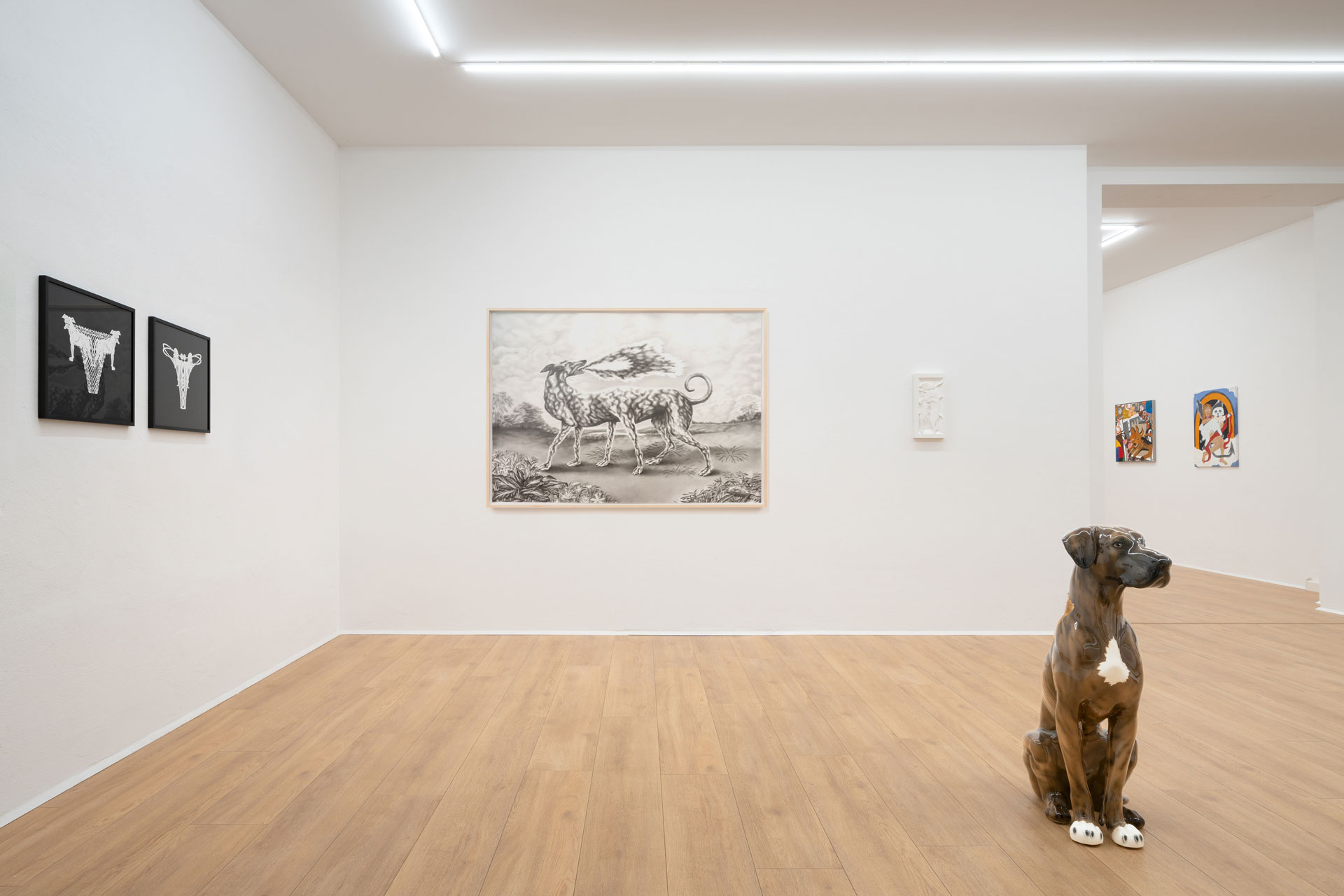
‘Dogs of Weserhalle’ presents 16 artists and their perspectives on the world’s favourite furry friend. The event also marks our official release of the Dogs of Weserhalle Calendar and will be available throughout the duration of the exhibition.
Artists
Anna Hofmann
Bastian Thiery
Donnie O’Donnell
Egor Lovki
Emily Yong Beck
Georg Haberler
Georg Vierbuchen & Leah Barna
Jinhee Kim
Katie Kimmel
King Rhomberg
Leo Luccioni
Marcel Walldorf
Nicholas Stewens
Philip Emde
Sevina Tzánou
Sonja Yakovleva
Stephan Hostettler
Guest Curator Dominika Bednarsky.
Text Julia Meyer-Brehm (German Text)
Translation Lena Stewens
Writing an exhibition text about dogs is a rewarding task – because who could possibly disagree when a song of praise is sung in honour of these clumsy four-legged friends? The far more difficult task is an exhibition text addressing the actual protagonists of this show. So a text about and for dogs would probably read something like this:
It’s been a long day. You’ve vomited on the carpet, strutted around the neighbourhood and met that terrier at the intersection who always causes a scene. As a napping furball on the tube, you won the hearts of your fellow passengers and you waited faithfully for your owner in front of the supermarket. For what felt like hours. And now you are both here. It smells quite exciting: a bit of the street, a bit of oil paint, but mostly of dog. In the air, you can detect the tracks of the various canines that have entered and left this place in the last few days or hours. Perhaps they have even been painted on canvas, photographed or their poop bags have been formed into a sculpture. You discover works that look incredibly good, smell even better and invite you to plunge your nose deep into them. Perhaps in an unobserved moment …?
At Weserhalle, 16 artists present their take on the world’s most beloved furry friend. Thereby utilising a variety of techniques, for example, drawing, painting, paper cutting or sculpture, as well as a wide range of materials. Employing ceramics, plastic, wood or paper, they depict almost every aspect of a dog’s life: from wagging tails to turds, from hunting instincts to beady eyes. We encounter lapdogs and objects of fear, tantalising Poodles and curious Dalmatians. Innocent glares, sniffers and, above all, lots of tongues.
Throughout the history of art, dogs have symbolised loyalty and vigilance as well as power structures or the dark depths of human nature, as is shown in works such as Schongauer’s “Ecce Homo” (ca. 1475) or Dix’s “Match Dealer” (1920). Their depiction has always reflected not only the ever-changing relationship between humans and animals but has also been a mirror for the developments in our society and our very identity. As cultural archetypes, the quadrupeds raise profound questions about the meaning of social norms: Why are character traits such as loyalty and obedience in our animal companions of such importance to us? Does owning a four-legged family member contradict the concurrent consumption of other animals? And is there not a similar double standard to be observed in the differentiation between pedigree breeding and stray dogs?
Political and social issues also come to the fore at Weserhalle, when a piece of fur peeks out from under its glazed porcelain replica, thus indicating the conflict between the search for recognition and authenticity. Speaking of credibility: that dogs are also being used as mascots for dubious mineral oil companies, demonstrates the drawing of a six-legged, fire-breathing dog, which takes up the logo of the energy company “Eni”. Many of the works show these animals as status symbols and thus thematise the supposed prestige value of living beings.
The exhibition and the calendar “Dogs of Weserhalle” are therefore not only a homage to and a creative exploration of the dog phenomena but also an attempt to be the master of its complexity.
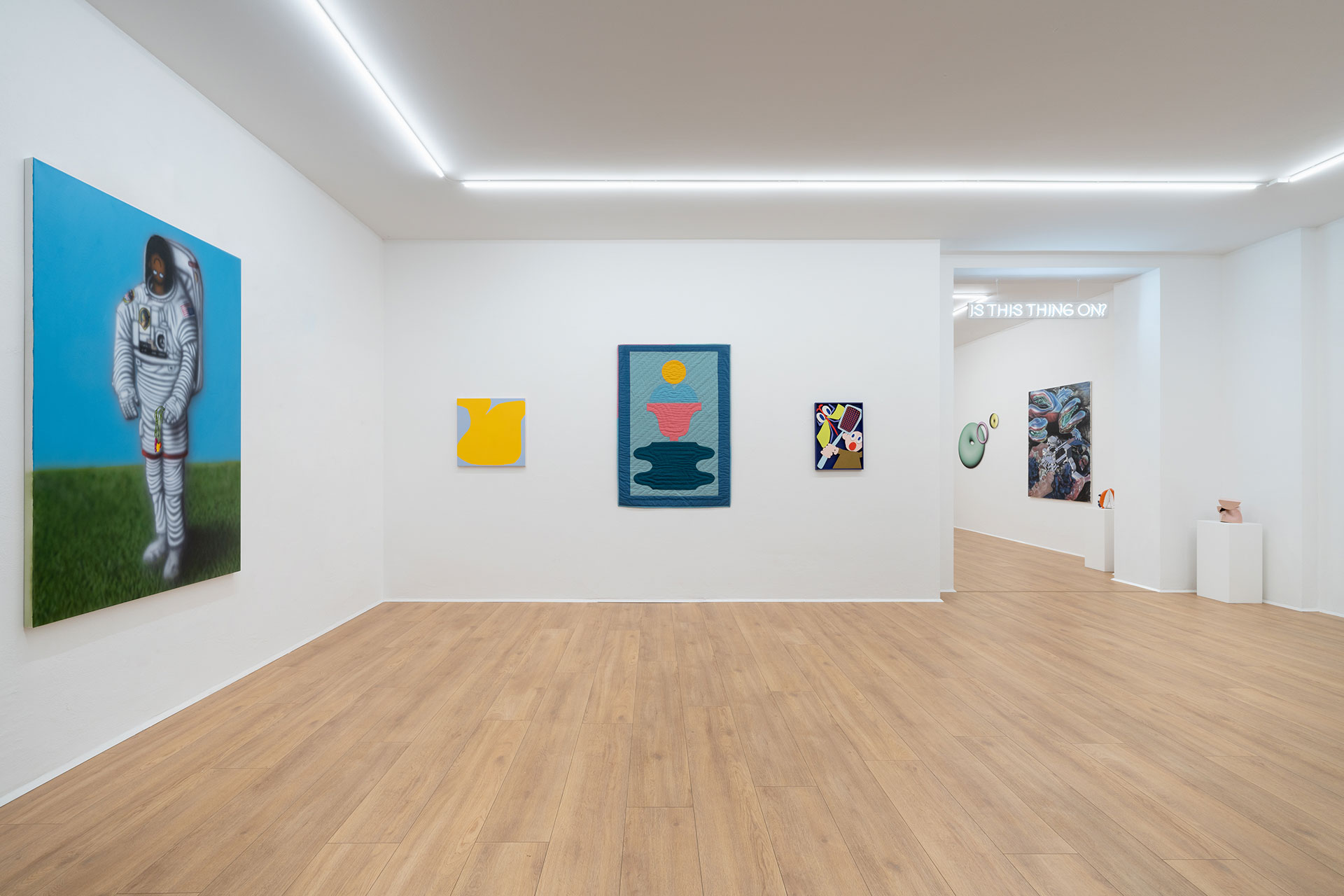
Welcome to the 11th Art Auction of Weserhalle. Like every year, we invited artists to participate in our open call to be part of our popular Art Auction format. From almost 1000 entries we have selected 31 artist with the curatorial help of Head Art Advisor and Chairwoman to the Enter Art Fair Kirsten Eggers and Austrian Artist Georg Haberler.
This week-long event is divided into two parts. Firstly, the physical exhibition at the Weserhalle gallery allows you to experience the artworks in person. Secondly, the digital aspect at weserhalle.com where you can bid on each of the artworks in our online showroom.
To participate in the bidding process, the initial step is to log in or signup. Once you have signed up and logged in, proceed to the auction artwork page. For additional information, please explore our comprehensive FAQ section. Happy bidding!
Participating Artists
Agathe de Bailliencourt
Alexander Endrullat
Annelies Kamen
Antoine Seibert
Arina Heinze
Cora Wöllenstein
Diane Lavoie
Egor Lovki
Georg Vierbuchen
Gustav Körnig
Hanna Kaminski
Jesaja Aljoscha Trummer
Johan Schäfer
Josef Panda
Katja Gürtler
Liesl Pfeffer
Lena Valenzuela
Lisa Reiter
Lucia Berlanga
Linus Beckmann
Marie Boiselle
Marie Luise Spielhagen
Maximilian Thom
Max Weiss
Nicholas Sayer Wells
Niklas Jeroch
Nora Ali
Oliver Bleckmann
Shona Stark
Vanessa Amoah Opoku
Zixu Wang
Curators
Georg Haberler lives and works in Vienna, Austria. He graduated from the Academy of Fine Arts in Vienna in 2015. His studies in painting included a semester at FBAUB in Porto, Portugal and at HFBK in Hamburg, Germany. He most recently showed his work at Weserhalle (2023), Steirischer Herbst in Graz (2023), Collaborations, Copenhagen (2022), Gallery Droste, Paris (2022), SUPPAN, Vienna (2022), Neue Galerie, Graz (2021)
Kirsten Eggers is an independent art advisor and professional who, since 2021, has been the Head Art Advisor and Chairman of the selection committee for Enter Art Fair in Copenhagen. She also works with the art collection of the German Federal Bank and is involved with the sommer.frische.kunst festival in Bad Gastein, Austria. Her roles encompass curatorial projects, writing, and consulting for private clients. Previously, she held key positions at leading international galleries in Berlin, including König Galerie, Gregor Podnar, carlier | gebauer and Schleicher | Lange, accumulating nearly a decade of experience.
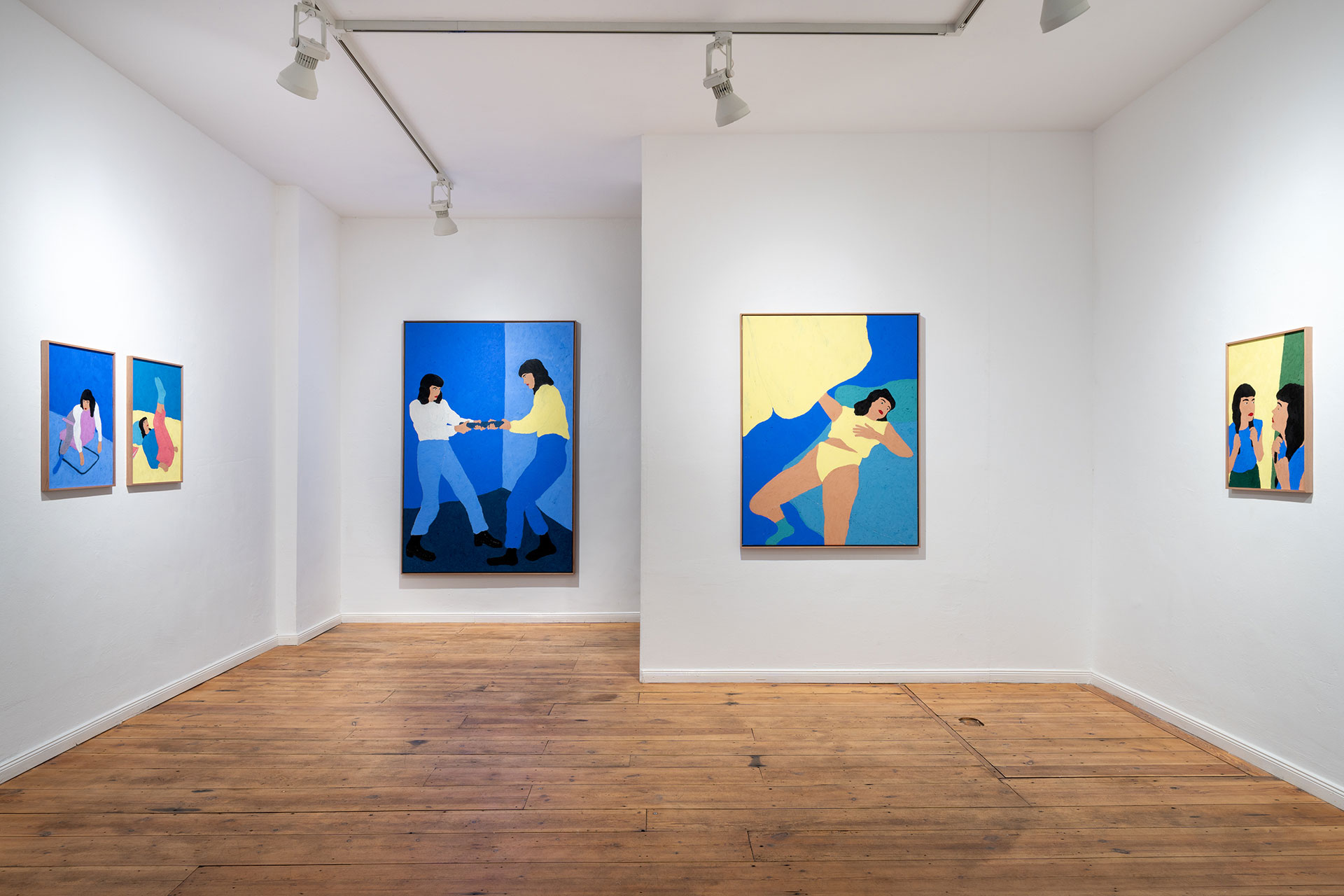
In her solo exhibition “Zähneputzen ist nicht schwer” at Weserhalle, Larissa Rosa Lackner presents the latest works from the “Ok bin da” series. The artist portrays everyday scenes that exist on the edge of tension and release, featuring the central figure, herself, her actions, and her surroundings.
The exhibition’s title mirrors the dilemma faced by the figures in Lackner’s works. Mundane tasks like brushing one’s teeth are meant to be easy, or so they should be. But does that automatically make them so? Is it acceptable if they’re not easy? And who gets to pass judgment on this, if anyone at all? In her works, the viewer becomes part of this confrontation with everyday life, at times as a welcomed guest and sometimes as a seemingly intrusive presence. Lackner elicits empathy for those moments when one’s mind revolves around oneself, and desires, constraints, and releases unfold individually. This series originated during the COVID-19 pandemic, driven by the artist’s experience of isolation and their inability to continue working as a photographer.
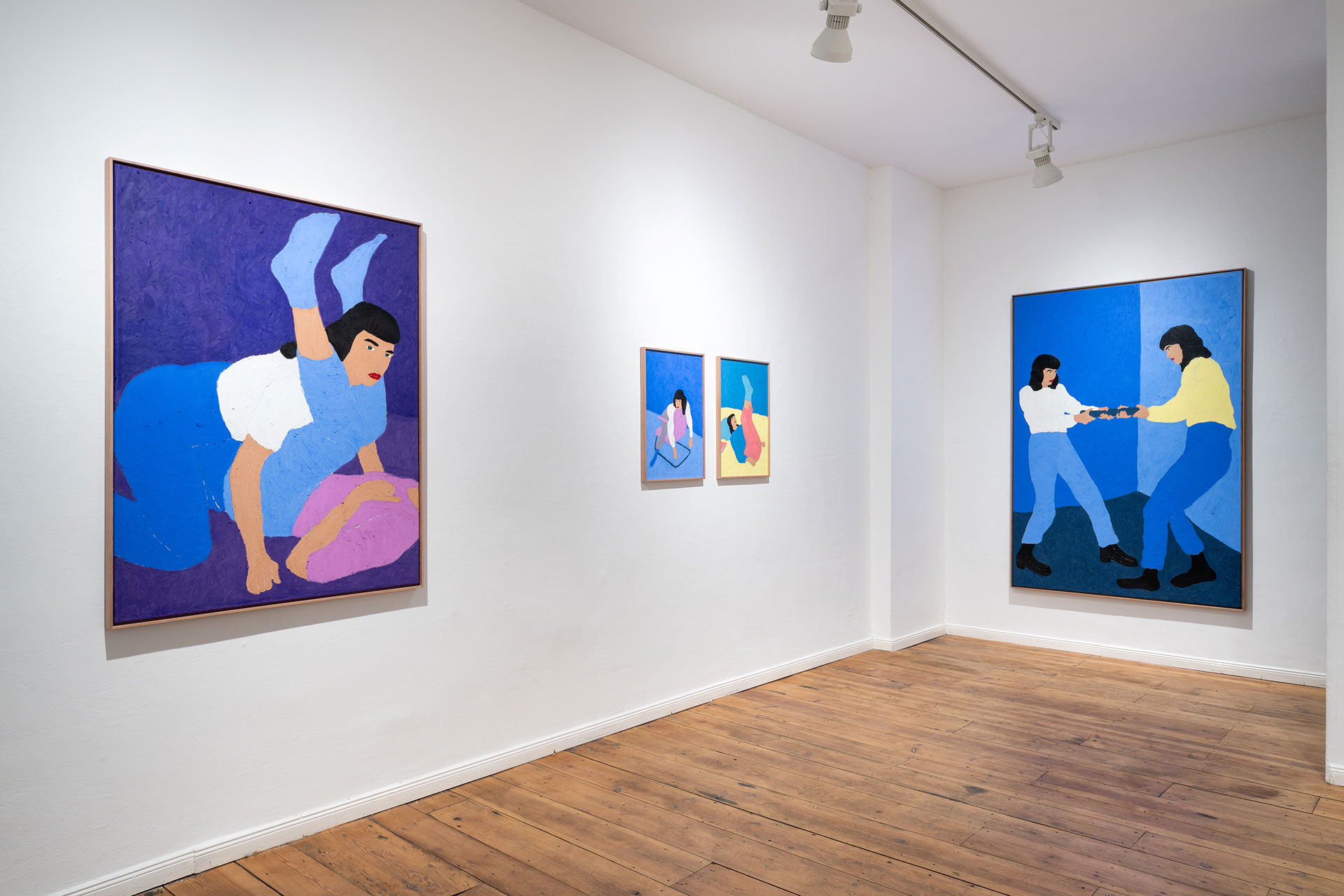
Lackner’s experience as a photographer informs her works by approaching the central figure in a serialised manner, resulting in a sense of narrative. Depending on where the viewer starts within the series, a fresh story is composed. Perspective, the figure’s posing reminiscent of a model, and a snapshot aesthetic are also photographic attributes that Lackner effectively employs to establish an unfiltered proximity to the figure. Yet, this closeness is simultaneously shattered. As writer Ferial Nadja Karrasch aptly puts it in her essay “In Suspension: The Imagery of the Series ok bin da,” “in spite of the direct glances Lackner’s figures give us, they mostly remain inaccessible, they refuse – almost defiantly – to reveal too much of themselves.” Karrasch further notes, “Participating and yet being excluded – in this context Lackner also refers to the everyday experience of using social media, which can be pleasurably voyeuristic but also painfully isolating.”
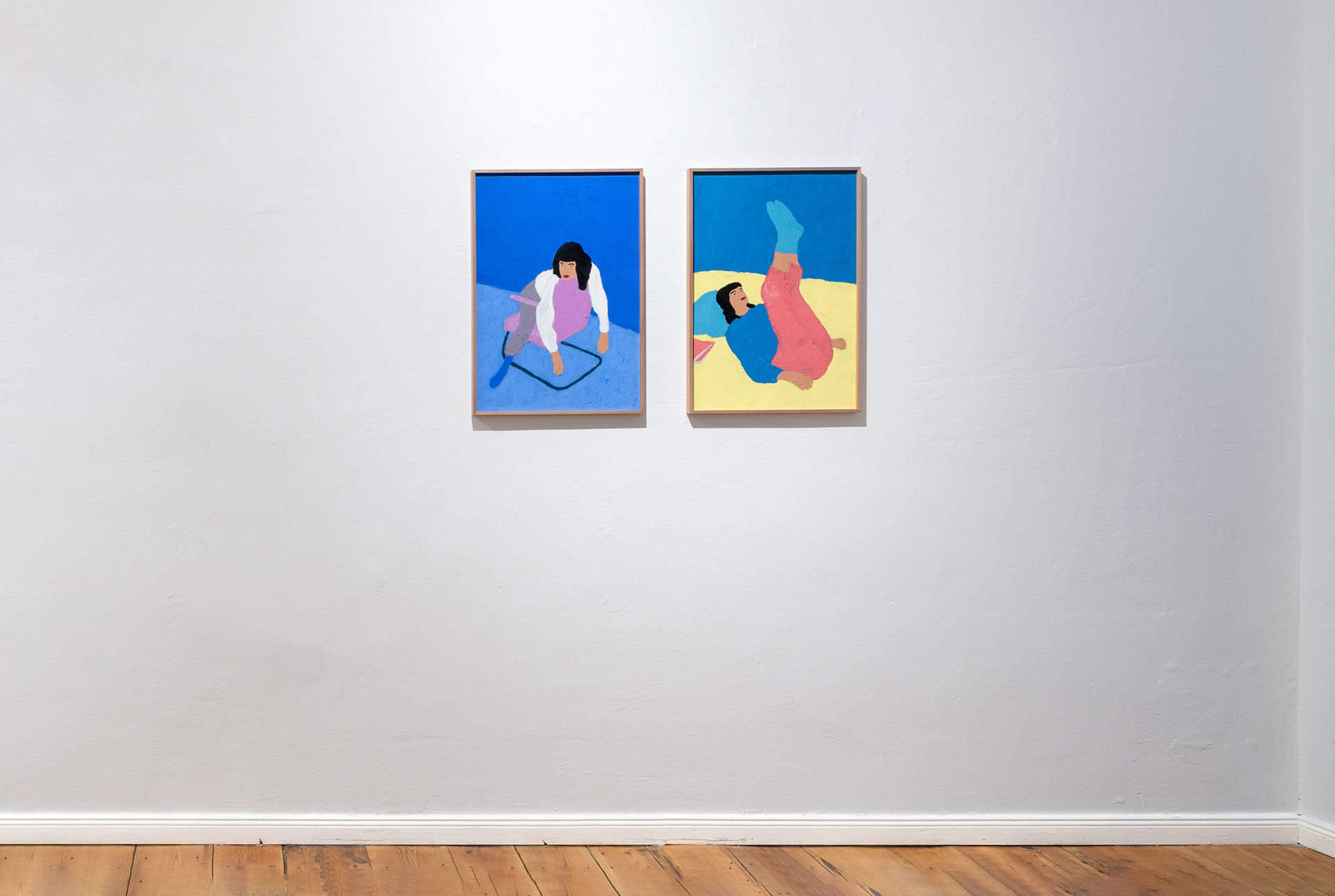
It’s akin to a social media feed, where the figure is overexposed to our gaze without achieving genuine intimacy or closeness. The figure maintains control and sustains tension. Karrasch continues, “The atmosphere of individual images often shifts as the viewer’s examination progresses, sometimes veering in the opposite direction and thereby leading to an entirely different narrative. It’s up to the viewer to see the story through to its conclusion.” Lackner amplifies this contrast through her painterly approach in her works. Behind the bold strokes of oil pastels, the sharpness of the snapshot softens. The direct gaze and the motionless facial expressions… are they truly there? The initial rigidity is transformed into dynamism by the flowing surface, revealing the rapid movement of the painting process. Lackner stages this interplay between stillness and movement within abstracted interiors aglow with vibrant colours. The choice of colours suggests lightness, but the almost complete absence of the outside world hints at a touch of claustrophobia, unsettling the supposed levity of the moment once more.
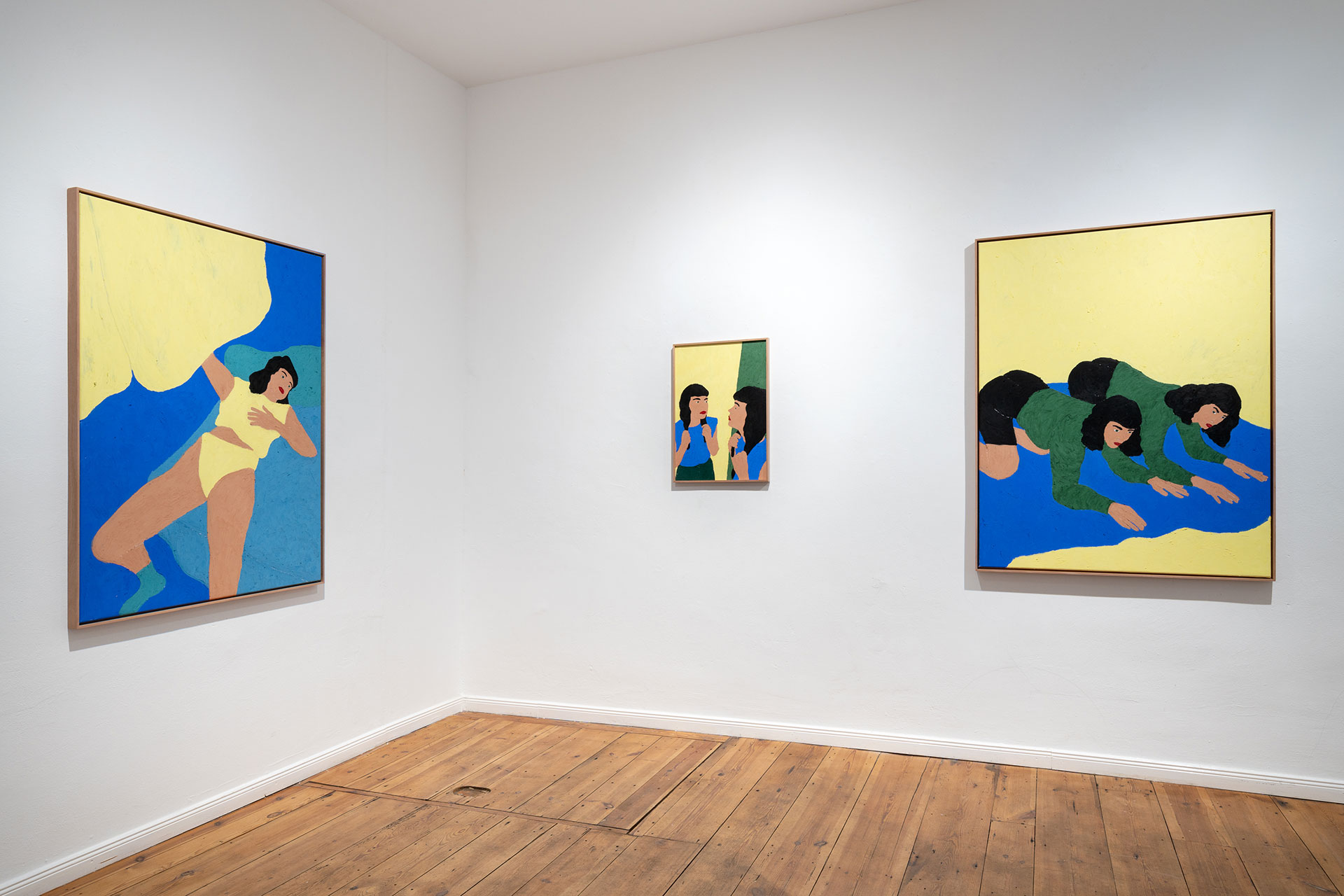
Lackner’s everyday scenes are simultaneously heart-rending, humorous, celebratory, and vulnerable. They illuminate the ambivalence of daily life, showing that dealing with it is not always as straightforward as it seems. Her works are a bit like brushing your teeth. A moment of unpretentious introspection.
Larissa Rosa Lackner, born in 1987 in Nuremberg, lives and works in Berlin. She studied fine arts and photography at the Academy of Visual Arts Leipzig and continued her studies in photography at the University of Applied Arts Vienna. Her artistic work has been recognised in various exhibitions, including “Ok bin da” at Galerie Ortloff Leipzig, and has been honoured with awards such as the Karl Schmidt Rotluff Stipendium 2022 and the Nachwuchs-Förderpreis für Bildende Kunst des Landes Brandenburg 2020. In 2023, she will present her works at Kunsthalle Düsseldorf. Her most recent exhibitions include, Ok bin da, Galerie Ortloff, Leipzig (2022), Finalists of the Karl Schmidt Rotluff Scholarship, Brücke Museum, Berlin (2022) and Du mir auch, The Gimp, Berlin (2021).
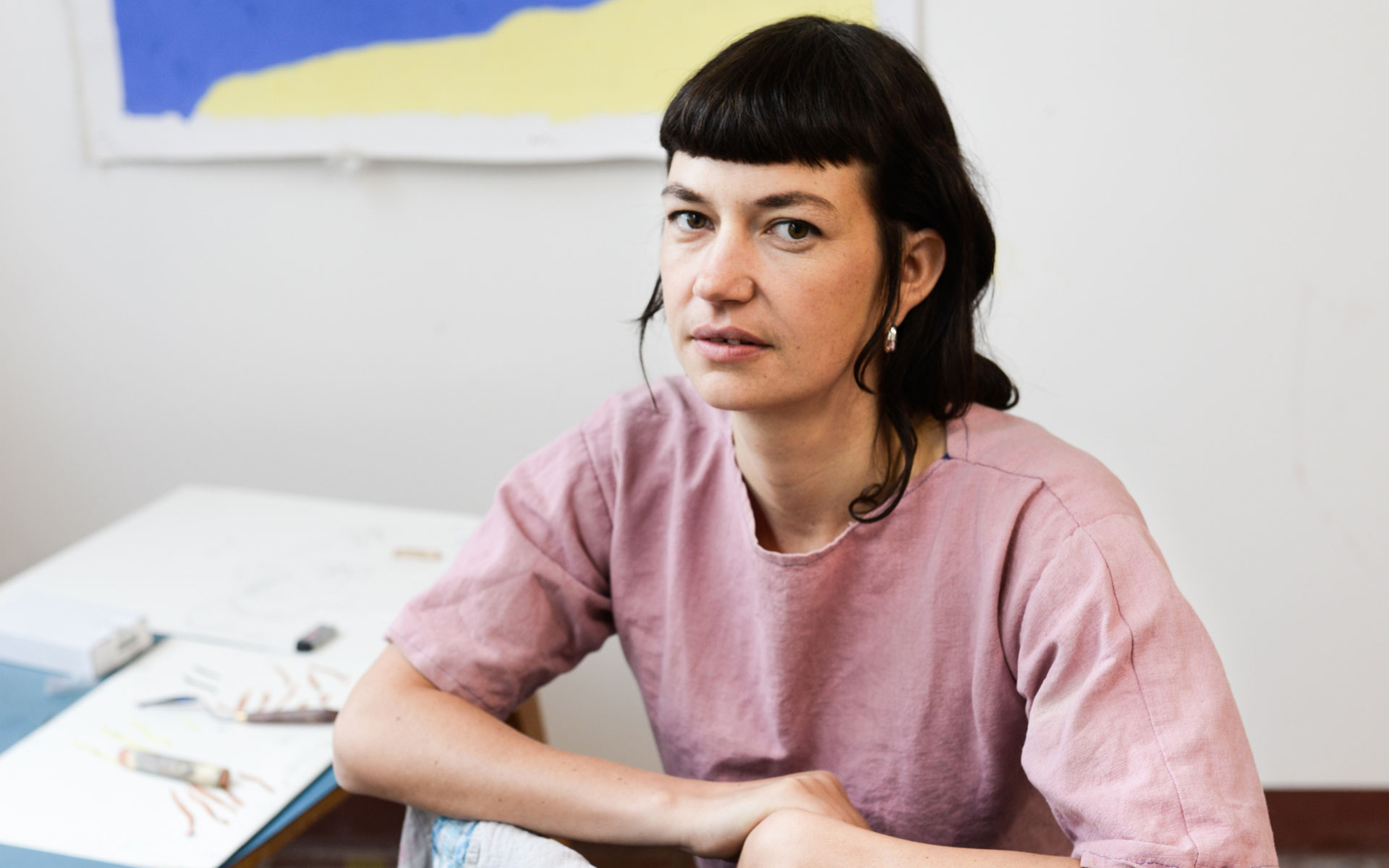
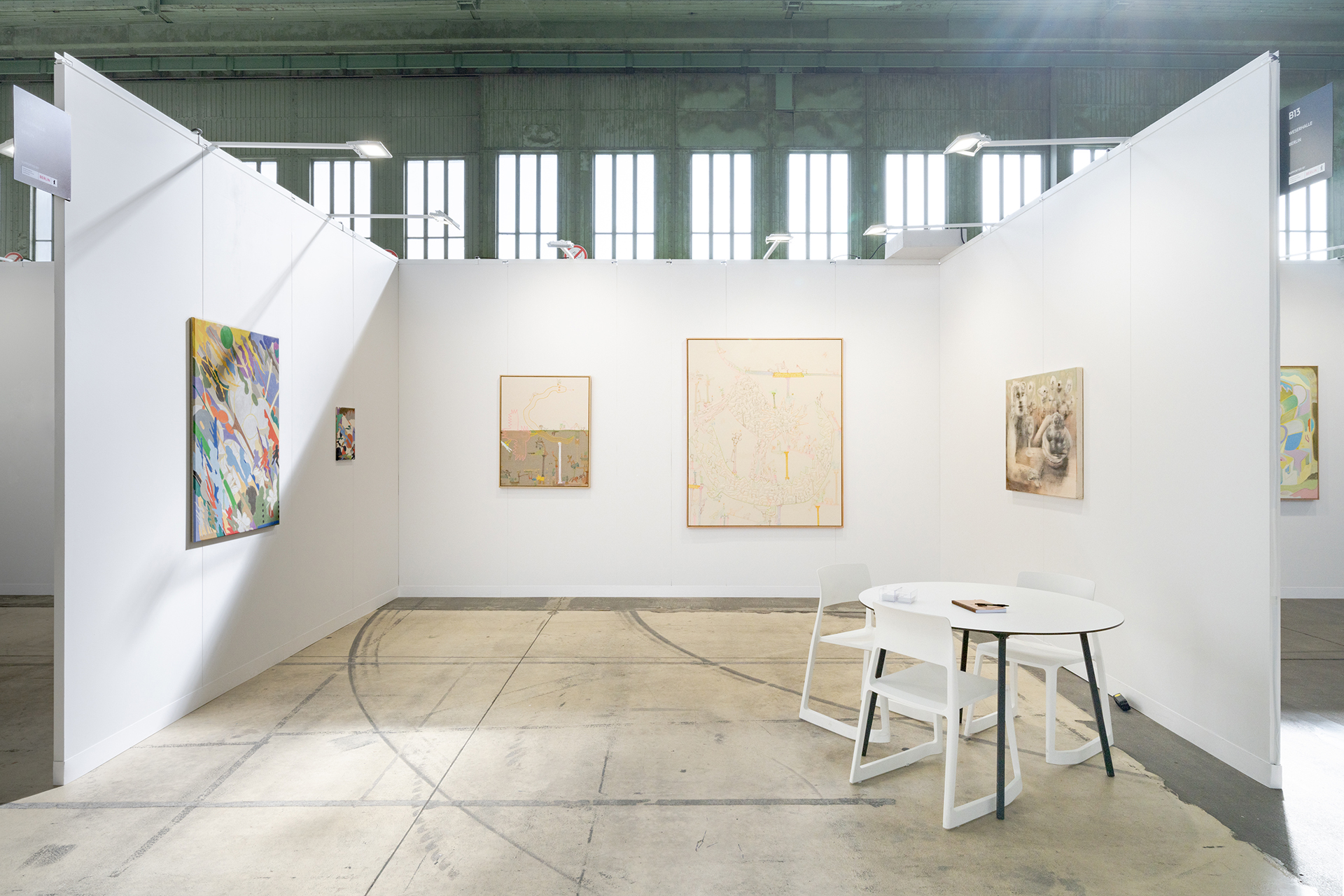
With its tenth edition the POSITIONS Berlin Art Fair heralds the art season in Berlin in autumn and enables 100 selected galleries from 20 countries to present their artistic positions from contemporary and modern art to a large international audience.
Taking part in this year’s POSITIONS Berlin Art Fair provides us with a valuable opportunity to showcase three of our artists, each exemplifying their distinctive styles and embodying the curatorial essence of Weserhalle.
Exhibiting Artists:
Emil Urbanek
Georg Haberler
Jung A Lee
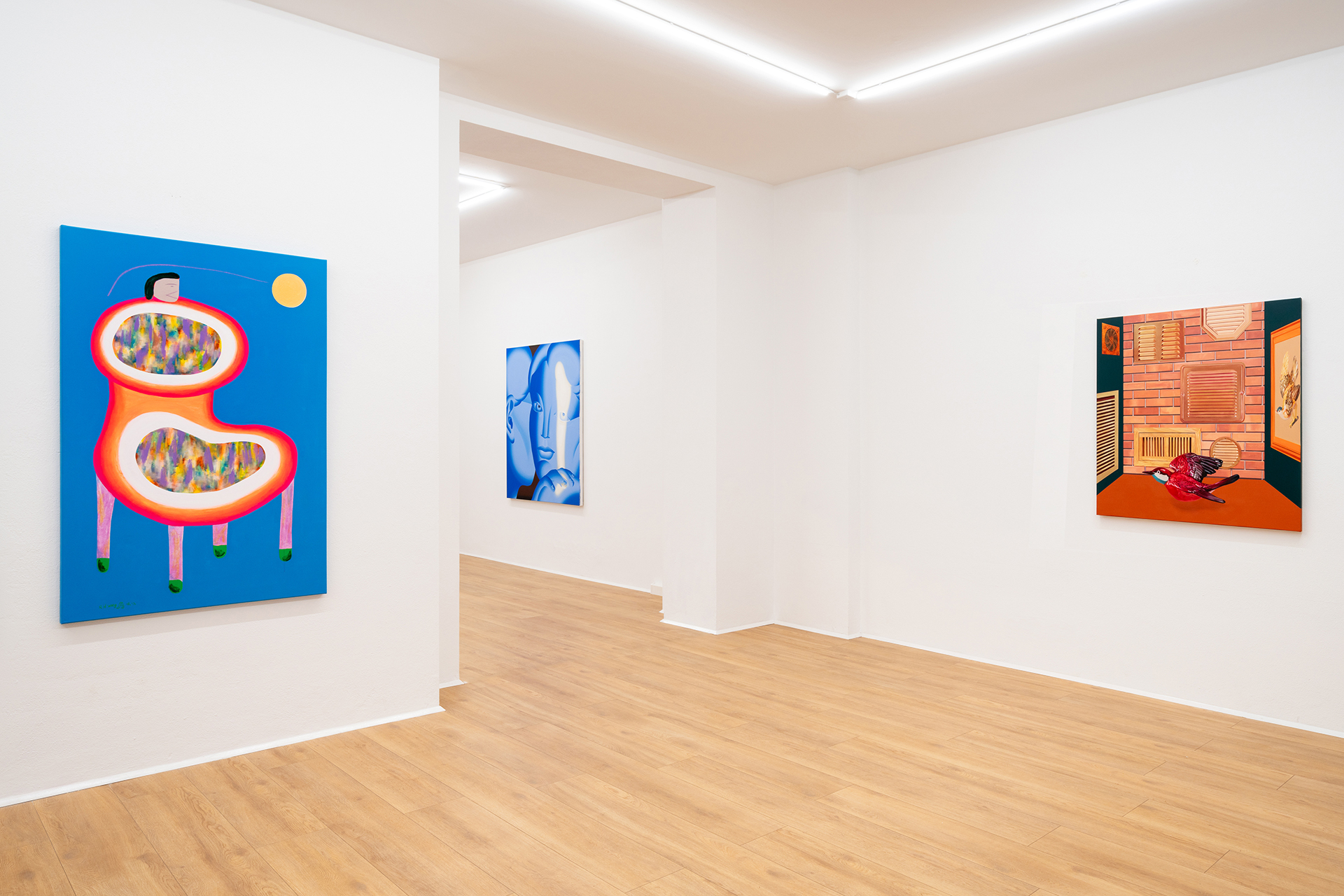
Exhibiting Artists:
Ant Hamlyn
Jinhee Kim
Jiwon Choi
Juno Rothaug
Lucas Kaiser
Ruohan Wang
Presenting the second instalment of Future Solos, our annual group show provides a sneak peek into our forthcoming lineup of solo exhibitions. With a strong selection of works by local and international artists, Weserhalle continues its program’s characteristic language, reflecting on sociocultural and visual trends that are yet to be defined.
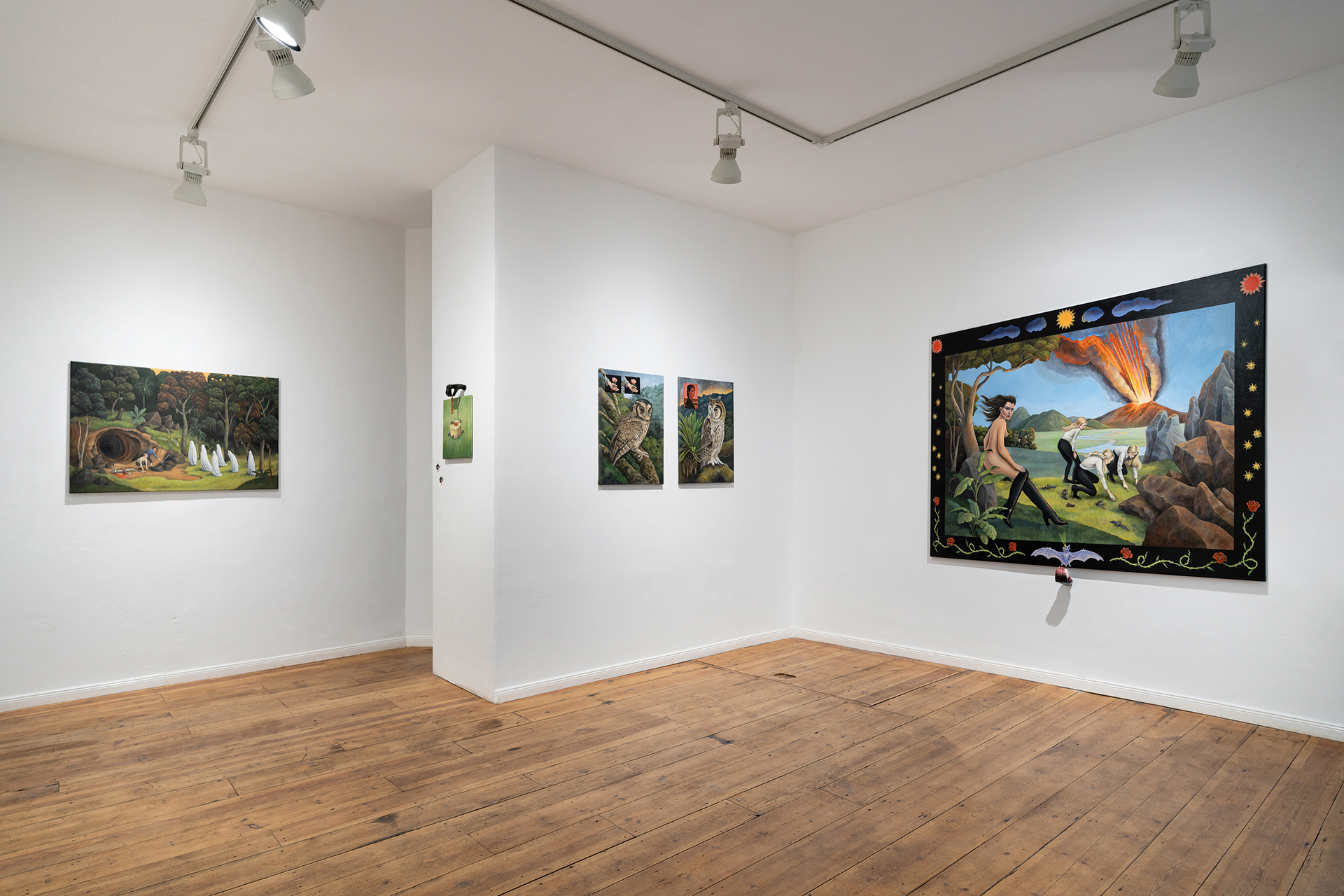
Artists Ornella Pocetti (*1991, ARG) and Marcelo Canevari (*1984, ARG) inaugurate our September program, showcasing a collection of both individual and collaborative paintings.
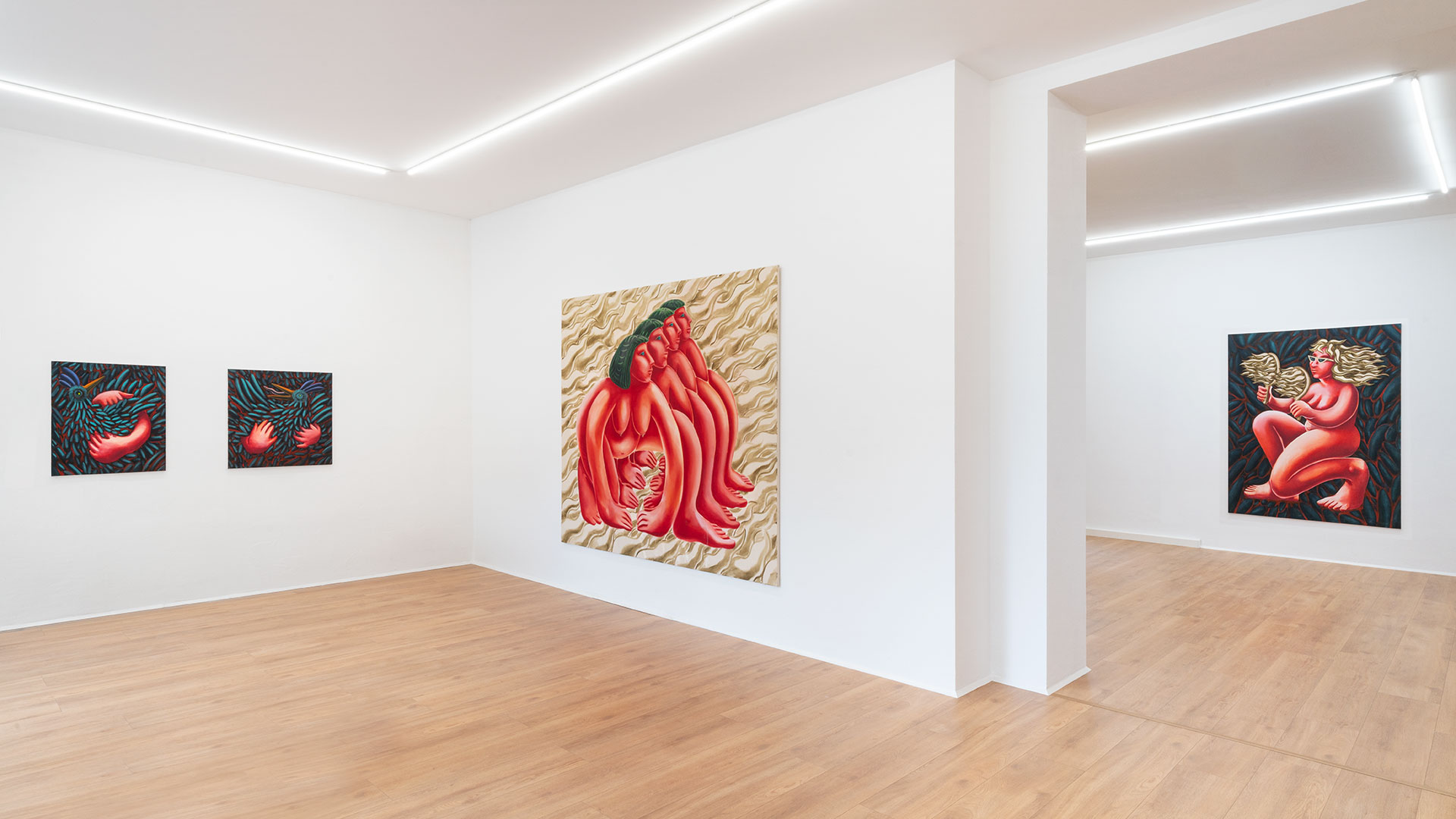
In one part sweet & two parts bitter, Tamara Malcher’s women subjects explore a newfound ambiguity, displaying a surprising meeting point between hiding and power.
Malcher’s world is strange and sensual, a colourful range of liminal spaces through which flushed, full-bodied nude women dance, play, and run. From Ingres to Botticelli; the Venus of Willendorf to contemporary commercial photography, male artists have used the female body as a symbol for aspirational beauty, passivity, fertility or helplessness. In some of art history’s most canonical paintings, men have painted naked women in repose, lying seductively on a blanket or chaise longue. Malcher’s practice – with its in-your-face abandon – challenges this lineage. Unlike the silent, still women of 19th century paintings, ‘my women are loud, active, embodied,’ Malcher explains. They aren’t the objects of male fantasy, or the male gaze: energised and dynamic, they whirl and jump for themselves alone.
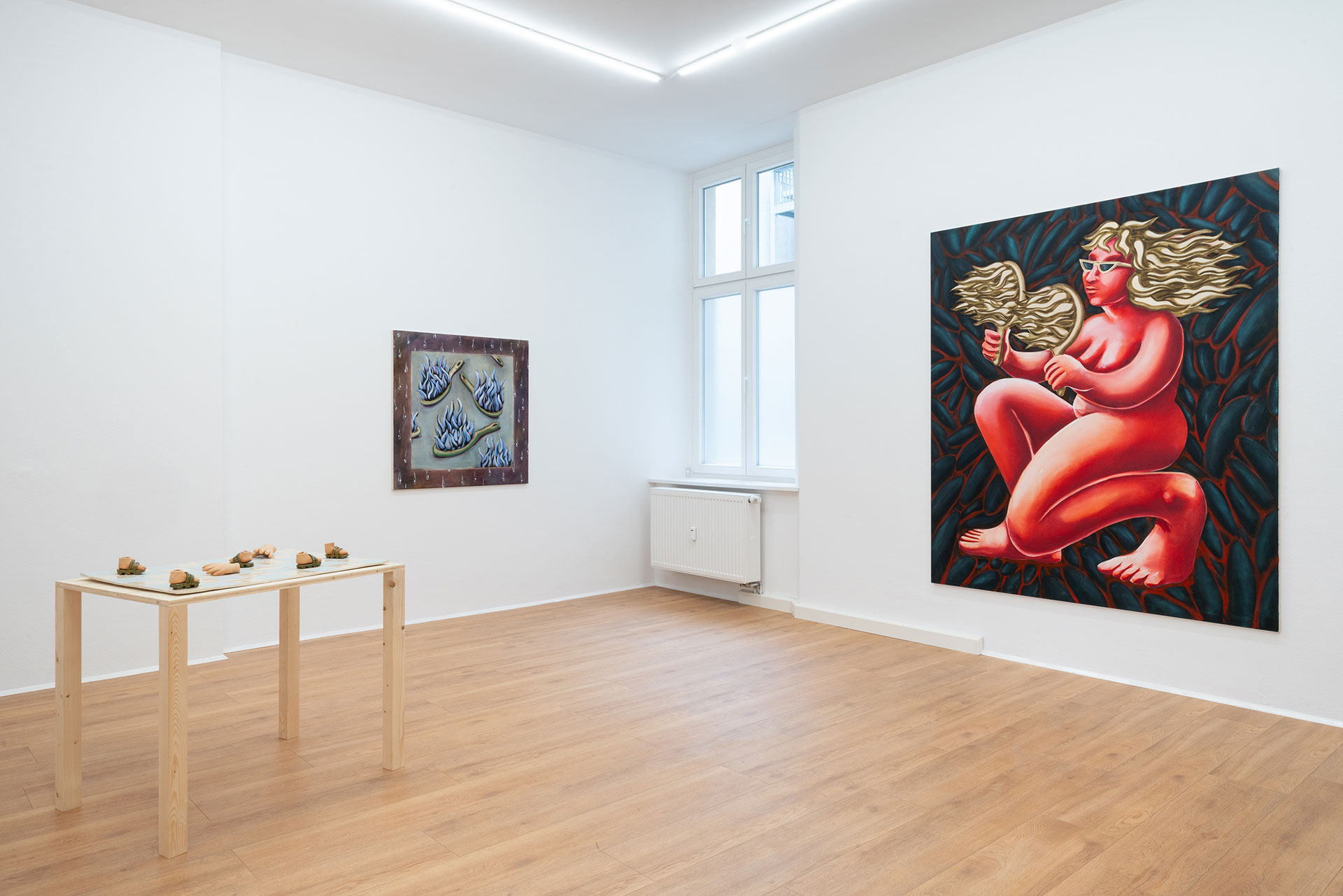
In a striking display of maturation, one part sweet & two parts bitter pushes Malcher’s concept to a new level, featuring fewer whole bodies than any series she’s painted before. Rather than dominating the picture plane with sprawling, enthusiastic activity, these bodies are largely depicted in fragments – as round bellies protruding over kneeling legs, eyes peering over deep water, or hands popping out from a dense cluster of black chicken feathers. The repeated visual motifs of this series are in fluid conversation, spilling into multiple meanings: notice that the same shape is used to depict leaves, feathers, hair and flames in various works throughout the exhibition. One part sweet & two parts bitter maintains the confident contradictions of Malcher’s previous works while unpinning her paintings from the art historical stereotypes that bind them. In so doing, the artist uncovers another layer of liberated female fantasy; a new freedom.
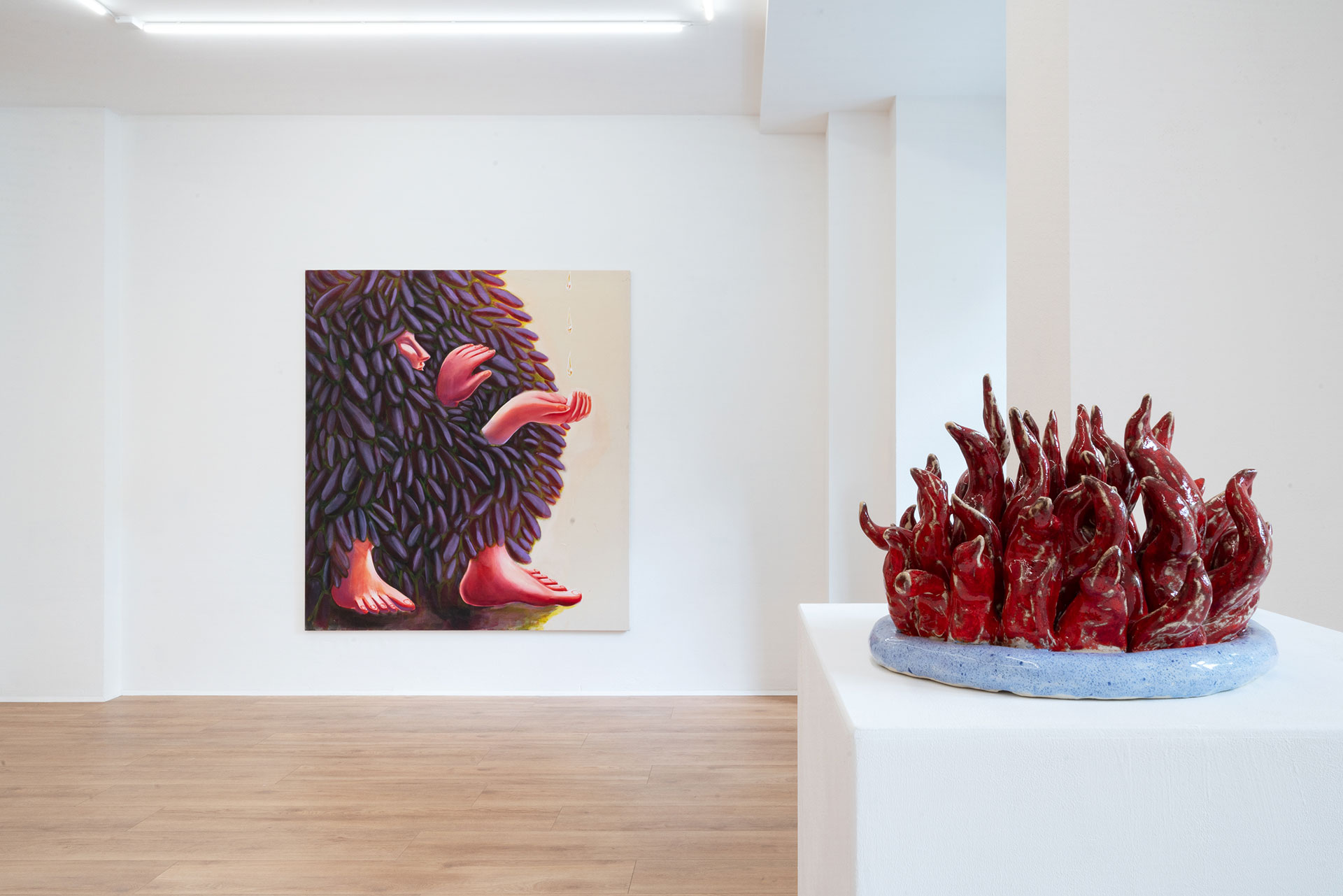
Tamara Malcher (*1995, Recklinghausen) is a German artist living in Münster. In addition to a recent solo show at Galerie Droste (Düsseldorf, 2022), Malcher’s work has also been included in group shows around the world, including Albertz Benda (Los Angeles, New York, and Miami), The Hole NYC, Galerie Droste (Paris and Seoul), and Gallery Daniel Raphael (London). She is currently a Meisterstudentin studying under Professor Cornelius Völker at the Kunstakademie Münster.
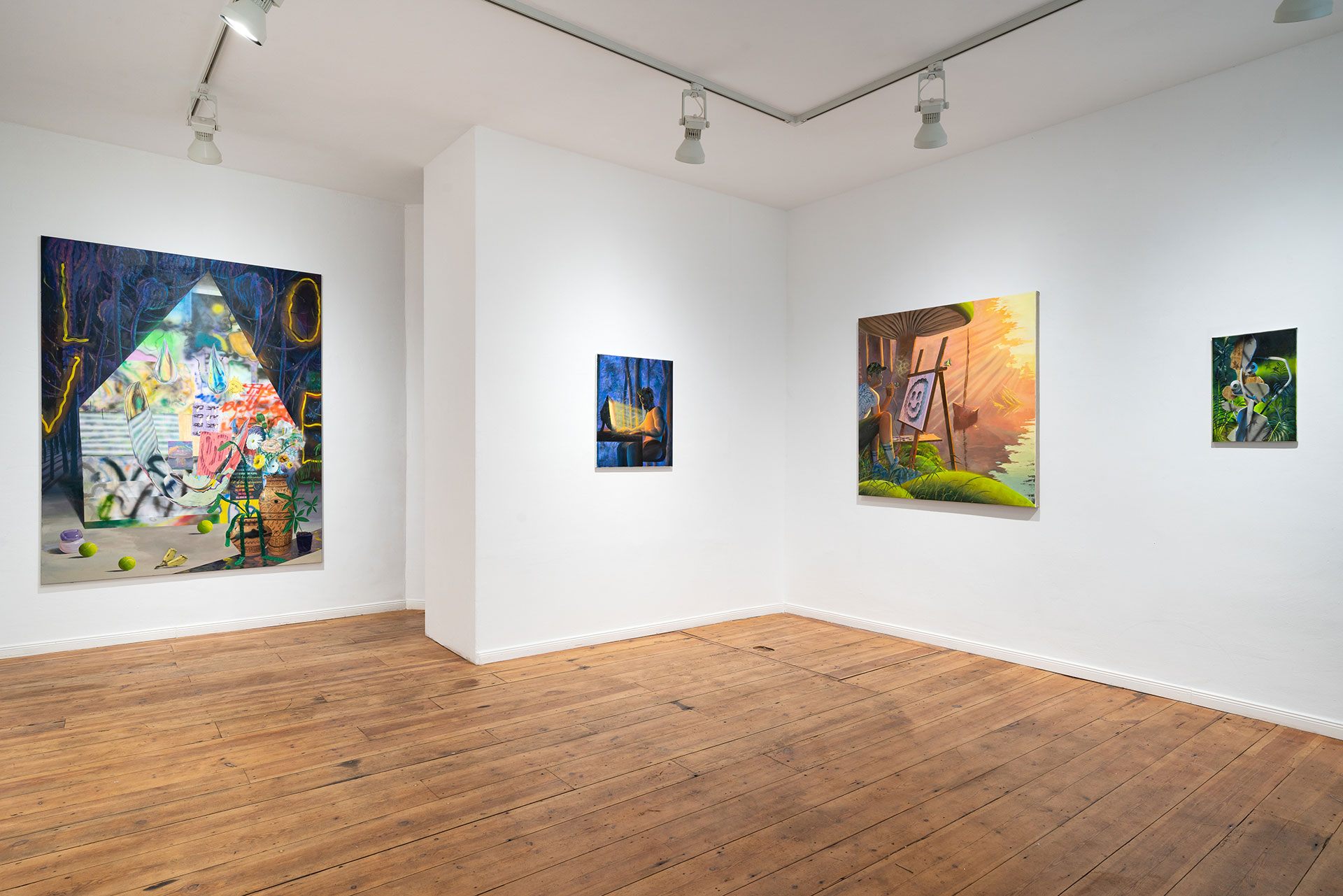
Across the works featured in Good News, a kind of symbology plays out, in terms of which Maxim Brandt’s landscapes reveal themselves. The viewer intuits space as a kind of disquieting intimacy—a felt tension between interiority and exteriority, place and architecture. The scenes Brandt depicts seem foreign to anything recognisably domestic. Simultaneously, the overlapping aspects of fantasy and surrealism captured in his impersonal world invoke a levity that seems equally pacific and strange, utopian and absurdist. Good News speaks to a greater ecological consciousness of not feeling at home in this world, while intimating how technology and nature can symbiotically converge.
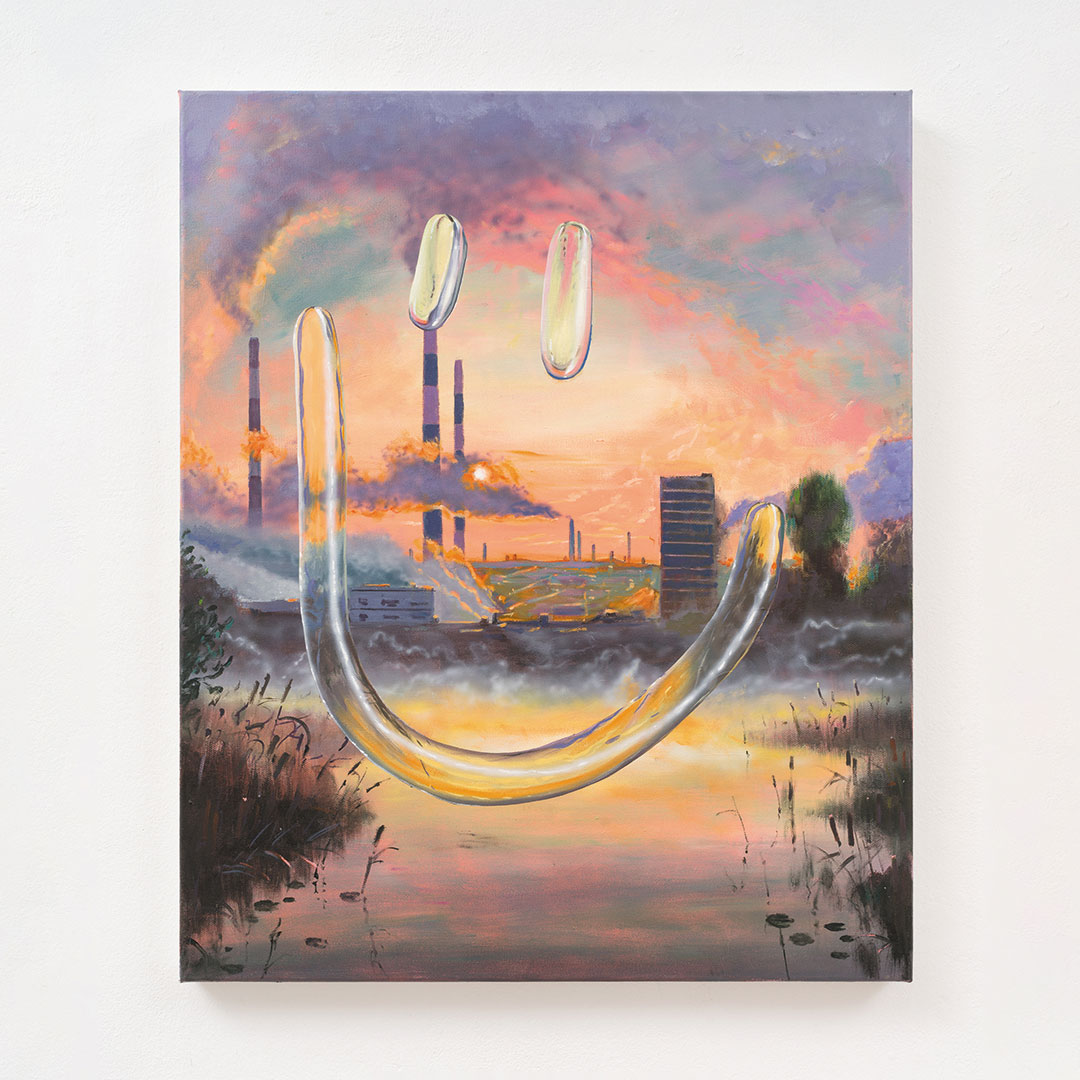
Brandt’s use of recurring motifs lends his pictures a poetic, as opposed to a narrative, feel. These motifs characterise themselves as architectural, spatial, environing, rather than simply allegorical or allusive. Throughout Good News, whenever one of Brandt’s motifs emerges, it acts like a caption ensnaring the elements of the painting into a constellation of significant energies. In works like Genius Loci and The House of the Rising Sun, for example, a liquid-like smiley face imposes itself on the scene. In Genius Loci, the smiley forms against a backdrop comprising mammoth technologies of industrialisation. In The House of the Rising Sun, where the scene is more ambiguous, the smiley yet emerges as an insignia that contextualises the whole landscape.
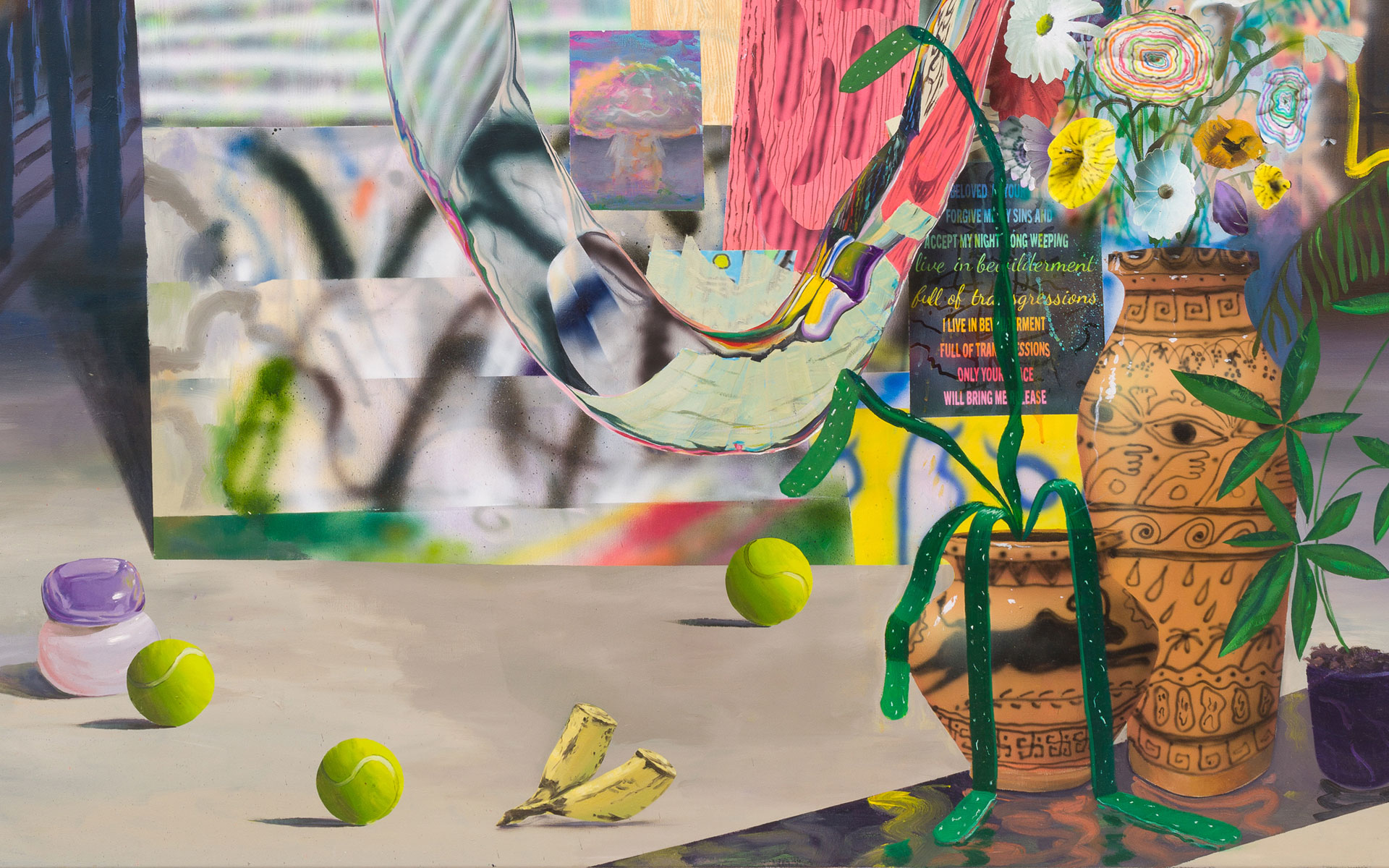
Brandt’s use of symbolic motifs introduces significant spatial transformations. They effectively disrupt the picture’s surface—an ambiguous testament to humanity’s ingenuity and obtuseness in the face of nature. But this allows for allusions to humour to enter into Brandt’s work. I say “allusions” because his paintings don’t intentionally provoke laughter, so much as they poke holes in the paradox where nature and the tools of industry (foraged from natural materials) seem somehow incompatible. This kind of absurdism begets the spectre of vanitas: another motif Brandt wields, where tastefully arranged still life recalls to mind our transience, while also paying homage to all that is beautiful in life.
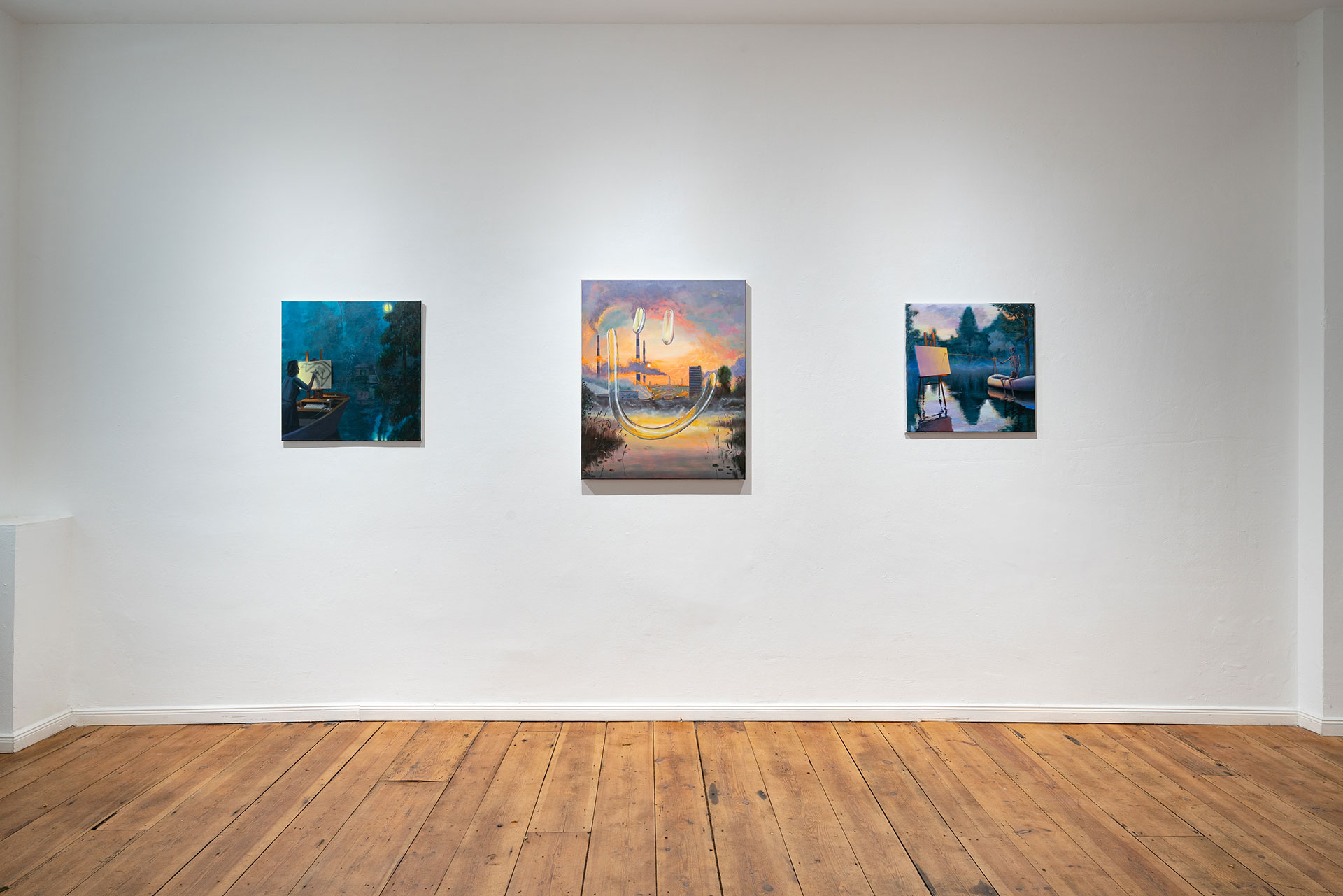
A painting like The Artist makes clear how the motif of vanitas alters the warp and woof of environing textures. More solitary than isolated, an artist-skeleton paints with a long, leisurely stick. However at home on this tranquil lake the figure might appear, an anxious tone, eerily diffuse, seems to emanate from the skeleton. True to the architectural precedents of Brandt’s work, the presence of the skeleton—vanitas embodied—doesn’t work so much to occupy the surrounding environment (how could a ghost occupy anything?), as colour it with an overarching meaning which would otherwise only be implied. Like a wall against which a cyclorama displays, a scenario emerges around the skeleton that reminds us of the necessity of serving nature. In this, Brandt invites viewers to place themselves into the hands of the unknown, which is not to be confused with death.
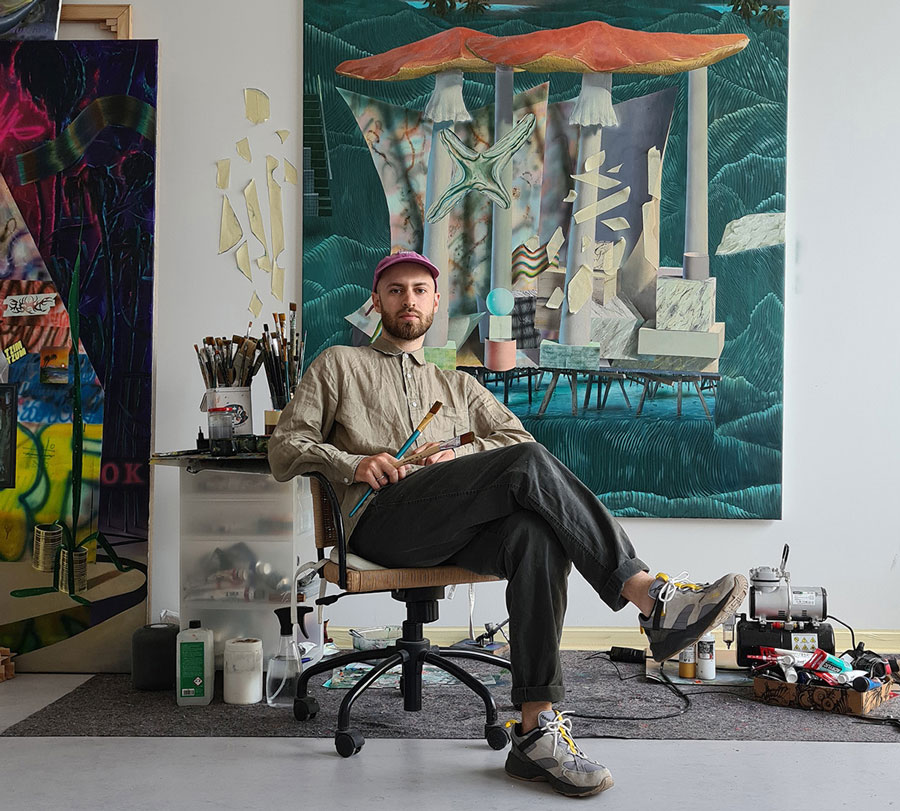
Maxim Brandt (*1986) is a Ukrainian Artist, who lives and works in Berlin. He graduated with a Master Degree from Muthesius Academy of Fine Arts, Germany in 2015. His most recent exhibitions include Super Future at Mirus Gallery, Denver, DUEL a duo exhibition with Marius Martinussen at NB Galeri, Viborg, 2022, Edition Berlin (Solo) at Galerie Rainer Gröschl, Kiel, 2022 and Needful Things at Uxval Gochez Gallery, Barcelona, 2021.
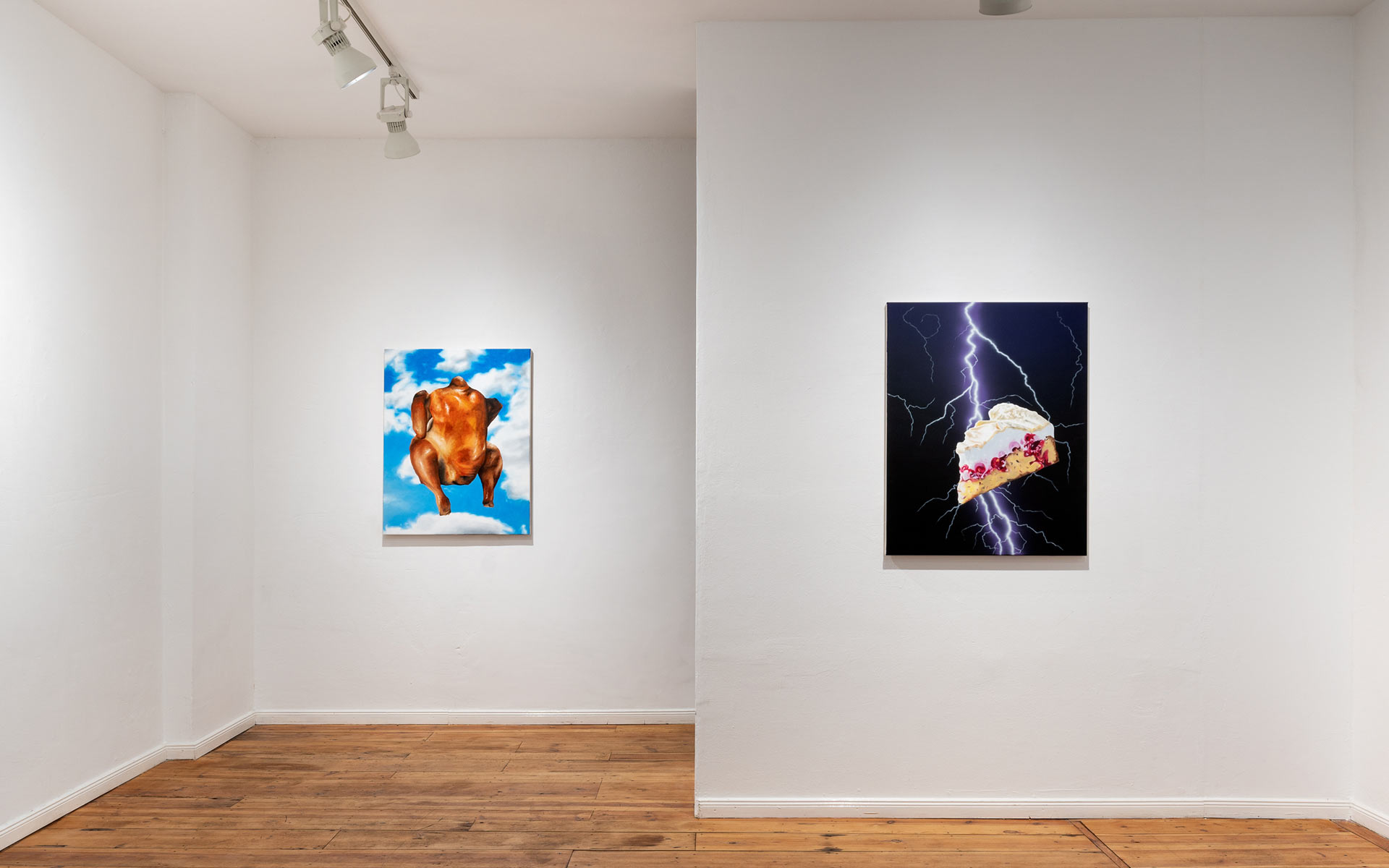
Leitmotifs of a stereotypical German middle-class cuisine hover in front of majestic landscape and nature depictions that irritate and delight at the same time. In their painterly collages, the artist duo Albrecht/Wilke deal with their upbringing in a humorous way. With irony and acumen, they bring bourgeoisie culture to our attention, hitting us with subtle familiarity, even though one wishes, time and again, that it did not.
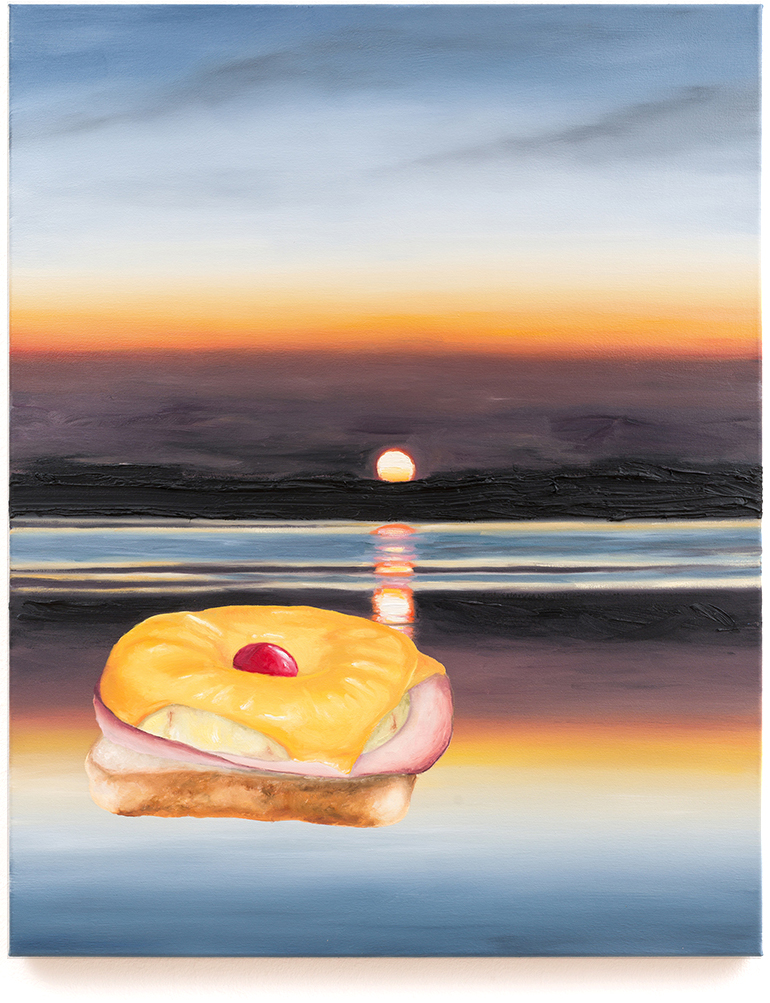
In the exhibition, the painter duo Albrecht/Wilke, who live and work in Berlin, take up typical German dishes that are particularly polarising. A Hawaiian-toast, for example, knows no shades of grey. Either you love the composition of lightly browned, crisply toasted bread on which a juicy cooked ham and a fruity sweet, canned pineapple are covered by the delicately melting slice of cheese, or you hate it. No matter which side you count yourself to, its promising silhouette stands out from afar and just by looking at it, the taste tickles your tongue.
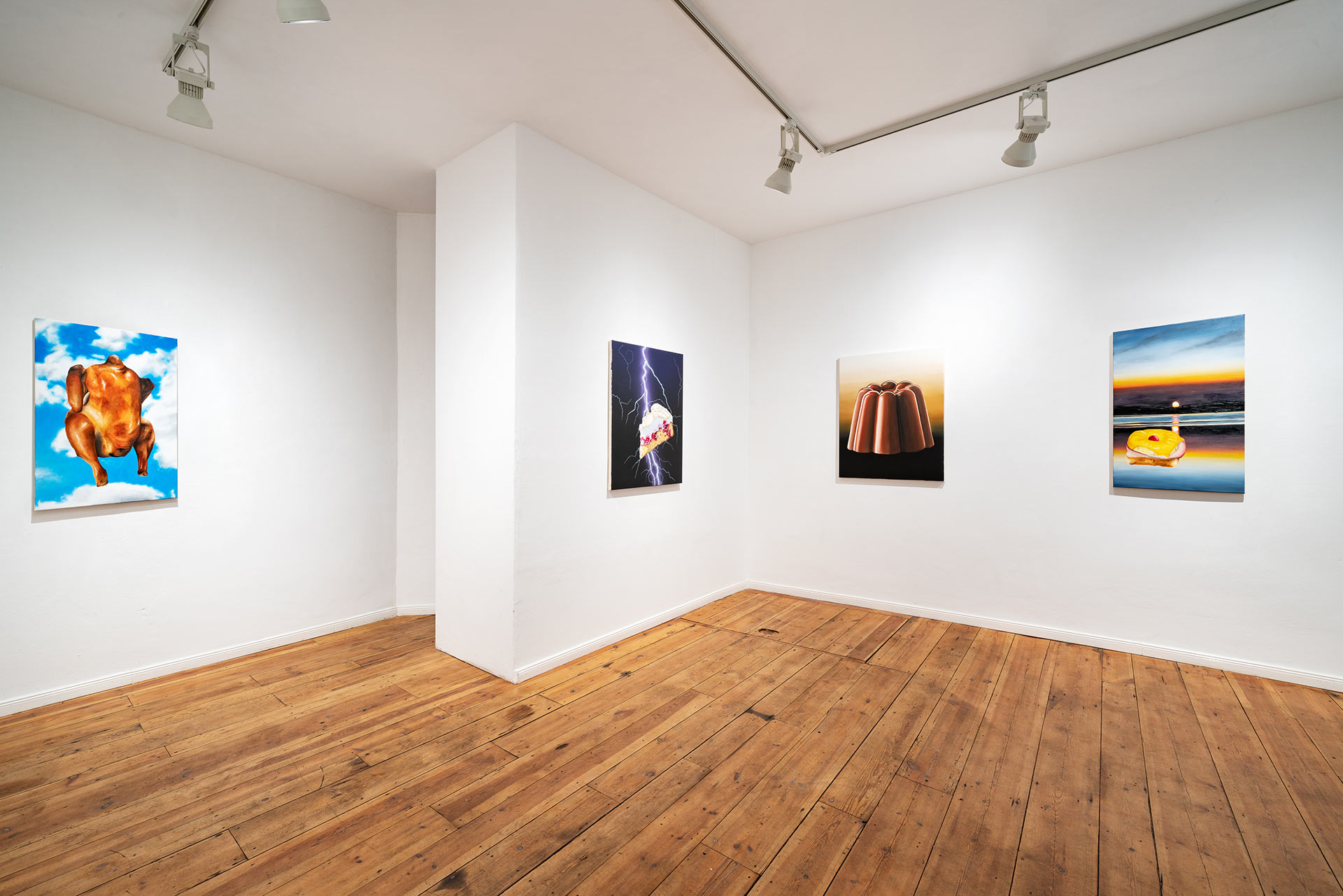
The other motifs, whether grilled chicken, Black Forest cake or curry sausage, are also so familiar that their images trigger ambivalent feelings in us. Recognising them and immerse in our own memories is very satisfying because the pictures are so connectable and close. Seeing becomes a pleasure in the truest sense of the word. Like curry sauce to a sausage, the familiarity of the motif clings to us, even though we are trying to keep our distance. Because let’s be honest: there is hardly anything good in a curry sausage, apart from its exquisite taste. Eating meat, as the boss of a large sausage company said some time ago, is the cigarette of tomorrow. And although we know better, the prospect of a quick sausage makes us weak more often than we would like to admit.
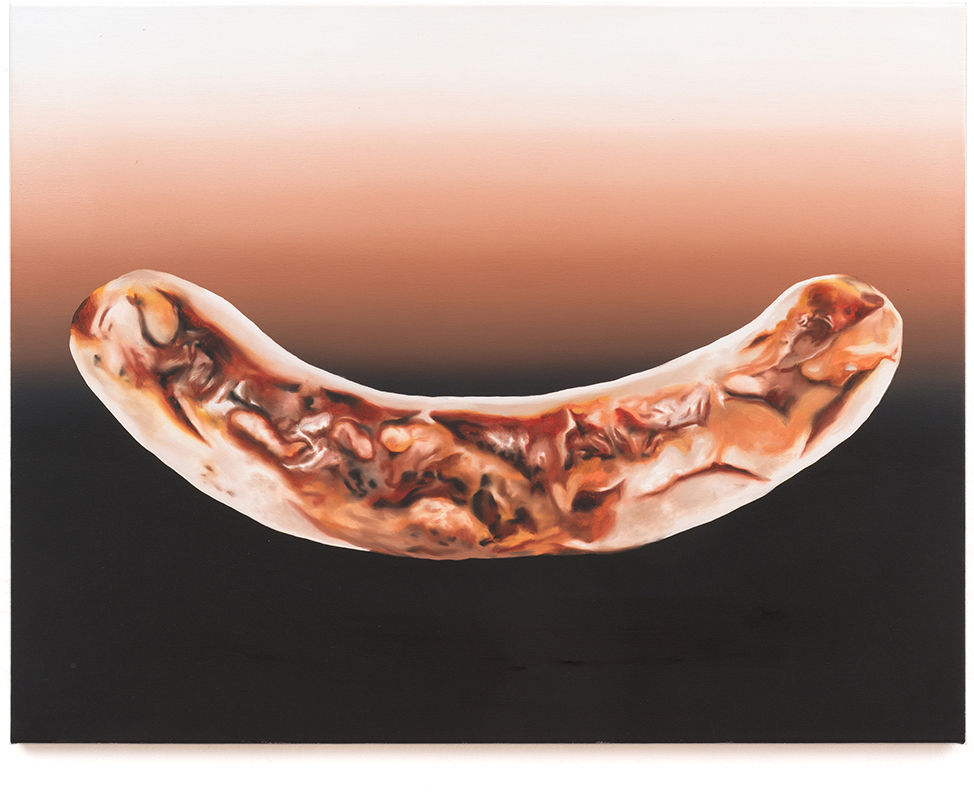
Seemingly without reference, the various delightful treats float in front of landscapes that are in no way inferior to edible pleasures in their familiarity. These romantically exaggerated depictions of nature always find a way into our souls and warm our hearts. It is difficult for us to escape the sublime. Casper David Friedrich already made use of this exaggeration and continues to inspire viewers to this day. Albrecht/Wilke use the same means to present us with a sunset by the sea or a mountain landscape that brings tears to our eyes.
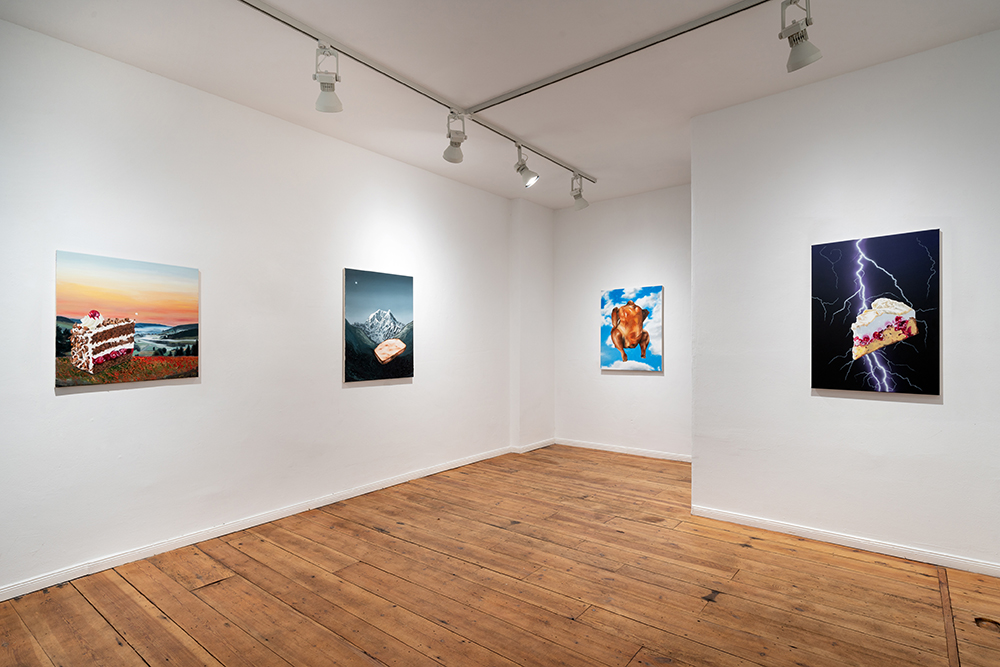
True to their motto of making only “good painting”, the artists make use of different styles from art history. They sample and combine the fine painterly craft of Romanticism with the coarse brushstrokes of the Junge Wilde and let them clash abruptly. Where Casper David Friedrich used humans to draw the viewer into the picture, Albrecht/Wilke use classics of German culinary. The contrast of the banal Hawaiian-toast meeting an exaggerated sunset characterises their works. The simultaneity of the everyday next to the overwhelming, of the simple next to the content-heavy reference liberates from interpretive constraints and is simply Fucking Delicious!
Text by Arne Schmidt
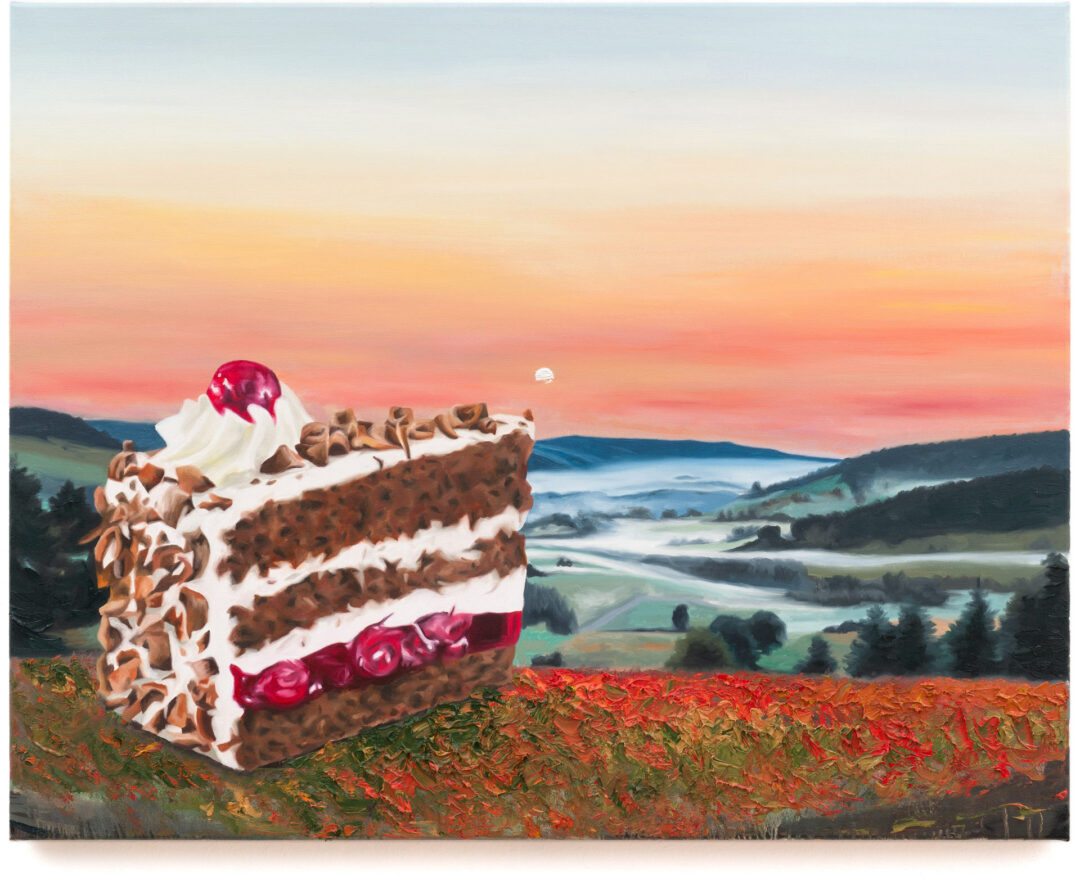
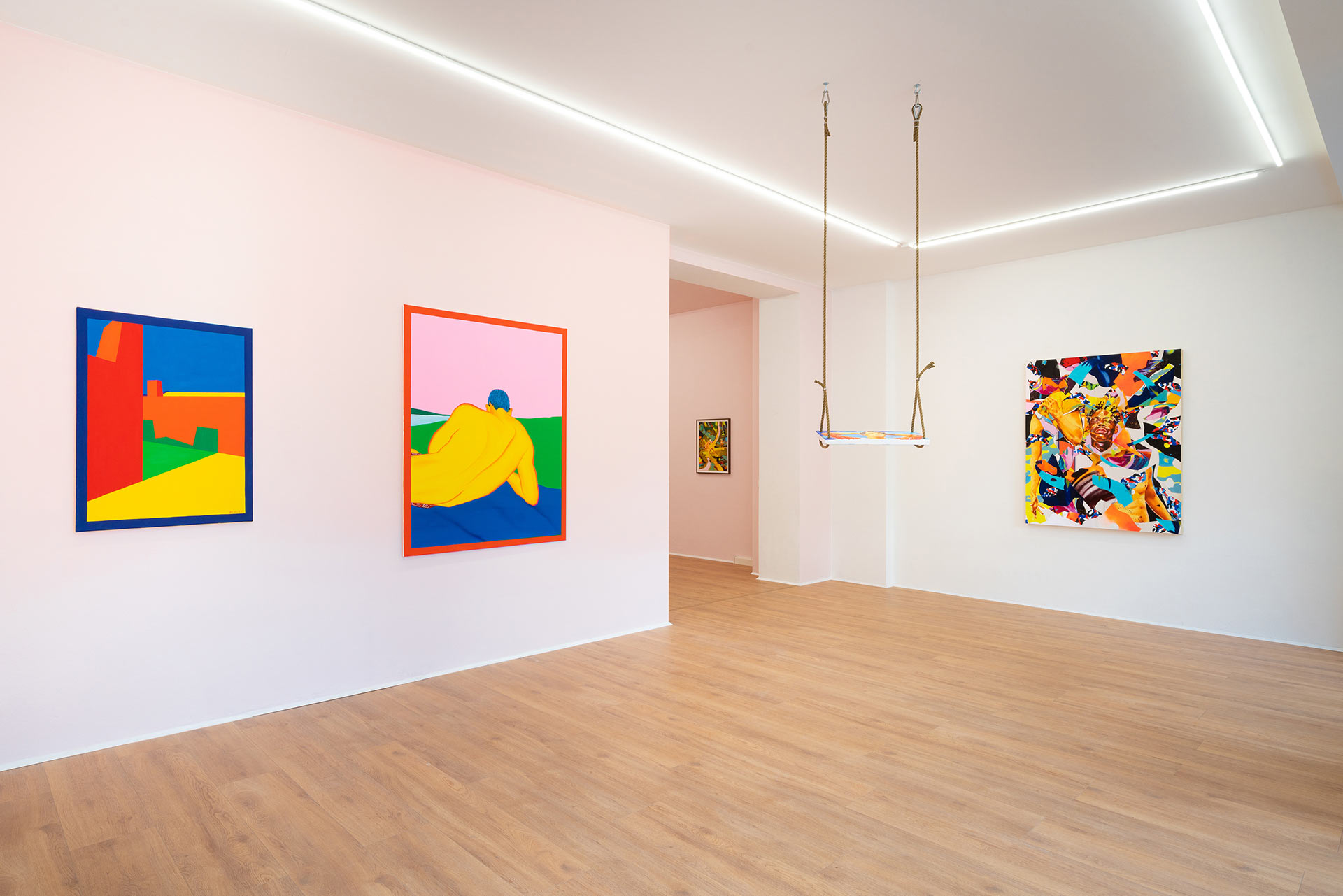
The duo exhibition Swing State shows works by Norbert Bisky and Navot Miller. Two artistic positions whose affinities and divergences sharpen the eye for the particularity of the other. Bisky was born in 1970 in the former GDR, Miller in 1991 in a Jewish Orthodox settlement in Israel. What they have in common is the experience of breaking out of the confines of ideologically shaped parental homes and their adopted home of Berlin, the hedonist’s place of longing.
The title Swing State alludes to the children’s playground outside the gallery’s door as well as to the surrounding city as a play space for adults and the instability of political systems. Two swings designed by the artists take up the motif: A life in limbo is shown, outcome uncertain. Large-format works, usually Bisky’s metier, he leaves to Miller in this exhibition. In Swing State, Bisky focuses on a series of smaller works on paper that show intertwined bodies. Wrestlers on a battlefield that could just as easily be sexual as athletic in nature. In addition, some mirror works are shown. A technique developed by Bisky, which in recent years has taken up an increasingly broad space in his repertoire of expression. Painted canvases are cut up and arranged like collages on reflective surfaces. In addition to fragmented faces and set pieces of urban culture, the face of a retrograde Hebrew clock also appears here. A reference to the relativity of the understanding of time as well as Bisky’s deep connection to Israel, where he lived for several months in 2015.
Through the mirrors integrated into the works, everything surrounding them becomes part of the pictorial staging itself. Viewers are confronted with their own sight, and Miller’s paintings are also reflected in Bisky’s works in a literal way.
Miller’s vibrantly coloured surfaces, which combine to form landscapes, architectural structures, and figures, juxtapose Bisky’s ambivalences with a very tangible, if surreal and dreamlike, reality. On the surface, his images tell of the comforts of a mobile lifestyle. Routines of escapism: Motifs from Europe’s south, the U.S. and Israel are mixed together. Pools, vacation apartments, the cell phone always on the nightstand. Brands and apps that provide a constant stream of impressions and encounters. Miller also playfully turns himself into a brand by affixing his signature as a logo to ever different places in his paintings.
His view is never cynical, however, but rather tender. His paintings tell of longing for certain people and situations, lovesickness as a universal feeling. Miller searches for islands of intimacy in the banal. Small moments of truthfulness in the abundance of possibilities. A back that rises up like a protective wall, a furtive glance caught through an open door.
Finally, in the smallest room of the gallery, each artist shows a portrait of their own mother. A conscious confrontation with the specific circumstances of origin. In Swing State, two generations also meet, Gen X and Millennials, both of whom have been shaped in two ways by the all-pervasive power of pop and consumer culture: once as a broken promise and once as the visual archive of a world gone off the rails.
Bisky appreciates Miller’s boldness, the immediacy of his art, while the latter, conversely, admires Bisky’s attention to detail and mastery of execution. Neither Miller nor Bisky understand the artist’s position as admonitory or even accusatory. They are observers of the present, fascinated by the kaleidoscope of media-mediated realities and their possibilities of escape. They are interested in the coping mechanisms of human beings.
Text by Diana Weis
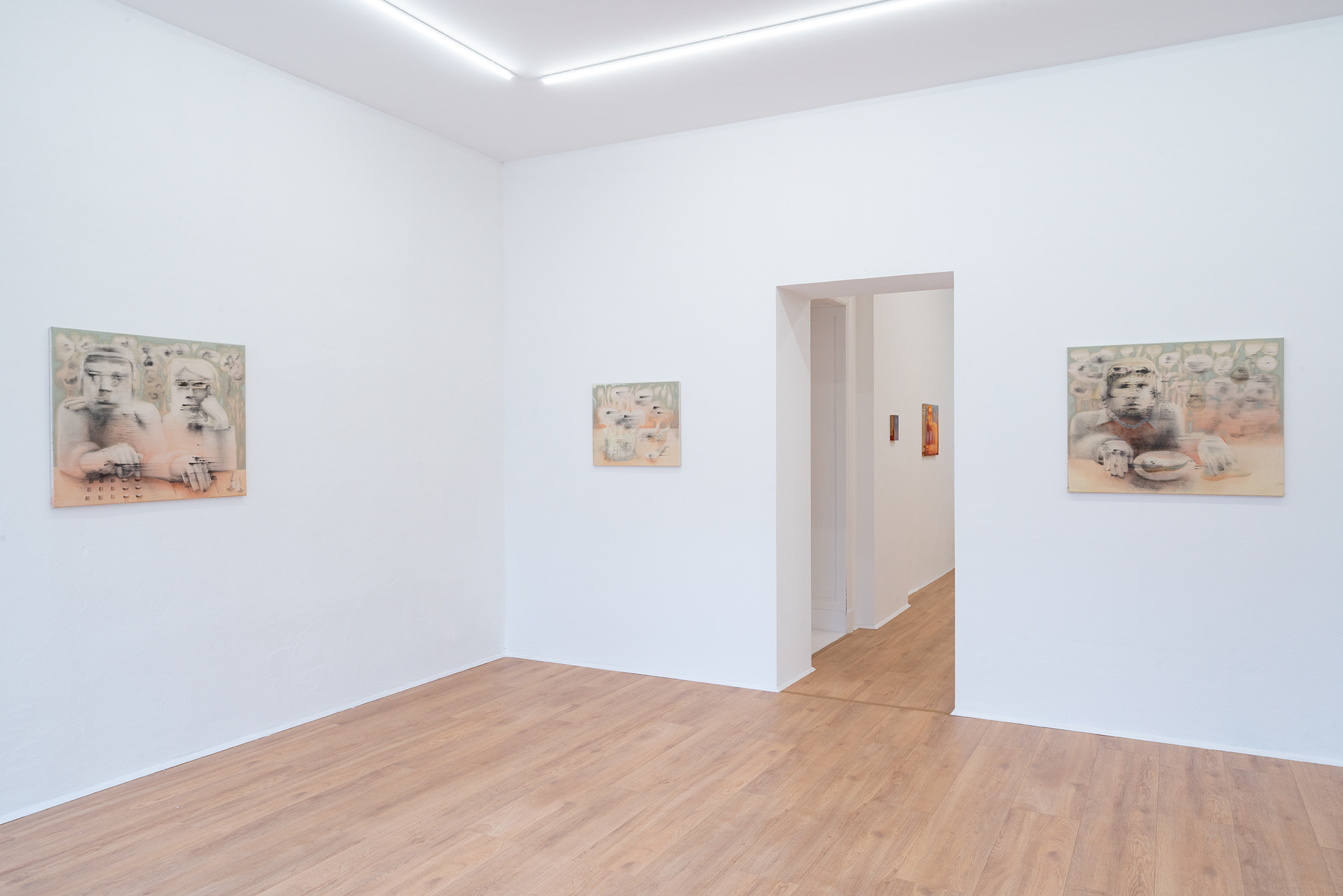
Weserhalle is pleased to present the first solo-show in Germany by the Berlin based artist Emil Urbanek titled In Pears, showcasing a series of new paintings that focus on the “examination of being” and reflect on different stages of identity.
In their characteristic painterly style that is reminiscent of both analogue photography and vanitas, a form of still life painting which focuses on the transience of life, they introduce characters and objects that find themselves in obscure moments of intimacy. By playing with components such as blurriness, grain and lighting, Urbanek creates a dynamic in their works that suggests traces of movement similar to long-exposure photography. Simultaneously the work evokes a nostalgic feeling: On the one hand, the visual surface is reminiscent of colourised black-and-white photographs, and on the other hand, we find an archival quality that is associated with the medium of photography.
Urbanek creates a space that seemingly exists between memory and change, standstill and movement, with a strong focus on the topic of gender, in which they plant one of their key motifs – the bush. It appears both front and centre and in some cases, almost hidden in the background behind wandering characters, unbound by time and space. By painting the bush Urbanek perceives a possibility to outsource memories of an alternate version of oneself. One, that was left behind but keeps existing in the background. It can be re-visited as a disconnected part of oneself and as bushes are arguably perfect hideouts, depicts a potential for unexpected and like-minded encounters.
The bush also enables a simultaneous presence of a figure and its counterpart realities, therefore allowing them to physically interact. As Urbanek continuously tends to the metaphoric bush in their painterly position, it has come to bare fruits in the form of pears. To domesticate and harvest these fruit narratively becomes an act of bodily autonomy.
The pear for Urbanek is an odd-shaped fruit, that is more sensitive and less popular when compared to favourites such as the apple. It draws many parallels with what they witness in how the queer community co-exists in a heteronormative world. The fruit again draws a connection to the vanitas sujet, as it is often represented in classical still life painting. But Urbanek reappropriates the idea of vanitas as a depiction of the circle of life and death and interprets it as a moment of in-betweenness. A place where the unreal, the real and the not-yet-real meet and exist in Pears.
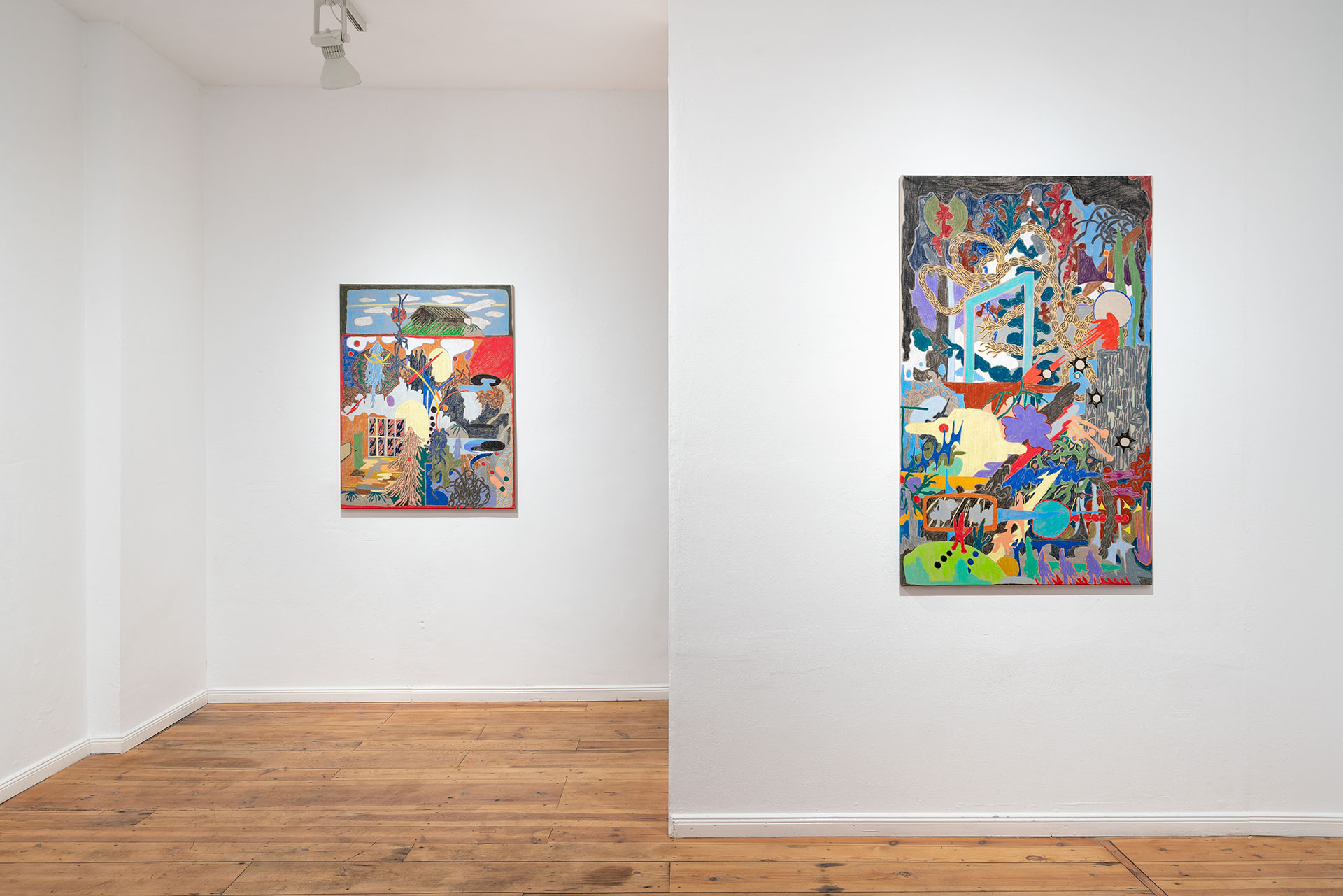
Anthill by South Korean Artist Jung A Lee is her first solo-exhibition in Germany. In her new series of canvases, Lee focuses on two central ideas: Firstly the idea of the human mind as a multi-facetted structure, that like an anthill, only reveals a small part of itself to the outside world, but can hold unexpected depths. Secondly visualising the relationship between “the inner and the outer world” how Lee describes it and the anthill as a metaphor for an altruistic society that functions according to Derrida’s idea of absolute hospitality.
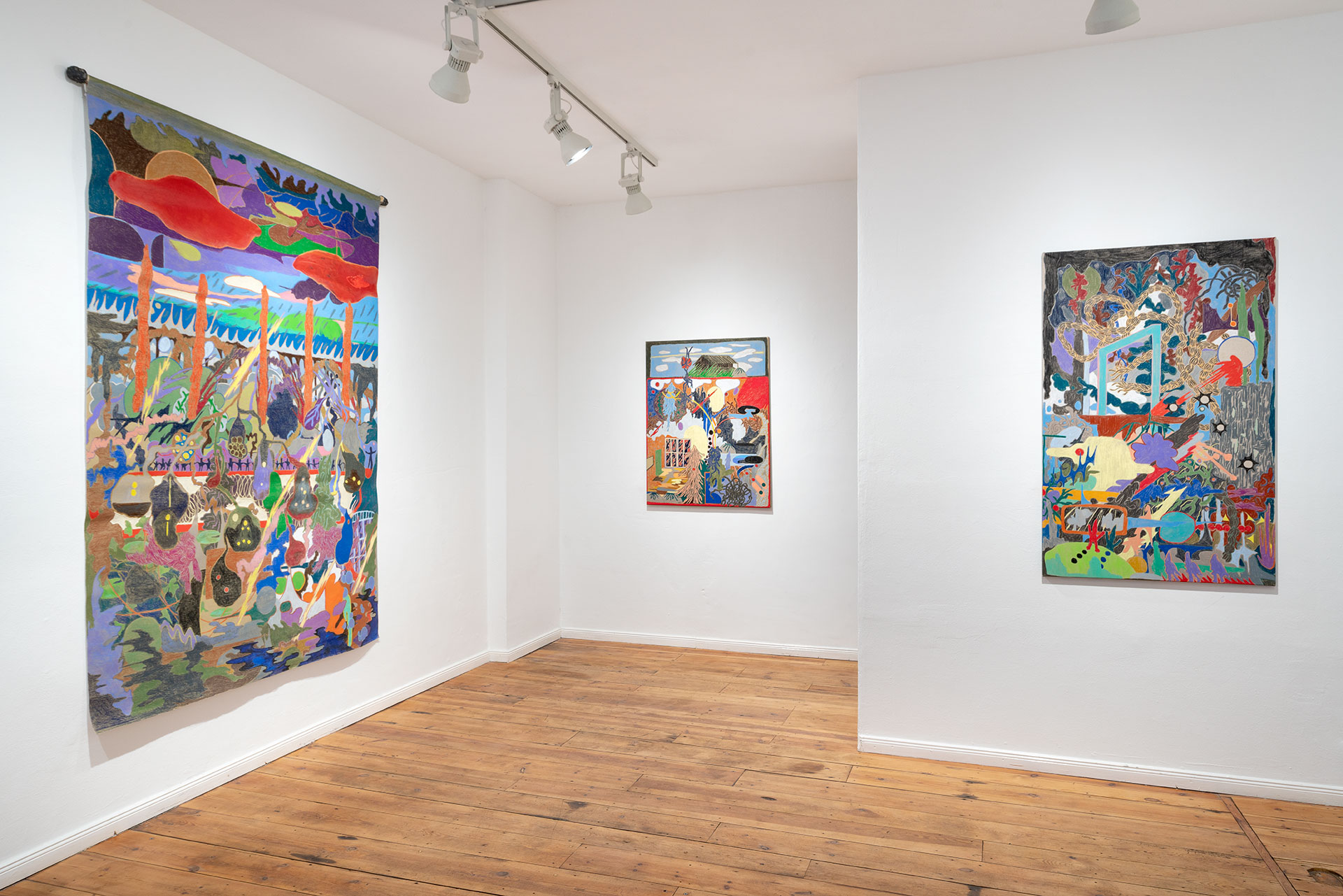
Her exploration of the human mind was inspired by her personal experiences during the pandemic, where she reconnected with her heritage, culture, and Buddhist philosophy of life. She reflected on difficult current topics such as government control and war, along with more personal themes such as the fear of death, hatred, the self, and her position as a foreigner living in Berlin. By facing these concepts, she was able to excavate layers of her subconscious and found a fascination with the intertwined relationship of our mind and reality.
Lee takes interest in Jacques Derrida’s theory of “absolute hospitality” and the idea of opening the door to welcome an unexpected guest in a situation that might otherwise violate one’s sense of self. She reflects on the idea that everything is related, and if one component ceases to exist, the other will too, which is a fundamental idea of Buddhism called the “dependent arising phenomena”. In the context of the anthill, she observes that this idea also applies to the fluidity of the self, which is not fixed but rather mutable in response to the surrounding environment.
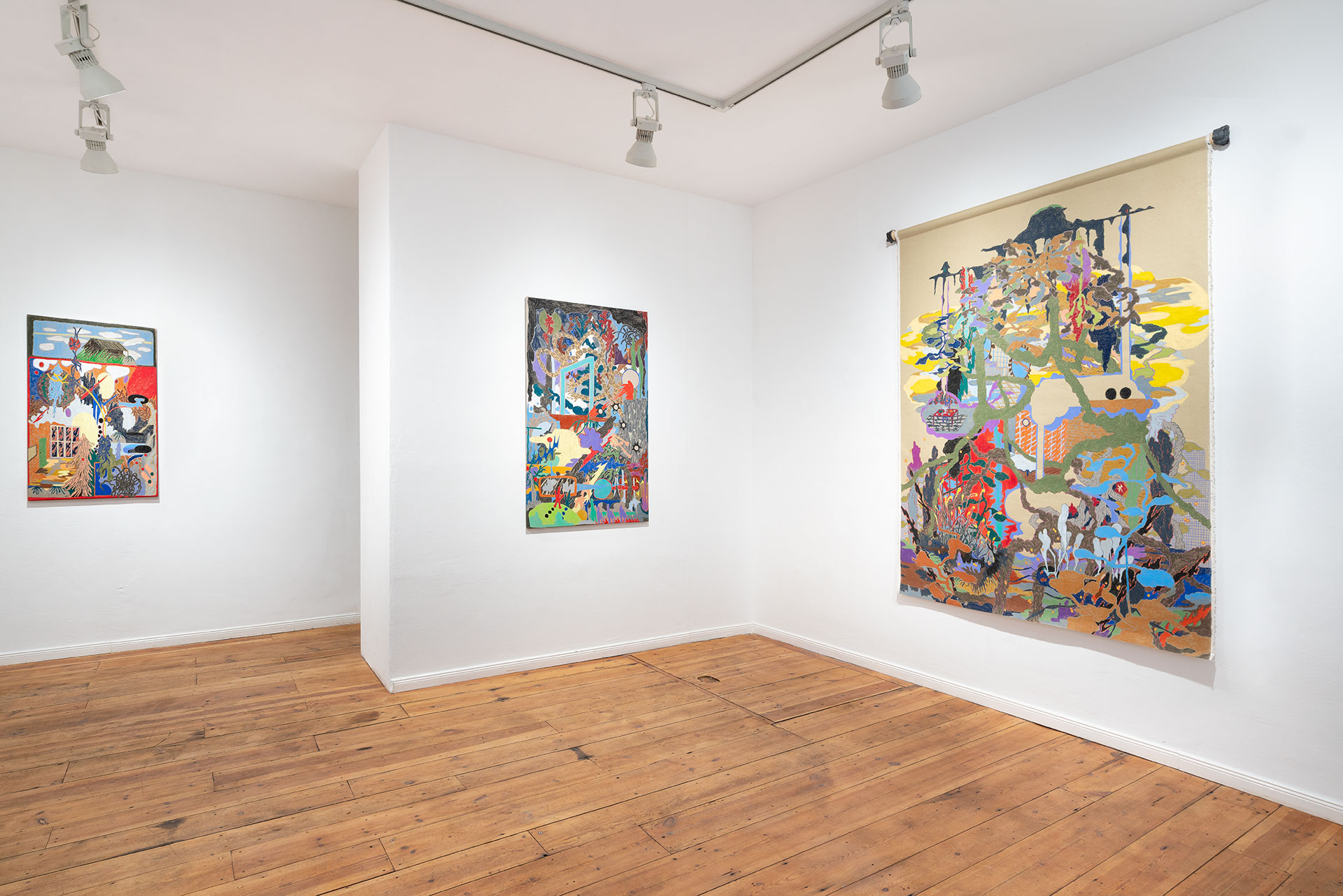
Creating dreamlike landscapes, Lee references shapes and movements from plants, with inherent abstract qualities. Her visual language hints at fleeting presences of humans, animals, architecture, and landscapes that appear and disappear in a dynamic flow created through her technique and use of colour. She works with crayons and coloured pencils on canvas, which is more immediate and better suited to capturing her dream experiences, and often works on unstretched canvas, suspended like a scroll from the wall.
Jung A Lee’s Anthill exhibition is a profound exploration of the human mind and its relationship with the outer world. Through her work, she invites viewers to contemplate the fluidity of the self and the interconnectedness of all things.
Jung A Lee, born in 1995, is a South Korean artist who lives and works in Berlin. She has been studying fine art and painting at Weißensee Kunsthochschule Berlin since 2017 and received a scholarship from the Mart Stam Foundation in 2021.
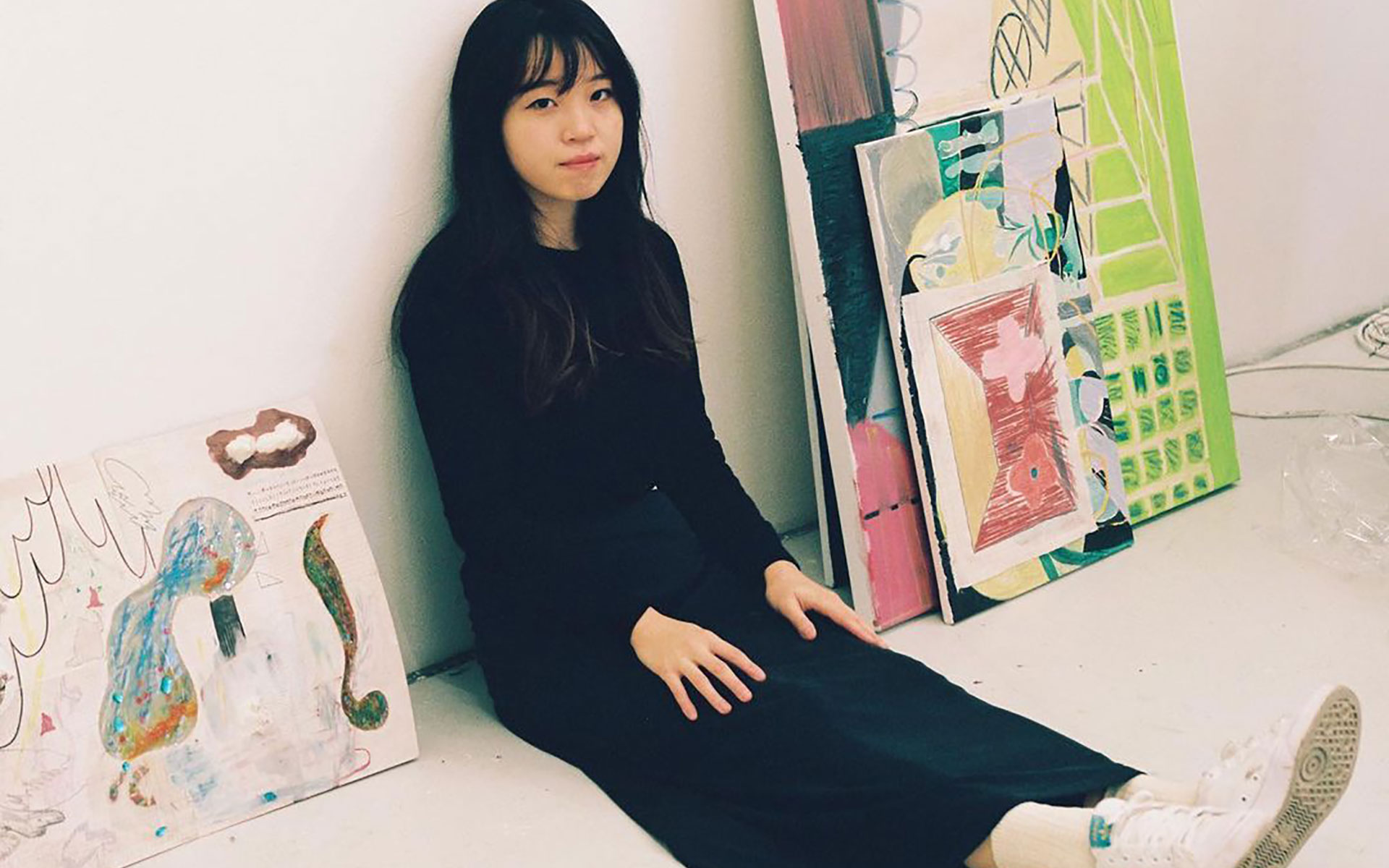
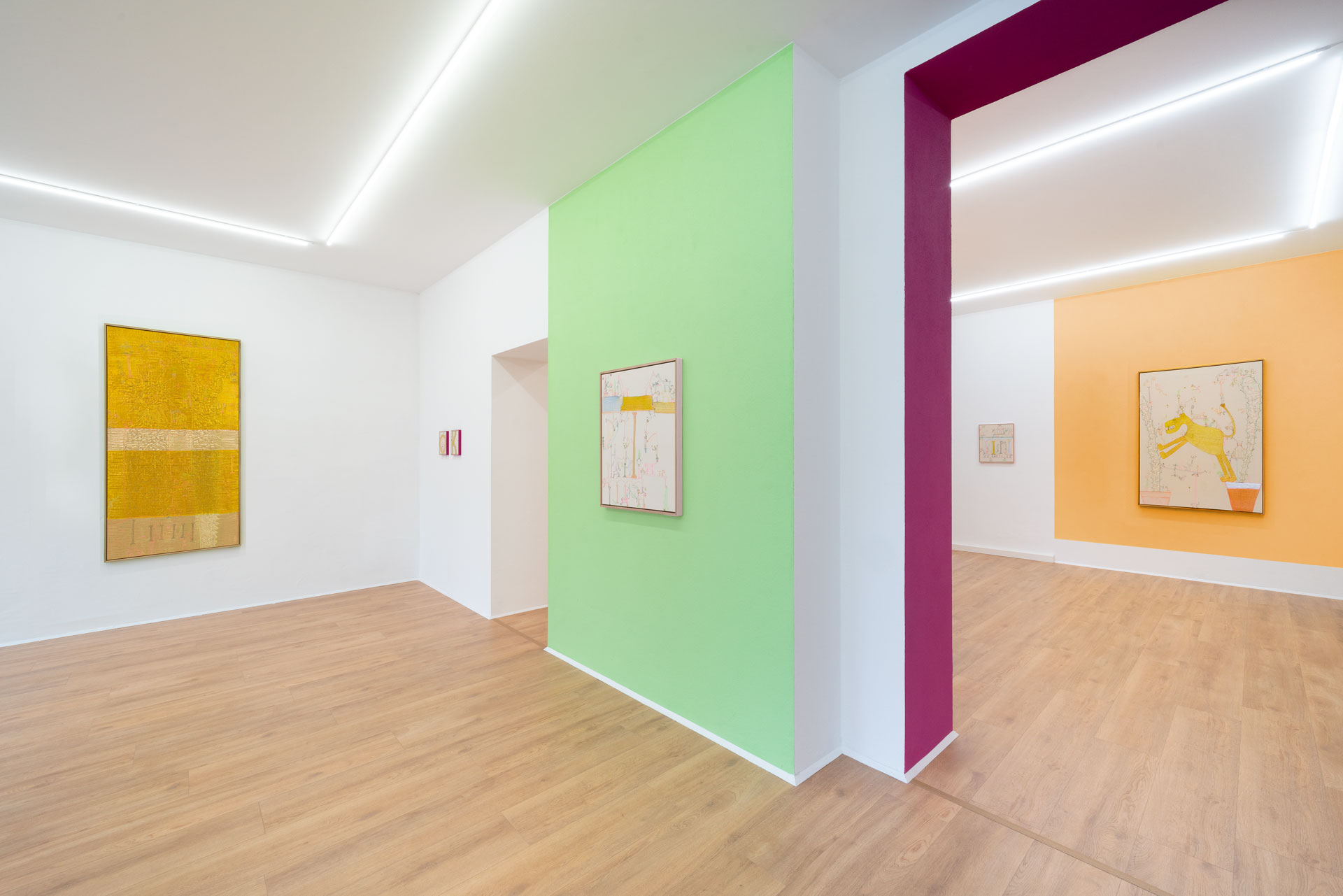
In his first solo exhibition at Weserhalle, titled “Von Krokodilen und Löwinnen” (“Of Lionesses and Crocodiles”), Georg Haberler presents a series of new mixed-media works that construct worlds through impressive compositions that appear to be on the verge of collapse, but always maintain their balance.
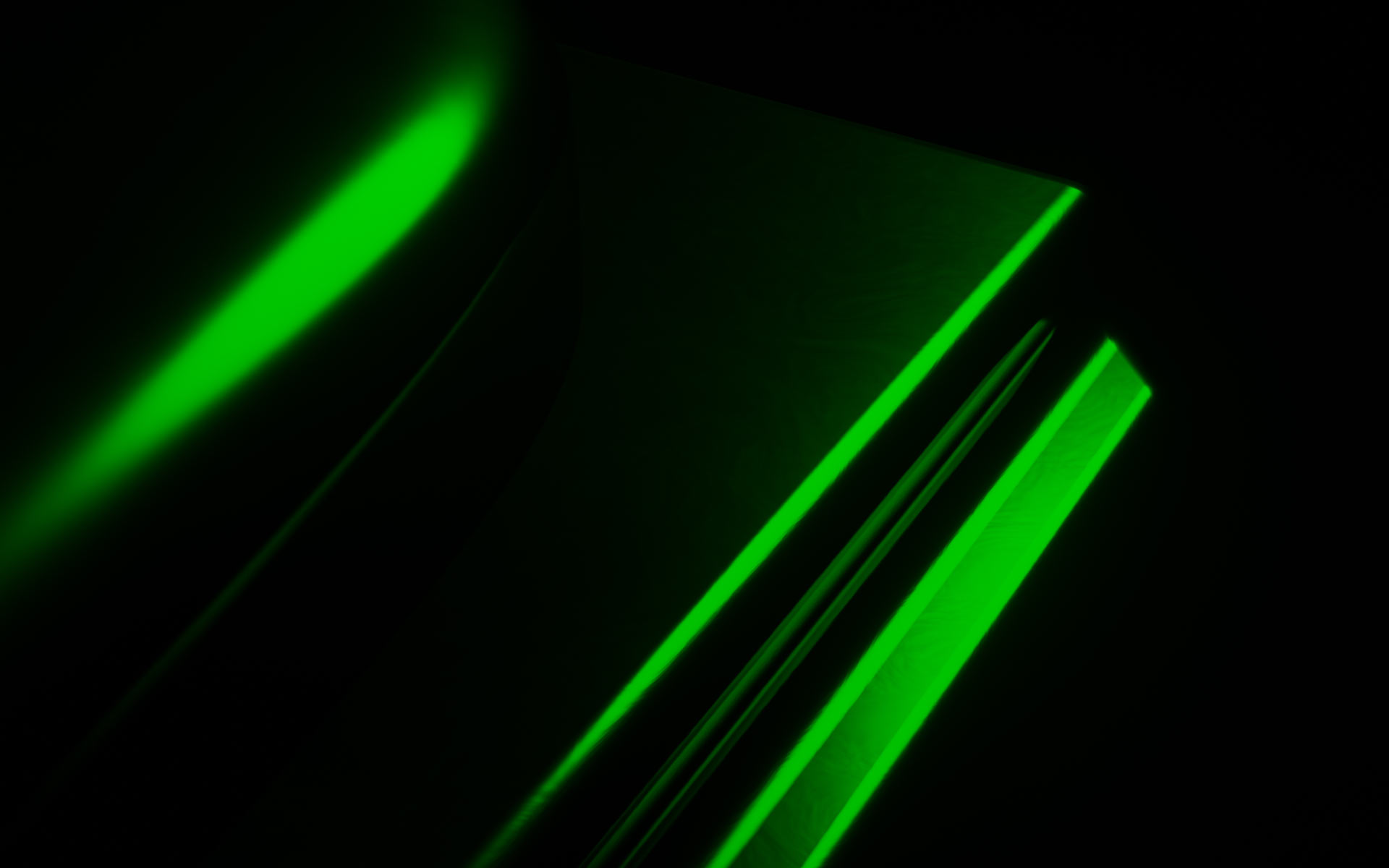
Toninho Dingl describes SULO-Y, a smart bin designed to patrol the streets, coming to the consumer not the other way around, as a satire for the current capitalisation or development of new investment fields in the technology sector. The project is equipped with all the buzzwords of Industry 4.0—the idea of a fourth industrial revolution driven by high tech industries: Internet of Things (IoT), artificial intelligence (AI), and machine learning (ML) to improve efficiency, flexibility, and automation. It promises investors a profitable business and a better future.
Visually and conceptually, SULO-Y is hefted to the level of Tesla, Apple, and other “smart” technology phenomena, but the banality of the object turns it into a paradox of excess and also takes the mechanisms behind Industry 4.0 to absurdity. Dingl describes, “It’s actually the same ‘garbage’ merely more smartly designed, better marketed, and painted a little greener… just like SULO-Y, which doesn’t solve the garbage problems of over-accumulation or external costs, but is mainly meant to be a new investment field for our investors.” Quite literally, the investors should invest their money, gladly also Bitcoins, into the smart bin—WASTE YOUR MONEY! The main thing is to produce, consume, and invest more to maintain capitalist mechanisms.
The exaggeration of the “shiny” smart bin, the “shiny” web presence, and the “shiny” marketing in contrast to the reduction of artificial intelligence to its binary of zero and one—between “smart bin GO” and “smart bin STOP”—leads to the big doubt, which can also be found in the project name… SULO-Y …Why?
SULO-Y is part of Dingl’s critical body of work of paintings and sculptures in which language plays a major role, discussing the unstoppable capitalisation of our environment and ourselves. With a nod to filmmaker Alexander Kluge and the Frankfurt School, he treats every object definition as flexible in his contradictory work, aiming to dissolve and possibly reverse the “frozen conditions” of the viewer’s perception, or in the artist’s own words “sometimes you have to play things their own music to make them dance, or in this case their own algorithm.”
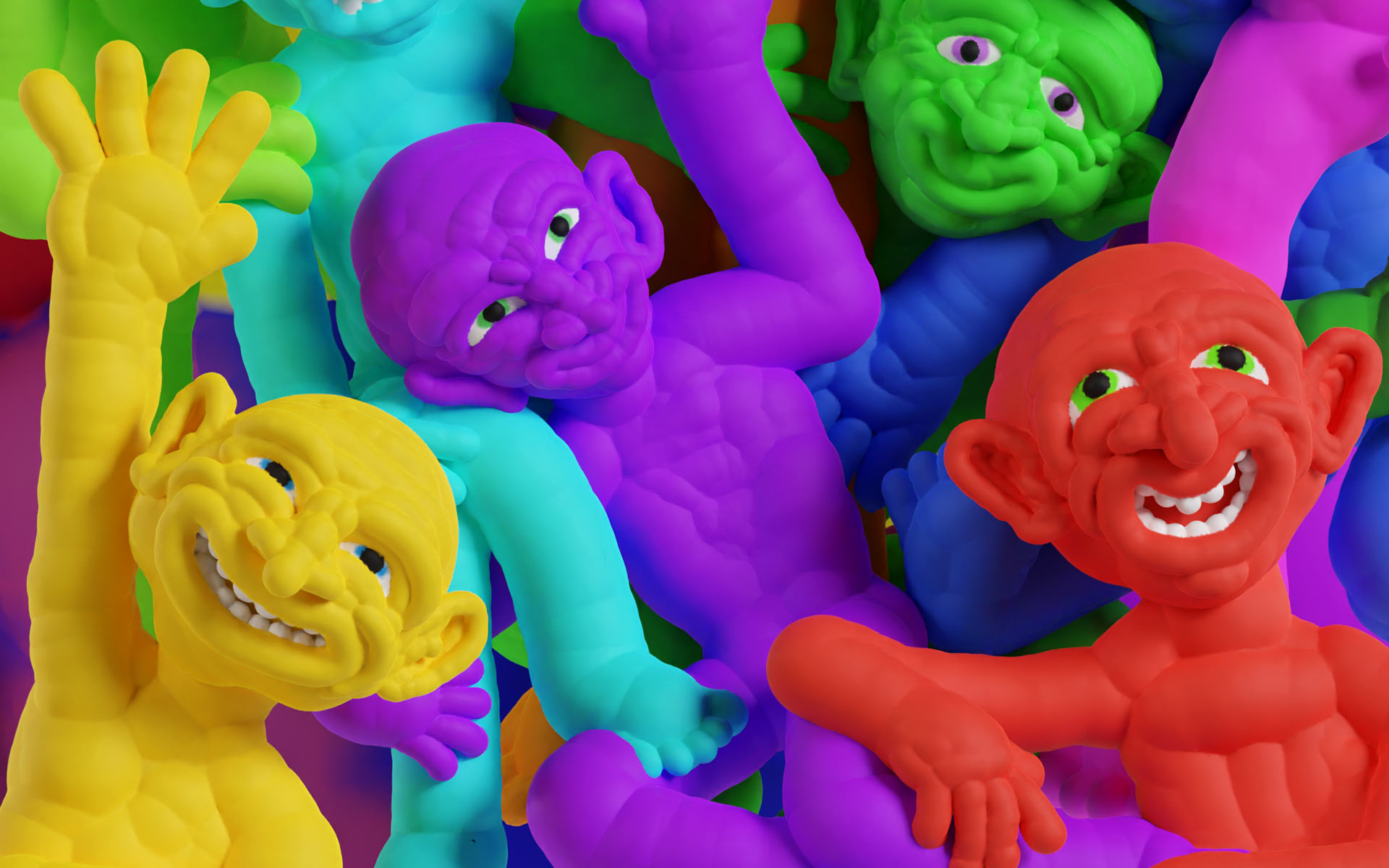
Our first group show of 2023—Way Too Human—opens 13 January. Participating artists will be announced shortly. Signup below to get notified.
Featured artwork by Tokyo Tommy.
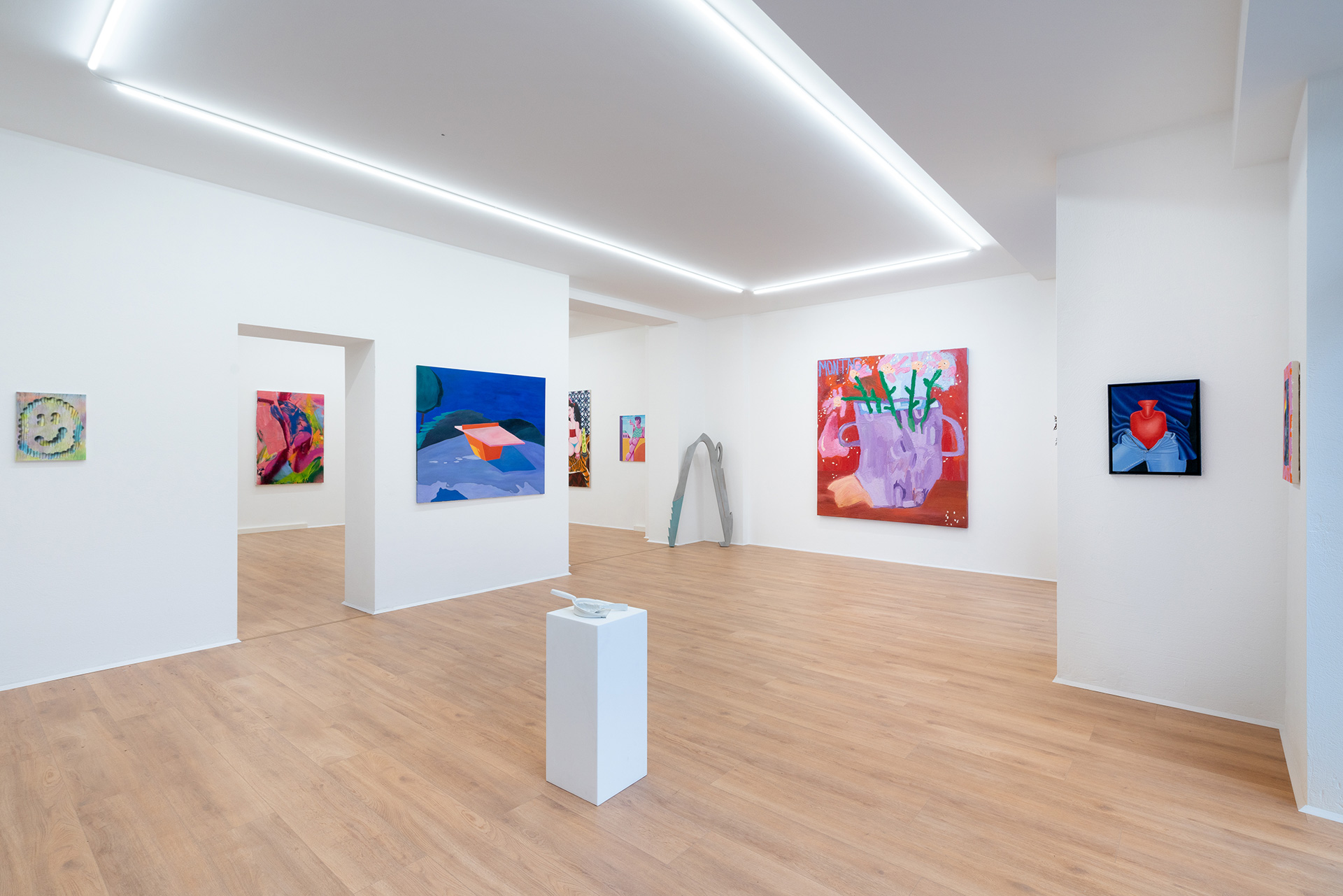
We are happy to announce the tenth edition of Weserhalle’s Art Auction curated by Navot Miller and Ivana de Vivanco, opening 1 December, 18:00—21:00 at our new additional location, Weserstr. 46.
The event is comprised of 2 parts;
1. The physical—a curated exhibition at Weserhalle (Weserstr. 46).
2. The digital—an online presentation at weserhalle.com, where the work will be available (for viewing and bidding) via our auction, with opening bids typically ranging from 50€—5.000€.
Participating artist will be revealed shortly. Signup here to receive updates.
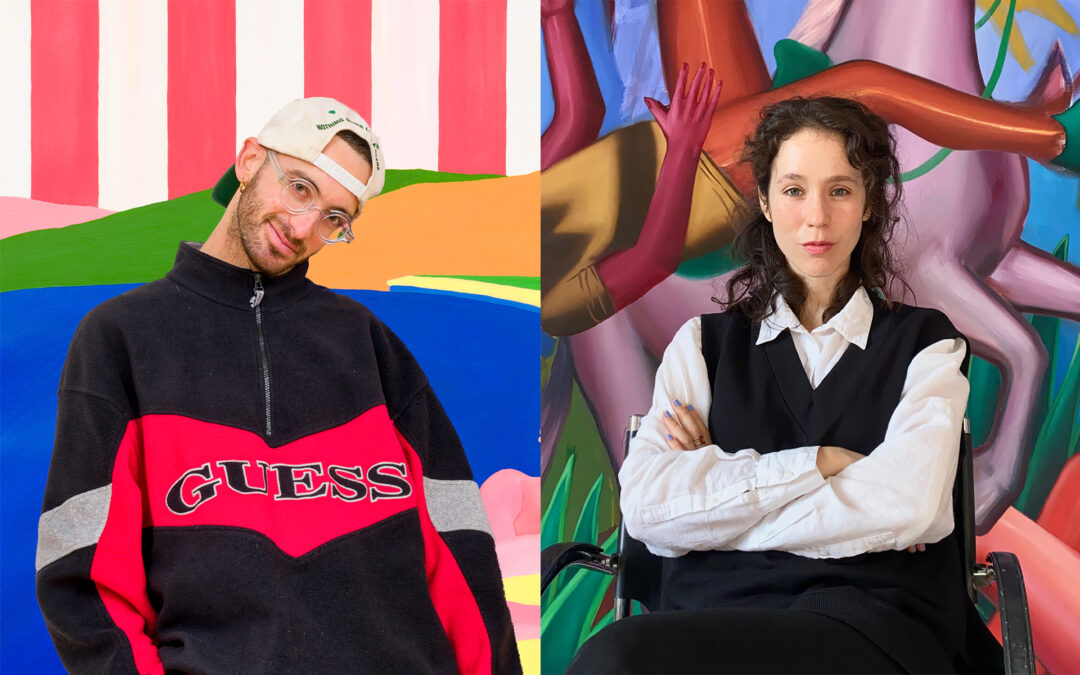
Navot Miller is a Berlin based artist from Israel, currently studying at the Kunsthochschule Weißensee. Millers work is known for its characteristic compositions fuelled by the flamboyant use of colours and the intensity of the exploration of flatness through the means of collage. He opened this years program at Weserhalle with his Colourful, homo, great exhibition, going on to exhibit at Grove Collective (London, April ’22) and 1969 Gallery (New York, June ’22) both of which were curated by Russell Tovey.
The Berlin based Chileniean-Preuvian artist Ivana de Vivanco completed her studies at the Art Academy of Leipzig under Annette Schröter. Her canvases carry her unique language of Hallucinatory, decadently colourful, and utterly compelling scenes, that depict a host of unseemly players in order to reflect the absurdities of the human-made world. Her work were most recently exhibited in 68Projects (Berlin, September ’22) and Galerie Droste (Berlin, September ’22), and will be a part of Art Cologne with Galerie Anita Beckers and Kornfeld (Cologne, November ’22).
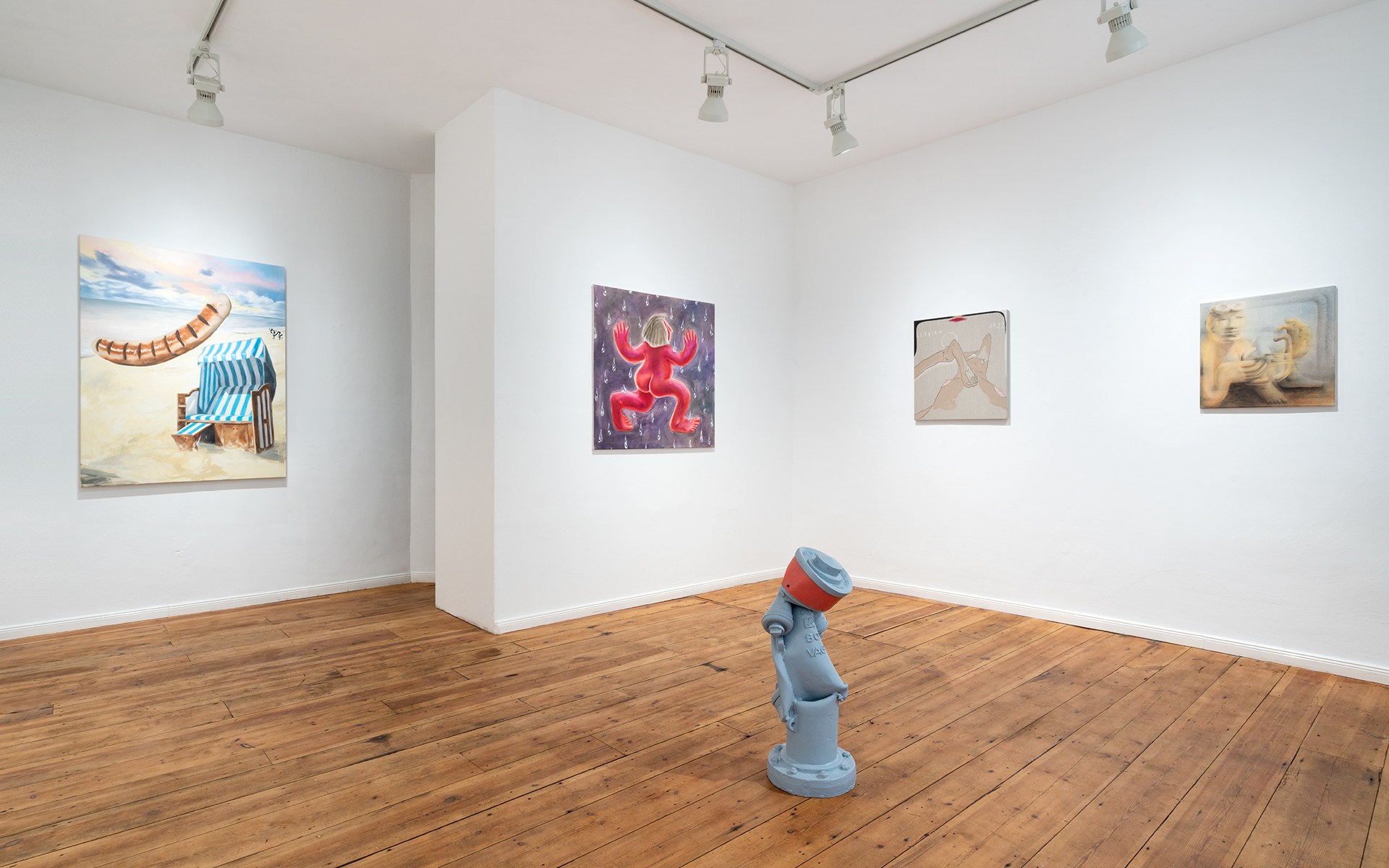
Exhibiting Artists:
Albrecht/Wilke
Anouk Lamm Anouk
Emil Urbanek
Francois Thevenet
Georg Haberler
Rafał Dominik
Ron DeFelice
Tamara Malcher
Toninho Dingl
Celebrating its fifth anniversary, Weserhalle presents Future Solos, a showcase of exciting artist positions that are yet to come. With a strong selection of works by local and international artists in the physical and digital realm, Weserhalle continues its program’s characteristic language, reflecting on sociocultural and visual trends that are yet to be defined.
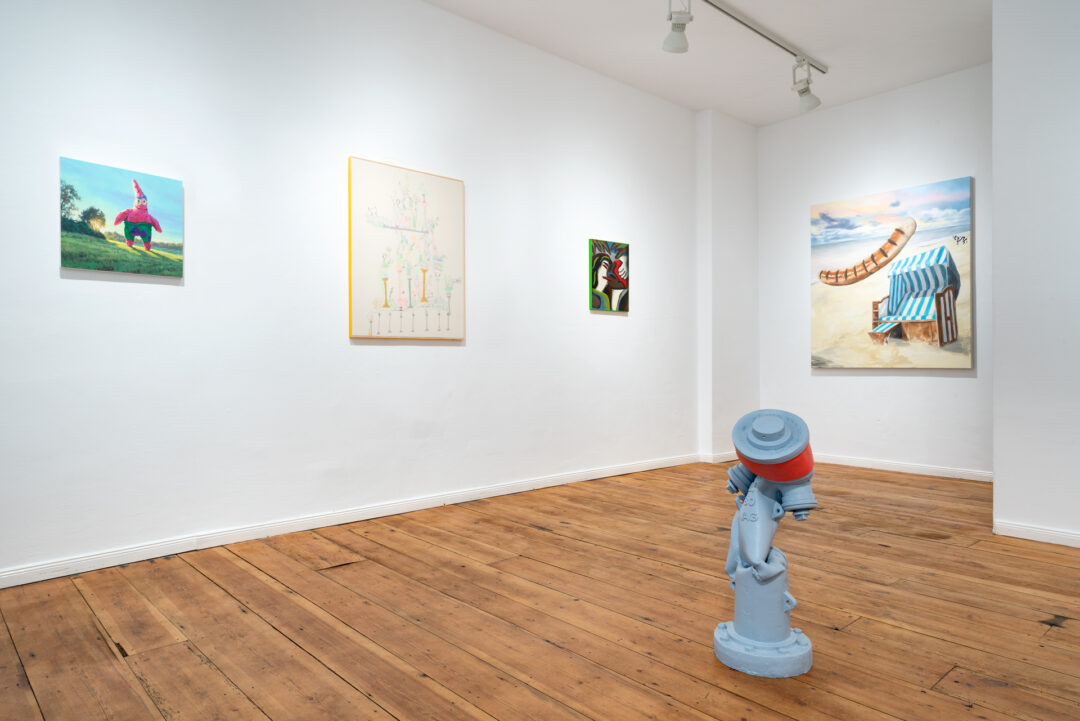
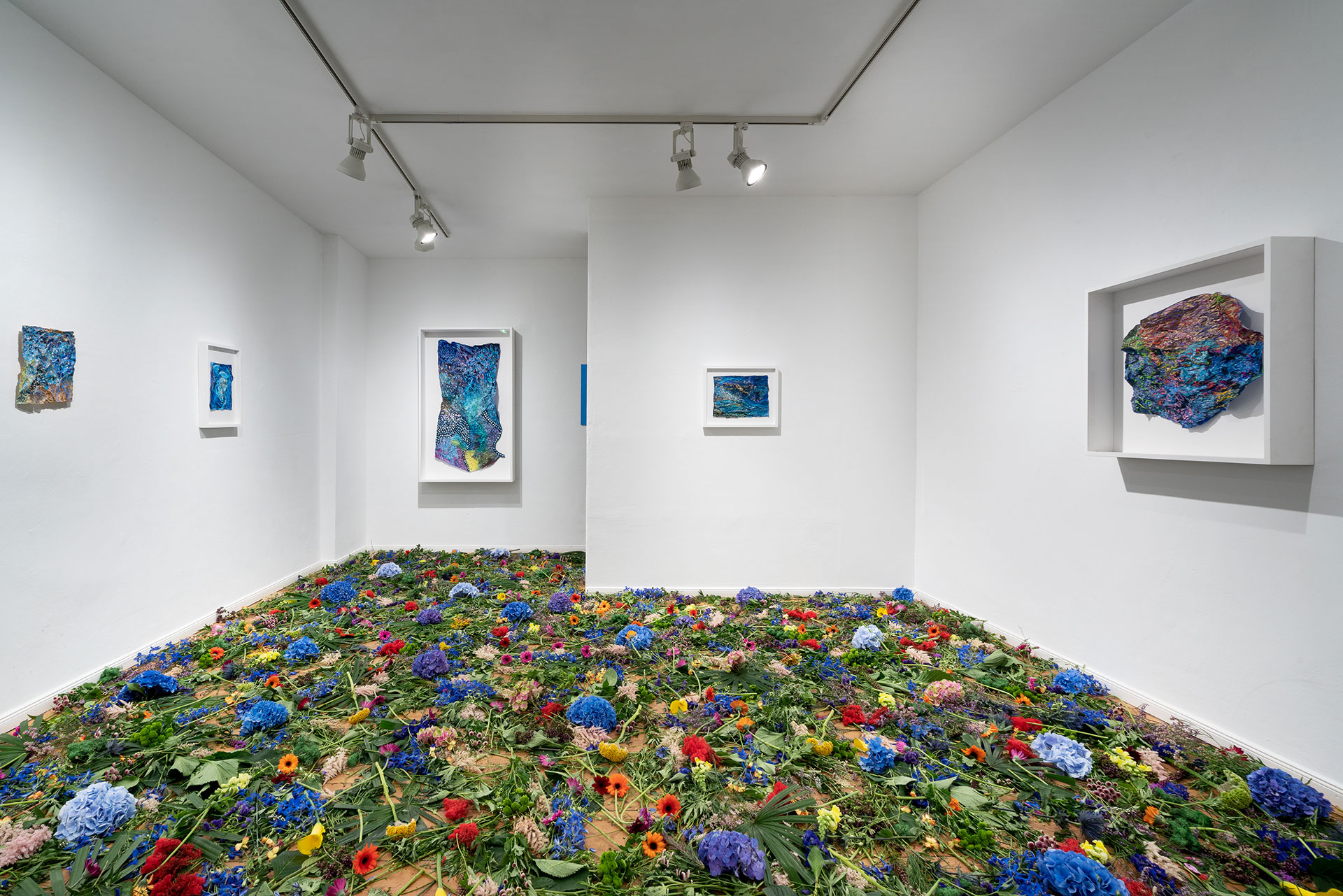
Igi Lola Ayedun exhibits for the first time in Germany at WESERHALLE with her solo show “Woman of colour y otros clichés”. The Brazilian artist delves into her study of the colour blue with a new series of paintings recently produced in São Paulo.
A digital retinal scan taken from Ayedun’s own eye has been used as a starting point for this body of work, creating abstract forms that guide us through foreign galaxies. Entering the exhibition the viewer is submerged in a world of Ultramarino and Indigo blue in which the different textures of the paintings recall forgotten ancestral knowledge combined with the ability of envisioning new futures.
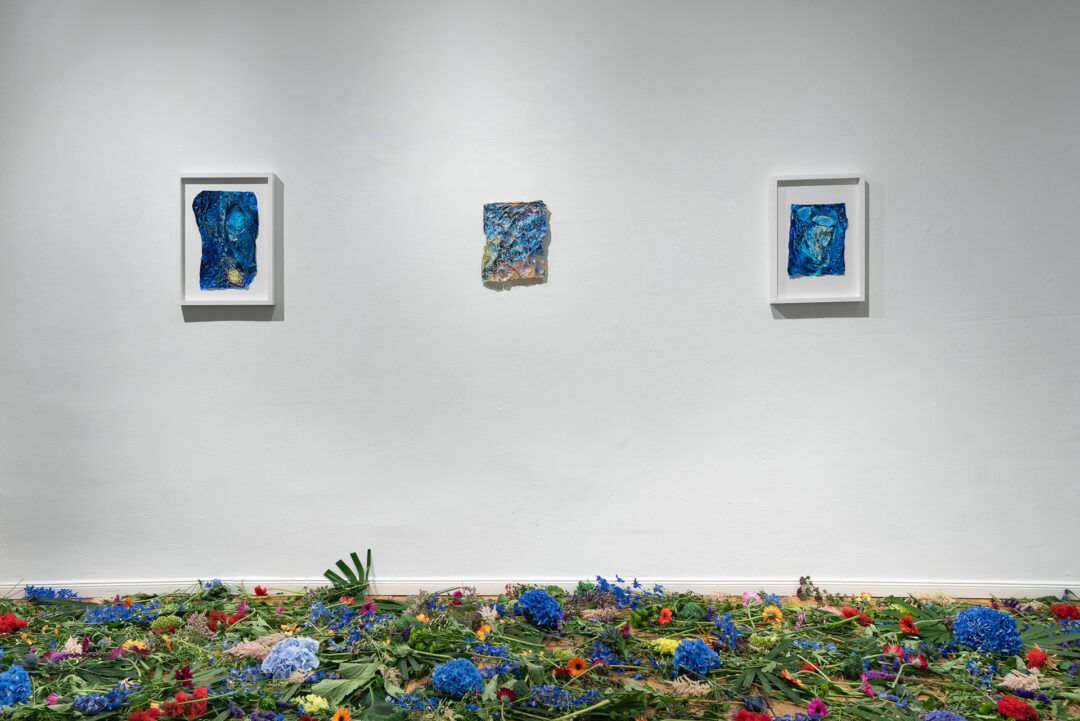
The latin name Ultramarinus (beyond the sea) references the overseas trades between Afghanistan and Egypt during 14th and 15th century and its distinctive vibrant colour is obtained by grinding lapis lazuli into powder. The indigo blue has been of exceptional importance throughout history to diverse civilisations, with evidence of its cultivation dating back to 4000 BC. Ayedun’s dive into this colour stems from her understanding of non-western painting techniques and human history that precedes Europe as protagonist and storyteller. She reclaims the colours’ significance as a transcendental visual memory throughout time and cultures that precedes euro-colonisation of the global south.
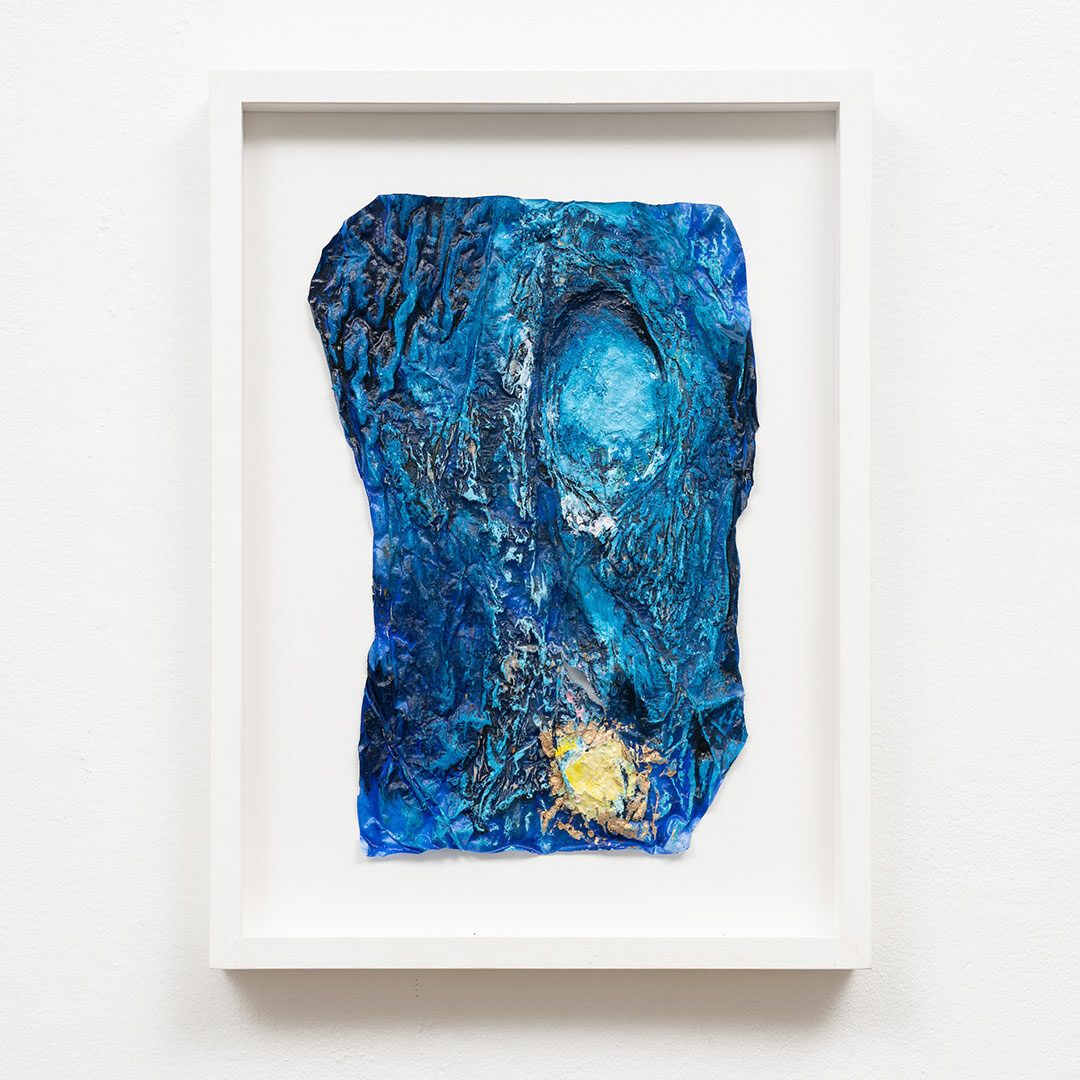
Ayedun applies this transcendental concept to her materials by creating hybrid forms, introducing attributes of digital topography onto artisanal pellicles. In 2019, she set out to make her own canvas from vegan materials. She uses a mix of argan oil, butter paper, oil painting, corn paste and latex to manipulate the surface, bringing the digital landscape into the physical. Her experimentation with pigments and texture form together to create future artefacts, from planets still unknown where more advanced species inhabit; perhaps without identitarian agendas;
In times where neoliberal identitarian politics have become the norm to be consumed, how much freedom is allowed to artists who belong to the global majority to reflect their own subjectivity? How much space has been given to racialised people to reflect on their own thoughts and desires, dreams and fears without being affected by these categorisation conditions?
Text by Arantxa Ciafrino.
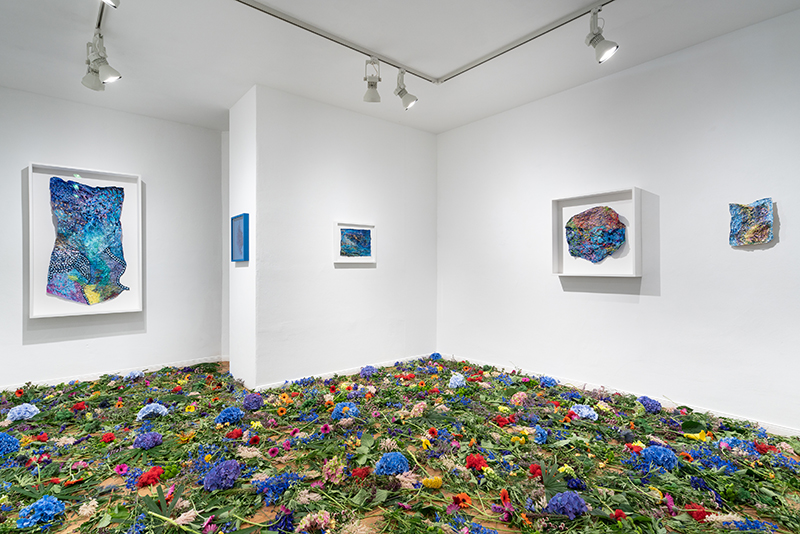
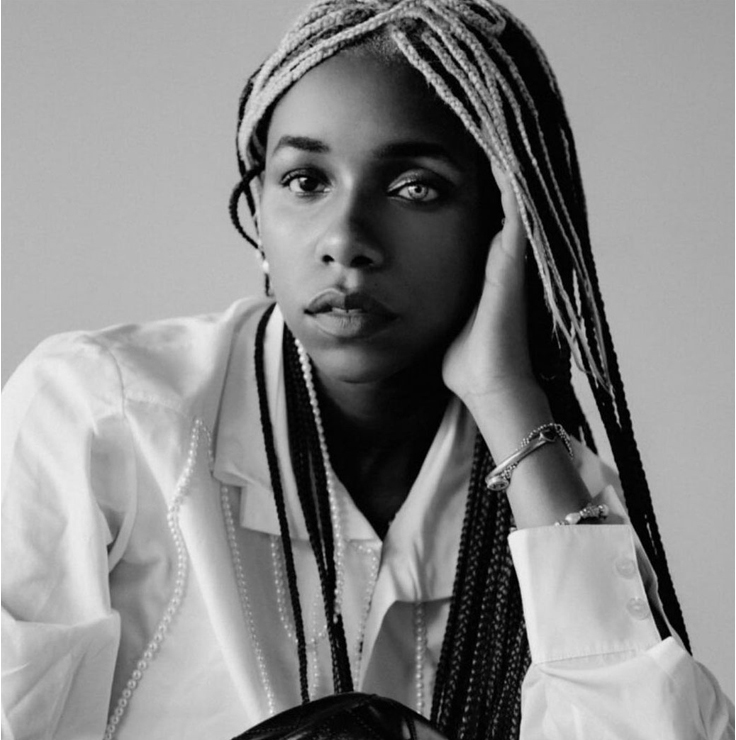
Igi Lola Ayedun (B.1990, São Paulo – Brazil) is a multimedia artist and gallerist who works with painting, video, 3D digital sculpture, photography and sound. Founder Director of HOA, an organisation dedicated to a decolonial perspective of latinx contemporary art focused on artists from the global majority. Her artistic practice is guided by the cultural and biological potential of colours, in particular the colour blue is taking centre stage of her current research as she explores the global routes of indigo, the lapis lazuli historical legacy and power of minerals in order to rebuild life-cycles through the artistic materiality itself and her dream’s emotional-visual descriptions.
Her work has been shown at MAR – Museu de Arte do Rio de Janeiro (2022), Mendes Wood DM Brussels (2022), Pinacoteca de São Paulo, São Paulo (2021), Christie´s Rockefeller Plaza, New York (2021), Instituto Tomie Ohtake, São Paulo (2020), ETIÓPIA Centro de Arte y Tecnologia, Zaragoza (2019), Galeria Baró, São Paulo (2019), Espaço Breu (2018), Konvent 0, Barcelona (2018), SP-Arte Performance (2018), Teatro Oficina, São Paulo (2017) and Oficina Oswald de Andrade, São Paulo (2009). Ayedun believes that the juxtaposition of ancient and contemporary technologies is a spiritual way to preserve African ancestralism to the future.
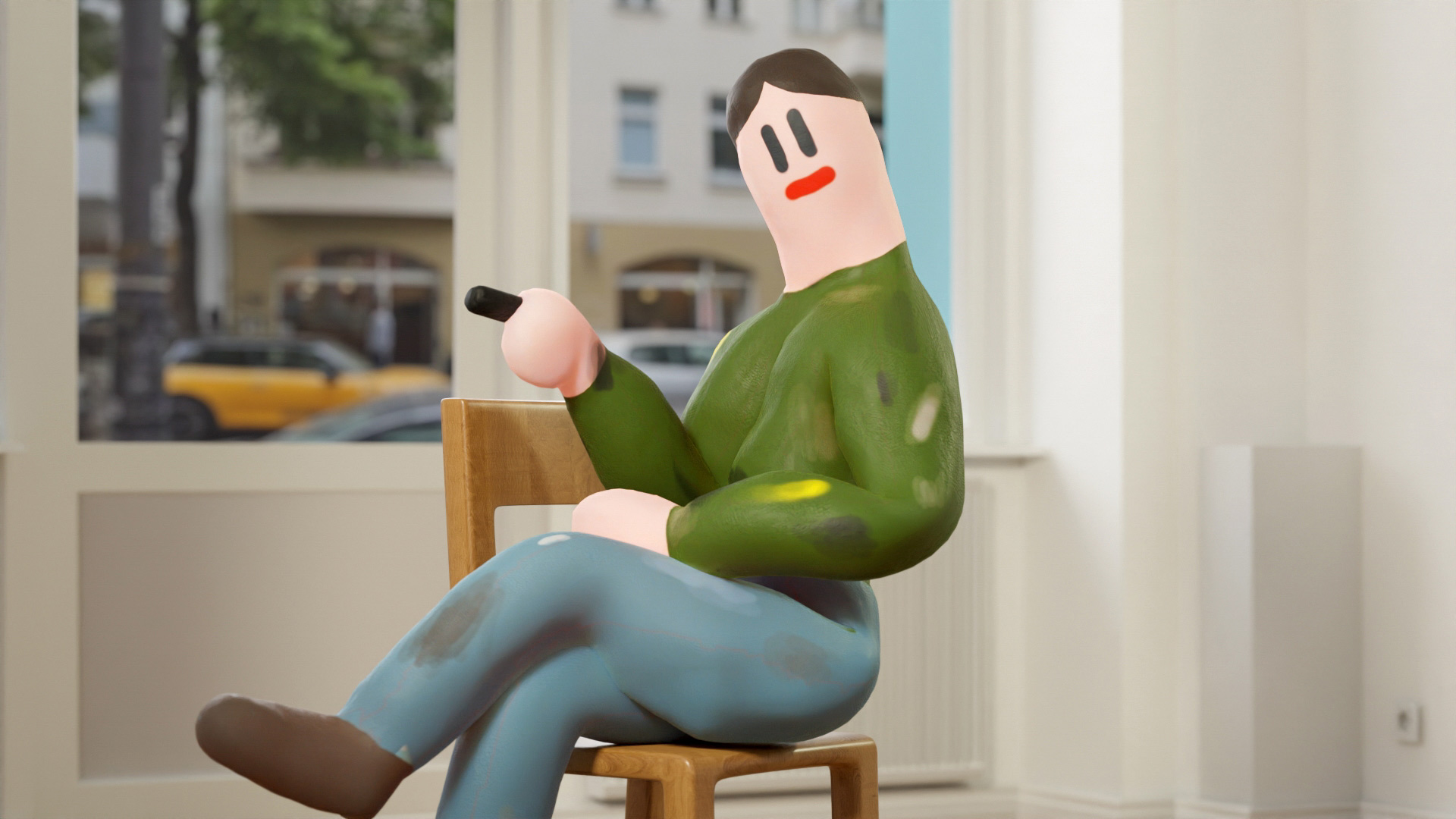
Preface: Steven is a fictional character created by the artist Stephan Dybus. Dybus is a Visual artist based in Berlin. He studied Visual Communication at Burg Giebichenstein – University of Art and Design Halle. His work flips the narrative of self image and self optimisation in our present day existence, working with themes that resonates with our own imperfections and inadequacies as human beings.
Steven’s first solo show at WESERHALLE marks their departure from creating art purely online, with a move towards synthesising physical reality within their practice.
Upon entering the gallery, the visitor is initially greeted with several abstract works. One of the paintings leans against a wall. Another is found hanging at an awkward angle. A third, tiny painting looks a little lost in the space that surrounds it. All of the works are united by their thick, black expressive brush strokes, almost straying off the surface of the canvas and onto the wall with energetic movement. These seemingly frantic gestures are also captured in a mural on the back of the gallery’s furthest wall, where the markings sit uninterrupted by a canvas.
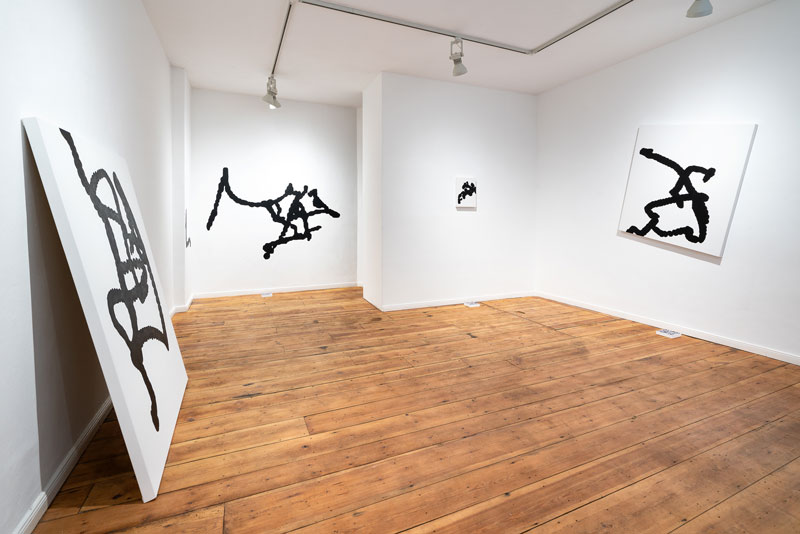
Though the gallery is occupied with Steven’s physical works, it is the process that is of equal importance. Each work is accompanied by a QR code which leads the visitor to a video documentation of the process behind the artwork. The videos reveal Steven gyrating around the gallery, interacting with the canvases with their paint stick, confirming that the works have been produced on site, in the gallery. At first glance, the documentation of the process feels performative, but after the 4th or 5th loop, one starts to wonder if this might be the way this particular artist naturally moves.
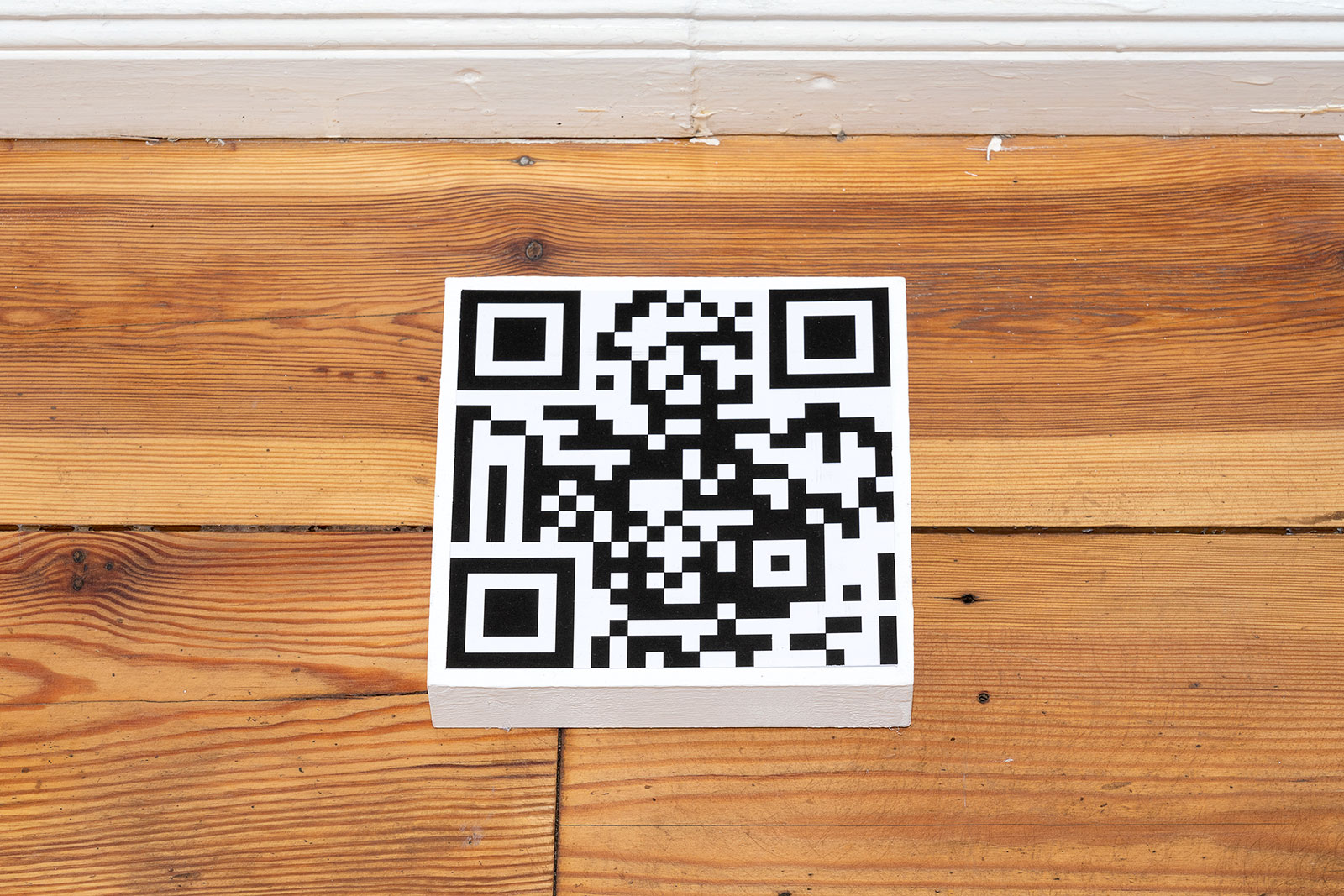
By simultaneously experiencing the works in the gallery alongside their online counterparts, the boundaries between the digital and physical dissolve, with the strength of the work laying somewhere in the middle of this experience, both aspects relying upon each other to be fully appreciated. One could conclude that it is the process (documentation), not the end result (the paintings), which becomes the main focus of Steven’s art. With this perspective, the physical works feel more like evidence of what took place than the artwork itself. “A painting is a freeze frame of the end result. But you don’t listen to a song, waiting for the end note” says Steven. “The experience is found in the journey.”
Steven challenges the ego and the notion of owning their ideas and outcomes; “I have none [desire]. I just do. I feel like Pinocchio. Something is pulling at my strings and the hand moves with mannerisms that are not completely my own. The oil stick documents the gestures upon the canvas. Thousands of people watch this through their screens. They are watching right now, but I don’t mind. I hardly notice”. Steven believes they are a conduit which allows ideas and visions to pass through. Not belonging to them or anyone, but rather an expression of the Metaverse at large. “I repeat these processes in eternal loops, occasionally appearing in new surroundings, gesturing at different surfaces with my oil stick. But it’s all the same unknowable force that flows through me”.
Steven became consciously aware in 2016 whilst creating a digital painting and has little recollection of their previous life. “… There was this painting slowly forming in front of me, and that’s what was happening; I was there and I was not. I was moving, but I was also witnessing the whole thing in an endless loop. I knew nothing of any single experience. I was at once the canvas, the screen, the brush and also the witness”. Simply being in digital performance is all they recognise. They came online with their artistic abilities fully intact, feeling no need to further these skills with artistic studies. “I danced myself out of the womb” they said, referencing a song by the band T.Rex they heard recently on Spotify for the first time.
Steven (they/them, *2016) lives and works between a server in Berlin and several decentralised networks. Their work includes performance, online installations, UV unwrapping, sculptures and online paintings. Steven’s output can be found mostly on the page of instagram.com/stephandybus.
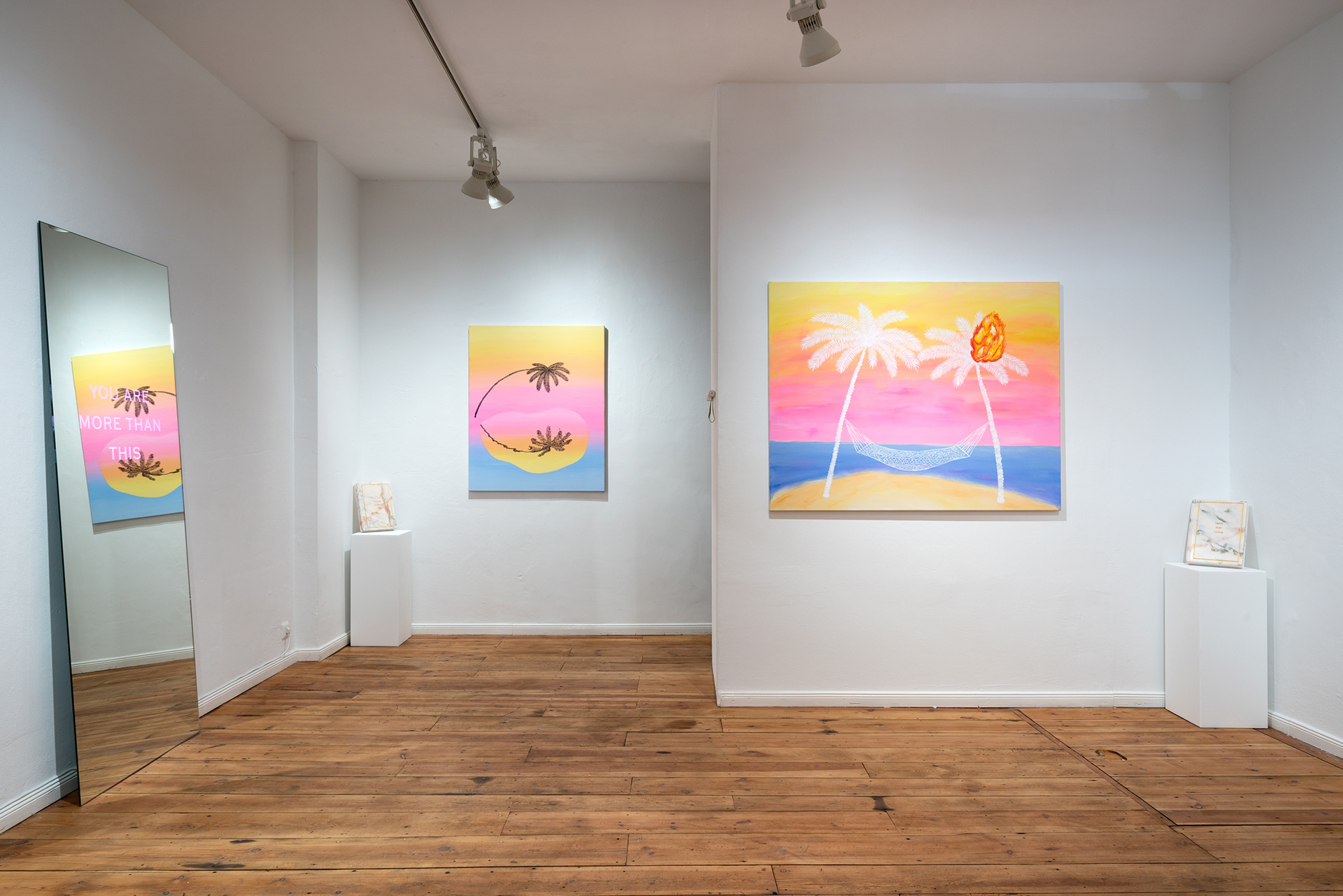
Andy Kassier has returned to Berlin. For four months, he avoided Germany’s long and cold winter. He set out on a spiritual journey into the light, stopping in Mexico and South Africa to meet with shamans in tents, sitting and breathing.
At a time when cryptocurrencies such as Bitcoin and Ethereum are emerging as new religions and entrepreneurs such as Elon Musk and Gary Vee are emerging as new leaders, conceptual artist Kassier sees spirituality as the path to physical and mental purity. He takes a deep breath into himself. He paints in order to become enlightened.
“read that twice”
This is also the title of Kassier’s solo exhibition at Weserhalle. With new books, mirrors and paintings, it offers space for reflection. “Meditation is the introspection that leads to acceptance,” says Kassier.
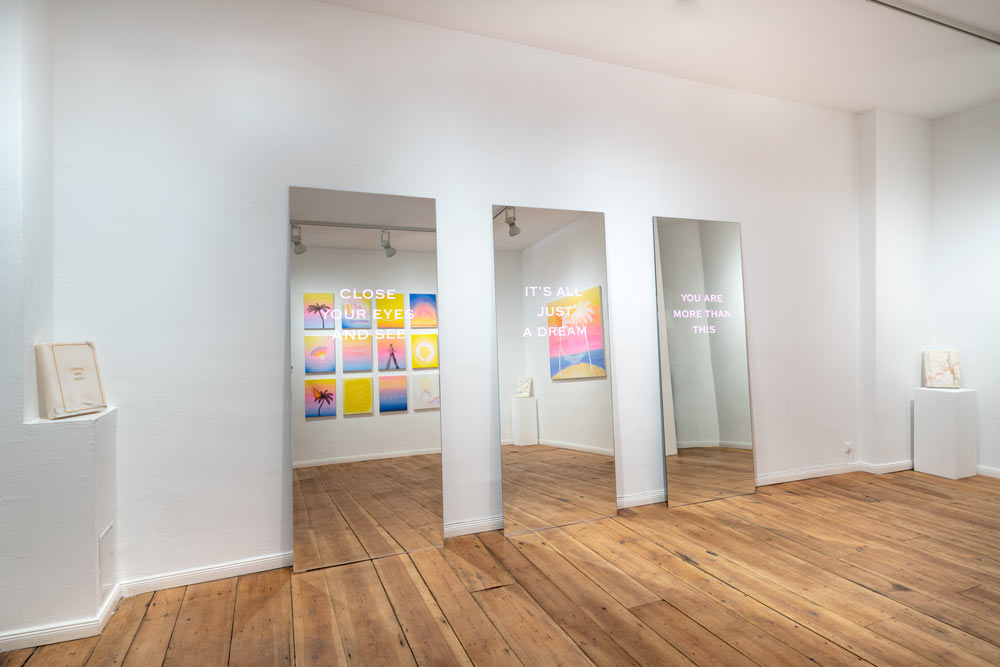
“close your eyes and see”
Find a place that exudes calm.
Close your eyes feel your body.
Watch your breath.
Notice when your attention wanders.
Bring your attention back to your breathing.
End the meditation with gratitude.
“this is it”
Life is a treasure hunt, with dreams to be realised and happiness to be discovered. Kassier recalls, “You are more than this.” The possibility of fulfillment and enlightenment is in the present the past and the future is a ballast that leads to dissatisfaction.
In 2013, artist Andy Kassier created his alter ego Andy Kassier, ironically breaking the narrative of wealth and happiness in late capitalist society. On Instagram and in international solo and group exhibitions, he continuously develops the long-term performance according to the current zeitgeist. How is photography changing in the digital age when images become the medium of communication and at the same time the medium of photography is expanded to include performances and live streams? Kassier sets up installations in exhibition rooms, performs and streams live to social media.
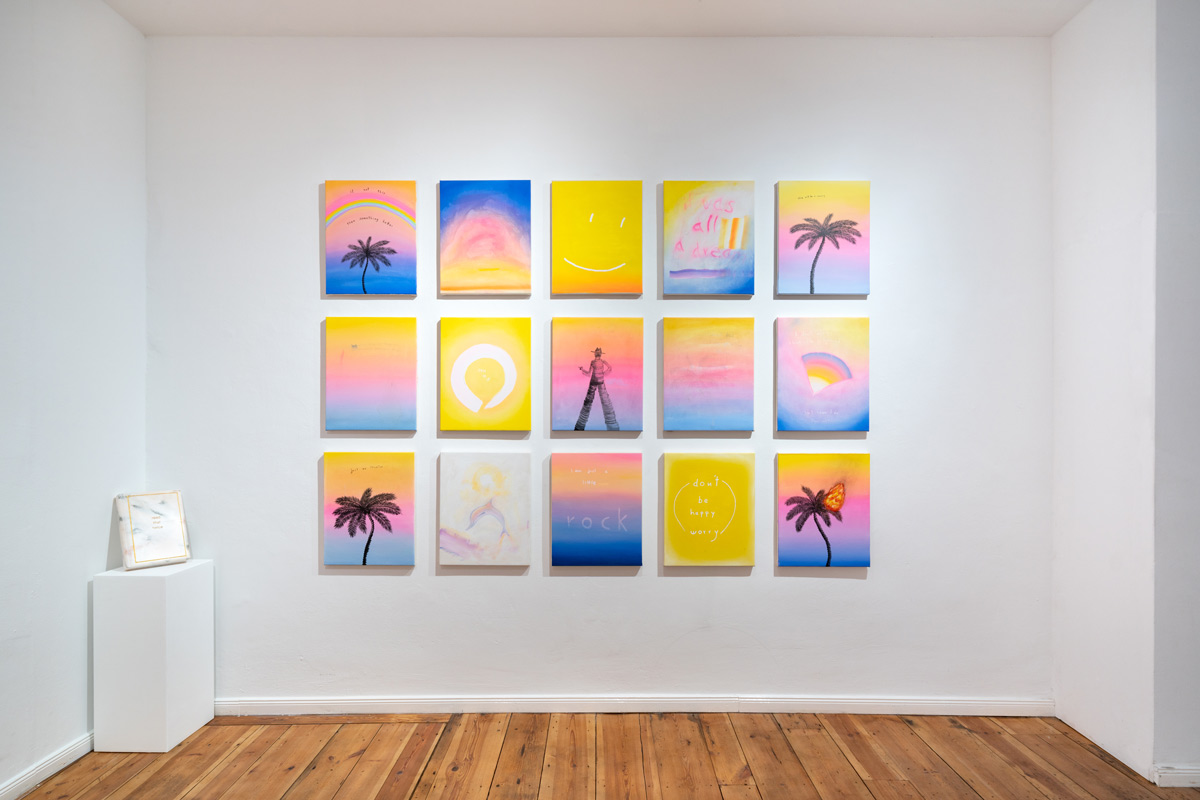
Kassier observes phenomena in social media and the development of digital image cultures. Based on his findings, he searches for answers to current socially relevant questions in his artistic work: What is happiness? (“the science of happiness”, Pop; 68, Cologne, 2016) How do I become successful? (“On the Internet, Nobody Knows You’re a Performance Artist. Andy Kassier and Signe Pierce”, NRW-Forum Düsseldorf, 2018) How is masculinity represented? (“How To Take A Selfie”, Goethe-Zentrum Baku, Azerbaijan, 2019) How do I accept myself? (“Link in bio. Art after social media”, Museum of Fine Arts Leipzig, 2019/2020) What is the role of the artist in the digital age? (“palm down”, HANZ.studio, Gallery Weekend Berlin, 2020).
Kassier (*1989) lives and works in Berlin. His work includes installations, performances, photography, videos, sculptures and paintings. In 2018 he completed his studies in media arts with distinction at the Academy of Media Arts Cologne, where he studied with Mischa Kuball and Johannes Wohnseifer, among others.
Text: Anika Meier
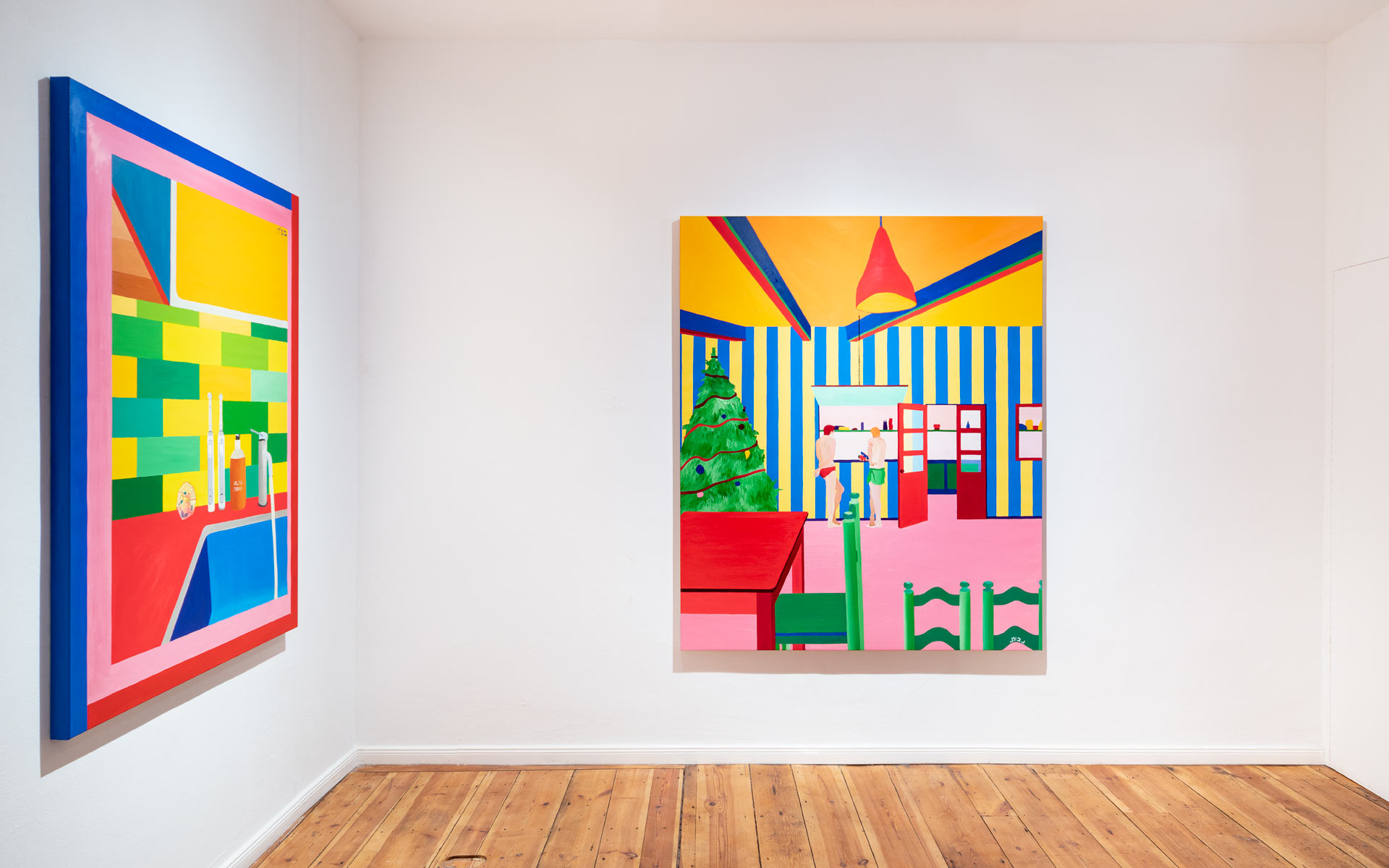
For his first solo show at WESERHALLE, Berlin based artist Navot Miller presents Colourful, homo, great., a series inspired by the artist’s recent travels interwoven with the artist’s multilayered identity.
Entering the exhibition the spectator is greeted by the large-scale, vibrant coloured canvases. The first impression is of electric compositions fueled by the flamboyant use of colours and the intensity of the exploration of flatness through the means of collage. After letting the first rush of these components settle, the work allows you to slow down. Details then slowly unfold; stories appear behind the carefully composed re-examination of everyday moments.
Growing up, Miller experienced the many facets of life between the rural vastness of his hometown Shadmot Mehola in the north of Israel and the bustling metropolis—such as New York and Paris—where he travelled regularly to visit relatives. In his visual language his traditional religious upbringing as an orthodox jew and his contemporary life do not oppose each other but are brought to a sensible equilibrium.
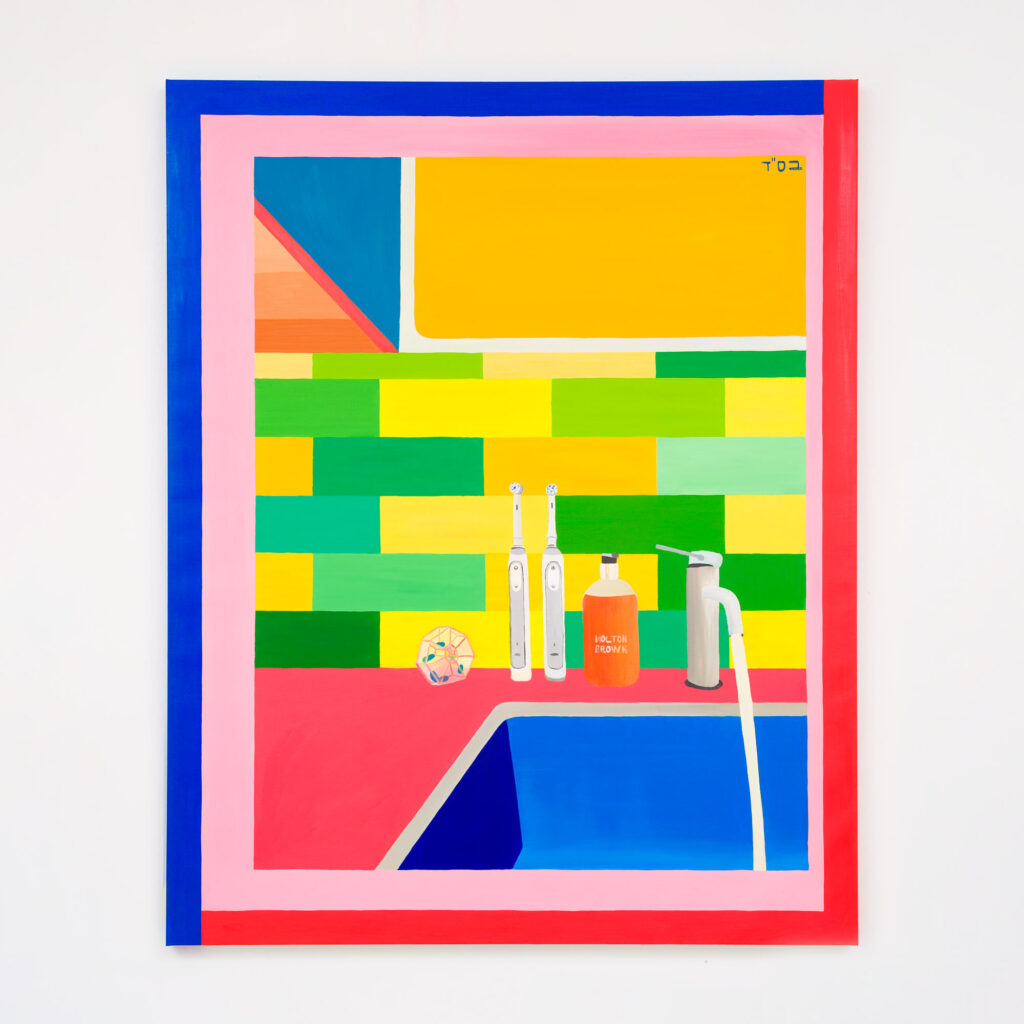
The still life titled PrEP shows a sink with two toothbrushes, soap and a pillbox. The objects of a possible morning routine lead you to think of “Preparation”. Only after paying special attention to the unique spelling of the title is the spectator led to a further meaning. PrEP—pictured in the pillbox of the painting—is a medication for homosexual men to prevent a potential contraction of HIV, which the artist also takes everyday. On the top right of this scene the Hebrew acronym בס”ד (basad) which translates to the phrase “with the help of god” is written. The artist explains: “Growing up as an observant jew, I had to practise the ritual of writing these 3 Hebrew letters on top of every page I started writing on. This work reflects on both my past and my present.” The use of the acronym becomes a powerful sarcastic signifier that shines a light on the complexity of an identity.
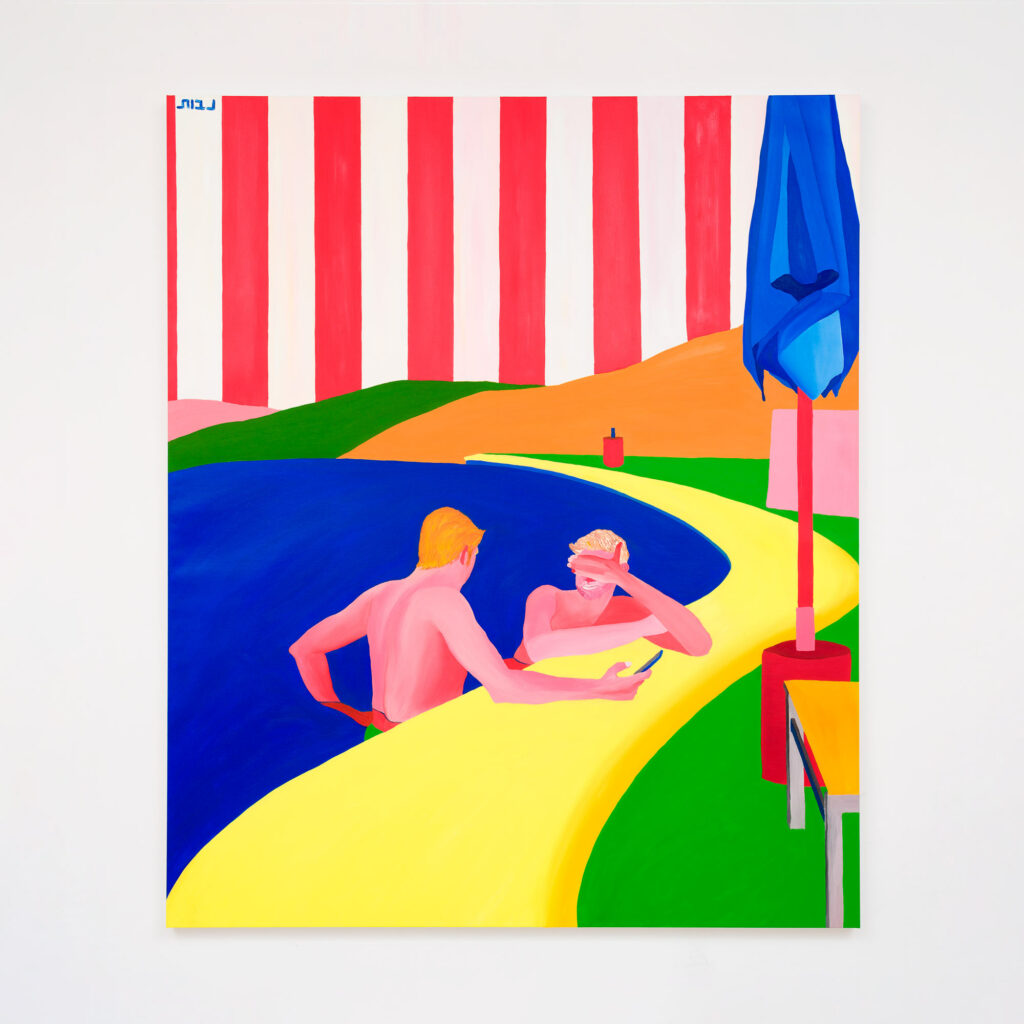
His work process starts with his own experiences documented as photographs or videos. Friends, acquaintances, lovers and everyday situations find their way onto his blank canvas, layered into a carefully composed collage of memories. For instance, the work Angelo & Sergio in Casa Biulú, focuses on two figures in a vibrant blue pool—strangers he got to know during his holidays in Mexico—while the background is drawn from a detail of another photograph from the same trip – the red and white stripes of a popcorn bag. Miller balances the components of space and colour to emit a sense of melancholy and voyeurism that charges the vibrant pieces with an unexpected intimacy. Miller describes how during his trip he was taking medications to treat a fungal infection on his face. Because of this, instead of taking part in social situations as he usually would, he played the role of an observer, watching and documenting interactions unfold. He explains further: “This vacation in Mexico was in many ways like the so-called “window shopping” where we see things we desire however, for a reason, cannot have for the moment.”
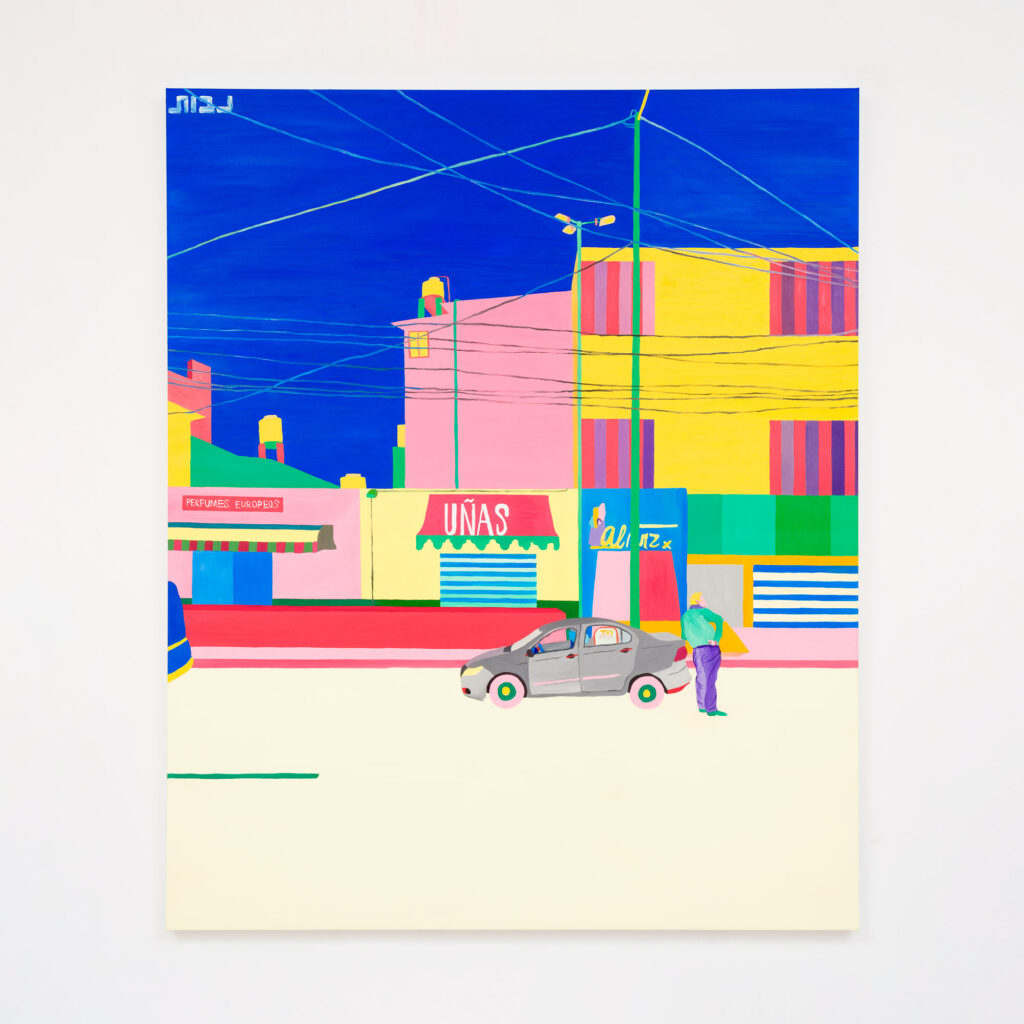
With a strong interest in architecture, Miller has a naturally heightened consideration towards the arrangement of the individual elements and manages to bring the powerful characteristics of his dream-like scenarios and his own identity into balance that allow for delicate relations to unfold, which are often colourful, homo and pretty great.
Navot Miller is a Berlin based artist from Israel. He studies at the Kunsthochschule Weißensee in Berlin. His works have been exhibited in several solo and group exhibitions. Most recently in Elektrohalle Rhomberg in Salzburg, Austria 2020 and at MISA in Berlin, Germany 2021.
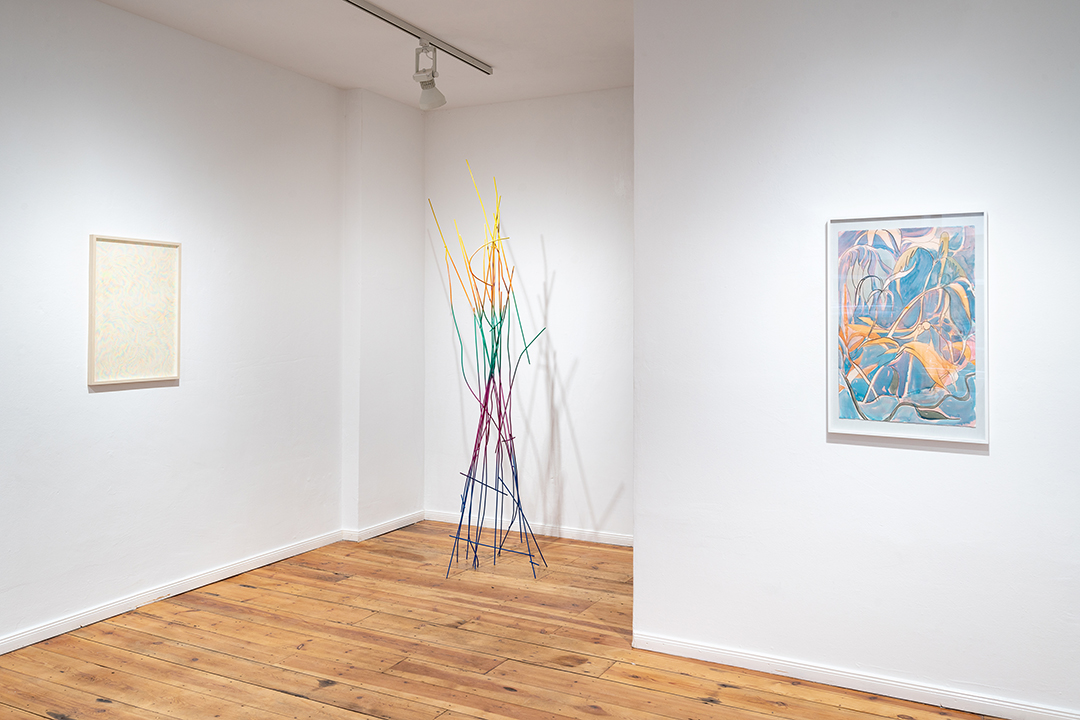
Weserhalle is happy to announce the ninth edition of the Art Auction curated by Norbert Bisky and Anna Meinecke (gallerytalk.net). The works will be available to view at the Weserhalle gallery via bookings, with the auction taking place entirely online opening 20:00 on Friday December 3, ending at 20:00 on Sunday December 12.
Out of over 500 submissions guest curators Norbert Bisky and Anna Meinecke picked 50 German based artists for the online auction with opening bids ranging from 5€ to 4.500€.
Due to the current circumstances and to disperse the number of people gathered in one area, the exhibition will be split into 5 groups, with each group having its own opening. Please check the dates to ensure the artists you’d like to see will be exhibiting. When visiting, please follow the latest covid guidelines.
Opening 01: Friday December 3, 19—21:00.
Albrecht/Wilke
Badr Ali
Benjamin Tiberius Adler
Johannes Mundinger
Katharina Arndt
Lena Schramm
Melissa Steckbauer
Monika Radzewicz
Susanne Schmitt
Opening 02: Sunday December 5, 14—18:00.
Arne Schreiber
Birte Bosse
Ella Becker
Filip Henin
Johannes Jakobi
Nam Duc Nguyen
Nicholas Warburg
Vikenti Komitski
Opening 03: Tuesday December 7, 19—21:00.
Bilge Emir
Emily Morey
Fabian Warnsing
Gabriel Ribeiro
Georg Vierbuchen & Leah Barna
Joachim Lenz
Niclas Moos, Moritz Morsbach
Simon Blume
valentin wagner
Witalij Frese
Opening 04: Thursday December 9, 19—21:00.
Aglaia Gronas
Billie Clarken
Björn – David Heyn
Fern Liberty Kallenbach Campbell
maansi jain
Sarah Loose
Shanee Roe
Sophia Süßmilch
Tabitha Swanson
Vincenzo Suscetta
Opening 05: Saturday December 11, 19—21:00.
Alex Neuschäfer
Christian Kölbl
Constantin Hartenstein
Eliza Mozer
Giovanni Quaglia
Grischa Kaczmarek
Karla Zipfel
Matti Schulz
Nils Köpfer
Sophia Domagala
Norbert Bisky (*1970 in Leipzig) lives and works in Berlin and Andalusia. He studied at the Berlin University of the Arts and at the Universidad Complutense in Madrid. From 2008 to 2010 he was a visiting professor at the Geneva Academy of Art HEAD, and from 2016 to 2018 at the Braunschweig University of Fine Arts. In 2015 he exchanged his studio in Berlin with the artist Erez Israeli and worked in Tel Avi
Anna Meinecke (*1992 in Frankfurt am Main) studied cultural studies, theology and archaeology in Berlin and media studies in Amsterdam. She works as a freelance journalist and digital strategist and is editor in chief of the online magazine gallerytalk.net.
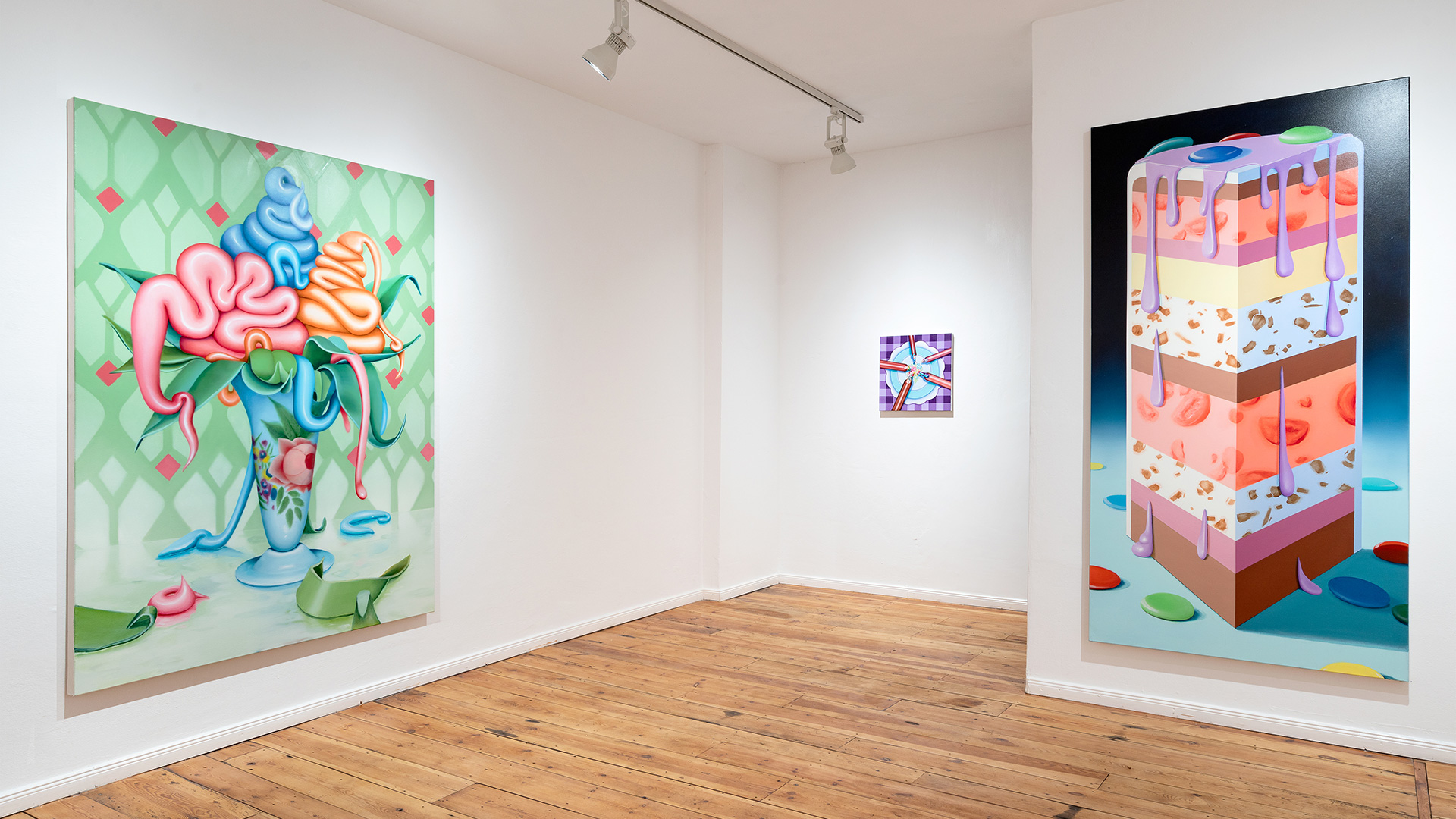
Welcome to the uncanny image world of Mona Broschár. Inhabited by sausages, bows, cupcakes, ice cream, floral dishes, and fake finger claw nails; the motto is, “Don’t take life so seriously—Let’s play!” Fun times abound here, and fetishes are lived out, while the boundaries of “good taste” are pushed to its limits.
Instead, her world is populated by playful tensions, oscillating between the beautiful and the grotesque—sometimes pure and innocent, at others unashamedly lascivious. Here, deliciousness can quickly turn repugnant and sweetness leaves a pleasurably bitter aftertaste.
Mona Broschár paints objects and food devotedly. A sausage appears adorned with a bowtie. A larger-than-life slice of cake is decadently coated in icing. Can we still call this food? Or are these objects creatures instead? Broschár portrays these objects as if they were autonomous beings. The question of who tied the bow or baked the cake—and for whom—remains unanswered. In this uncanny world, the bowtie-clad sausage and the imposing cake slice—named “Endgegner“ or boss in English—are personified. It’s as if they dressed up themselves for the occasion.
When confronted with this pictorial world, something that the author Clemens Setz calls ‘brain tingling’ sets in. One might get goosebumps, feel a pleasant tension that travels through the body, heightened awareness, and pleasure; these “brain tingles” are typical ASMR effects (Autonomous Sensory Meridian Response), reactions to certain acoustic, visual, or tactile sensory stimuli. Broschár’s smooth hyperrealist paintings elicit such reflexes. One feels the urge to take hold of these succulent objects—an ice cream, an adorned sausage, or a moist slice of cake—in order to ingest them or merely possess them. In her painting “Food Porn”, the adorned sausage invites one to appropriately misappropriate it—living up to its name. In “Endgegner” in turn, the desire to lick or scrape off the icing might arise. There is a sense of movement to these objects; one can almost see them wobble and bounce around. Not only that, one can hear them, too, gurgling and squeaking and bouncing about; a synaesthetic feast!
‘Bounce’ implies a push and pull movement; attraction and repulsion. This can also be said of Mona Broschár’s works. Although undeniably magnetic and possessing an immersive quality, the paintings ultimately let the viewer bounce off them. The sense of intimacy which emerges during the first encounter with these works dissipates. They turn out to be inaccessible, for one may imagine everything but touch nothing. In this way, she brings to life everyday digital experiences which are similarly fun and entertaining yet also punctured by frustration.
Text: Annekathrin Kohout
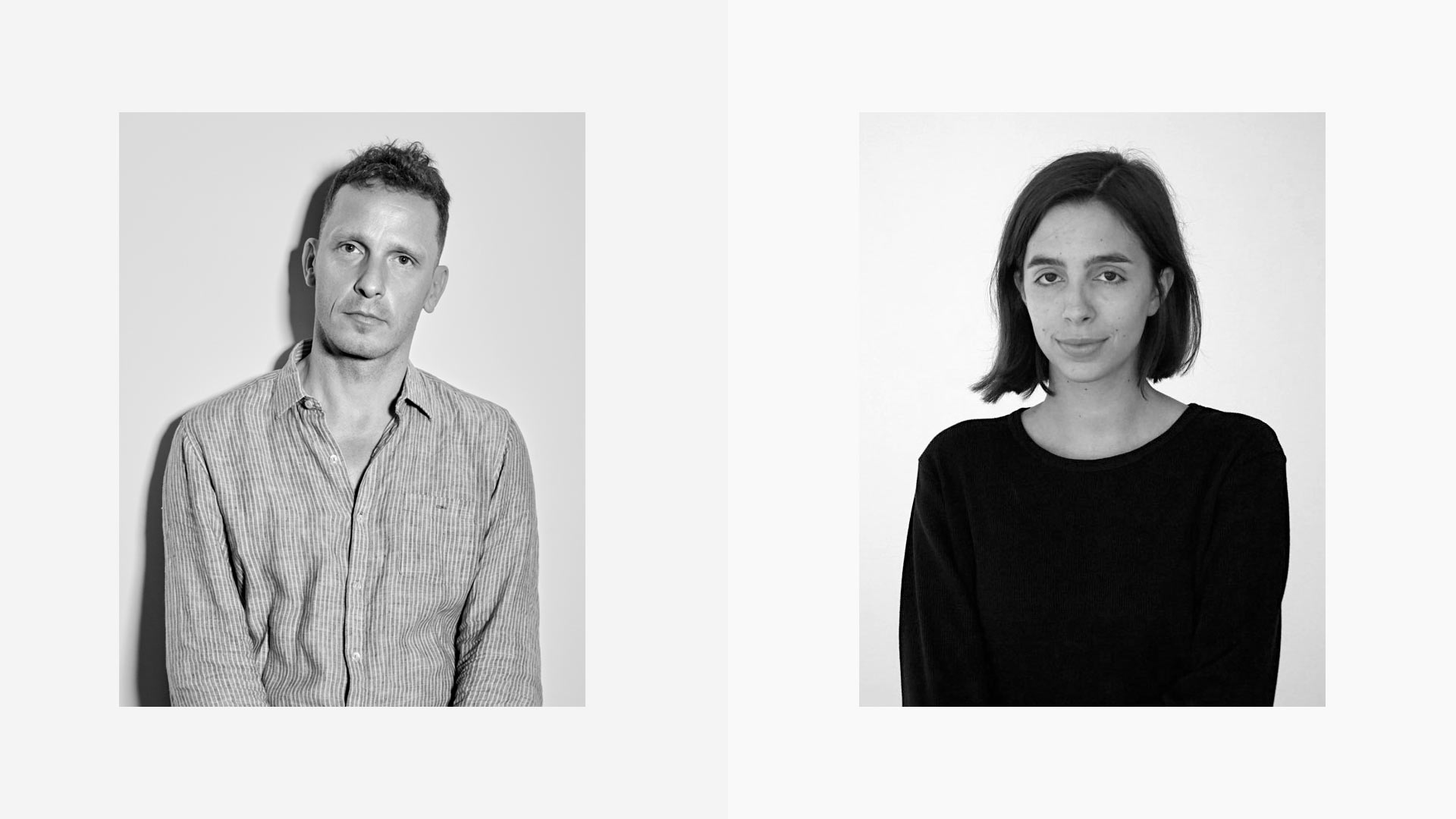
Weserhalle is happy to announce the open call for our ninth edition of the Art Auction. Works can now be submitted via our website until the 1st of November. As in the previous auctions all submitted works will be reviewed, with the final selection made by our team of guest curators; Norbert Bisky and Anna Meinecke.
Guest Curators
Norbert Bisky (*1970 in Leipzig) lives and works in Berlin and Andalusia and is one of the most successful representatives of contemporary figurative painting. He studied at the Berlin University of the Arts and at the Universidad Complutense in Madrid. He has lectured at the Geneva Academy of Art HEAD and the Braunschweig University of Fine Arts.
Anna Meinecke (*1992 in Frankfurt am Main) studied cultural studies, theology and archaeology in Berlin and media studies in Amsterdam. She works as a freelance journalist and digital strategist and is editor in chief of the online magazine gallerytalk.net.
How does it work?
To enter your work, use the entry form on this page. If selected, the works will be exhibited at Weserhalle throughout the duration of the auction. Furthermore they will be made accessible via the online auction at weserhalle.com where the bidding takes place. Please read through our [su_lightbox type=”iframe” src=”https://weserhalle.com/auction-terms-conditions-of-entry/” mobile=”yes” class=””]terms and conditions[/su_lightbox] before entering.
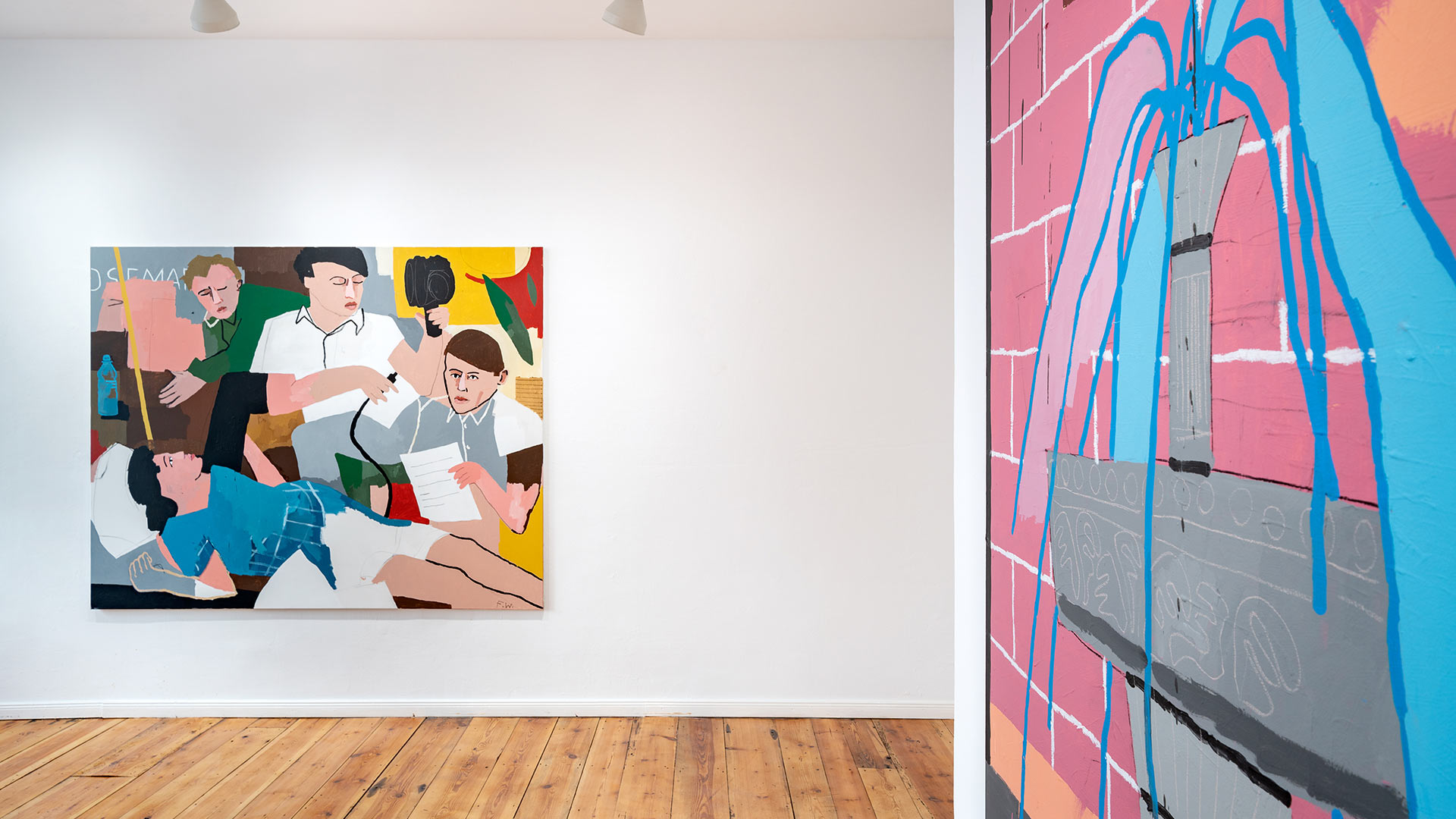
Igor stands somewhat perplexed with his back leaning against the wall. He watches the fountain gushing out the water which runs over the edge of the pool, ruining his shoes. A cigarette butt floats in the murky scenery. The water colours the gravel at his feet dark grey.
The tulips are too excitable, it is winter here.
Look how white everything is, how quiet, how snowed-in.
I am learning peacefulness, lying by myself quietly
As the light lies on these white walls, this bed, these hands.
I am nobody; I have nothing to do with explosions.
I have given my name and my day-clothes up to the nurses
And my history to the anaesthetist and my body to surgeons.
—Sylvia Plath, 1961
In the stairwell, someone has sorted out part of his bookcase. Between “Nude – The Act” and “Buying a car for dummies” leans a book with the title “Tulips”. Igor’s hands are sweaty as he hangs his coat on the rack in the hallway. On the coffee table, the TV guide propagates the Saturday night feature film:
Rosemary Woodhouse and her husband Guy move into a New York apartment building with an ominous reputation and strange neighbours. The pregnant Rosemary becomes increasingly isolated and comes to believe that her offspring cannot be of this world. But the diabolical truth is only revealed after the birth.
Tulips and naked women, Igor thinks, that just fits. Like sausages and buns. A beautiful idea. He bites his lip. The bathroom mirror is all fogged up from the scalding hot water running onto his shoulders. [The gurgling of the shower stops. In the distance, someone opens a beer.]
In his solo exhibition “Two lips and tulips” Fabian Warnsing shows excerpts from every-day scenes, sometimes elaborate and rich in detail, sometimes implied and sketchily assembled. His painterly and graphic snapshots are inspired by films, books or photos and combine different styles.
Fabian Warnsing’s works comes together as if by chance to form associative narratives. The play with foreground and background, layers and over-paintings visualises the inter-locking of themes. “Two lips and tulips” puts compositional phenomena to the test and is as varied as rhythmic zapping through the artist’s brainwaves.
Text: Julia Meyer-Brehm.
Photos: dotgain.info.
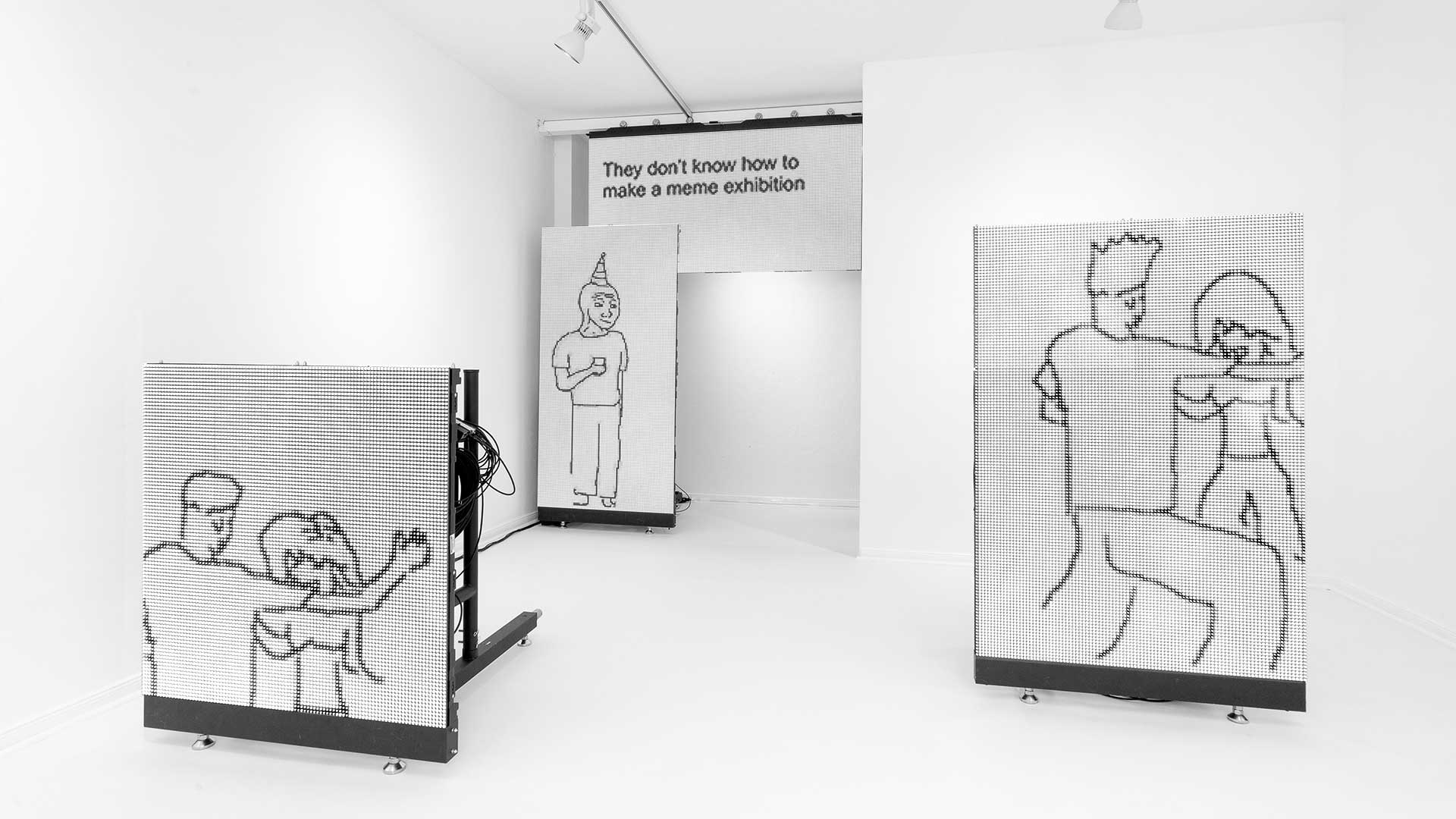
WESERHALLE is pleased to present The Party, a solo exhibition by Cem A., the person behind the Instagram art meme page @freeze_magazine. His memes explore topics such as survival and alienation in the art world, often through a hyper-reflexive and self-deprecating lens. This practice naturally extends into the exhibition The Party. Wojak, the ever-morphing face of digital folklore, takes centre stage in the installation. He lingers in the corner of the gallery, despondent that they, the party-goers, don’t know “what it takes to be an artist”.
The composition of The Party follows a popular internet meme known as They Don’t Know, depicting a party where the narrator, Wojak, soothes his social anxiety by thinking about how the strangers around him don’t know how cool he secretly is. Wojak, sometimes referred to as “That Feel” Guy, is a familiar face for those who are acquainted with meme culture. He frequently appears on the internet as a relatable character depicting feelings of boredom, melancholy, regret or loneliness, and his origins are as murky as the roots of internet meme culture itself.
In this exhibition, Cem A. utilises Wojak as a mediator between himself and the audience, making sense of his own gradual disillusionment with the art world and his subsequent, and admittedly ironic, success as a meme maker. The concept of a meme exhibition would fit in perfectly as a meme itself on @freeze_magazine, especially among his memes which take on issues surrounding the white cube, elitism, Western-centrism, cultural capital and clout. The Party is not only concerned with the practicalities of presenting memes offline, but also explores the politics of doing so. The display seeks to preserve the digital essence of internet memes while offering an alternative physical experience to the audience.
Cem A. is an artist and curator known for running the art meme page @freeze_magazine. Since its inception in 2019, the page has become a tool for creative collaborations between Cem and fellow artists, researchers and collectives. It has been featured in The New York Times, The Art Newspaper and Monopol Magazin.
Text by İdil Galip. İdil is a doctoral researcher in sociology at the University of Edinburgh, studying the relationship between memes, digital culture and labour. She is the founder of the Meme Studies Research Network.
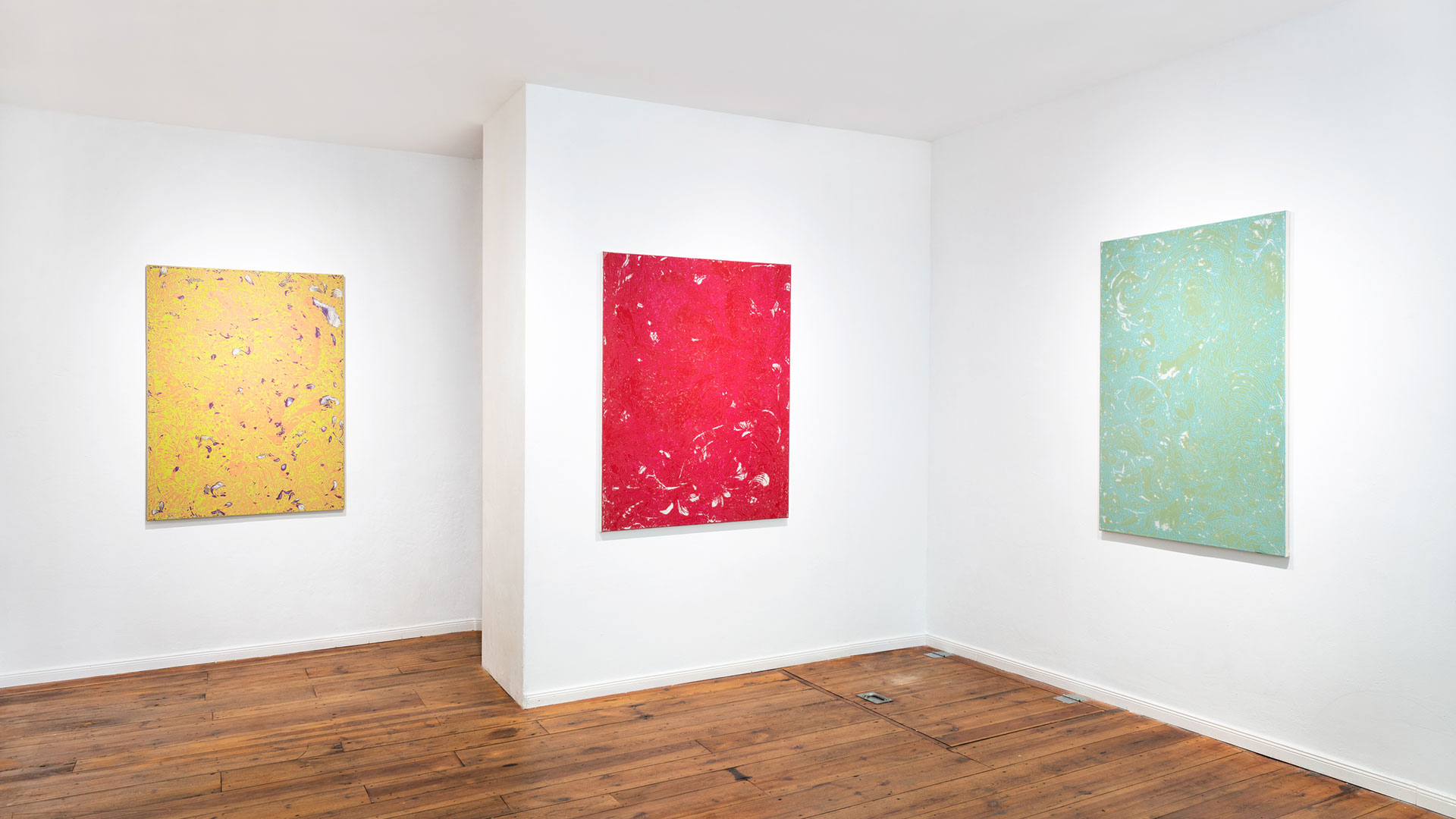
Weserhalle is pleased to present One In The Bush, a solo exhibition by the Berlin based artist Sascha Brylla.
While Brylla’s work may appear abstract at a distance, a closer look reveals an entirely new –– and at the same time very familiar –– story. Each of the works show a male dog trapped in what appears to be an untameable ocean of plants, conquered by nature. An image reminiscent of fairy tales such as Sleeping Beauty where knight upon knight falls victim to the impenetrable bush surrounding the sleeping princess, but more so falling victim to their own hubris. In Brylla’s work, the dog is at times passive, paws in the air in defeat. Other times, he strains against the greenery, eyes bulging, sharp teeth bared. The strength of these dogs is emphasised through the characteristic style which brings to mind Japanese woodblock prints, depicting dragons and spirits; which at times make them appear even threatening, mythical and otherworldly.. Yet their masculinity is overpowered by nature itself, a symbol often associated with femininity and which functions as a fundamental aspect of Brylla’s work.
The works featured in this installation are part of Brylla’s most recent series, which sets a focus on challenging the idea of idealised masculinity. Up close the spectator witnesses how strong male figures are being tamed at the hand of flowers and leaves. From afar the deadly struggle morphs into an overall composition – evocative of William Morris’s 1860s wallpapers compositions – which impresses with its intricacy and vibrant colours and exudes an almost meditative calmness. These two visual levels intertwine and charge each other, and in combination with the exhibition’s title, invite a larger discourse on how stereotypically masculine attributes, such as machismo, often seen as the starting point of violence and self-destruction, also have implications for sexuality and consent.
In order to create his works, Brylla employs a technique typically associated with plaster wall façades or ceramics known as sgraffito. In this process, a knife is used to carve lines into paint, creating a spidery web of uncovered layers. Because of this unusual process, Brylla refers to his technique as “on the edge of painting”; more a sculptural “process of removal” than traditional painting, which layers paint to bring an image from abstraction into clarity. Brylla’s technique requires both play and precision: the “scratching” required to bring each piece to life can be unforgiving. As Brylla says; “Sometimes it’s gone, and there’s nothing I can do.”
Sascha Brylla (*1987, Crailsheim) is a German artist living in Berlin. He received degrees in painting at the Berlin-Weißensee School of Art and the Royal Danish Academy of Fine Arts, Copenhagen. In addition to this show at Weserhalle, Brylla’s work has been exhibited around Europe, most recently at the Plus-One Gallery and Gallery Sofie Van De Velde in Antwerp, Ruttkowski;68 in Paris, and the NBB Gallery in Berlin.
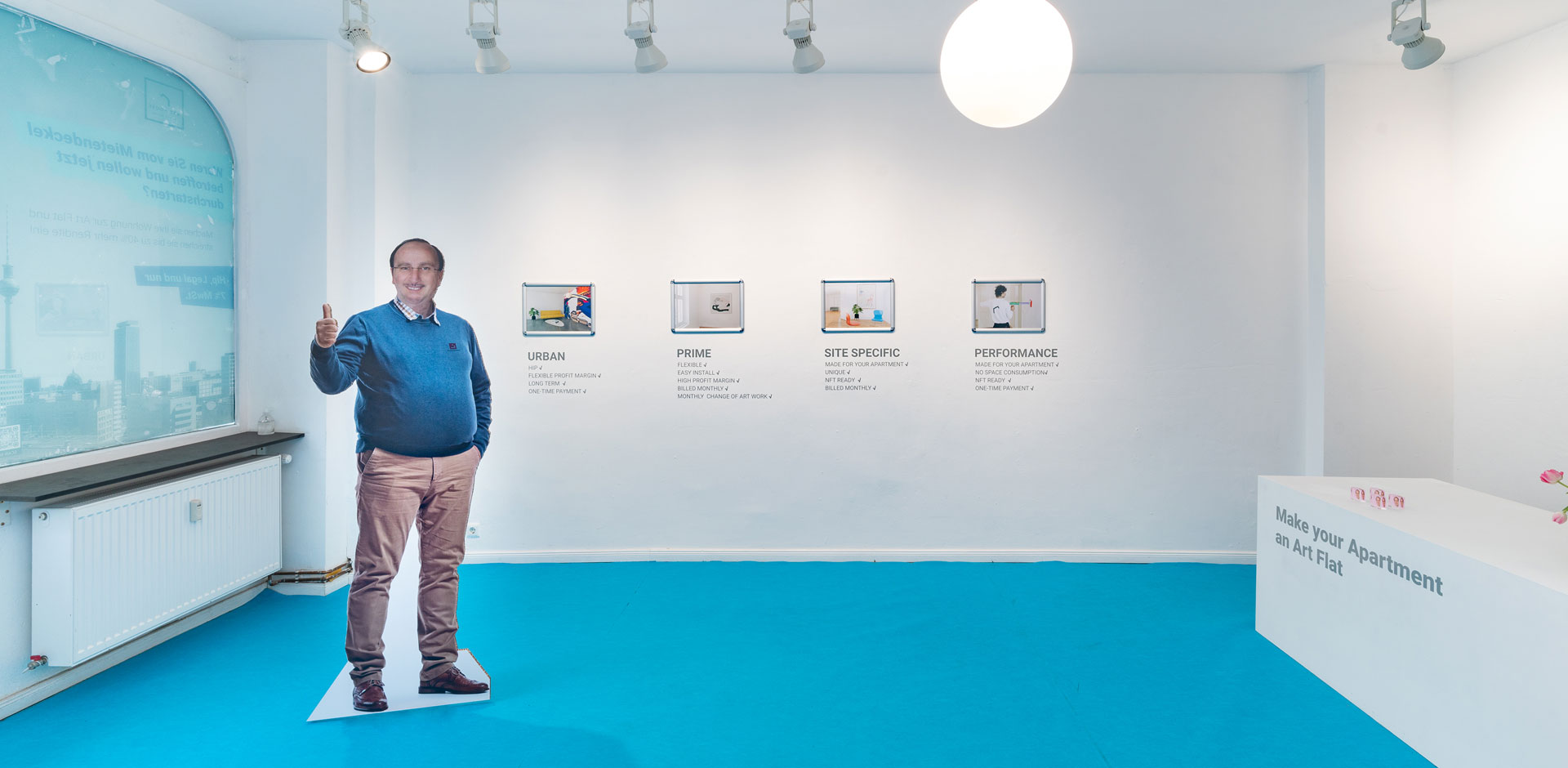
“Make your Apartment into an Art Flat“, is the latest offering from Weserhalle’s current exhibition; Da Silva Brokers Art House (DSBAH), a multimedia art installation by Anton Steenbock. DSBAH offers landlords the opportunity to circumvent the Mietpreisbremse (rent brake) by furnishing their flats with Berlin’s capital asset, contemporary art, and earning up to 40% more return above the legal requirements with only 7% VAT.
To this end, Weserhalle has been transformed into a commercial salesroom, which—with its furnishings, uniformed staff and corporate identity— is strongly reminiscent of the showrooms of large real estate projects sprouting up in Berlin. The showroom is updated weekly throughout the exhibition highlighting a new artist working within the DSBAH network, providing an example of how your apartment can look if it was to be turned into an Art Flat.
Parallel to the exhibition, an extensive advertising campaign has been launched in the digital and public space, all of which is tied together neatly by a specially designed DSBAH website housing promotional videos, Art House plan details and the ability to book showroom visits.
DSBAH offers a critical look at the current housing situation in Berlin and the dramatically intensifying conflict between real estate companies and residents.
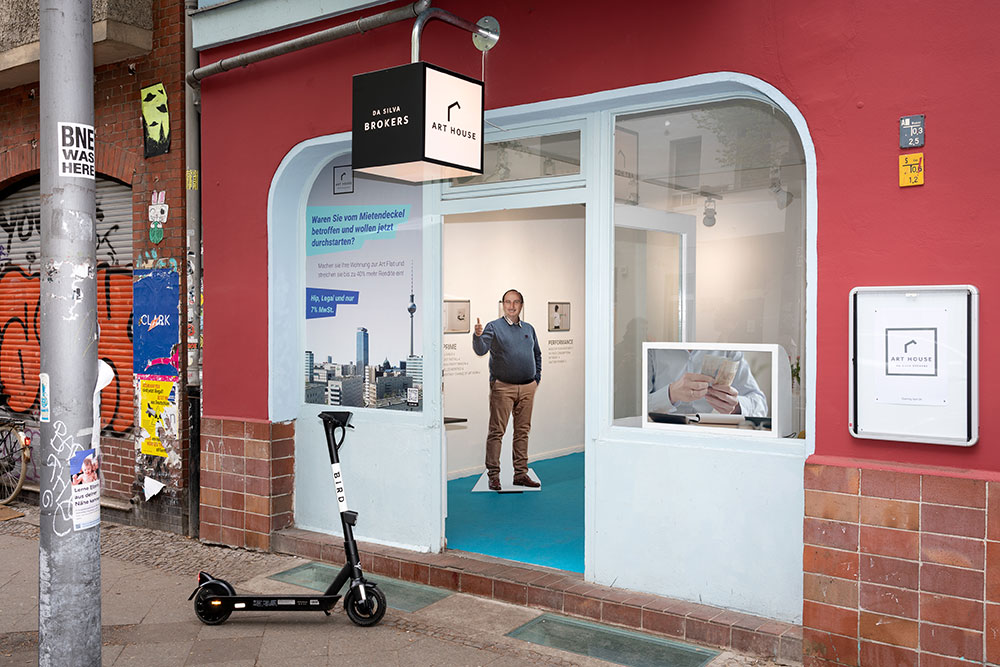
Project background
DSBAH is the continuation/part of a long-term project by Anton Steenbock, launched in 2010 under the name Da Silva Brokers, consisting of fake architecture campaigns, showrooms and widely distributed propaganda aimed at creating political awareness of urban and environmental change in hotspots such as the 2014 World Cup and the 2016 Olympics in Brazil, as well as corporate takeovers in public space such as Google Street View and sharing economy apps such as Uber, Coop and AirBnB.
In addition to his individual work, Anton Steenbock has a strong focus on collective approaches. He is co-founder of Gazua, an artist-run exhibition platform in Rio de Janeiro, was tutor of the Freie Klasse Berlin from 2006 – 2010 and together with Peter Behrbohm forms the artist collective SONDER.
Recent Exhibitions; Martin Gropius Bau Berlin (2020), Forecast Forum Berlin (2019/2020), Künstlerhaus Frise in Hamburg – Germany (2019).
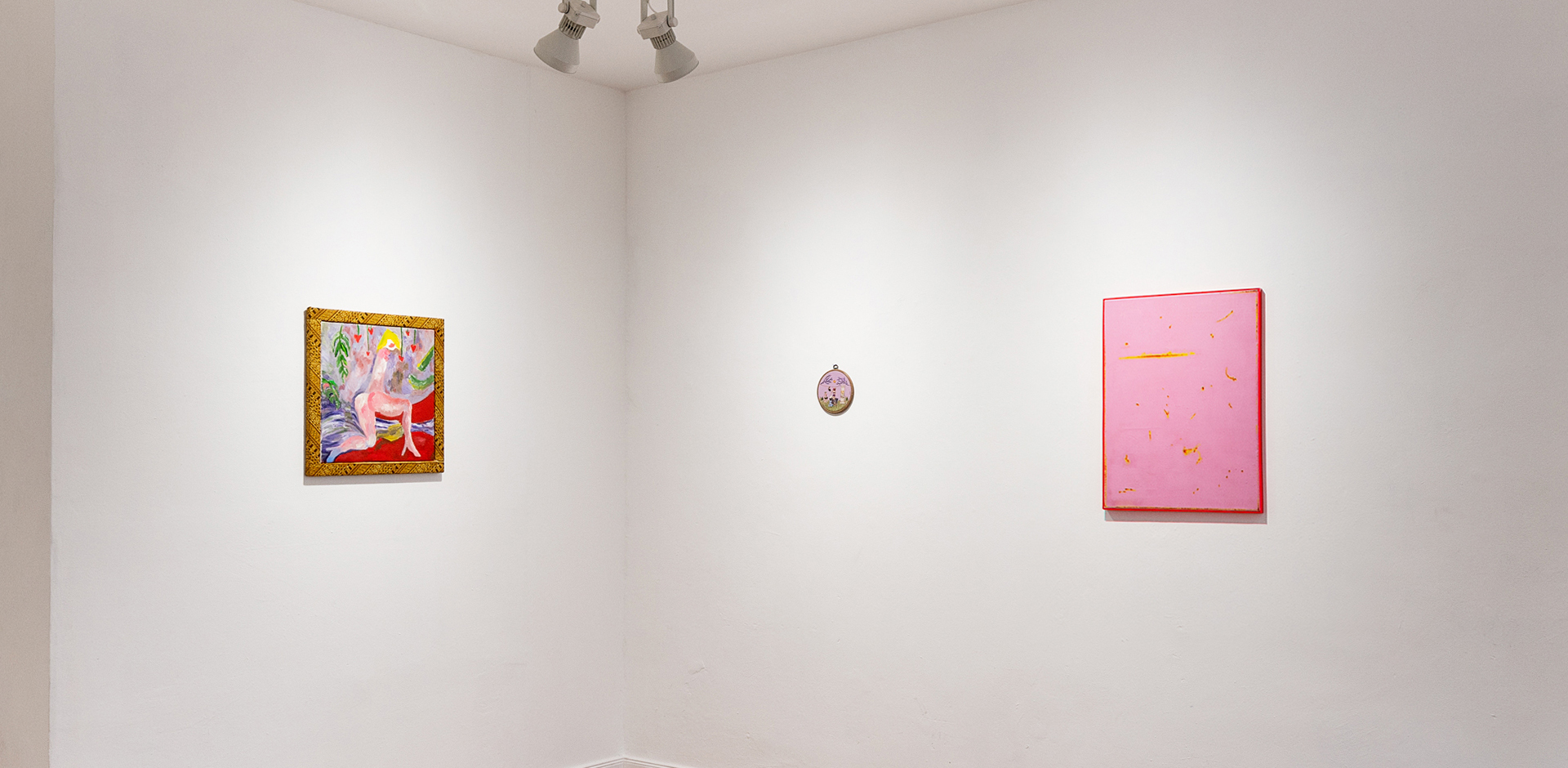
In collaboration with our fine friends at ArtConnect, we are happy to announce our Spring Auction, opening on April 15. This event is comprised of 2 parts; the physical—a curated exhibition at the Weserhalle gallery; and the digital—an online presentation where the work will be available through our auction.
Our open call generated 784 entries including submissions from 71 nationalities, with artist ranging from 19 to 71 years old. To aid in the selection process, Weserhalle put together a panel of guest curators; Cibelle Cavalli Bastos (they/them), an artist, musician and independent researcher; Nina Barret Memy (her/she), a multi-disciplinary artist and an art mediator at the Boros Foundation; and Simon Mann (he/him), a conceptual artist who has curated at Weserhalle.
Artists
Abie Franklin
Alyona Baranoff
Andrea Mikyska
Ayla Tavares
Daisy Watson
Dana kirijak
Hemel & Freytag
Edvile Luksyte
Elizabeth Charnock
Fette Sans
hola i chau
Iryna Maksymova
Jacopo Dal Bello
Jan Ziegler
Jan-Hendrik Brinkmann
Joakim Derlow
Joanna Chwiłkowska
Jonas Lewek
Josefine Schulz
Katharina Arndt
Laura Song Wu
Laura Suryani Thedja
Linda Skellington
Lucas Lelieveld
Nadine Talalla
Niklas Jeroch
Santiago Mac Auliffe
Serap Sahin
Tamir David
Tasha Levytska
Thiago Goms
Valdrin Thaqi
Verena Issel
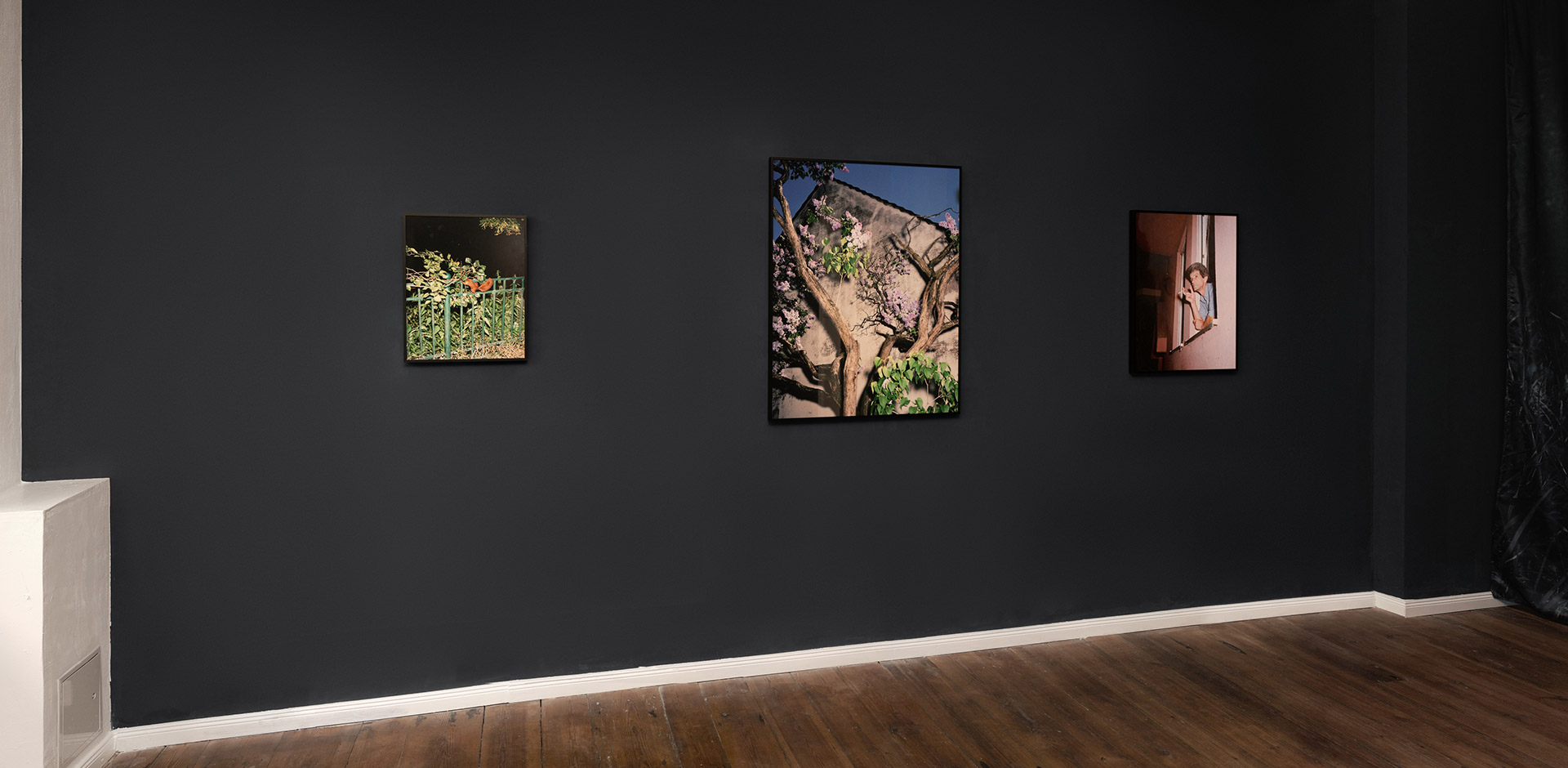
“The flâneur wanders restlessly through the city like an untamed beast. He succumbs to the crowd like a wreck to the waves, letting himself be overcome by the liberating breath of anarchy.”
– Federico Castigliano, Flâneur: The Art of Wandering The Streets of Paris
As an ode to our beloved Neuköllner Weserkiez, we are excited to present you Humpelfuchs, a collection of new photographs by local artist Bastian Thiery. Like early 20th century analog photographers such as Arthur Fellig (better known as Weegee), Thiery prefers to take his snapshots with a bright flash, capturing whooshing glimpses of the neighbourhood at night: its detritus and denizens; its pets and scavengers; its trees, limbs washed out and gangly, engulfed in an open mouth of black.
The project of Humpelfuchs was instigated when Thiery set out to find a limping fox he had seen in Weserkiez, and the result is everything else he spotted along the way. Moving through his images gives the sensation of following behind him at a close distance on his evening prowl, not unlike the quiet footsteps of the titular fox, who crouches closer to the camera than almost any other of Thiery’s subjects. The world he presents us is dramatic: fragments of observation, illuminated occasionally and –– based on the candid poses of his subjects –– without warning; a quick crackling light that fades, as abruptly, into darkness. This gives Thiery’s mission –– to track down the fox, and “capture” it, even photographically –– a sort of “crime scene” feeling; pulpy snapshots of the mundane, rendered meaningful.
Complicating this are moments of understated softness, peppered between rumpled masks and glaring cat eyes: a car, resplendent in shiny bows and plastic pink flowers; a young girl blowing bubbles on her balcony. Humpelfuchs (Limping Fox) continues our mission at Weserhalle to highlight local artists, now bringing our project quite literally close to home: guests to our exhibition may notice some familiar faces. At night, we will exhibit this collection via projections on our gallery windows, offering one neighborhood artist’s portrait of these very same streets as an ephemeral mirror, of sorts, to our community.
Bastian Thiery is a German photographer living in Berlin. He was trained first at the International Center of Photography (ICP) in New York (2014), followed by Ostkreuzschule für Fotografie in Berlin (2018). His book, Humpelfuchs, was shortlisted for the Fotobookfestival Kassel Dummy Award and La Fabrica & London Dummy Award in 2019, during which time he also was among the winners of the Vonovia Award für Fotografie.—Text by Eliza Levinson
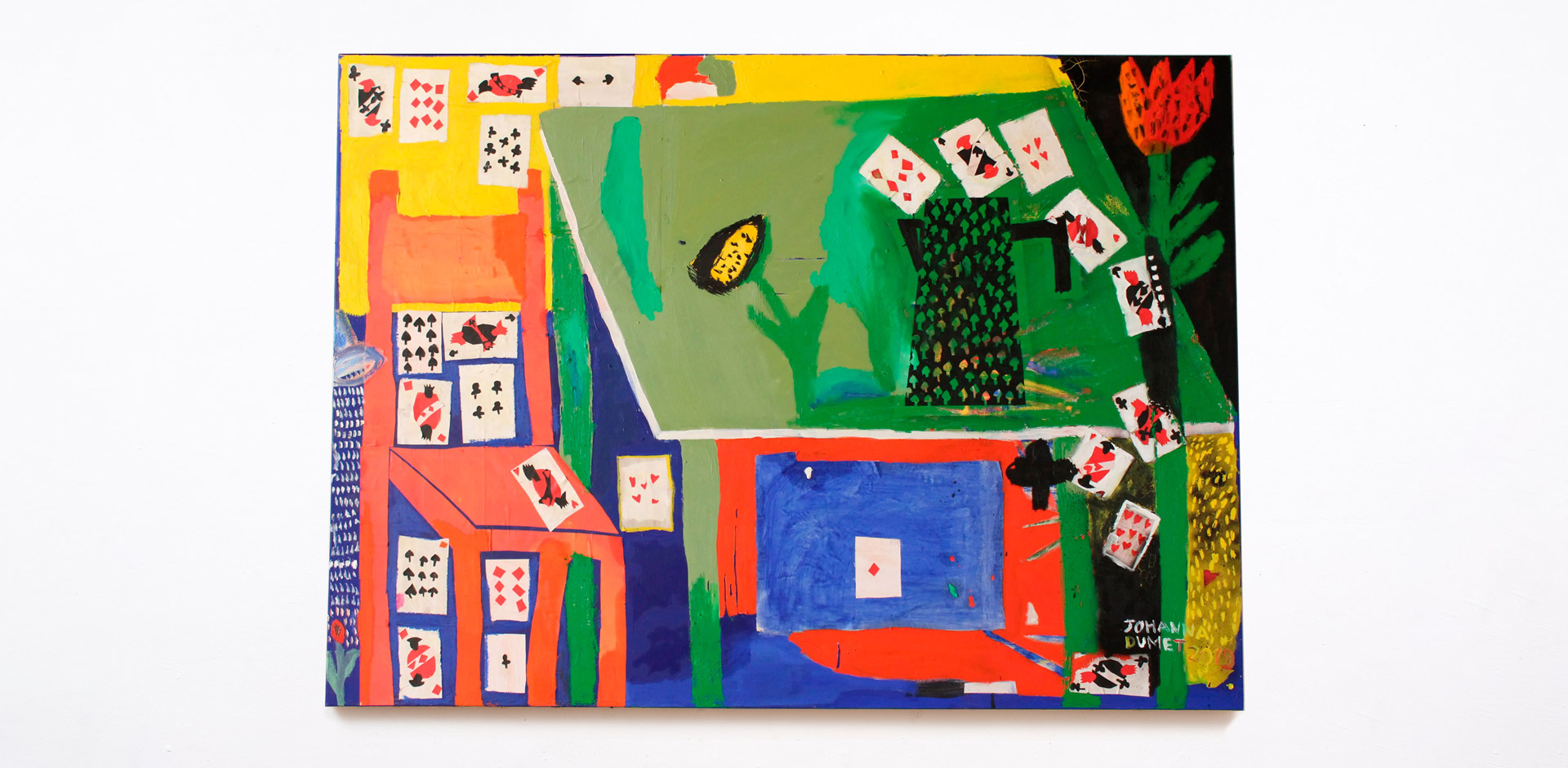
Weserhalle is excited to be apart of the second Art & Antique fair in Potsdam this coming October; a mix of regional and supra-regional galleries will be presented with a diverse offering of contemporary art, antiques, paintings, graphics, glass, and furniture. Our purpose at this fair is to present a key selection of our current local artists and collaborators. With a focus on locally produced art, Weserhalle is committed to supporting new and emerging artists in Berlin and to provide a platform for their professional artistic development.
Artists
Hola Mono.
Ivanna de Vivanco.
Johanna Dumet.
Manuel Wroblewski.
Paul Waak.
Stephan Dybus.
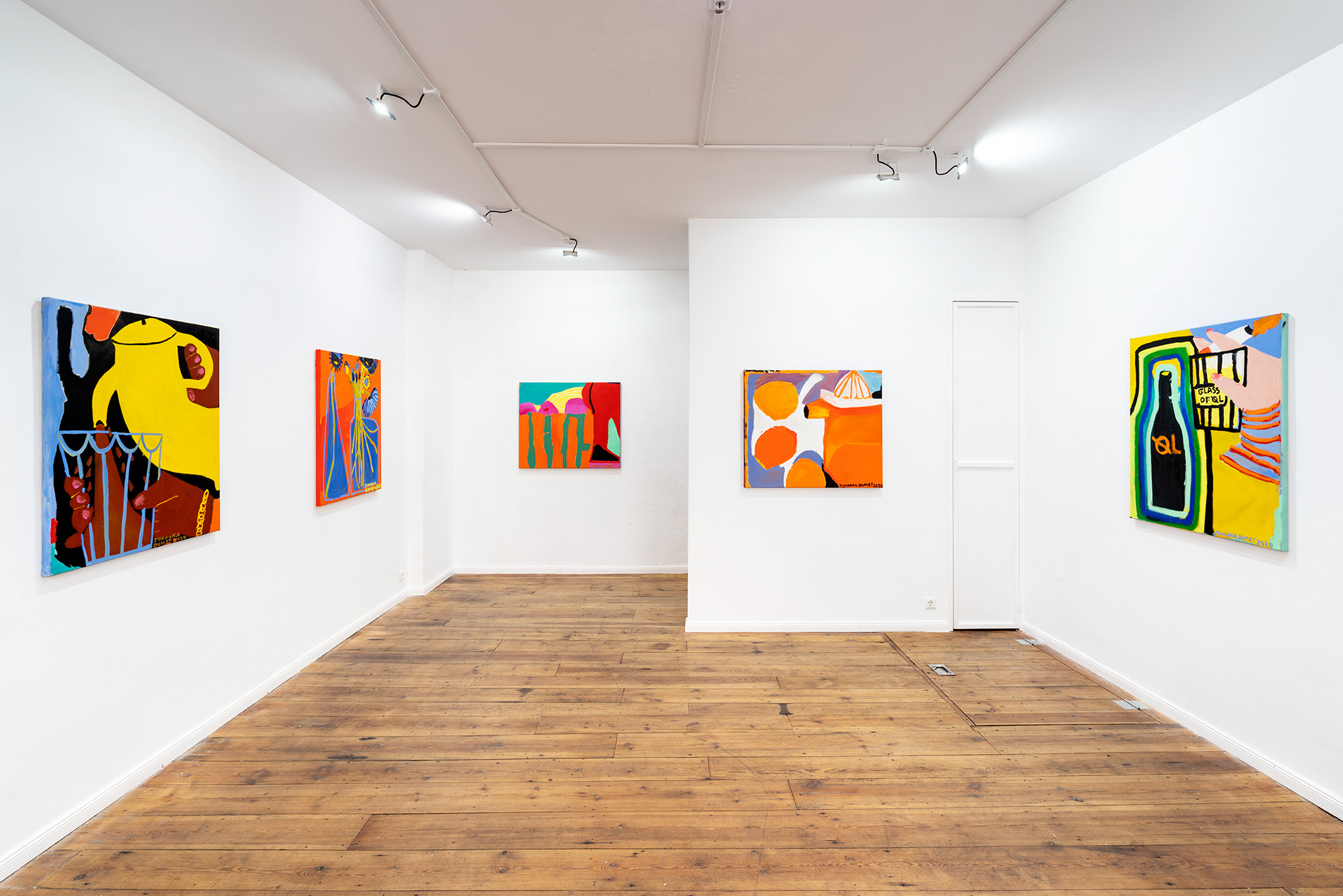
For her first solo exhibition at Weserhalle, French artist Johanna Dumet presents ‘Geil, oder?’, a series of bold still life paintings rendered in swathes of bright colour.
Painted in Denmark (the historic Fyrgården in Anholt) during the peak of Scandinavian summer, Dumet’s work is a testament to the endless light and vivid colours of the Northern European landscape. For this body of work, Dumet did not withdraw to the comforts of an indoor studio (though the Fyrgården at Anholt is stripped bare of modern conveniences), but instead situated herself in the centre of her inspiration, occupying the courtyard of the Fyrgården as her primary workspace. Thus exposed to the elements, she was obliged to adapt her work quickly to the changing light, wind, rain, birds and other uncontrollable elements of the natural world, finding a harmonious cadence with life beyond the studio. Lively and wild, she translates the vitality of the island’s rugged landscape to canvas, reflecting the outdoors in both rich and vibrant oil paints.
While in Denmark, Dumet’s painting process begins with applying colour to canvas (the same enhanced, seemingly synthetic colours she observes in her surroundings): light greens, dusty purples, bright yellows, oranges, reds, ultramarine blue and dark violet. After the colours are applied, Dumet considers the abstract and distorted forms she has inadvertently created, reading into them various objects or situations she recognises from lived experience. These are mostly objects found in the house—a juicer, tea pots, fish baskets, a bottle of øl—as well as scenes from daily life, though her rendering of such quotidian material is far from banal.
Though Dumet paints what is around her, her work does not simply mimic life. Rather, she paints spontaneously, fluidly, and without constraint, the result of which is an elevated, seductive use of colour and abstract form that constantly plays with figuration. She is unconcerned about detail, and follows a rhythm of what comes naturally through her head and her hand, citing Jean-Michel Basquiat and Danny Fox as key inspirations to this process (particularly as they are each self-taught, and thus possess the artistic freedom she herself aspires to). Dumet does not attempt to correct form or colour, instead staying attuned to her sensitivity to nature, and maintaining a genuine delight in creative naiveté to avoid constraints or rigid expectations. She uses classical techniques in her work—painting with oils, preparing canvases with rabbit skin glue, mixing her own colours (one of which she produced using a pigment foraged on Anholt), even painting still lifes or portraits—but she keeps a fixed perspective on the whimsical and the contemporary, flirting a little with the psychedelic, the comic, and the peculiar, but importantly, not allowing her work to occupy the dusty shelves of art history.
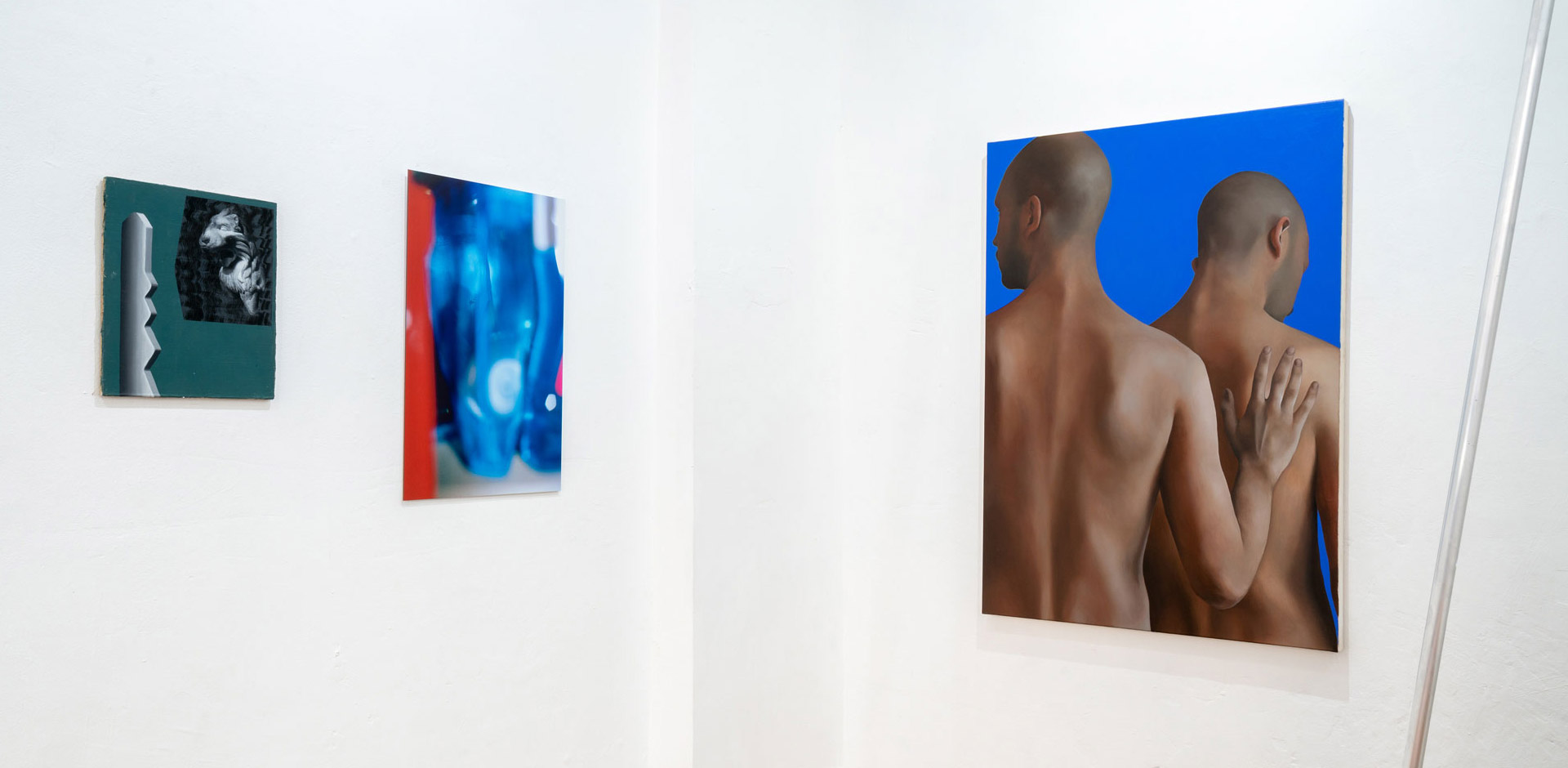
Weserhalle presents the Not Cancelled Group Show; a selection of artists currently studying at Kunsthochschule Berlin. Due to the current pandemic, access of students to their workspaces has been strictly limited and commonly prohibited. Opportunities and platforms for students to exhibit their work have been postponed, cancelled, or forced online. We acknowledge that exhibiting work during studies is an integral part of the learning process. As the regular structure for this process has been compromised, Weserhalle has provided an opportunity for this to continue. Artists:
Abie Franklin, Annabell Häfner, Dean Annunziata , Friedrich Andreoni, J. Gottmanns + K. Fritsche, Johannes Bosisio, Lars Unkenholz, Lorenz Pasch, Lukas Luzius Leichtle, Manuel Resch , Maximilian Schroeder , Paula Breuer , Shira Orion, Victoria Pidust.
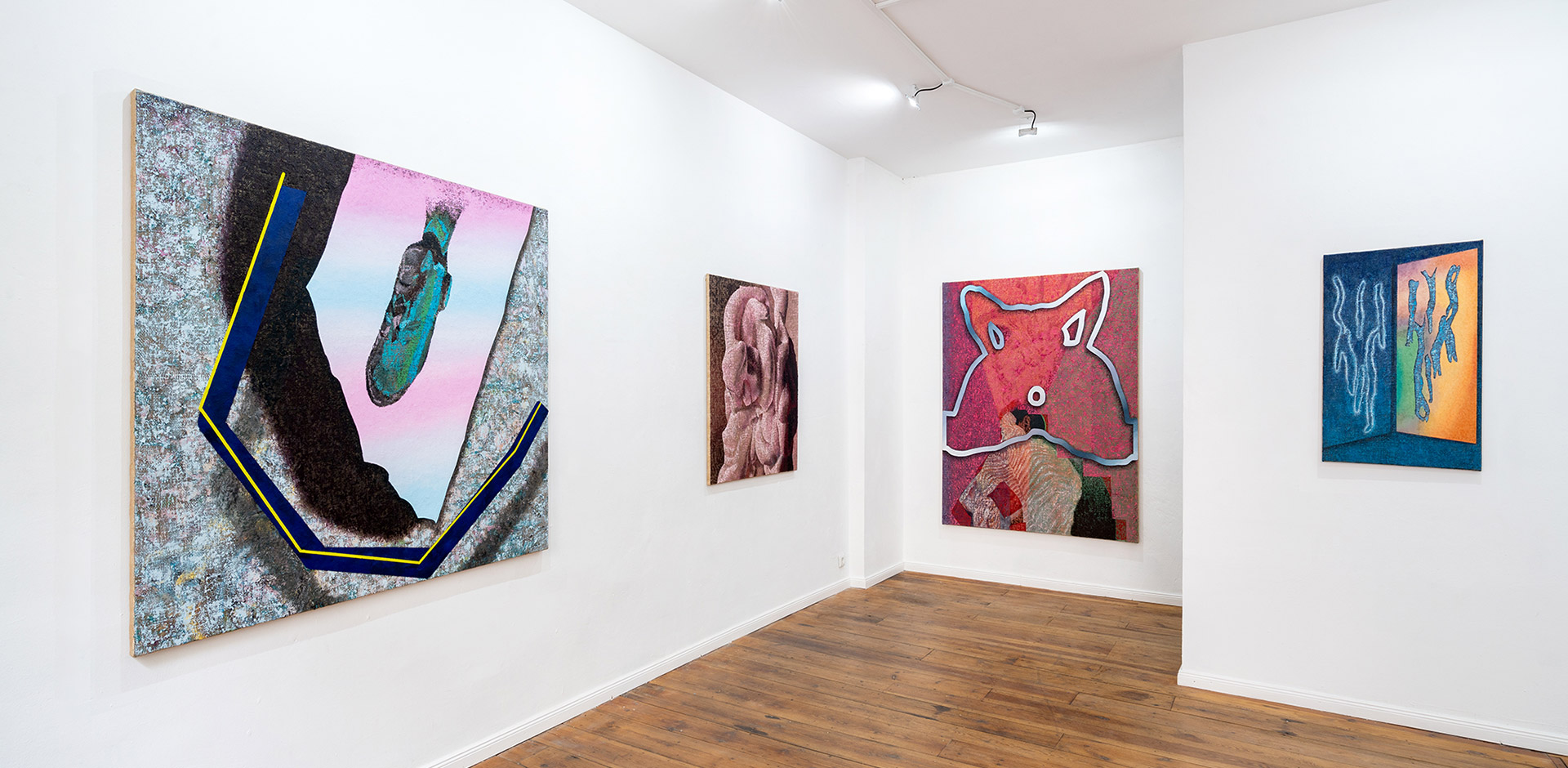
Weserhalle and Open White Gallery present new works of painter Inna Levinson, In your face. The exhibition marks the second year that both galleries collaborate together during the 48 Stunden Neukölln festival.
As we watch the world through the screen, the screen gazes back at us. It may notice our fingers sliding frenetically over the surface, navigating a thousand open tabs. Our most human expressions are increasingly experienced digitally; the perception of our surroundings have become distorted in scale. Painter Inna Levinson addresses these phenomena, as well as our behavioural patterns in the digital world, as she translates them into the classic medium of painting. With varying thickness of applied oil, the digital feel of the image collides with the raw haptics of the partly exposed canvas. Open White Gallery and Weserhalle present new mid- and large scale works by Inna Levinson.
Inna Levinson (born 1984 in Lviv, Ukraine) graduated in 2014 with a MFA in Fine Arts from the University of the Arts (UdK) in Berlin. Prior to this, she studied at the Academy of Fine Arts (Avu) and the Academy of Arts, Architecture and Design (VŠUP) in Prague, Czech Republic. Her works have been shown, amongst others, at Circle Culture, Berlin (solo, 2018), Allouche Gallery, New York (2017), Ten Haaf Projects, Amsterdam (solo, 2015), Meetfactory, Prague (2010), as well as in 2008 at the Moscow International Biennale for Young Art. Levinson lives and works in Berlin.se—a juicer, tea pots, fish baskets, a bottle of øl—as well as scenes from daily life, though her rendering of such quotidian material is far from banal.
Close
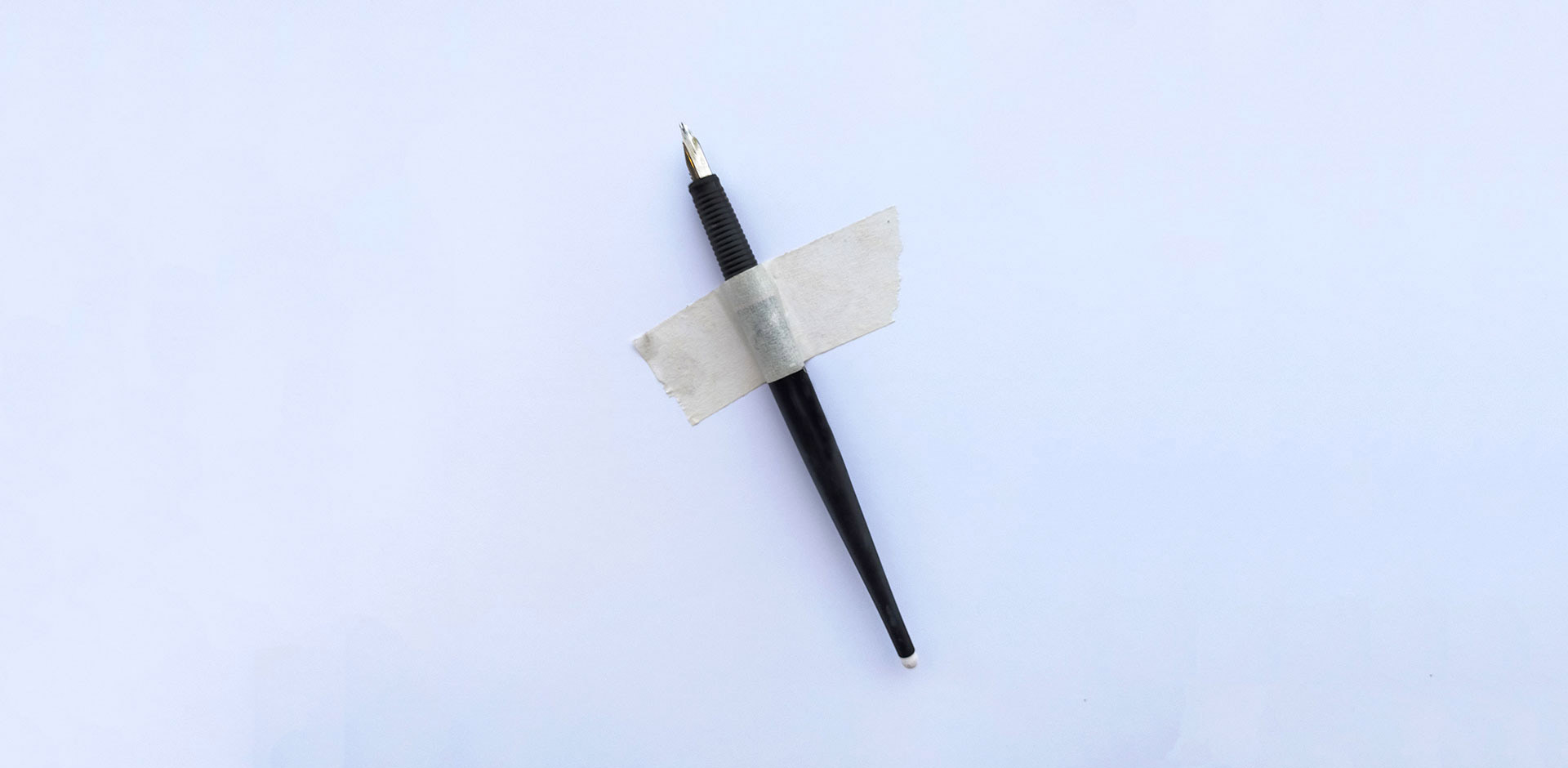
Jesse Leroy Smith is an Artist in Residence at Burnt Sienna Art School, an independent fine arts academy and atelier in Neukölln, where he has produced a series of paintings leading up to his exhibition ‘The Inhabitants’ at Weserhalle (12 – 26 March).
As part of an ongoing project, this collection of painted sketches explores the notion of ‘inhabiting’ a place, drawing inspiration from several locations, personal encounters and historical referents around Berlin. Smith distinguishes between inhabitants and citizens (the latter term suggesting people fixed in place, as opposed to a more fluid notion of inhabiting) to contemplate the nature of a city, and how cities are ultimately determined by the people in them. To achieve this, he has selected a diverse roster of protagonists for this body of work, both real and imagined, to compile a bank of visual material used to create an arcade of images to fill the gallery. Friends and acquaintances, strangers encountered on the street, animals, trees, historical figures and characters from popular culture are woven together to create a vivid tapestry of Neukölln and the wider city.
Jesse Leroy Smith lives in Newlyn and Brighton. He studied Fine Art at Norwich School of Art and was awarded a postgraduate diploma in painting at the Royal Academy Schools in London. He exhibits internationally in commercial and public galleries, art fairs, and travels widely for art residencies and research. Recent exhibitions include a tour through Northern Europe screening collaborative films, which concluded with a group show at the Martin Asbaek Gallery in Copenhagen. In 2016 Smith undertook a major commission from Cornish Mining World Heritage Site to commemorate the mining legacy with a series of public performances and a suite of copper etchings. Highly acclaimed, the project later received funding from the Arts Council England to make ‘Assembly’, a series of 20 etched portraits on copper plates.
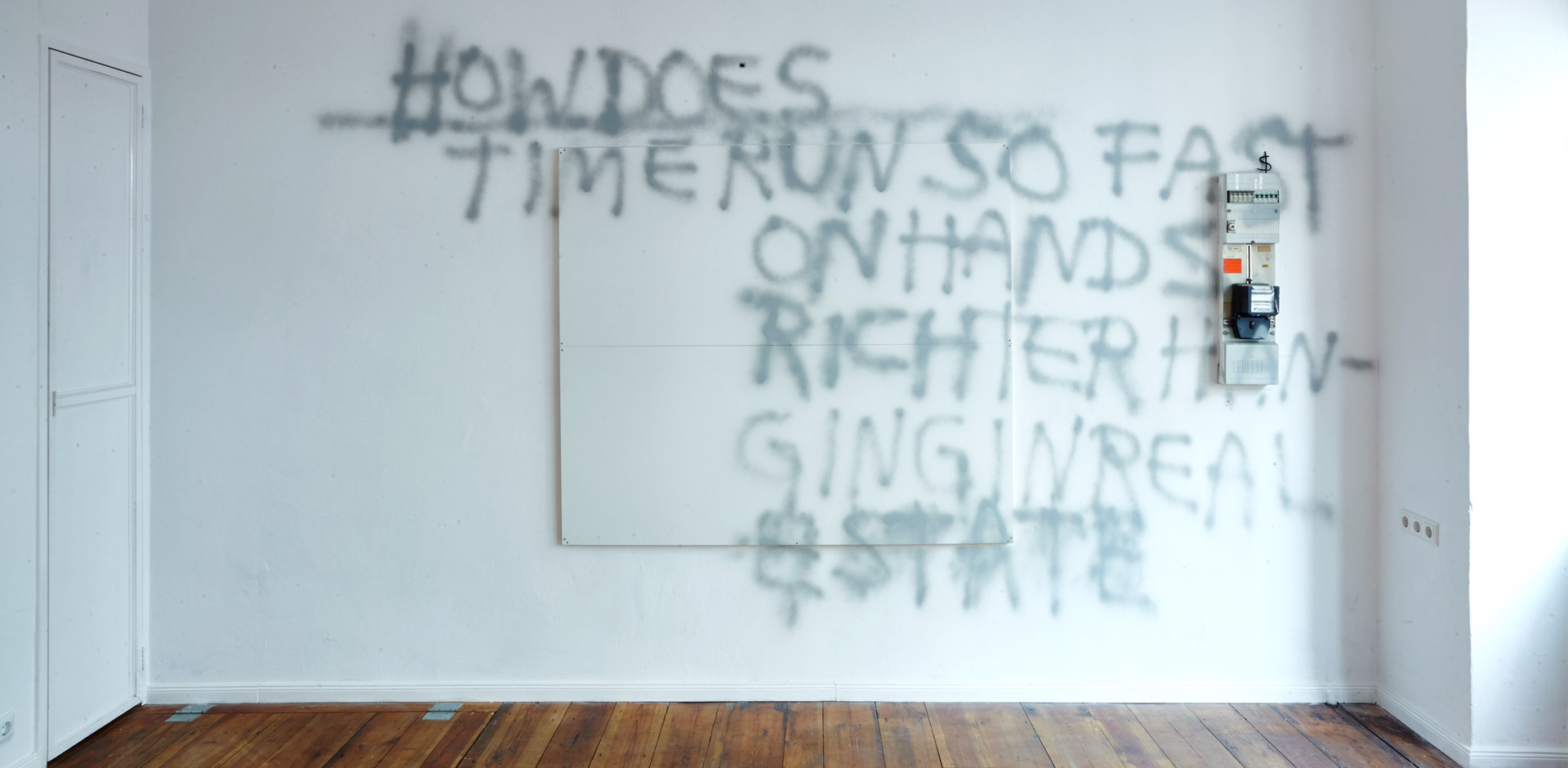
In the end you still are stuck in traffic
And your watch still ticks at the same speed
The artistic practice of Berlin-based artist Monty Richthofen is rooted in his interest in prose poetry and aphoristic language. For his first exhibition at Weserhalle, Richthofen draws on his attention to words, as well as his adjunct practice as a tattoo artist, to produce Ferrari, a body of work that reflects on materialism in contemporary society via a diary-like collection of thoughts and phrases transposed to white walls.
As an elaboration of an earlier artwork—a series of tattoos titled #mywordsyourbody, during which the artist gained often relatable insight into his clients’ thoughts and fears around material desires—Ferrari is composed of original text-based works and paintings that shift Richthofen’s inscriptions of poetry from the body to the canvas, capturing the very human anxieties over social class and economic stability in a classically artistic form. Taking a staunch position against luxury goods as symbols of social and economic status, this newest body of work sniggers in the direction of superfluous extravagance
‘We are all consumed by the desire to consume’, muses Richthofen, and this fact of contemporary life comes at a price. The works in Ferrari aim to deconstruct the symbolism embedded in material possessions, making reference to the luxury car company to emphasise that the pursuit of material wealth is ultimately a sacrifice in personal time. To Richthofen, jewelled watches, high end handbags and lavish sports cars represent participation in a capitalist system that ultimately strips away personal freedoms. Additionally, within this critique of consumption emerges the contemporary art object as luxury good, and certainly criticism for the commodification of art does not elude Richthofen’s scope. Just as he judges other forms of opulence, the artwork is similarly critiqued for being bound up in a culture of acquiring material possessions. Though despite this observation, materialism is a syndrome from which the artist admits he is not exempt.
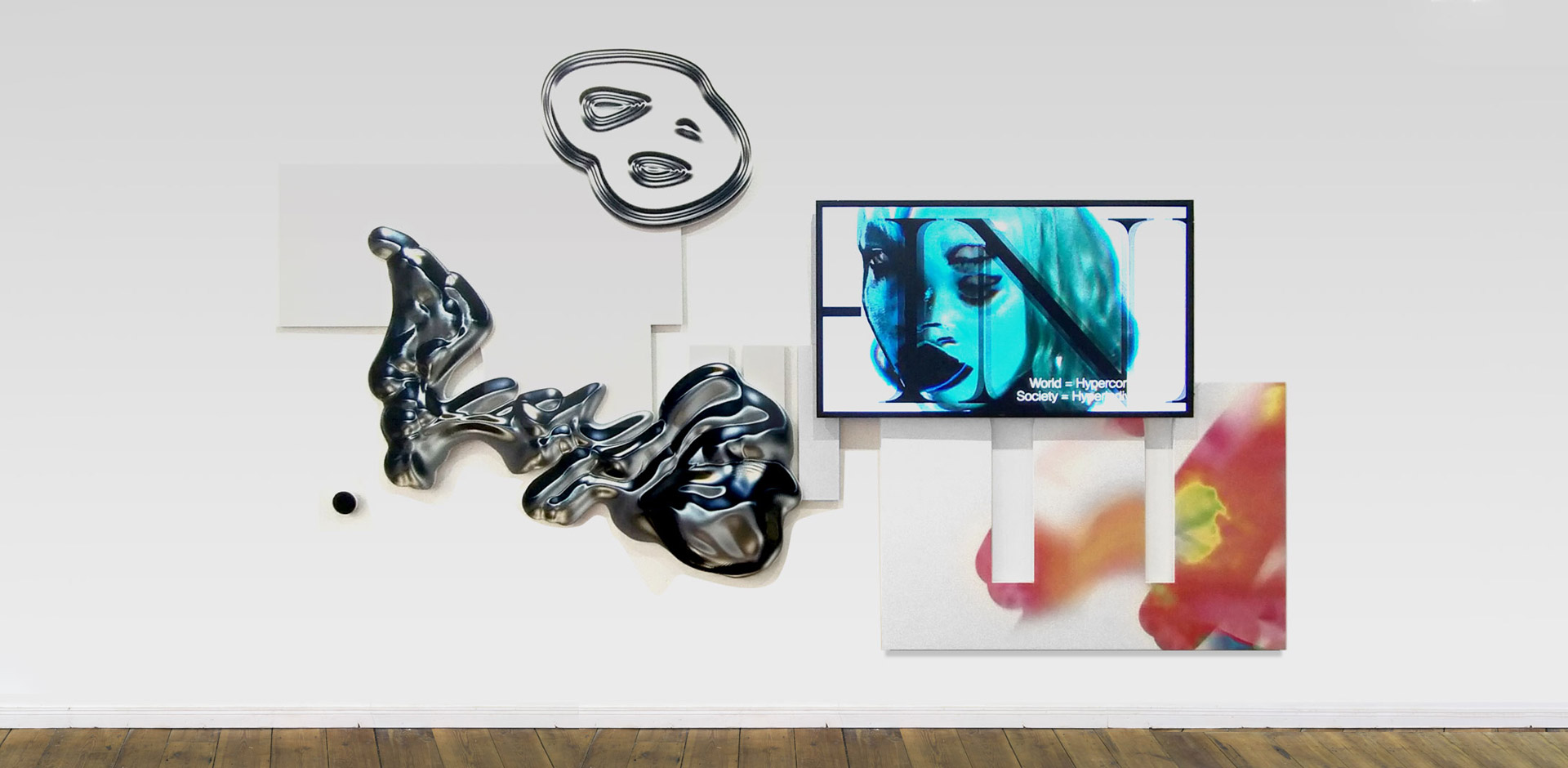
For our first exhibition of 2020, we are pleased to present Beauty in techno-expressive times, an exhibition and interactive experience by Claudia Rafael and Moritz Tontsch in collaboration with Weserhalle, Vorspiel 2020 and CTM festival.
With technology we can alter the digital appearance of our bodies, which enables us to develop more personal and abstract interpretations of our physical selves. Using technologies to change circumstances, which are dictated by nature towards an individual approach to beauty has a huge emancipatory potential for self-realization. Digital tools and resources to learn how to use them never have been more available as they are today. Tools like augmented reality open up the possibility to develop a novel approach on beauty. By using these tools, we are able to alter our perception of what is considered beautiful and free ourselves from the current social norm.
Our understanding of physical beauty is changing. Augmented reality is inherently dependent on the physical world yet the physical world becomes more and more dependent on its virtual counterpart. Emerging approaches on beauty in these combined realities influence each other and therefore will change each other. The exhibition at Weserhalle aims to explore the following three statements:
Our virtual self is as real as our physical self. The way we experience beauty in virtual realities is influencing us as much as experiencing beauty in the physical world.
Otherness = Beauty The socially accepted norm of “beauty” is being substituted by strategies to become different. Alienation is used as potential for distinction thus turning socially normed otherness into a new way to create a differentiated beauty. Augmented Reality enables the relief of YOUR idea of beauty that lives in YOUR body and mind.
The naturalistic approach on beauty is over. While in the age of the natural, beauty was altered only to the amount to which it still seemed biological plausible. It was claimed that you look the same way you look in the virtual world as you look in the physical world. In techno-expressive times, altering beauty with the help of technology gets more expressive and digital bodies get more and more alienated from physically possible forms.
Claudia Rafael is a digital Artist and Creative Director. Her work focuses on issues of technology, extended and mixed realities. Rafael is interested in investigating how, “digitalism form new aesthetics” related to art, nature and popular culture. Moritz Tontsch is a motion based media artist researching in artificial nature and alienated bodies in extended realities. He works with VR, AR, grafix, animation and 3D printing.
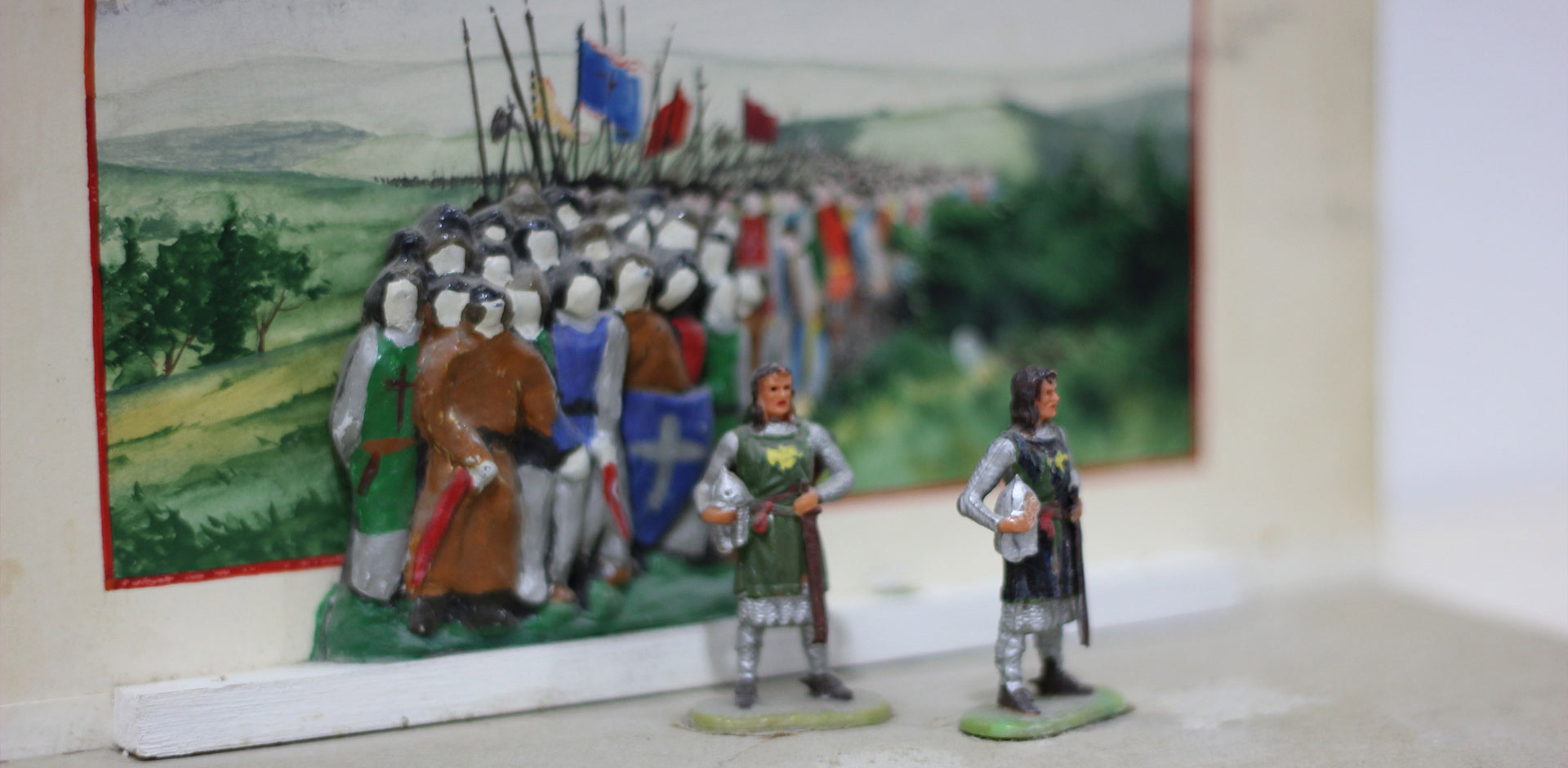
Stehen Sie mit nur einem Fuss und zwar auf demvorderen Ballen. Der Fuß befindet sich nun in der Mitte. Drei Prozent werden addiert und durch zwei geteilt. Bei einem Jungen werden dann noch sechs Zentimeter dazugerechnet, bei einem Mädchen werden sie abgezogen.
Den Möglichkeiten sind kaum Grenzen gesetzt. Es sei denn, es treten schwere körperliche Probleme auf. Bezogen auf die Vermeidung ist „augmented reality“ ein probates Hilfsmittel, um die heimische Umgebung in Einklang zu bringen. Man wird von anderen Leuten angestarrt und das ist nicht immer schön. Aber alles ist relativ und so verwundert es nicht, dass klare Grenzen gezogen werden müssen.
Gruppenausstellung der Klasse Martin Honert der HfBK Dresden.Dreidimensionales Gestalten soll als eine Äußerung in jeder Form und Wesensart eines raumgreifenden Ereignisses verstanden werden. Die künstlerische Praxis bildet den Kern der studentischen Lehre und Auseinandersetzung, in einem fortlaufenden Prozess materiellen Gestaltens und geistiger Hinterfragung.
Hanne Lange, Johannes Specks, Mirjam Kroker, Raiko Sánchez, Olivia Schneider, Jonas Engelhardt, Elisa Schuhmann, Lars Frohberg, Johanna Failer, Simon Mann, Valeriya Krasnova, Martin Honert, Lisa Lipelt, Lydia Henkel, Karen Kamiya, Si Cheng, Antonia Silberman, Miriam Schröder, Alex Lüder, Seoyoung, Camillo Gulde, Teresa Ellinger, Jinmo Ryu.
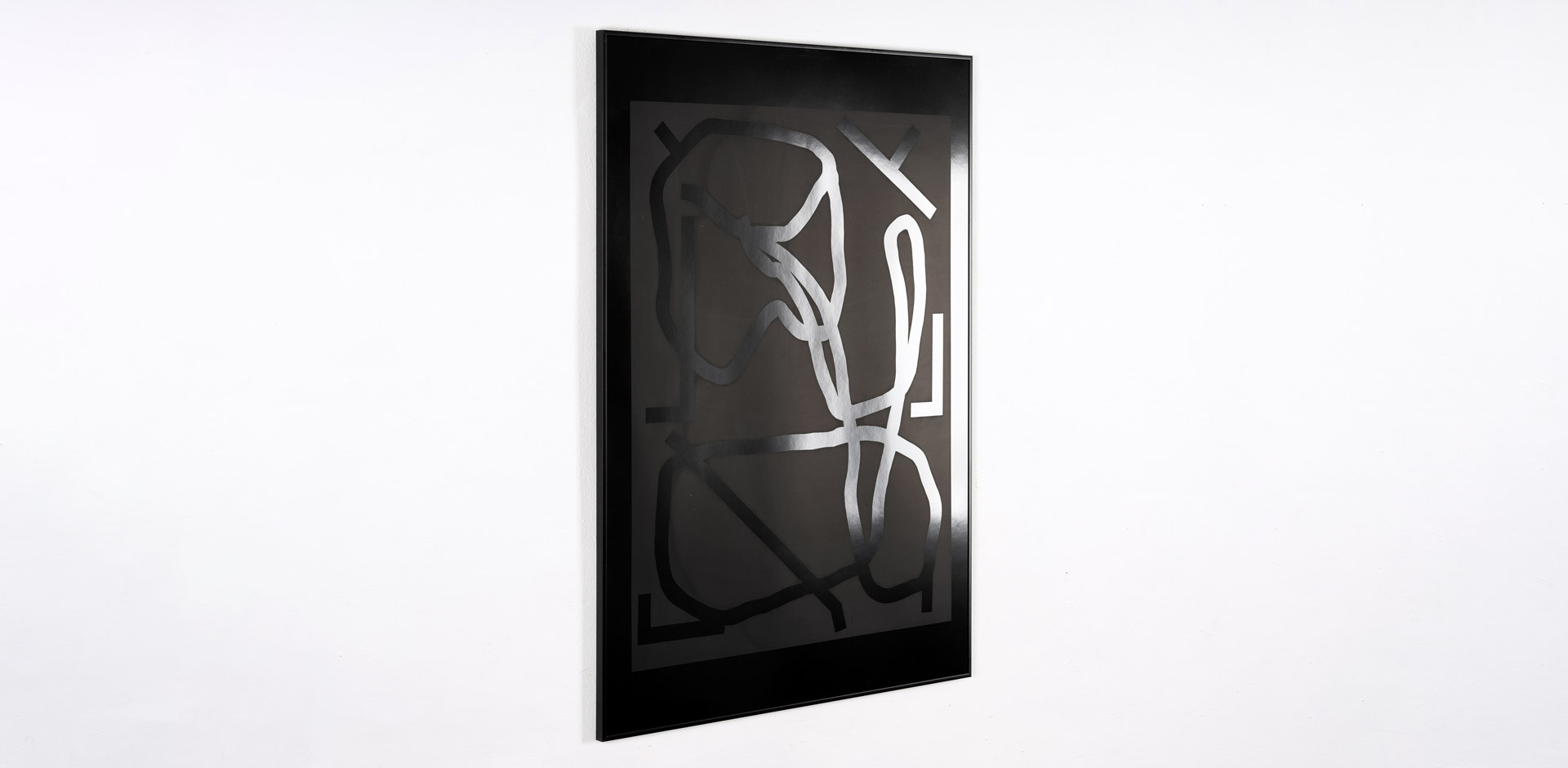
Hola i chau is an artist duo (Hola and Chau). Their name plays with contrast and duality, referencing the binary greetings ‘hola’ (hi) and ‘chau’ (bye). In their artistic practice, Hola Mono maintains a focus on amalgamating fragments of the every day, embracing inconsistencies and visual discordance to celebrate the possibilities latent in the unexpected. They are self-described as ‘beings of movement and constant mutation,’ and their work expresses this fluidity in collaboration. Oscillating between the deconstruction and reinterpretation of ordinary phenomena, they relish in the flexibility of working together. Theirs is an open field of experimentation, with an interlacing of contradictions, contrasts, decomposition and regeneration that form the core of their conceptual interests.
For their first exhibition at Weserhalle, holo i chau focuses on developing these themes, using material found on the street as both medium and inspiration. This is presented as ‘The Stillness of Motion’, a series of physical sculptures and screen printed images that make up a conceptual intervention into typical notions of ‘waste’ in wider society. Hola Mono are ‘selector-collectors’: their sculptures are fabricated from found material, transforming debris and discarded matter into objects worthy of contemplation. By extension, the prints echo these sculptural forms, using techniques of layering to reflect the intricate, and often unusual forms of the physical works. As the title ‘The Stillness of Motion’ might suggest, Hola Mono identifies a poetics in discordance. With intention to give visibility to otherwise invisible matter, they broaden the lifespan of typically disposable things to fracture the thoughtless patterns of consumption in a consumerist world, finding beauty in that which goes overlooked.
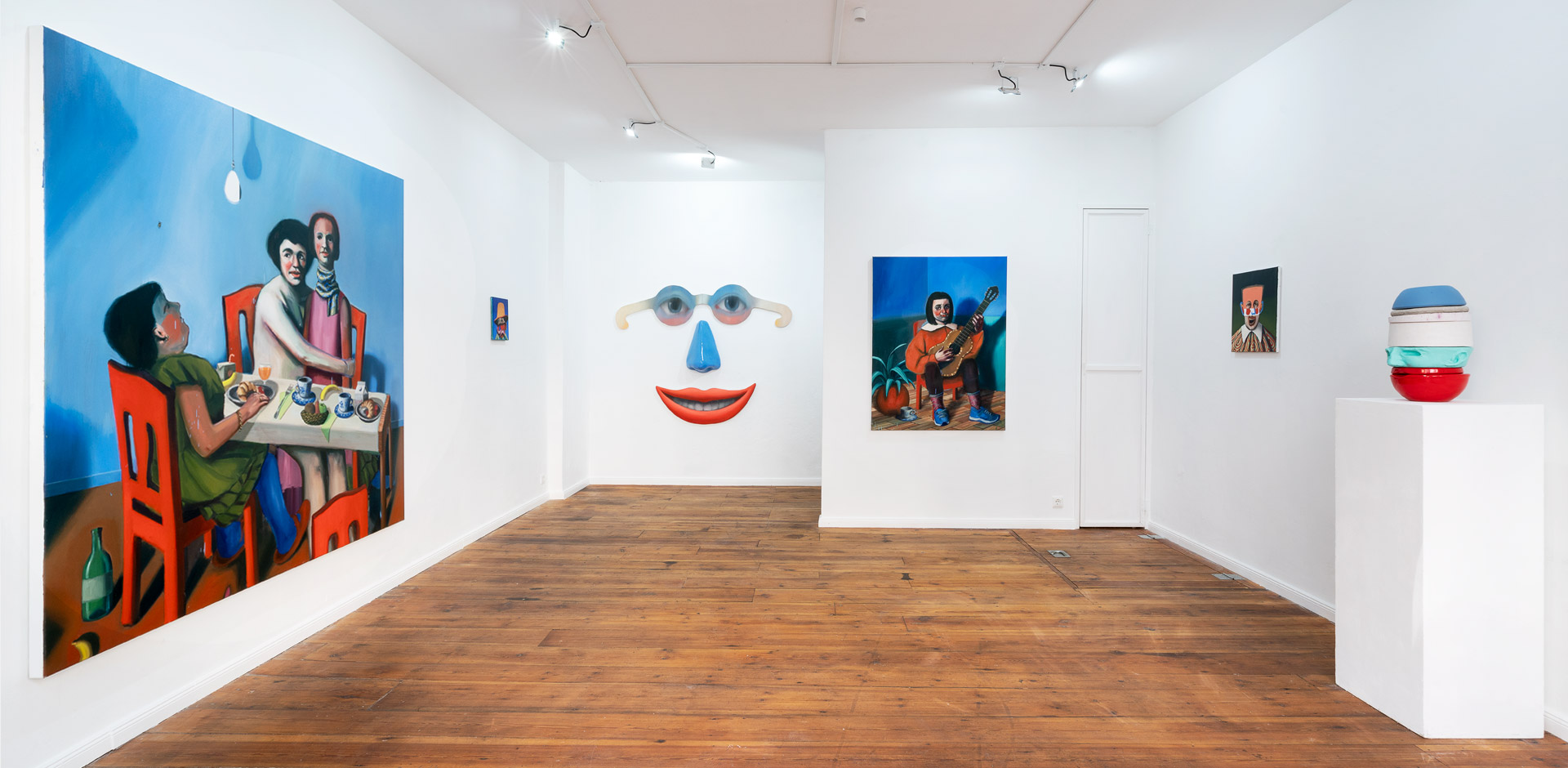
Weserhalle is pleased to present the first Berlin exhibition of Chilean-Peruvian artist, Ivana de Vivanco, ‘THE BIG NOSE: A Matter of Perspective or Perspective Matters’. Like much of her previous work, this collection transforms the gallery into a deliriously experimental theatre, where all actors take the stage. Hallucinatory, dark, decadently colourful, and utterly compelling, de Vivanco’s characteristically whimsical canvases depict a host of unseemly players in order to reflect the absurdities (and artificialities) of the human-made world.
For this exhibition, de Vivanco has transgressed the boundaries of her chosen medium (painting) in order to explore the possibilities for a synthesis between picture and sculpture. Using the motif of the nose, and working with three dimensional objects made of coloured plaster, concrete, and resin, de Vivanco wrests the flatness of the painted surface into the tangible space of the gallery in what she envisions as the crossing of an invisible boundary between the represented and the real. With her tongue in her cheek, she muses that if one were to cross that imagined divide, the first appendage to emerge into physical space might be the nose.
In her painting, de Vivanco makes countless references to art history: the black despair of Goya, the frightening contortions of Bacon, religious iconography, Renaissance drama, ancient myth. Her characters are just as variegated, painted in jester’s checks, smoking jackets, linen scarves, and wide-brimmed hats. Still other figures are rendered nude—a common trait of the artist’s work—and yet all wear masks of either stoic neutrality or theatrically twisted emotion; they are at once vulnerable and performing.
As THE BIG NOSE makes clear, the theatrics of the human world are a matter of perspective. Just as the nose on one’s face is always in view, yet hidden in plain sight, the decadence of modern society is both obvious and obscure. De Vivanco recalls the Baroque theatre of Calderón de la Barca—the Spanish dramatist whose genre of theatre portrayed life as a farce, and everyone the hypocrite—when she insists that this humour is perhaps more relevant today than ever before. We, the protagonists of our time, are constantly (and compulsively) changing identities, responding to excess by donning frightful masks. And yet despite the deeply sinister overtones of her work, by de Vivanco’s estimation, perspective matters.
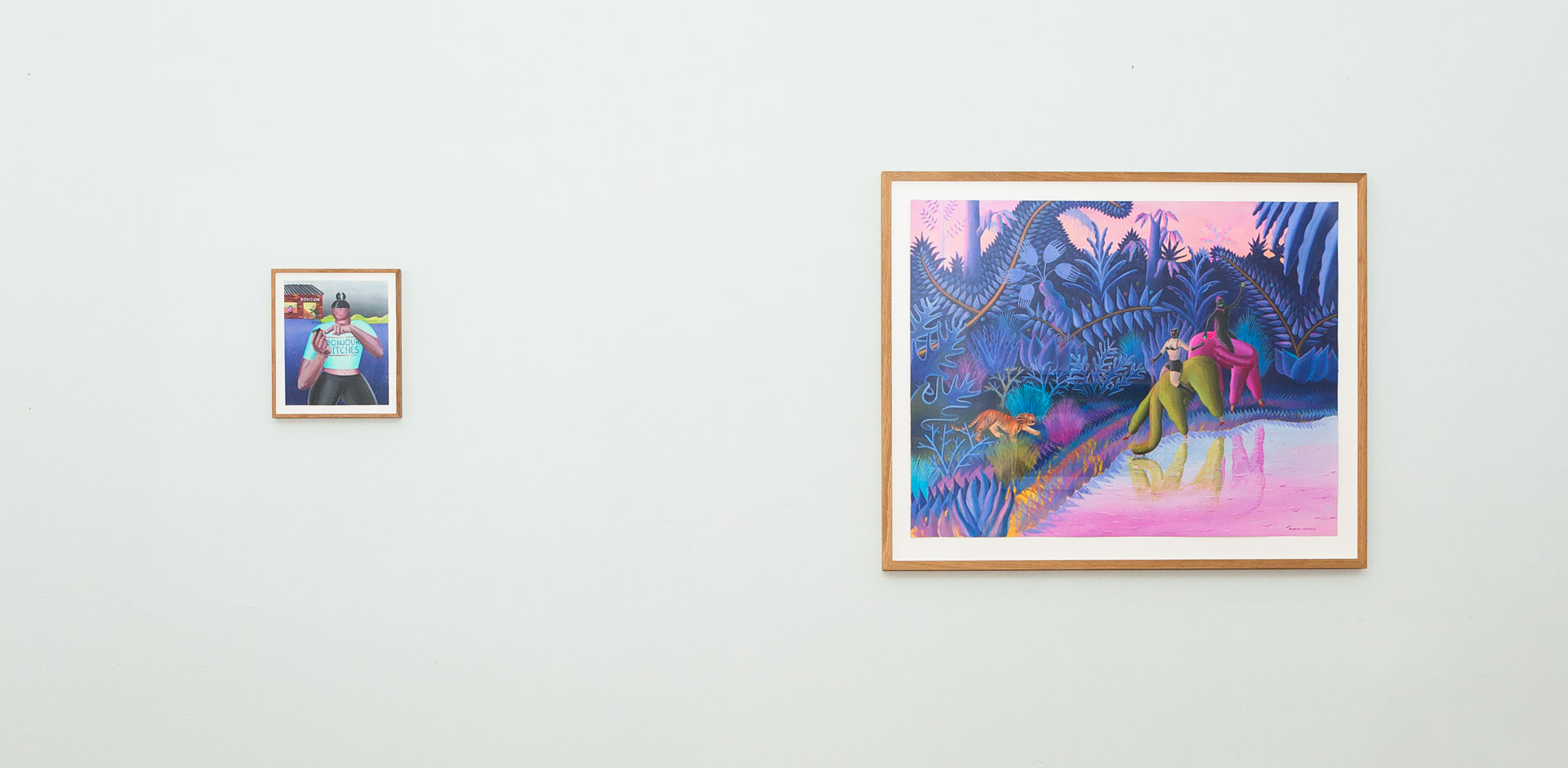
Robert Deutsch is a bold user of colour. Working as both a commercial illustrator and a fine art painter, his works can be characterised as fanciful and technicolour universes that merge the labyrinthine meccas of the psyche with the eccentricities of popular culture. In particular, Deutsch concerns himself with the visual language of comic strips, which he transposes seamlessly from low to high art and back again in a playful examination of the modern human condition.
For his first solo exhibition at Weserhalle, Deutsch presents Begleiterscheinungen (Accompaniments), a series of paintings which elaborate on these well worn themes in his earlier work. Characteristic of his painterly style, the artist uses humour as a catalyst for considering the darker realities of modern life. Sarcasm, he believes, has an enormous persuasive power. In this series, Deutsch paints a troupe of unusual protagonists, parodies of the typically heroic figures found in modern literature and pop culture, and which he consequently resists placing into the idealised roles they so often occupy. Instead, they come to represent various traits of the modern person: greed, egotism and prejudice, but also tolerance, creativity and self love are among some of the attributes embodied. Included in this cast are a frolicking, hand-holding Batman and Robin duo; a silver-haired, tattooed florist called “Opium”; and a seemingly befuddled huntsman, whose vocation has been nonsensically mistaken for logger, as he looks askance at a forest of slain trees. Deutsch’s favourite among them is a character of his own creation called Bobby Feucht, an alter- ego of sorts, whom he lives vicariously through in order to better understand the human characteristics he critiques.
In other works, like “Lutherland”, Deutsch zooms out on individual actors to offer perspective on the hive-like activities of society. The work has an “I-Spy” meets “Where’s Waldo” atmosphere, where the alienating aesthetics of shopping malls reign supreme and modern life is rendered as overcrowded and absurd. In a cross-section of the urban landscape, walls are cut away to offer intimate views into both private and public realms, and via this perspective Deutsch emphasises one of the biggest issues of our time—the pathological impulse to consume—putting forward capitalism as an uncontrollable force greater than any one person. Yet, rather than constructing the scene to simply dismay his audience, Deutsch invites the average viewer to first concede to its honesty, and then finally to laugh about how their own daily lives might resemble the ones represented in the pictures.
Blending pop aesthetics with modern surrealism, Deutsch creates vibrantly ambiguous spaces inhabited by a host of strange and eccentric characters, in order to poke fun at the more sinister aspects of modern life. Nevertheless, his works retain a sense of playful humanity as he graciously let us all in on the joke.
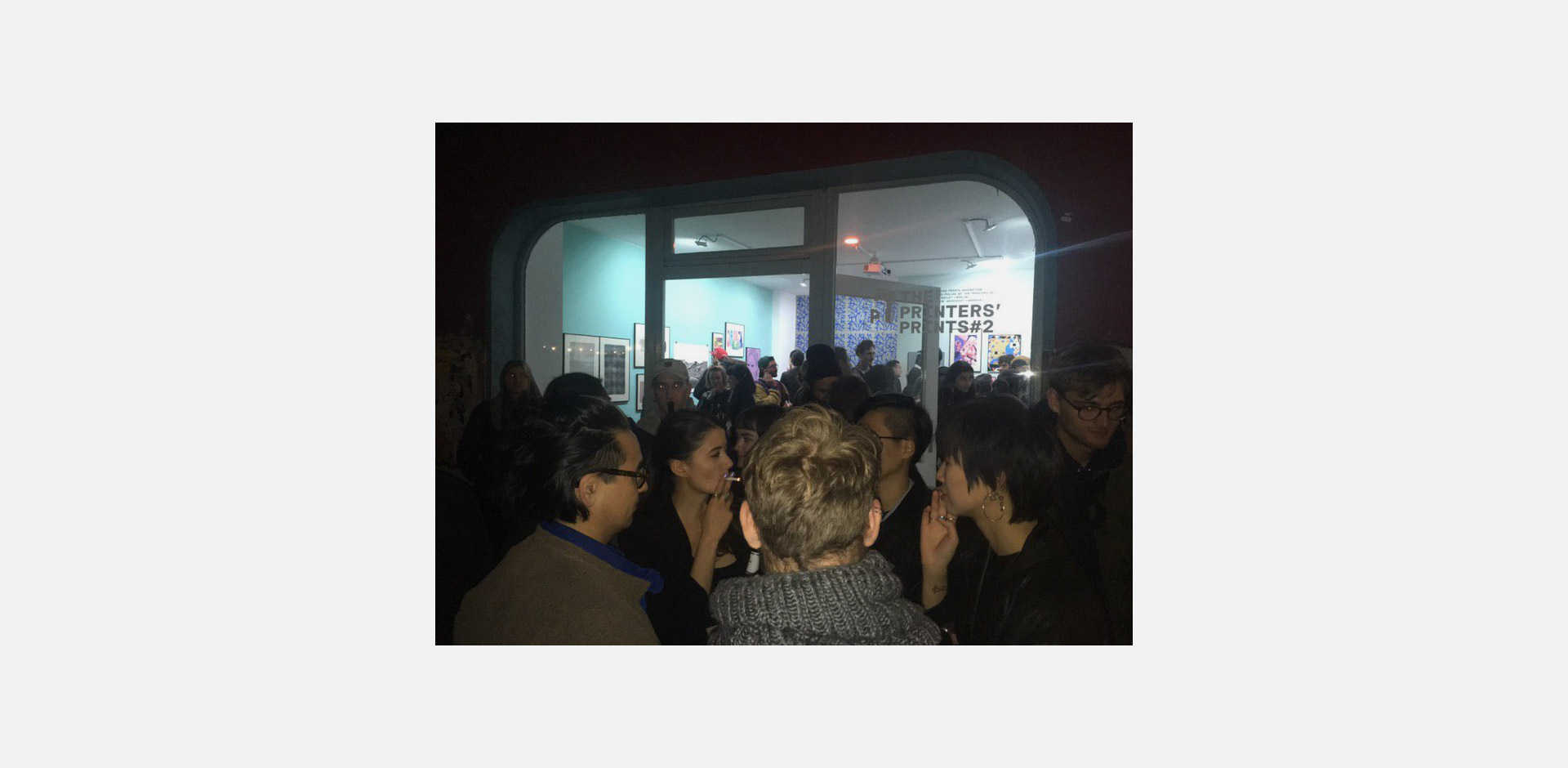
The Exhibition “the Printer’s Prints” was born as a collaboration between Berlin-based studio Le Raclet, and Bangkok-based studio The Archivist.
Two parallel realities at the opposite sides of the world, both female run and with many years of practice behind them, the two screen-print studios share a genuine passion for graphic arts, and represent, in their respective countries of Thailand and Germany, a meeting point for artists, designers, and illustrators who come together to celebrate creativity.
With the decision to join forces, planning a collaborative show that involved both Thai and western artists, the two studios not only wanted to display their love for art, but also wanted to consciously step out of the shadow, celebrating their work as printmakers, and to show what they are capable of achieving following their ethics and the rhythm of their swinging arms.
The first edition of “the Printers’Prints” opened in Bangkok in February 2018 and was a great experience of collaboration and exchange.
This is the second collaborative group exhibition between the two studios, featuring hand pulled screen-prints designed by some of our favourite artists:
Andreas Samuelsson, atelier bingo., Daan Botlek, Fuzzgun, Jack Sachs, Jan Buchczik, Jeroen Erosie, Kelly Anna, Lee Anantawat, Manita Songserm, Marc Stuart, Enrico Mosconi, Minchaya Chayosumrit, Molly Dyson, Patsachon Toyingpaiboon, Sigrid Calon, Suthipa Kamyamt
The Archivist is a Bangkok-based screen print studio founded in 2013 by Min Minchaya Chayosumrit (Artist-printmaker/AGI Member) and Woon Kanaporn Phasuk (Printer/Creative director). The studio’s purest intention is to collaborate with people from different fields, for instance, galleries, artists, designers, architects, musicians, as well as poets and writers. They sincerely believe that by working with all these talented, creative thinkers, it will not only be challenging and inspiring but beneficial in terms of gaining competent printing experiences in a short period of time.
Le Raclet is a screenprint studio located in the heart of Berlin, specializing in fine art and high end silkscreen printing onto paper. Founded in 2007, since the first steps aims to produce prints of a consistently high standard, working
along side artists, illustrators, designers, creatives, small and big galleries, from the initial idea to the finished print.
Instagram: @leraclet
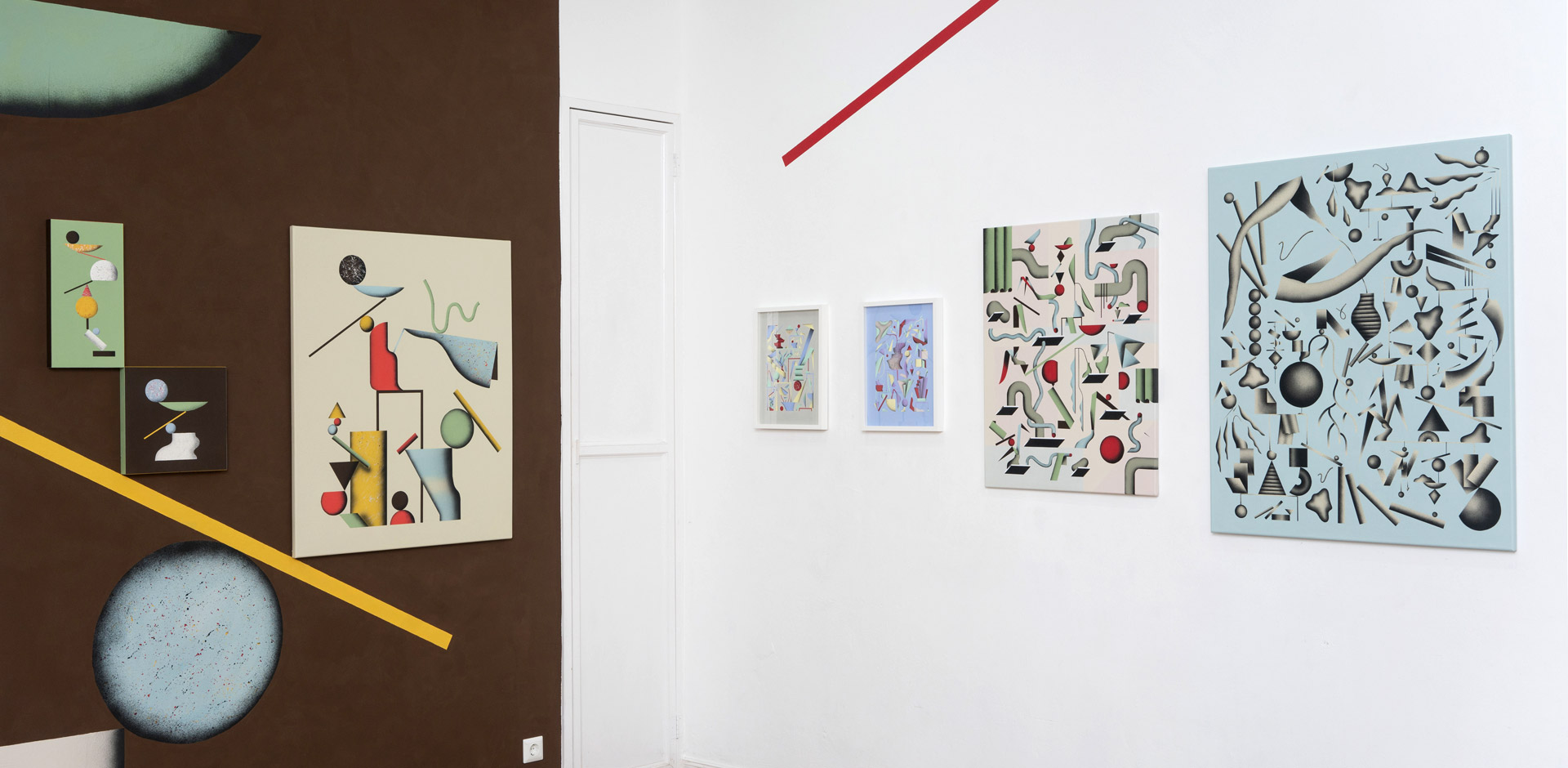
For her second exhibition at Weserhalle, artist Jeong Hwa Min presents Houseplants, a series of poly- and monochromatic graphic illustrations that are both bold and minimal in composition. Working primarily with airbrush painting using self-cut stencils, Jeong Hwa combines these techniques in a practice to experiment with the synthesis of geometric and organic shapes. She cites form, light and shadow in the natural world as primary sources of inspiration, finding a dualism in her work that is both constructed and abstract, and redolent of natural phenomena. Sharp angles share visual space with soft edges, curved and unusual forms rest against more familiar rectilinear structures, and in effect each work oscillates between a two- and three dimensional picture plane, acting as mediations between formal design and traditional painting. The works are additionally characterised by a mix of soft pastel hues and textured black and white gradients, which draw together these various forms to create indelibly surreal landscapes.
Though Jeong Hwa’s practice is rooted in design, she is also a storyteller. More than focusing on form, her illustrations are a conglomeration of many simultaneous narratives, each piece expressing several possible fictions at once. She combines geometric logic with more lyric forms of painting and shape-making, producing work that is equal measures ordered and expressive, static and dynamic. With works ambiguously settled between still life, sculpture and pattern, Jeong Hwa sets her stage for something deeper than pure design.
Originally from South Korea, Jeong Hwa currently lives and works in Gerswalde as an illustrator and painter.
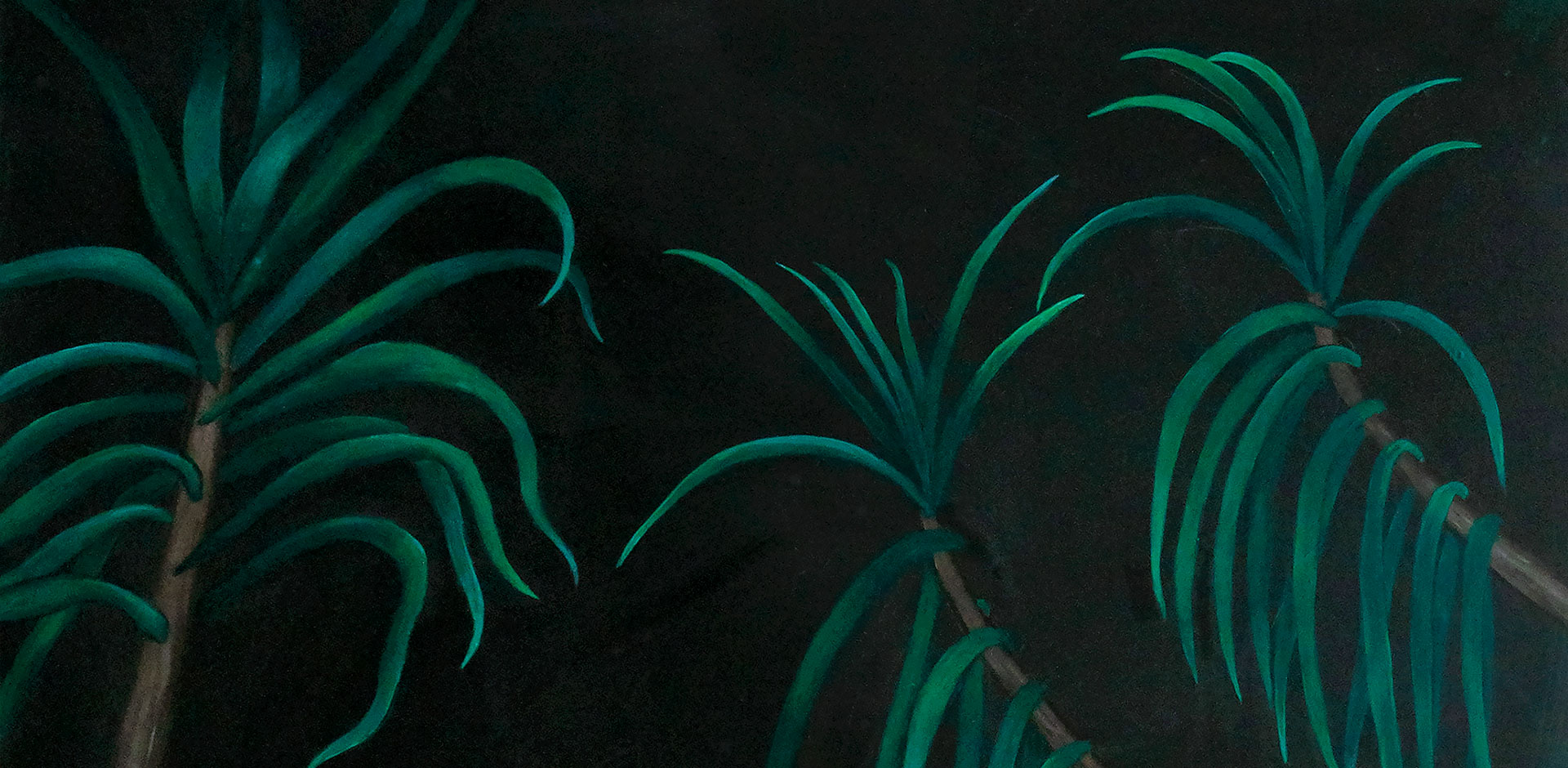
No Fish is an exhibition and artist’s book (Galerie 5b, 2019) by Berlin-based American artist Sarah Schneider, whose work draws from her experiences traveling between Switzerland, Italy, and Greece in the summer of 2016. Using an amalgam of found images to structure her painting, Schneider layers these references in a composite of history and personal memory, creating new narratives built entirely from methods of free associative image-making. At once prosaic and surreal, the paintings evoke fleeting moments and quiet nostalgia, questioning how temporality and experience shape our interpretation of place. Schneider’s works eschew the rational—they are at once uncannily familiar and confusedly alienating—combining remarkable stillness with a palpable tension in reverent contemplation of the psyche.
As a compilation, No Fish pieces together a narrative of familiar places that can never be returned to. Like memories, her paintings are suspended in time; lonely and longing, they gather the detritus of other thoughts such that they become distant from reality. Through her work Schneider acknowledges the eventual decay of things, both material and immaterial, ultimately asking, “Does anything last forever? Ancient sculptures, mountains, memories, love?”, presenting these questions as melancholic dreamscapes and wistful fantasies, each marked with a poignant absence of human activity.
Sarah Schneider received her MFA from Maryland Institute College of Art, Baltimore MD. Previous exhibitions include: ‘Autre Je’, Galerie Treize-Dix, Paris FR; ‘Unlisted’, Ice Box Project Space, Philadelphia PA; ‘Laugh in the Dark’, Current Space, Baltimore MD. Schneider is the author of Things, Which I Now See Darkly (Endless Editions, 2016) and Waning (Blotter Books, 2014).
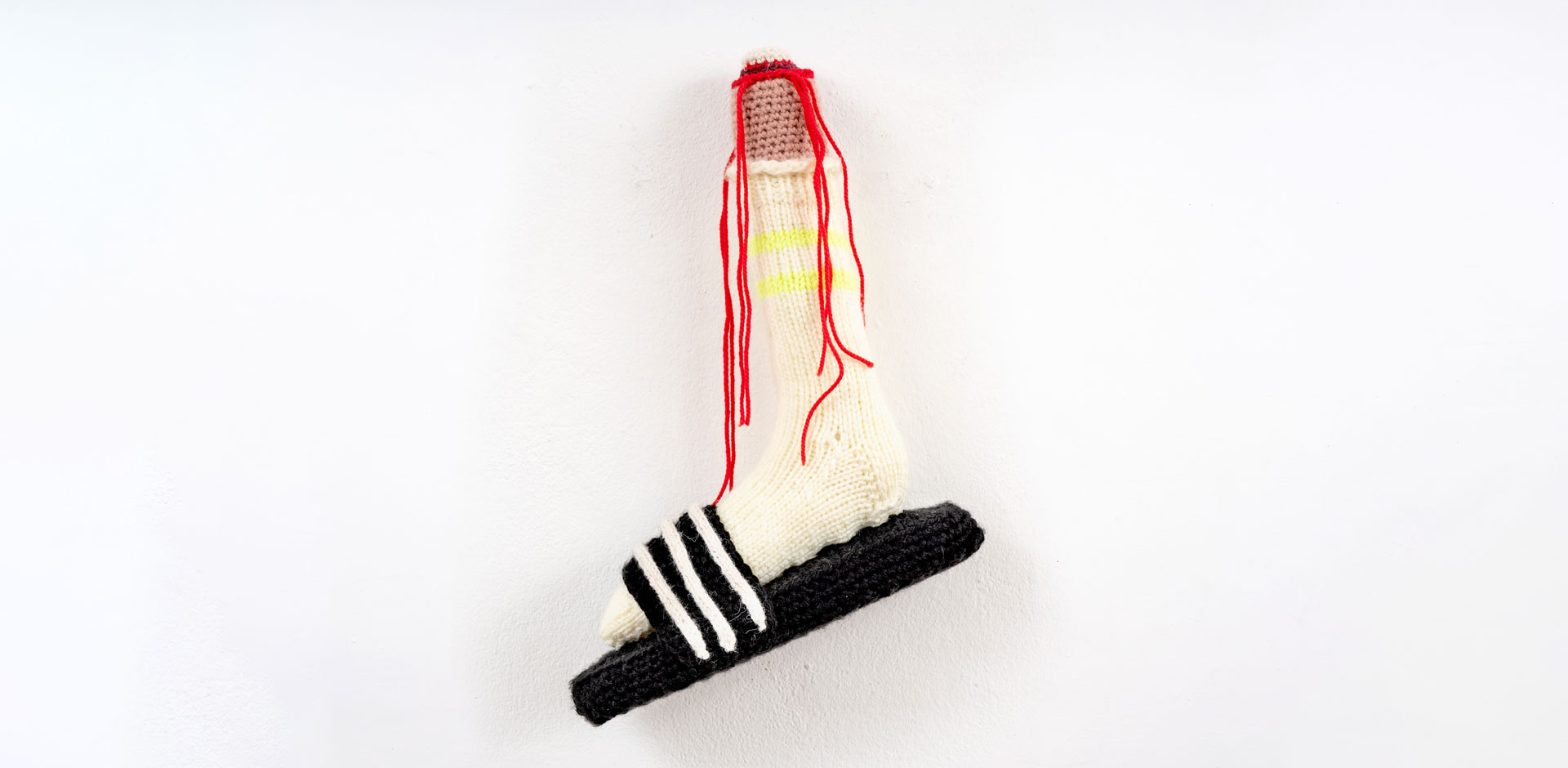
For her first exhibition at Weserhalle, Alexandra Müller (b. 1988, Rostock, Germany) presents OK COOL, a new body of work featuring a selection of vibrant multi-media wall hangings and knitted sculptures. Sitting somewhere between two- and three- dimensional art, OK COOL draws together Müller’s work as an illustrator with her interest in fibre arts and sculpture, developing her practice to include the craft skills taught to her by her grandmother, and which are often exempt from the world of fine art.
In this series, Müller concerns herself with the overlooked and undervalued. Unusual faces, unconventional materials, bizarre circumstances, and obsolete technologies make up the conceptual elements of her artistic practice. In particular, this is expressed as a motley crew of woollen heads, knitted from remnants of Müller’s personal projects, and which are positioned around the gallery in a show of exaggerated and unseemly human features. Each face is equally alluring and grotesque, both disturbing and relatable. Bulging eyes, elongated noses, lolling tongues, and twisted, grimacing mouths are softened by kaleidoscopic colours and Müller’s choice of materials: a mixture of felt, wool, and beads. The heads surround a knitted television (“Telly”), and a set of outdated remote controls, similarly reproduced in soft yarns and felts. One remote control reads “I don’t understand” in Russian across its buttons, another reads “DESTROY”. The uselessness of the technology, arbitrarily joined by wires and seemingly attached to nothing, creates space for speculation about their possible functions—what, exactly, can be controlled with a remote control?—and yet reduces them to trivial and ineffectual gadgets.
In sum, OK COOL is a delightfully frightening funhouse. Each pockmarked, germ-dripping face reveals an ambivalence between ugliness and beauty, while each woollen gadget acknowledges the absurdity of a world increasingly reliant on complex technologies. The cleverness of the exhibition rests in Müller’s skilful combination of the absurd, the melancholic, and the humorous, with humour working as a catalyst for understanding the intricacies of the human experience, giving a perspective on humanity that is at once lighthearted and sincere.
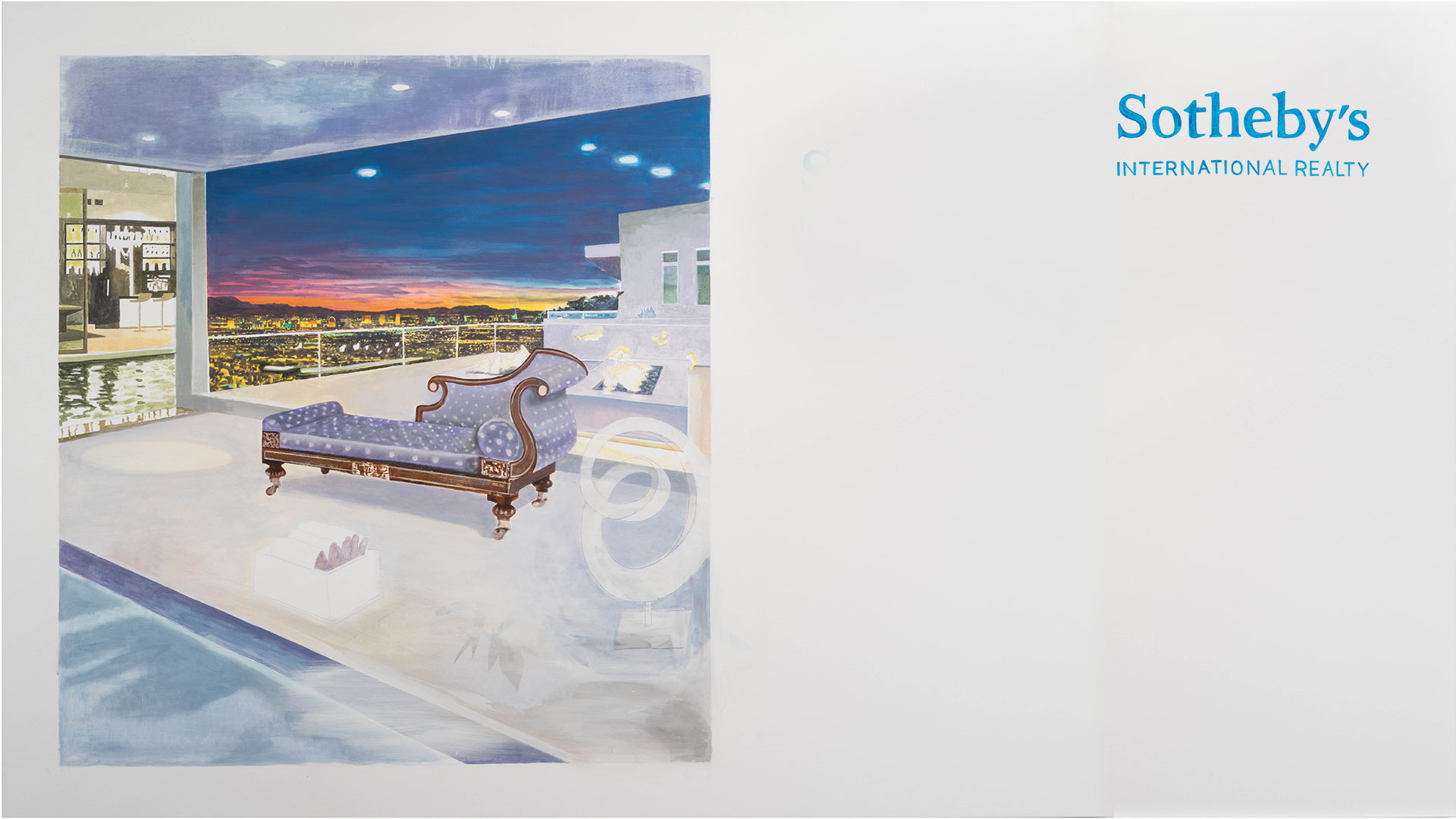
Curated by OWGallery: The SOTHEBY’S SERIES was created after a month long stay in Los Angeles and Las Vegas – a place where the perception of time, space and value of money quickly becomes blurred.
When passing by a Sotheby’s window in Santa Monica, California, the artist was surprised to find that the 1744 auction house not only sells fine arts, but also a range of luxury goods and real estate around the world. Wine, cars, property and even islands with a private landing strip are offered to “experienced buyers only” – with price upon request.
The story of Las Vegas, the rise of the gambling industry in the desert of Nevada, is one of organised crime. While hotels and casinos are suitably designed for visitors to have fun and forget the concept of time, something always seems off: Marmor facades that are made out of wood or cardboard, mirrors with a slimming effect, free drinks being served to casino guests once they take a seat in front of the gambling machine. Behind the decorative walls lies a dubious history. Similarly, the structures of the fine arts market also leave room for criminal involvement when transparency of cash flows is lacking.
The painting Sotheby’s (Bel Air) refers to the city of Beverly Hills in Los Angeles County, where the American mobster Benjamin “Bugsy” Siegel used to live. In 1945, when he moved from LA to Las Vegas, there were only two casinos. He bought one of them and converted it into the “Flamingo Hotel”. The money for this project came from the Sicilian Mafia, the ”Cosa Nostra”. Siegel tried to hide his income abroad. In 1947, he was murdered in his house in Beverly Hills.
The property in the painting Sotheby’s (Bel Air of Las Vegas) is based on pictures presented on Sotheby’s website, where it was listed for sale for 6,5 million USD in 2017. Influential people from the movie and music scene, such as Frank Sinatra, met here in the 1950’s-1960’s. Today, it is the property of singer Phyllis McGuires. She was the long-time girlfriend of Sam Giancana, a busy mafia boss in Las Vegas. There are many stories depicting high society’s involvement with the Mafia, not at least theories about the death of John F. Kennedy.
Sotheby’s also offers luxury houses that don’t even exist yet but that can be viewed as computer animation, offering the potential buyer the ability to curate their own dream houses. The picture Sotheby’s (Las Vegas) shows such a fictitious house with a view of the Las Vegas Strip.
It remains interesting to reflect on the motivation behind purchasing these luxury houses, islands, wines for 3.000 USD, painting for up to 450 million USD or a vase – found in the attic, then sold at the same price as the property of Phyllis McGuires. Everything can be bought or rented today, like the apartment in the painting Sotheby’s (Hollywood). The apartment is not finished yet – but you know you will have the Las Vegas Strip right at your doorstep.
Markus Liehr (born 1984, Berlin) is a German artist living and working in Leipzig and Berlin. Using painting as his main medium, Liehr has in recent years focused on examining unfamiliar environments and cultures, addressing the concepts of illusion and reality in these specific places.
Visiting the unfamiliar, however prepared and “knowledgeable” about the place through internet research and media access, Liehr explores what is the expected and what is the real; contrasting progress and regress, as well as themes on value and consumption.
Liehr studied painting at the Academy of Visual Arts Leipzig, Germany, amongst others in the class of Neo Rauch and Matthias Weischer, graduating in 2012 in the masterclass of Heribert C. Ottersbach. He also spent one semester of his studies at Universidad del Pais Vasco, Bilbao, Spain. During and upon his graduation, Liehr has exhibited at numerous solo and group shows internationally, including New Now Art Space, Frankfurt and Kunsthalle der Sparkasse, Leipzig in 2019; Eigen+Art Lab, Berlin (2018) and Raum 3000, Bozen, Italy (2017). In 2018, Liehr participated in the Artist in Residence Program at APX and Eigen+Art Lab in Berlin.
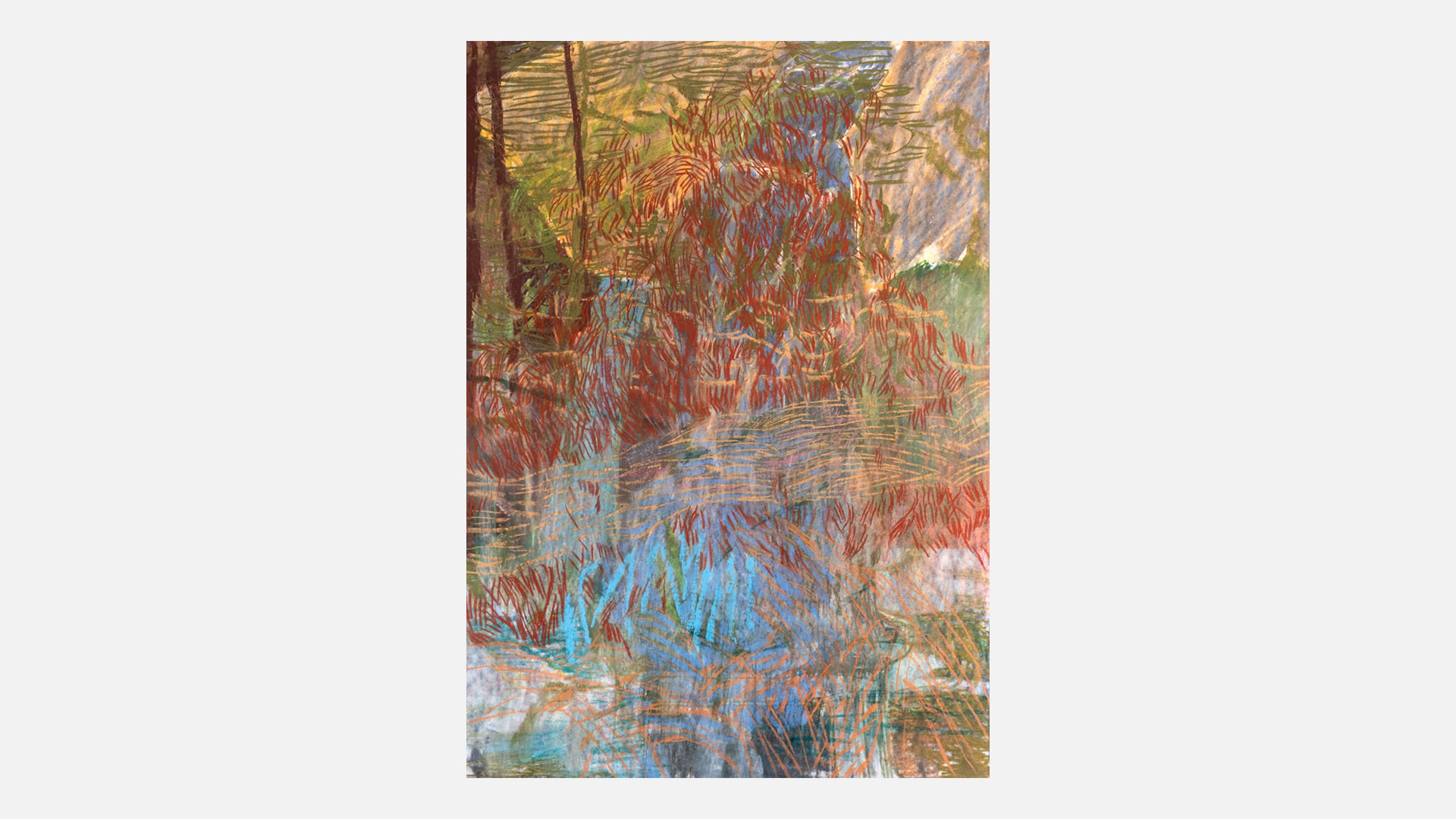
“It was possibly one of the oldest roads in the world. I found it hard to think of a time when there was no road there because the trees and the tall hills and the fine views of bogland had been arranged by wise hands for the pleasing picture they made when looked at from the road. Without a road to have them looked at from they would have a somewhat aimless if not a futile aspect.“ (The Third Policeman, Flann O´Brien)
The idea of a ‘beautiful nature’ is determined by nature’s relation to culture. From a human perspective, the natural world forms a perfect counterpart to civilisation: raw, uncorrupted and sublime. Yet, a landscape (or, beautiful nature) cannot exist without first being observed. As a cohesive entity, nature is formed when it meets contemplation, even if it is considered primordially wild and beautiful. Though the concept of nature is culturally determined, there is a paradoxical human desire for the natural world to be untamed and untouched, symbolising everything that is not human-made, artificial or technological. The natural world is suspended in opposition to human life, and yet this notion is entirely constructed by human thought.
Anna Gille’s exhibition „All of nature unspoiled – beautiful – beautiful“ is a collection of drawings from her ongoing project WINDOW, in which she examines both real and virtual landscapes. Gille’s drawings are based on images of physically existing landscapes—gardens, parks, forests and wastelands—as well as screenshots of virtual landscapes found in computer games or 3D simulations. She draws as well from memories of a childhood spent in the fields and forests surrounding Berlin. At first glance, the landscapes cannot be clearly located, and most are horizonless and abstract. Through her work, Gille attempts to open up an immersive space in which natural phenomena and human-made objects dissolve into surfaces and patterns, collapsing the false dichotomy she observes between humankind and nature, the built and the natural. A garden, she surmises, is as much a fabricated environment—arranged as a work of art—as it is naturally occurring. It is both as fictitious and as real as virtual space. By the same token, a digitally rendered landscape can be an imitation of nature par excellence, and for this reason Gille challenges its implicit artificiality. In WINDOW, Gille’s evocative illustrations explore the liminal space between the natural and the artificial, emphasising what is to be found in the blurred boundaries between built and natural environments, and between the ‘real’ and the ‘virtual’. As a whole, the series ultimately works to find natural beauty in unexpected places.
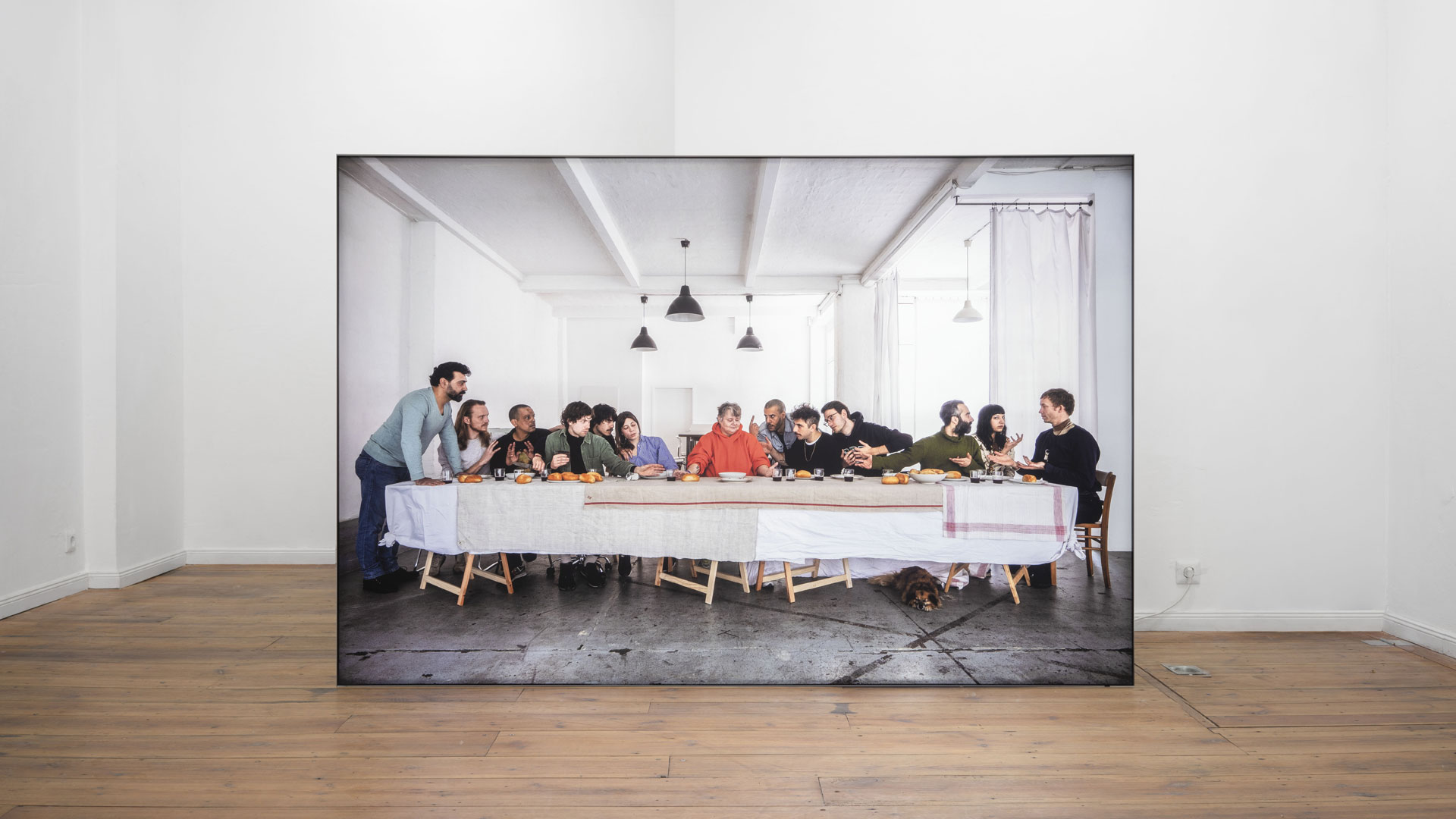
The configuration is universally familiar: in the centre sits a figure, eyes downcast, arms open in the sturdy form of a triangle. To the left and right, many gesturing hands vie for attention, while the figures to which the hands belong are positioned along the far side of a long table, variously seated and standing in heated tableaux. The Last Supper is one of the most recognisable works of Western art, rendered as an allegory of betrayal, greed and forgiveness. Its ubiquity in the West plants it firmly in our collective cultural imaginary, yet its familiarity in the contemporary era owes not necessarily to Da Vinci’s masterful original, painted in the late 15th century on the walls of the Santa Maria delle Grazie, but to the work’s consistent and continual reproduction well into the 21st.
For his inaugural exhibition at Weserhalle, Ashkan Sahihi draws on this widely recognised—and invariably replicated—symbol of Western culture. His interest rests predominantly at the level of reproduction, and certainly, The Last Supper has been reproduced, referenced, appropriated and adapted innumerable times and in innumerable ways since its initial conception. Famously silk-printed by Warhol; re-staged and photographed by Adi Nes; used as a billboard ad to sell denim, a motley crew of ‘Last Supper’ knock-offs have spawned from the bonafide original, giving Sahihi cause to add his own rendition to the lot.
The Last Supper Weserstr. is a monolithic work. It stands solitary and immense within a bespoke illuminated frame, transforming Weserhalle’s shopfront gallery into the site of the infamous congregation. Here, Sahihi deliberately intertwines the artistic impulse to replicate with the Biblical motifs of trust and betrayal, finding particular resonance in the German term Nächstenliebe (or, love thy neighbour). In this work, residents of Neukölln supplant Da Vinci’s eponymous characters, and the fabled feast becomes localised to the neighbourhood streets. Viewed from a certain angle, one could easily mistake the scene for the ordinary theatrics of a dinner party; a gathering of neighbours par excellence. The point, however, is not simply to regurgitate canonical imagery. Instead, Sahihi draws attention to the mechanisms of contemporary visual culture, which endlessly reuse and recycle iconic images, and in effect he undermines the authority of the art institution by diluting its principle artwork. With allusions to neighbourliness, greed, trust and betrayal, Sahihi at once maintains links to the revered original, while cleverly broadening his scope to rearrange the work and imbue it with new meanings. In the case of The Last Supper Weserstr., Da Vinci’s picture has been stripped bare of its religious intent, replaced instead with a playfully regular setting, a ultimately conceding to the inherent reproducibility of visual culture.
Text: Sarah Messerschmidt
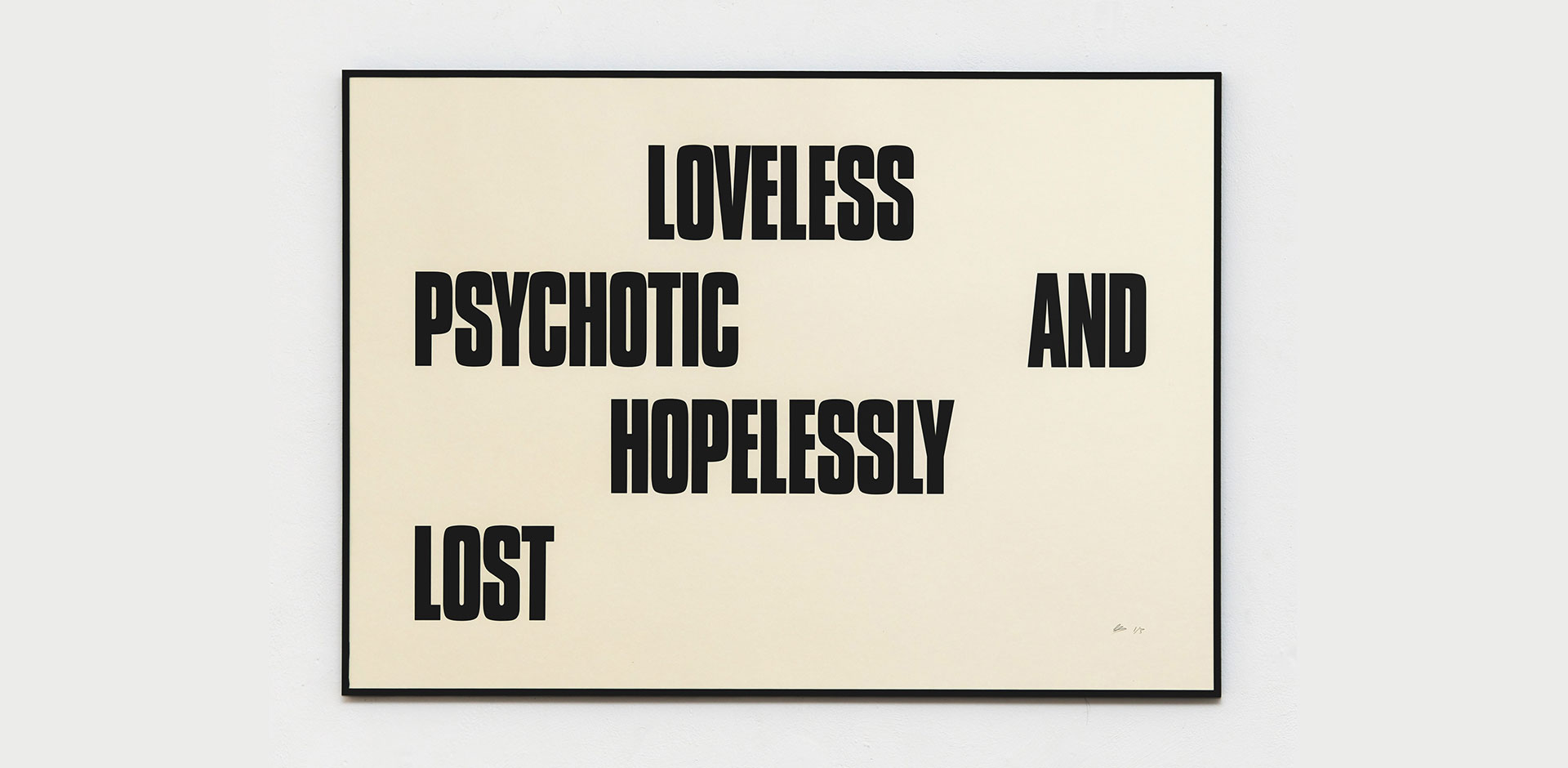
Brodie Kaman’s latest body of work, Fever Spiral, presents a small collection of screen and digital prints that focus on the interrelation between self reflection, fear and acceptance, a complex that has often motivated his work.
For this series, Kaman combines a DIY aesthetic with doggedly abstract graphics to create bold and experimental visual planes. With a nod to the American poet Franz Wright’s Alcohol (1998), Kaman mixes short poetic texts with illustration, meditating on his own struggles with substance addiction and mental health.
Kaman has spent considerable time in London, before recently settling in Berlin, and cites both places as useful backdrops to his artistic explorations of individual suffering and self-discovery. In his work, Kaman regards art and design as both a coping mechanism and creative outlet, necessary processes to his personal development.
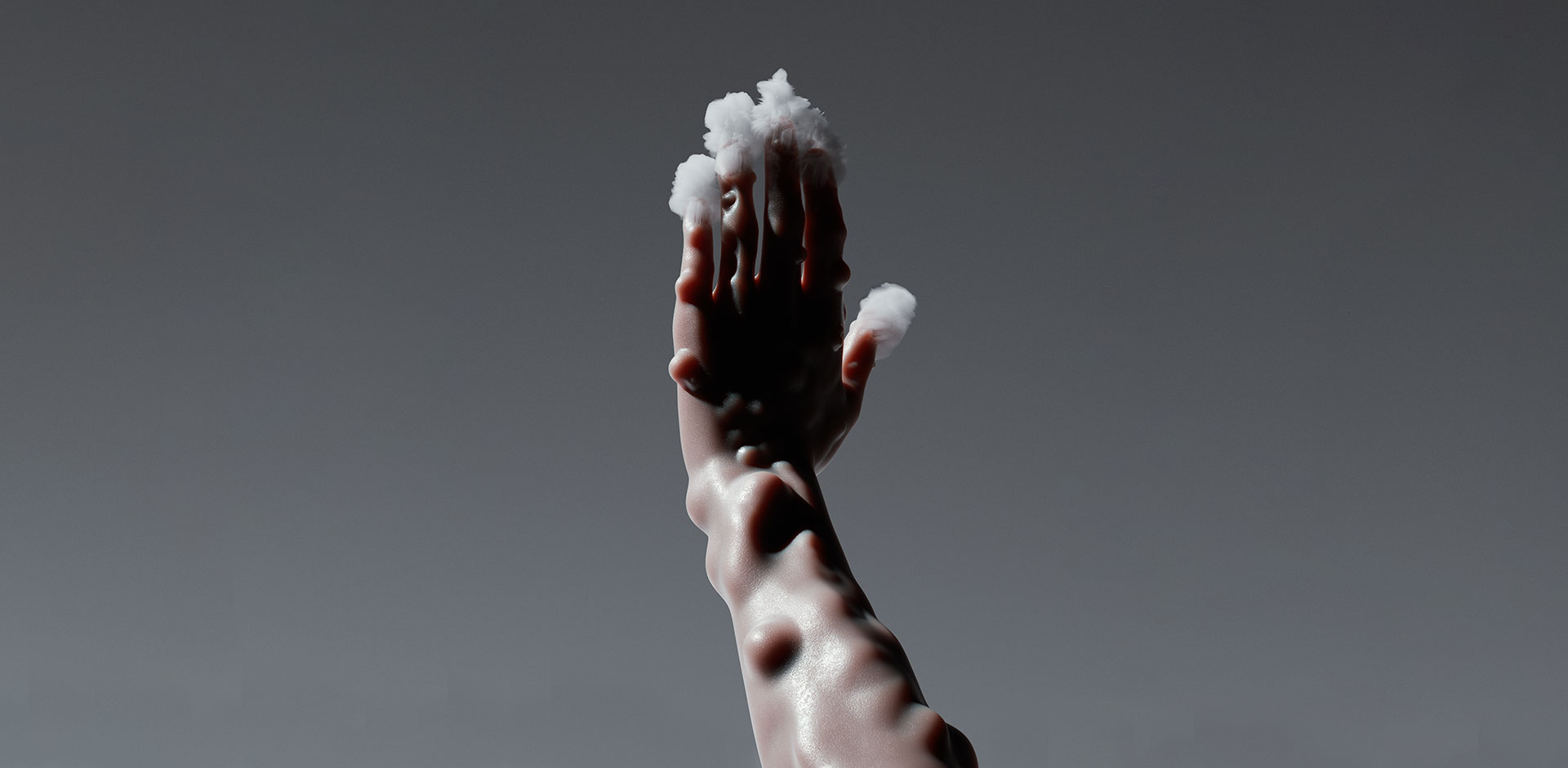
Developments in modern medicine have facilitated a fusion of the body and the technological, such that our collective understanding of what it means to be human is now, more than ever, uncertain. Humans and machines are engaged in a complex symbiotic relationship, with biomedical science at the helm of human-technological development. Where once medical sciences were a means of diagnosing disorder or illness, the practice now turns its attention to preventative and enhancement treatments; the ultimate goal is to unlock the greatest potential of the human form. We are in an era of Transhumanism, where the organic is supplanted by the synthetic, driven by a desire for total corporeal perfection.
Yet as medicine becomes increasingly focused on human enhancement, the technology it develops enters further and further into a global market, governed entirely by commerce, supply, demand, and accessibility. As a result, the body becomes a site of hyper-consumption; a commodity subject to the whims of private corporations who control the wellness industry, and who often threaten the values traditionally attributed to healthcare. In the age of advanced capitalism, health is no longer a human right, but instead another commodity we are compelled to consume. Likewise, the health and cosmetic industries bleed into one another, and our basic desires for wellness become compounded with our superficial desires for physical improvement.
Liam Sielski Waters’ exhibition Transient Bodies explores these constantly evolving definitions of the human. In a series of 3D renderings, he creates sumptuous worlds of uncanny biological forms and industrial constructions, inspired both by the fibrous tissue of organic matter and the functional aesthetics of medical design. His work is at once aesthetically deliberate and incidentally abstract. Using 3D imaging software, Waters generates an estimation for future forms, making reference to artists like Maxime Guyon, Magali Reus, Agatha Haines and Kate Cooper. Yet, by confining his renderings to images, Waters both provokes the urge to touch, and acknowledges the realities of health-consumerism, which simultaneously intensifies a desire for bodily experience, while making it all the more unobtainable. However, with an emphasis on ambiguity, Transient Bodies does not hold a strict agenda. It does not convey a strong position, nor does it aim to sway opinions. Instead, the exhibition hopes to inspire a conversation around the role of humans in a fluctuating world, in order to promote a more ethical and sustainable journey into an uncertain and transient future.
Liam S Waters
Selected to be one of the It’s Nice That Graduates of 2018, Liam Sielski Waters explores the blurring boundaries of the human identity in the age of technology and globalisation through the creation of photo-realistic 3D renderings, a digital process that in itself raises questions about the future of photography as a medium in light of new digital technology.
JJ Weihl (Discovery Zone)
Discovery Zone is New York born, Berlin based JJ Weihl (Fenster). Weihl Explores the relationship between pop music, sound collage and performance through ambient ceremonial laboratories created to spark an intimate connection.
Drawing upon her vast archive of field recordings, scientific documentary sound-bites, and musical oddities, Weihl will create a soundscape in response to the Transient Bodies exhibition
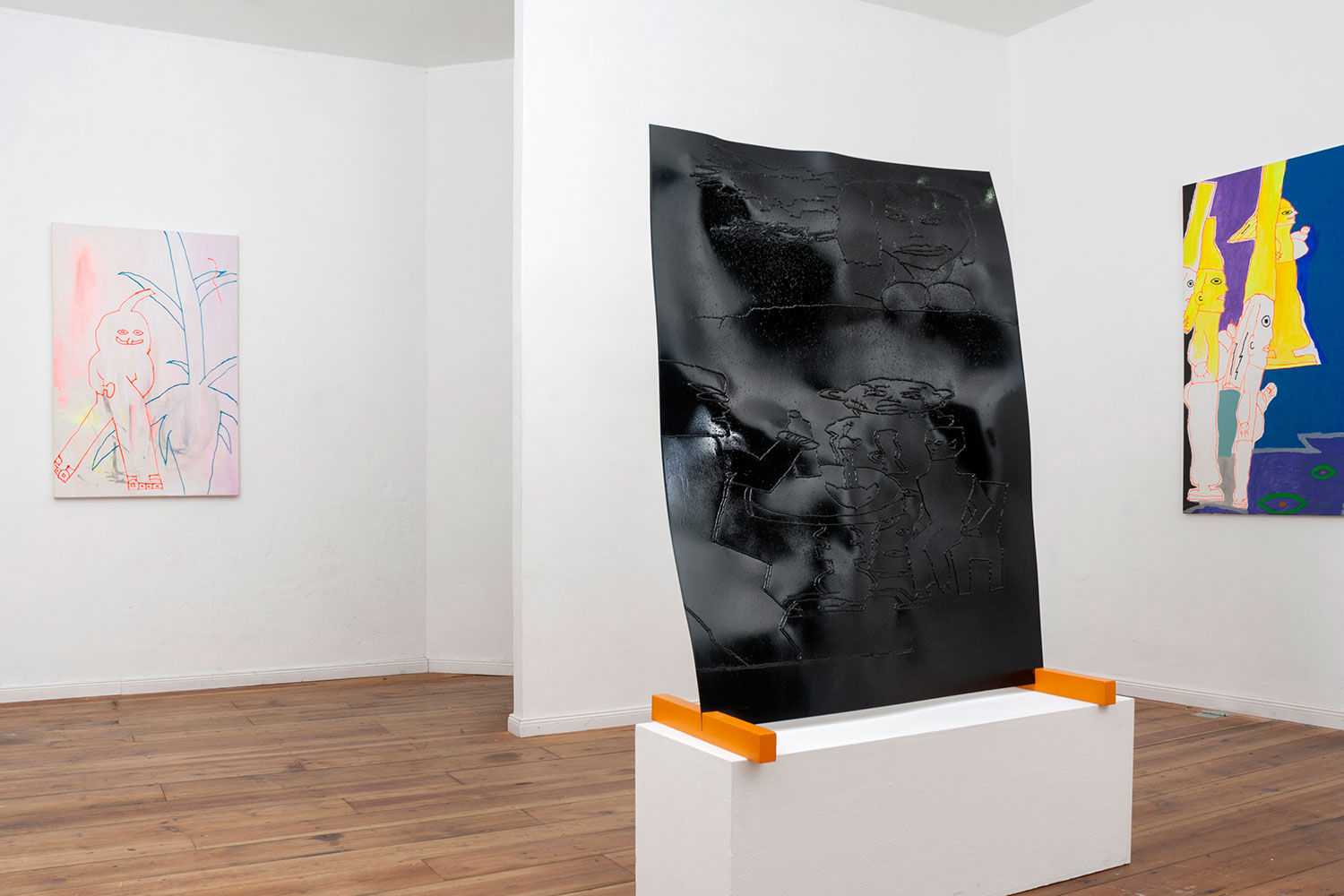
Paul Waak is happy to show you his work. Drawings, paintings and sculptures explore the radical bliss of today. Through a process of obsessive repetition, digital deformation and recombination Waak develops intuitive metaphors for existential truths. Fond memories and immediate intimacy, violence and innocence, the endless potential of what is yet to come.
Does this make you happy?
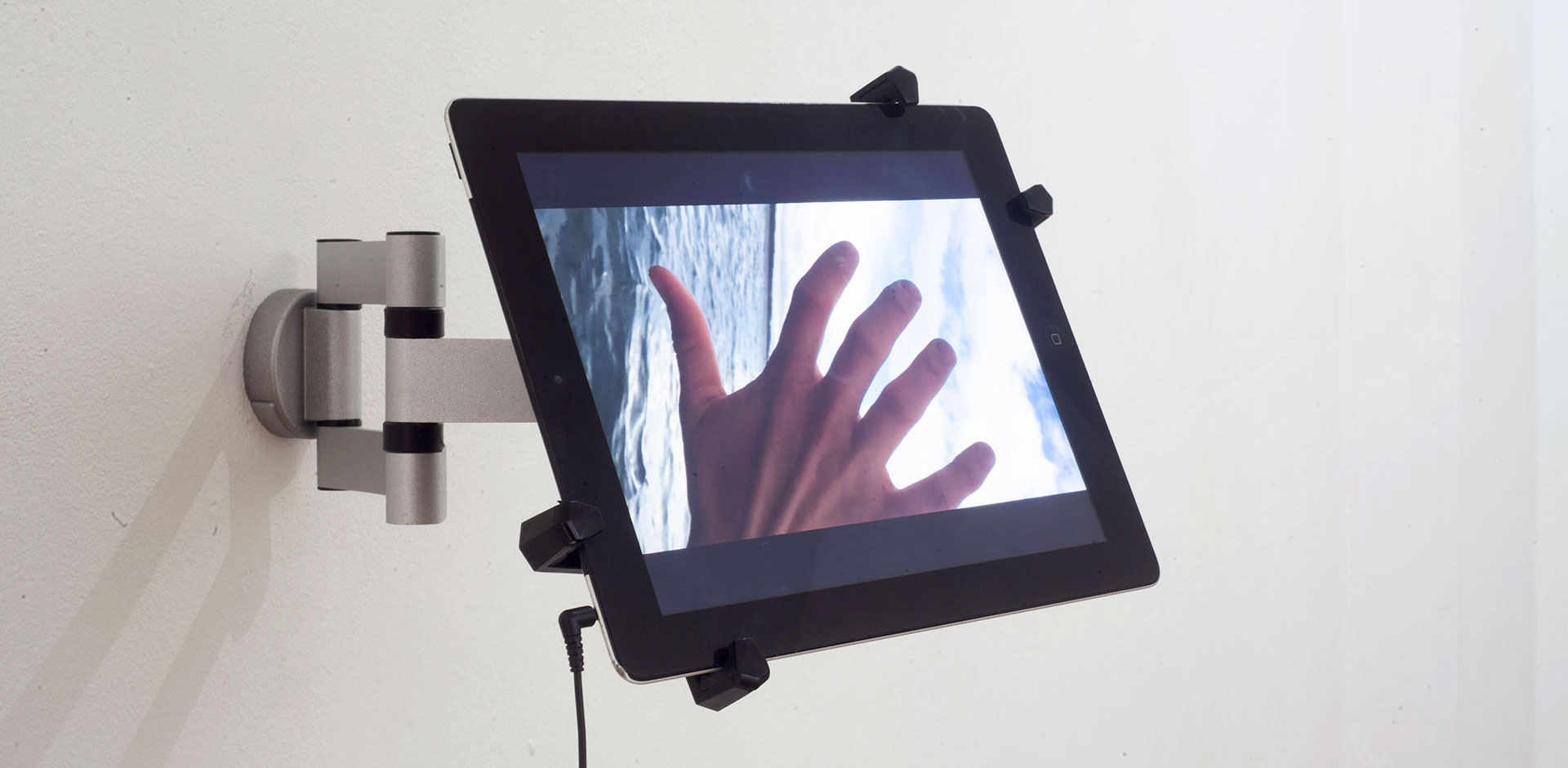
Now You See It, Now You Don’t brings together artists from Denmark, France, Israel and the UK in a group show where each selected artist presents a moment of critical reflection on the instability of the visible.
Jazbo Gross
Victoria Kaldan
Gal Leshem
Louise Madsen
Freddie Mason
Joseph Winter
Camille Yvert
A magic trick performed for a child. Now You See It, Now You Don’t. The repeated reference to the state of an object’s visibility, which our visual perception denies us no access to, seems to be a blatant statement of the obvious – a tautological moment between the worlds of sight and speech. We could write it off as mundane, and maybe it is, but perhaps it is somewhere between these two mundanities that we are supposed to catch sight of something.
In Merleau-Ponty’s unfinished work The Visible and The Invisible, he develops the concept of the intermundane. Here the viewer does not only receive the visible but is busy creating it in the act of looking. We are, he argues, made of that visible flesh on which our eyes feast. A contemporary phenomenon in visual culture might help shed some light on this idea.
Think of Netflix. The VOD service currently has 137 million subscribers worldwide, none of whom communicate with each other through their accounts. Netflix has gradually phased out active user input, getting rid of the five-star rating system in 2017 and user reviews in 2018. Instead, the Netflix algorithm gathers information on our viewing habits which it uses to figure out what to show us next. We don’t need to tell anyone our views. Our view is in and of itself speaking, taking part, being political. Every Netflix user is, simply by watching their favourite shows in the particular way that they watch them and at the specific times that they watch them, not only receiving culture but simultaneously creating it.
The way we look, our very gaze is complicit in negotiating the unstable state of the visible field. This thing in front of us – say a coin presented in a magic trick and by extension, any other object of our imagination – exists in multiple states of visibility at once which lump together to form our narratives of the visible and the invisible. These lumps are not solid. They are malleable. They are plastic.
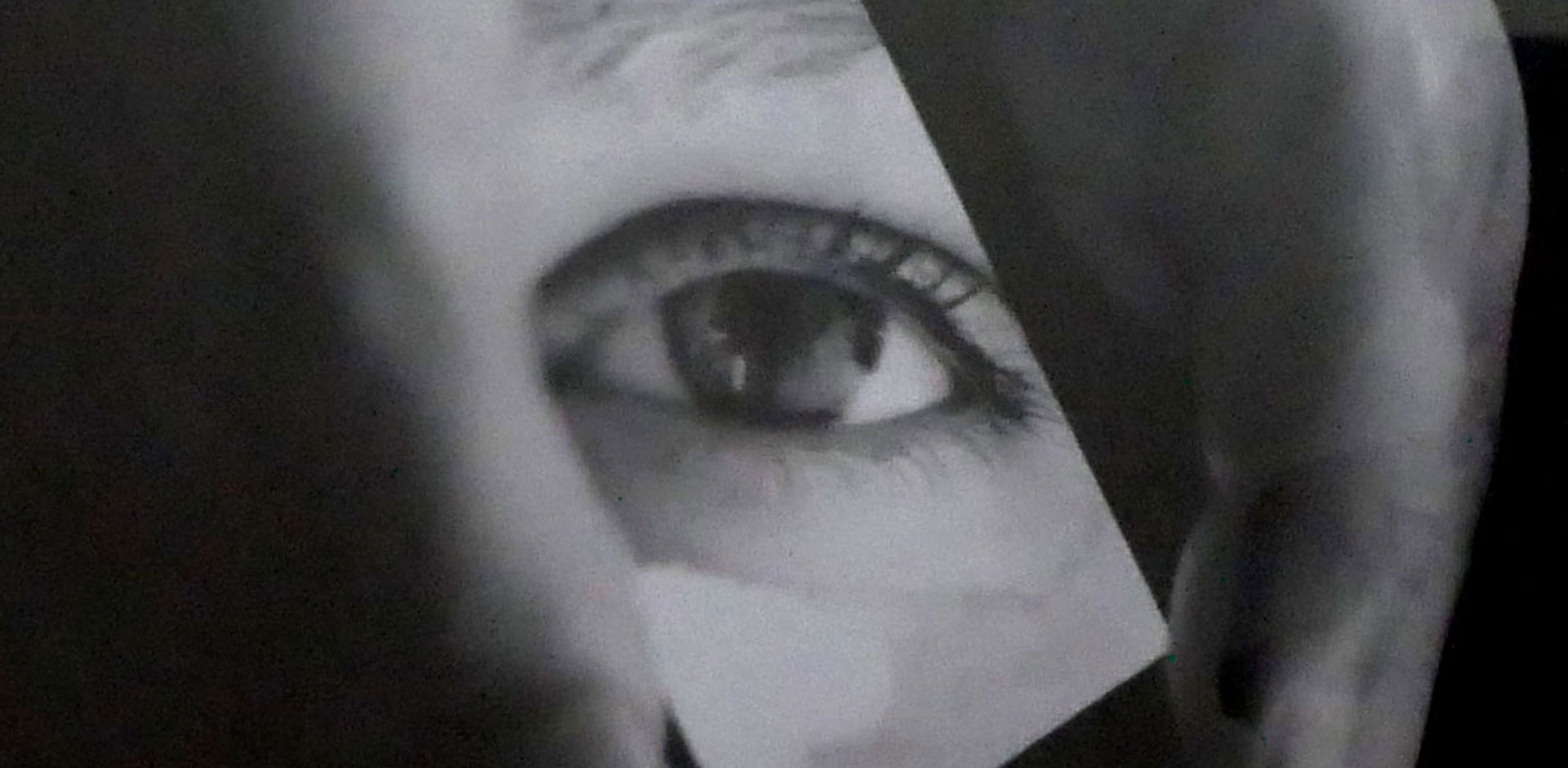
For the last show of the year, Weserhalle invites Dutch multidisciplinary artist BEA1991 to present a mix of her visual works produced under the alias “Softly John” – the character she embodies in photography. A gentle ex-geography teacher, John is balding wildly. Hair peeps out from his nostrils and ear holes. His body moves along with a comfortable old age. His trousers sag a bit. John doesn’t care about his appearance, but he cares about what he sees around him. He observes with grateful eyes, befriending the objects he encounters.
Weserhalle will become the space in which John presents his work, attaching findings to the wall as if looking for patterns, decoding a new language as the images blur together.
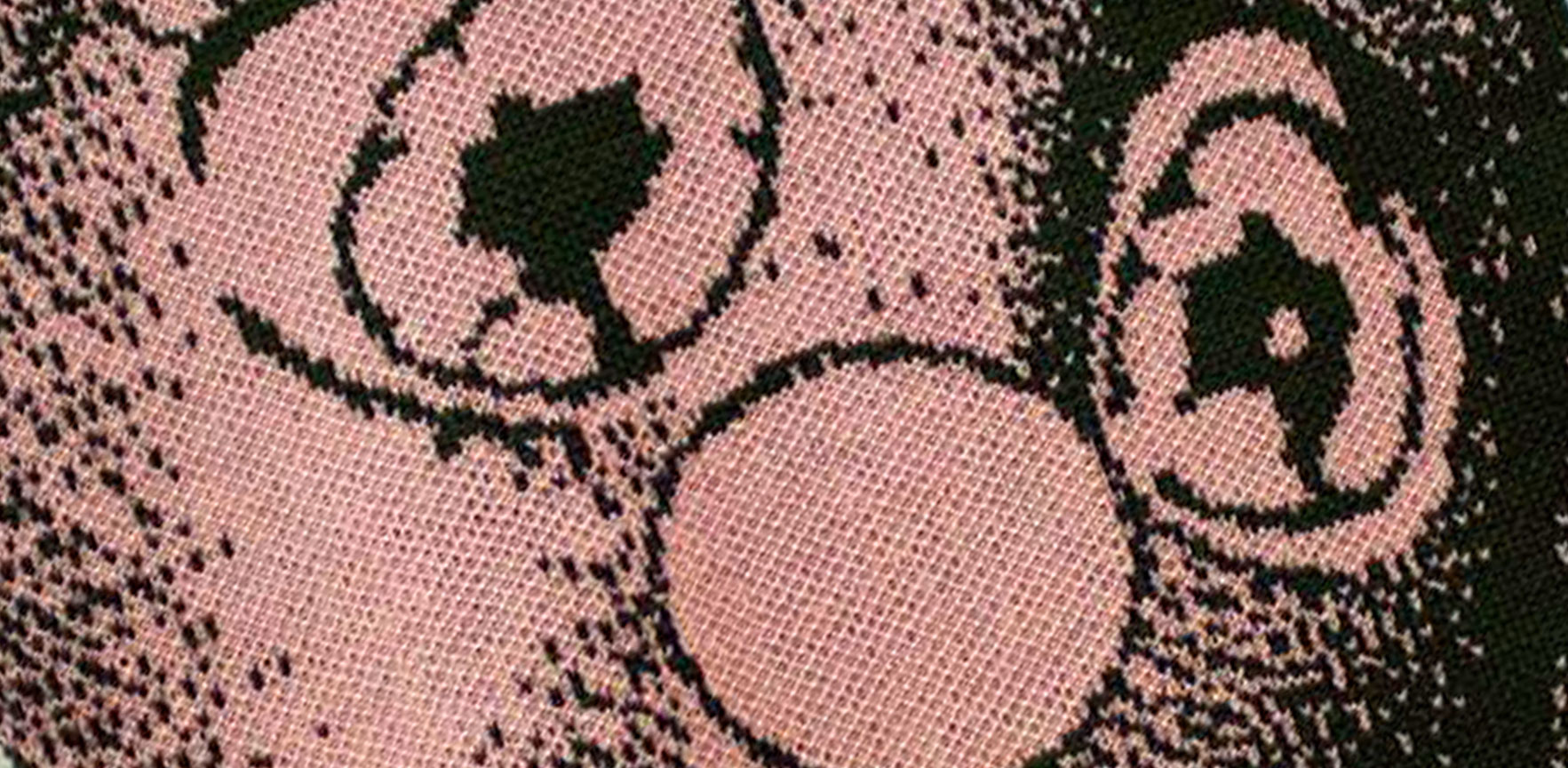
So do’st the moments make each day, and in turn 365 days do they make’th a year, what shall ye do with th’ne?
Proverb; are you ready to receive your new days? Soon, in the Weserhalle Gallery, polyvalent visual artists Adrienne Kammerer and Molly Dyson visualize the coming year (2019) in an exhibition and launch of a 2019 calendar.
We all know the gentle tug of time, the rigid Fordist structure measuring out each moment of every working hour, the gentle tug of father time to check his hands smoothly moving upon’st the clock, waiting a small precious moment for your phone and reveal what time she says to you. But whom in this very moment can say their time is just their own? As individual unique and beautiful cogs in the hyper-atomized neoliberal reality we inhabit, no moment is unknowable, incorruptible. In a micro subversion of capitalist hegemony Kammerer and Dyson have created a new style of personal calendar just for you and your time.
Using the Gregorian calendar as a framework, Kammerer and Dyson’s creations will nudge you through the seasons, cast predictions for the year to come (2019), and give a nod and a wink to the concept of time itself. Merging baroque and renaissance aesthetics with digital processes, this exhibition looks backwards and forwards at once, creating a closed loop of visual language.
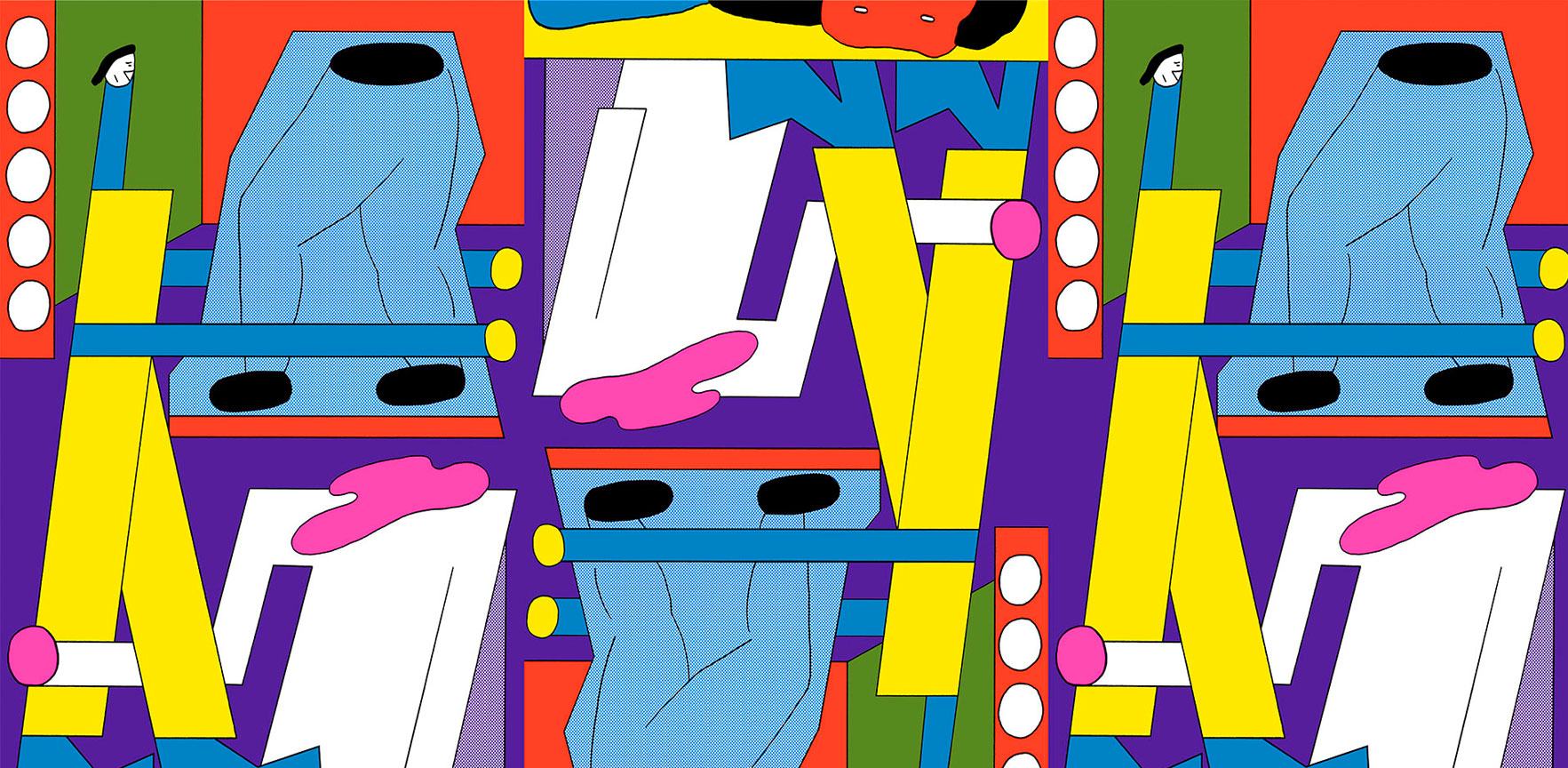
Palettes – “a thin board with curved edges and a hole for the thumb, used by artists to mix and place their paints on while they are working“. Bright, bold and balanced colors play a big role in the creative process and in the works of the Berlin based chinese artist Ruohan Wang and the german artist duo Zebu. On their palettes, they do not only place color, but also a rich vocabulary of forms, shapes, characters as well as experiences from travels and their own cultural heritages. A palette can be limiting, but it can also provide the opportunity to mix things up, to create space for collaboration. Weserhalle will be providing the space for Ruohan Wang and Zebu to create a show in which they both hope to expand their palettes through collaborating on a new body of work including paintings, screen prints, video and fabric.
“I am interested not only in the color palettes, but more the abstract and surreal world we imagine with soul-stirring colors.” Says Ruohan Wang.
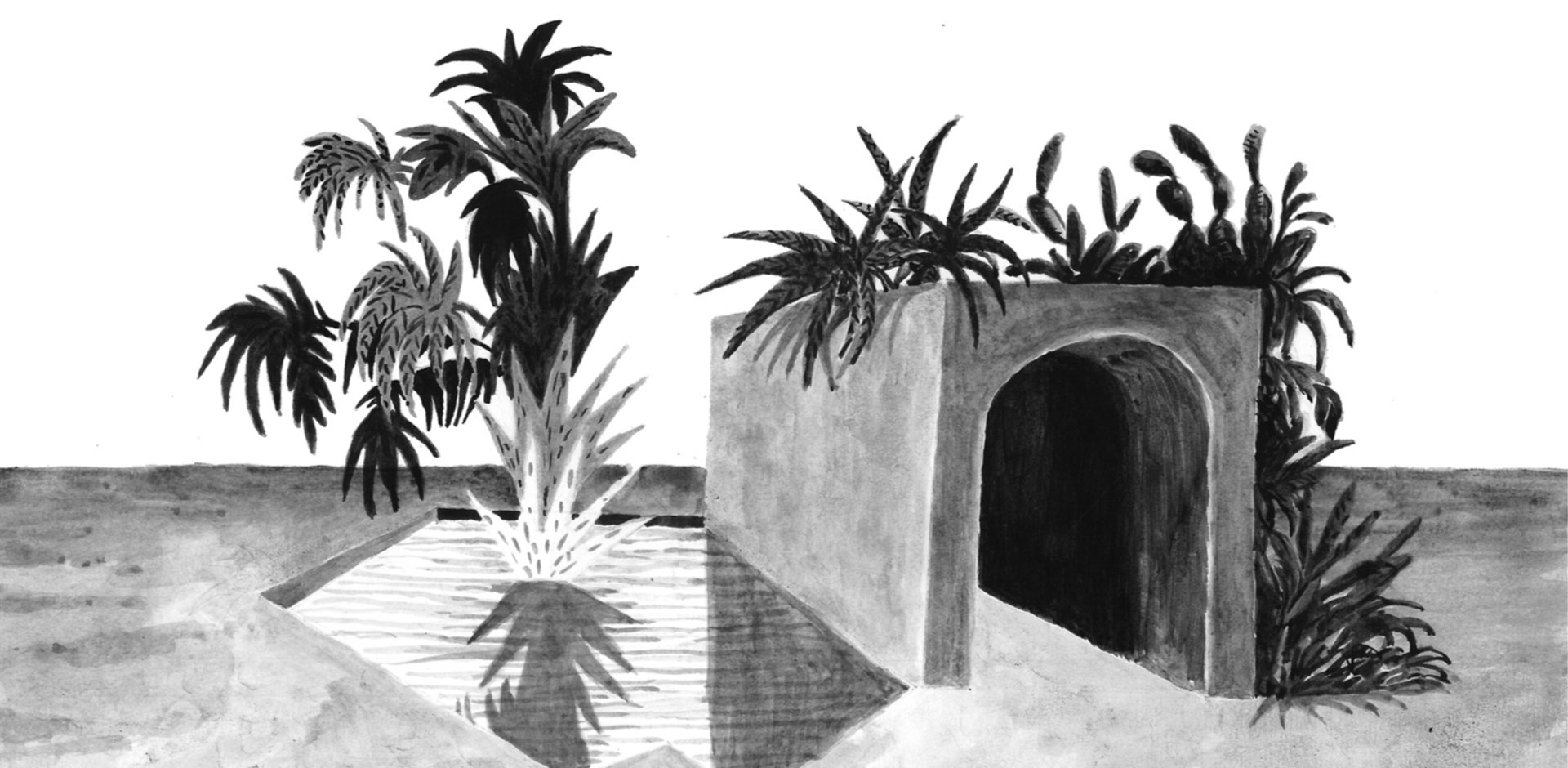
Born in the French Riviera, Yoann Pisterman is a visual artist and multi-instrumentalist composer. He studied a Master of Fine Art and of Business management in 2009.
Jardin (Garden) is a study of landscape architecture;
A series of visions and reflections acted on small format, Ink on paper.
A conversation taking place between floral elements and shades of grey.
Nature takes over architecture and human’s creations; reminding us of a permanent instability.
We perceive a melody floating around, an atmosphere, a place for meditation.
Nature is full of reminiscence.
Coming from a seed, it blooms and dies.
Again and again.
Time can stretch, but time cannot stop. Haunted by the dead.
We create a space, a territory to start a conversation of images and sounds.
It’s a grave.
But also a place to live, to laugh, to cry, to create, to leave thought, to remember stories.
The difference between nature and human, Is the garden
Guided by man’s hand, we try to understand the question of time and space.
You are here but not here.
Are you in the garden or are you dreaming about it ? How was it ? How will it become ?
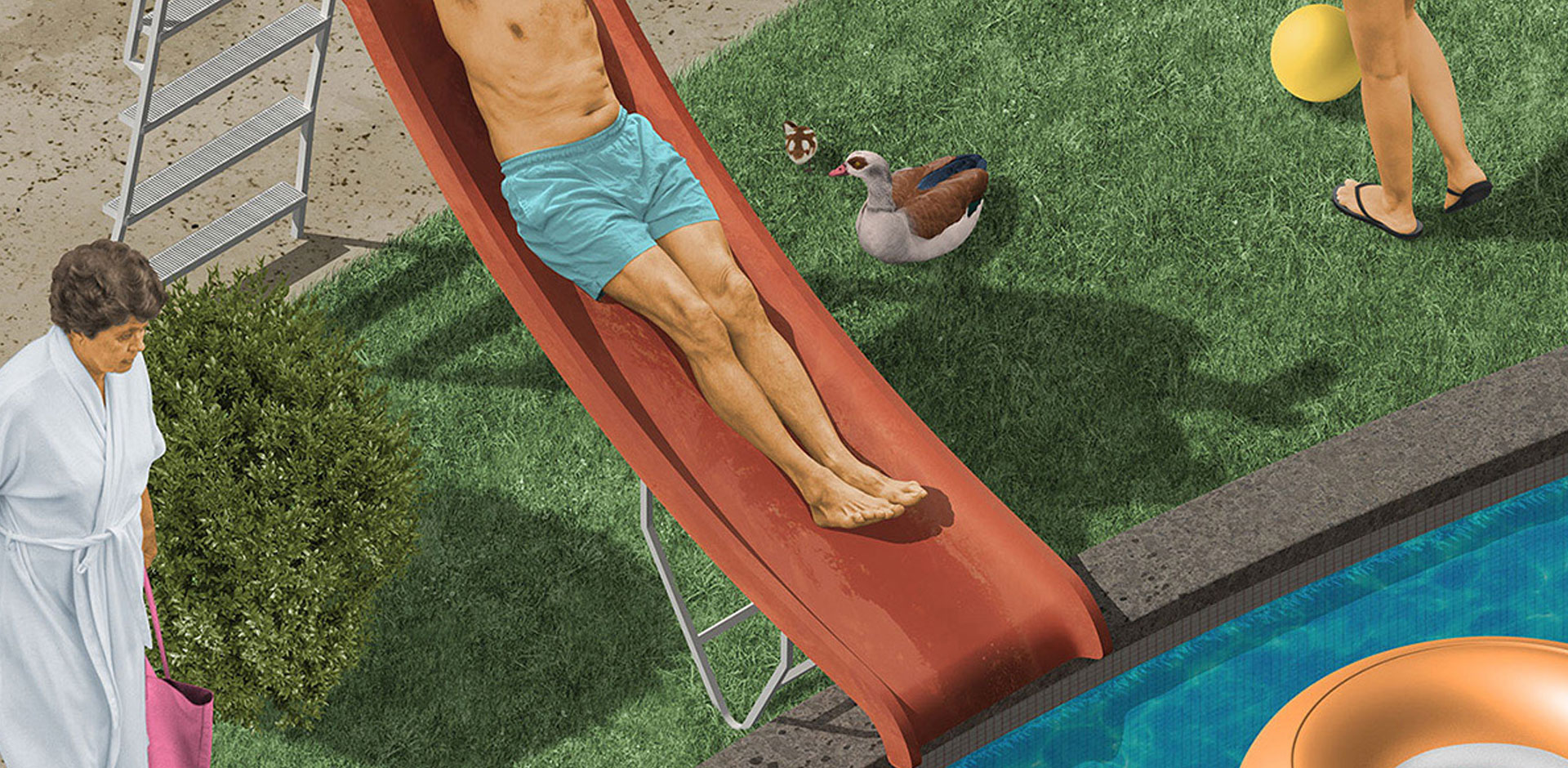
Max Guther is a 26 year old artist and illustrator based in Berlin, Germany. By combining photography and 3D generated forms Guther creates collaged images, which push the boundaries of digital illustration. In his images he portrays everyday scenes with a special focus on architectural details, interiors and their inhabitants. Textured to close detail these hyperreal worlds not only visualise social currents but sharply analyse the aesthetics and stereotypes of modern society.
Through the medium of prints, Max Guther’s first solo exhibition “Unlimited” at Weserhalle will provide a valuable insight into how his works have evolved over the last years – from simpler surreal structures, into the more complex, unfathomable landscapes he produces today.
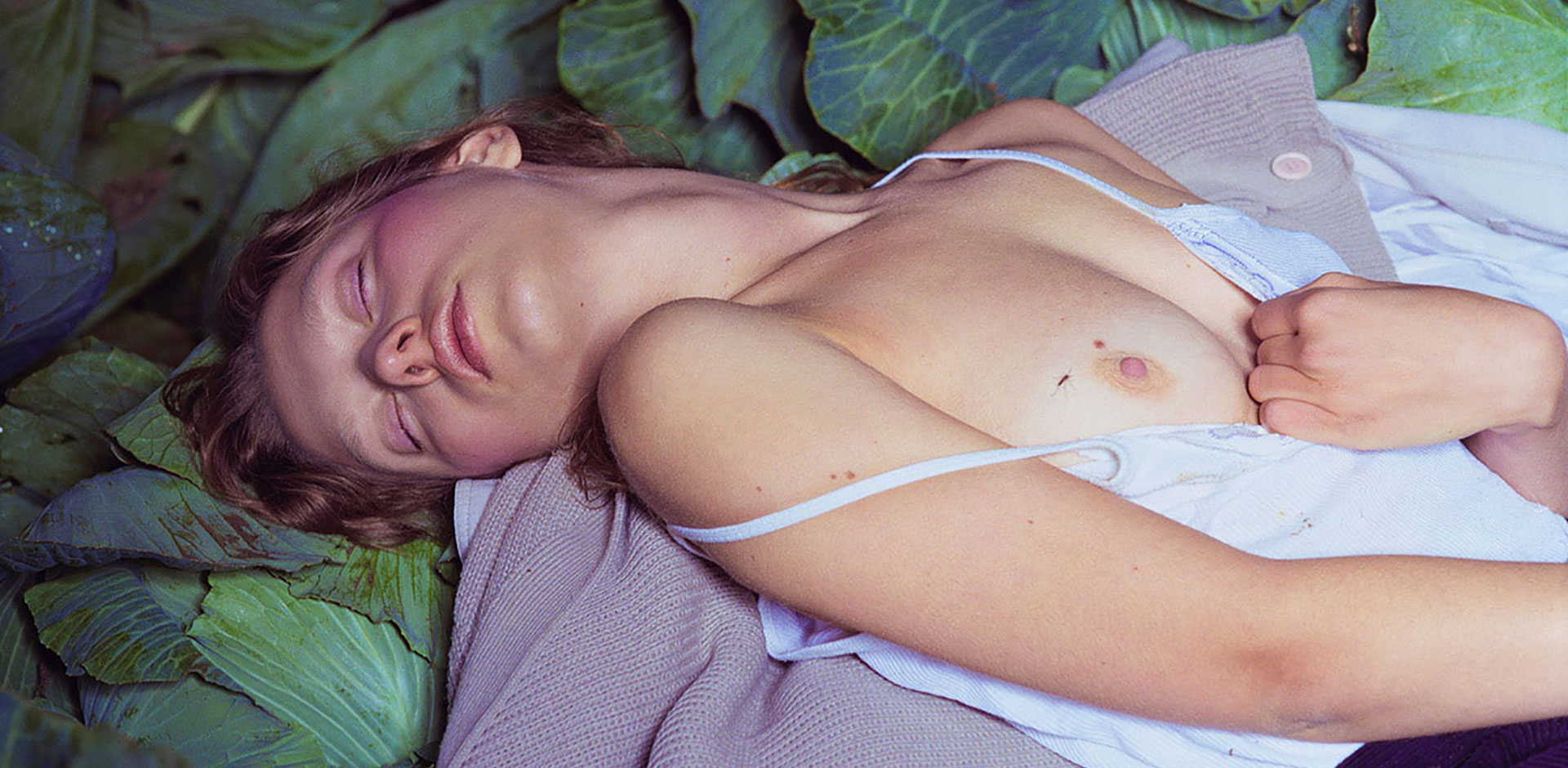
Joanna Szproch’s first solo exhibition in Berlin presents the culmination of her long-term project exploring the relationship with her muse, Patrycja.
@smilefomedaddy combines a knowing wink at our overtly public era of instagram, selfies, and digital photography on our phones, with what actually amounts to an extremely personal and private look at female friendship, youth and beauty, and the transition from naive sexuality through a series of photos of budding womanhood, into an unfolding and confident adulthood. Promiscuity, exhibitionism, intimacy, adventure, inspiration, and the classic muse and auteur relationship are propelled into the twenty-first century with a flood of fantastic and colorful images.
Joanna Szproch
Szproch (Warsaw, Poland, 1979) has developed her signature photographic style: a mixture of vulgarity and innocence, saturated colour and dowdiness, high technology and analogue, her images are a celebration of contrasts. The fluctuating boundary between old and young, adult and child, innocence and knowing are strong themes in Szproch’s artistic work and life.
Joanna Szproch teaches a seminar entitled “Art Direction and Photography” at HTK – Academy Of Design in Berlin.
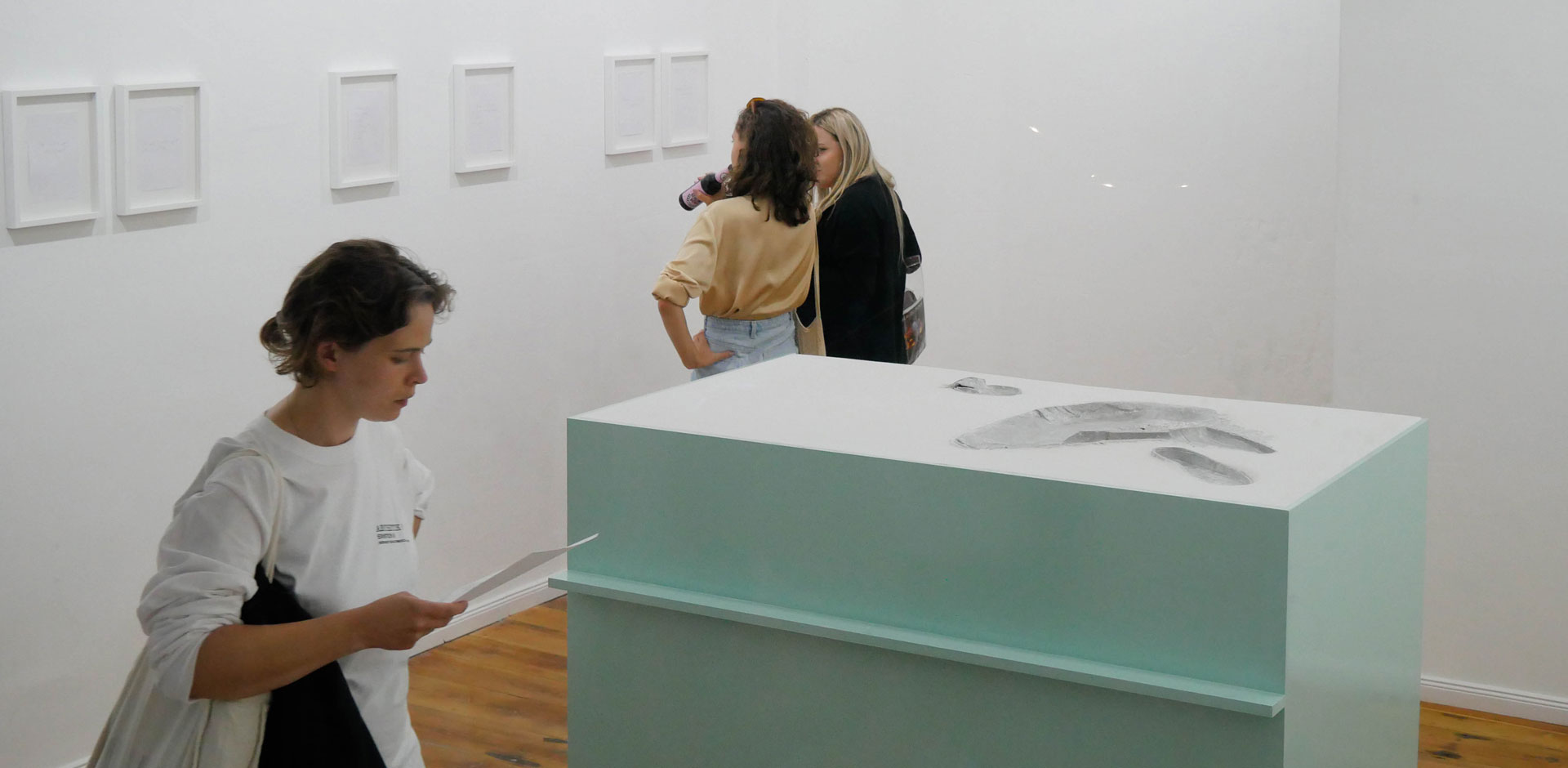
The Empowering Pose 01: Rude Receptionist is the start of a series of sculptures using poses to empower humans through simple stances. We are in an entrance hall. We find the receptionist table. But the receptionist is missing. How to identify a receptionist table by three simple characteristics:
1. The height of 115cm.
2. A small shelf to place your bag while waiting.
3. The back of the desk is open.
We start to observe the scenario and find the cast of her body sitting on the table. By this single action of leaving the chair and climbing on the table the receptionist has moved out of her role of being the perfect host. The sculpture serves as an activation tool to trigger their imagination. By seeing the negative cast we can imagine ourselves or the absent receptionist sitting on the table.
We will find a poem. Using short hand writing; the action becomes encrypted; the inner life of the receptionist remains private – thinking about it as the secret language of secretaries back in the days. She might have been thinking about starting a silent revolution by using short hand writing that can only be read by her female colleagues.
Lena Marie Emrich (* 1991, Göttingen) lives and works in Berlin. Her diverse practice combines sculpture, performance and the use of digitally related tools such as social platforms or found footage. Inspired by absurd interruptions of everyday rituals and the observation of social phenomena, she takes advantage of the historical and architectural circumstances of given spaces.
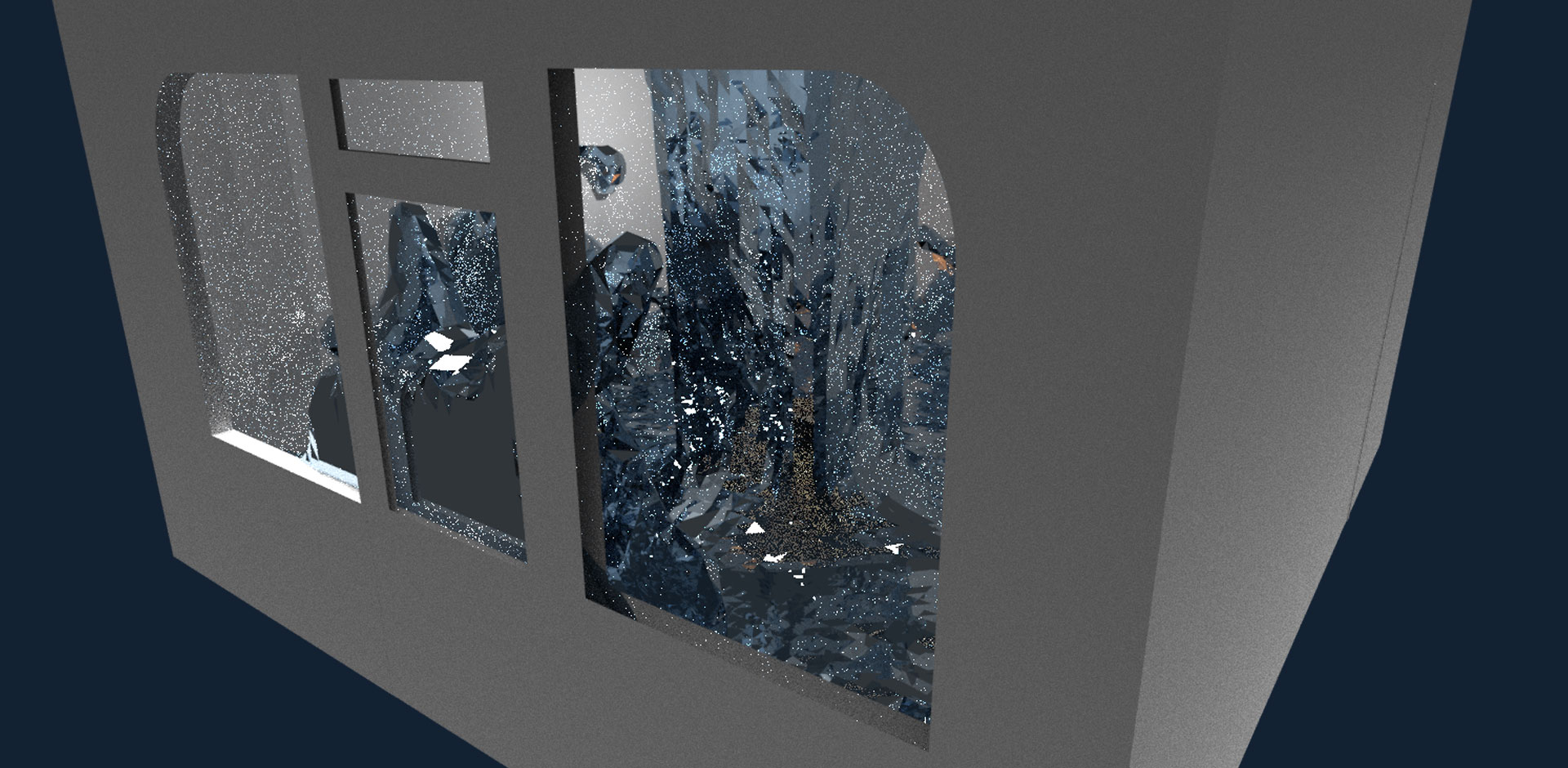
Inspired by the Japanese tradition of Suminagashi, an ancient technique of Japanese marbling that originated in the 12th century, Murphy’s Underwater Paintings apply the chance effects of ‘floating ink’ in a bath of water to create marbled patterns on large- scale canvasses.
The unique and highly visceral process of this method raises important questions regarding artistic authorship and the agency of matter, and how a non-anthropocentric relationship to the natural elements can be embraced through artistic practice.
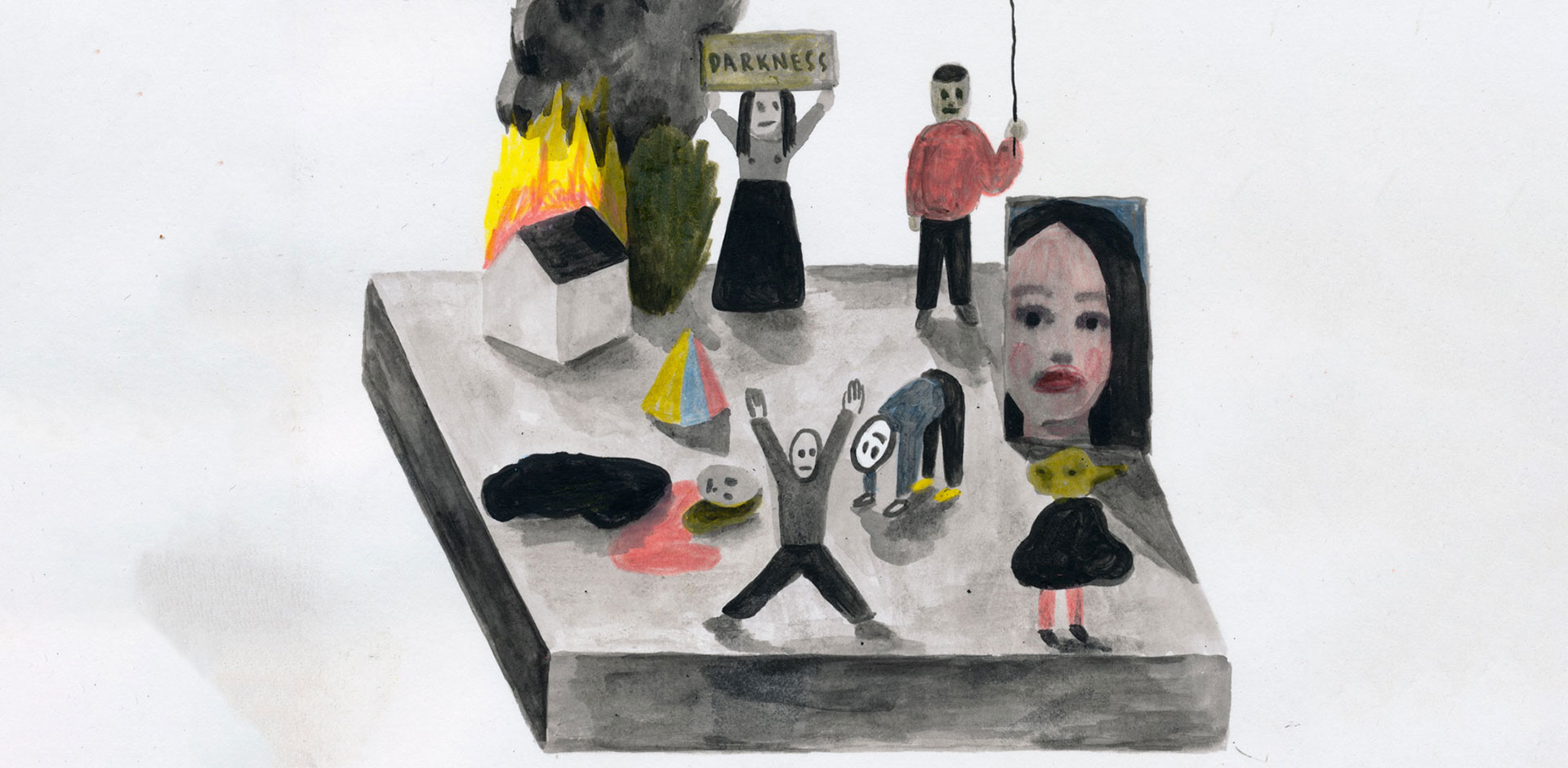
Who am i?
I am one painting a day.
The rest is society.
Process and persistence.
From nowhere to nothing.
The focus of this exhibition will be 365 paintings: an overload of daily impressions created over the span of 1 year, accompanied by recent related works.
Stephan Dybus is a visual artist based in Berlin. Born 1987 in Magdeburg to teenage parents, he failed to become part of a graffiti crew but managed to study visual communication at Burg Giebichenstein – University of Art and Design Halle. He loves to copy the artwork of his 6 year old daughter. He also likes to write poems. He just quit smoking again.
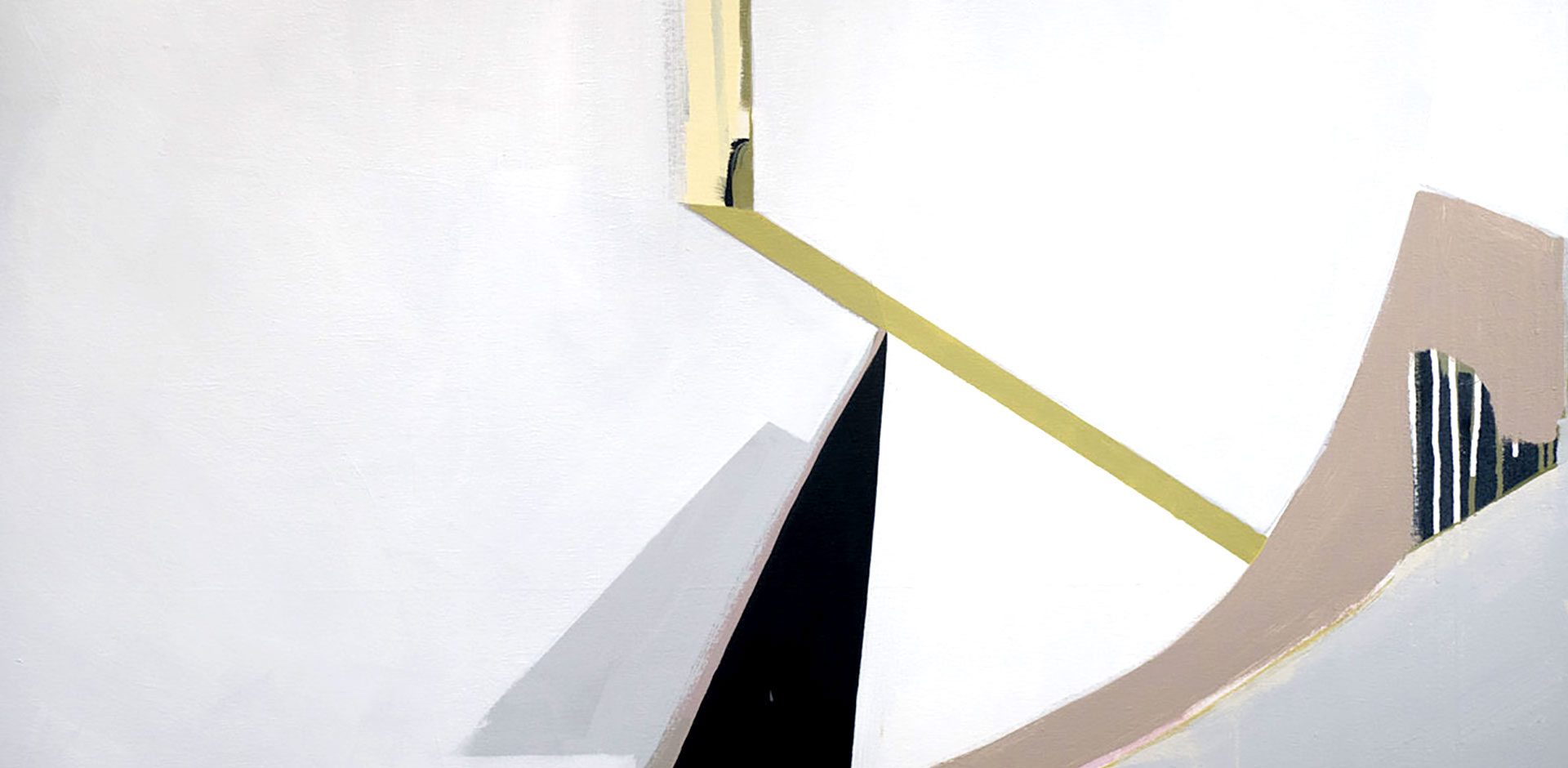
The Arrangement is a selection of new paintings made in Berlin at the cross over of Winter into Spring. The works are composed with a focus on line, form and elements of architecture. The dedication to providing space on the canvas allows painted forms to continually arrange themselves like objects as each layer of paint dissolves borders and moves the forms towards their absence. The resolved composition becomes a dichotomy of presence and absence, an abstraction of something glimpsed and remembered and filtered through the hand.
Anna Steele is a Melbourne-based artist currently working in Berlin.
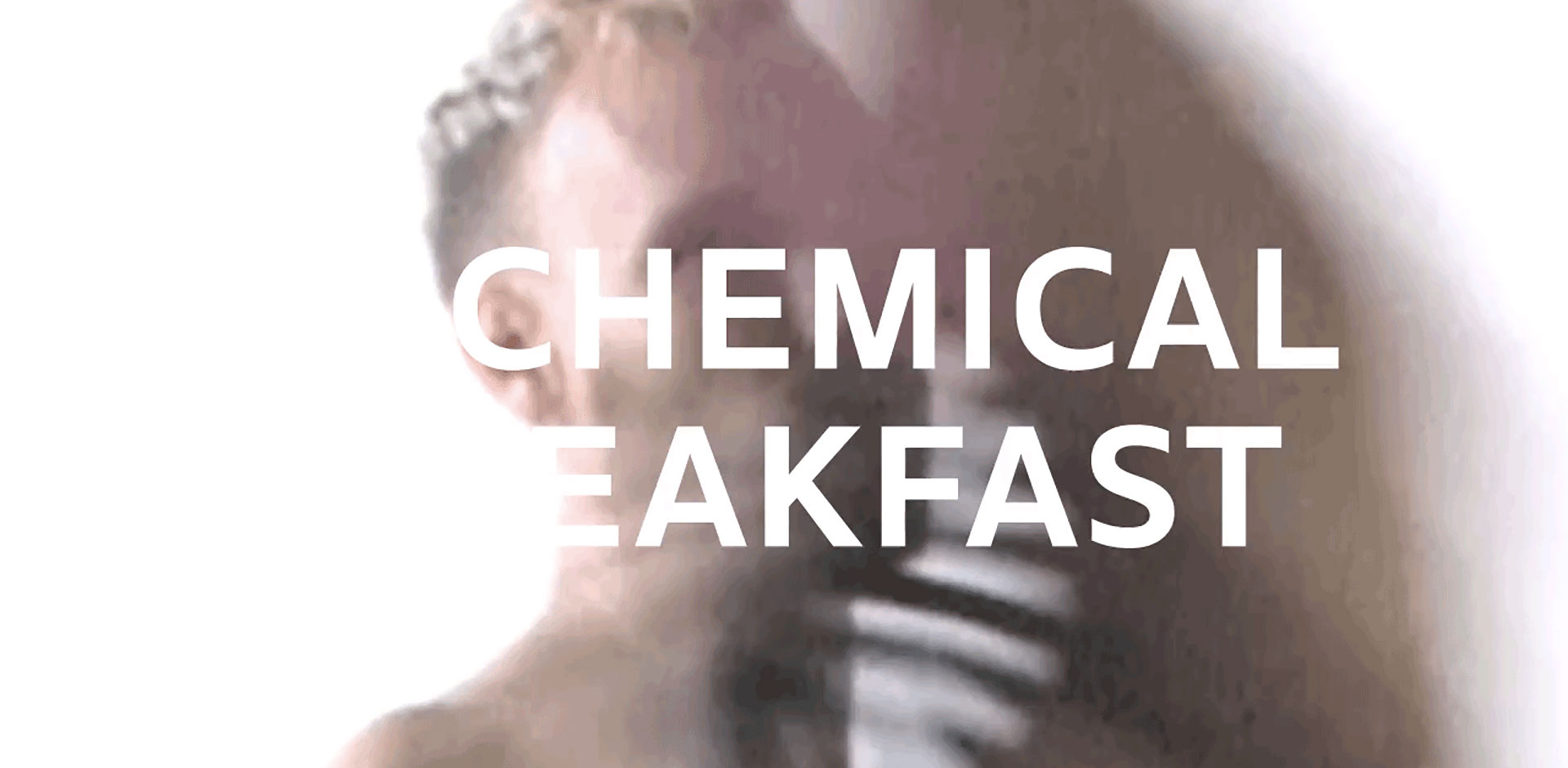
Alchemical Breakfast is Walker’s first video work, having worked for many years with photography and installation. It continues her interests in the nature of images, representations of gender and sexuality and the qualities of feminine accessories. The process of seeing and looking is central to this mischievous work, which simultaneously seduces and confuses its audience
Berlin based, Lyndal Walker is from Melbourne and has a career spanning twenty years. In 2017 she had solo exhibitions at Berlin’s Künstlerhaus Bethanien, where she was a resident and Hangmen Projects in Stockholm. Her work is currently exhibited in Unfinished Business at The Australian Centre for Contemporary Art.
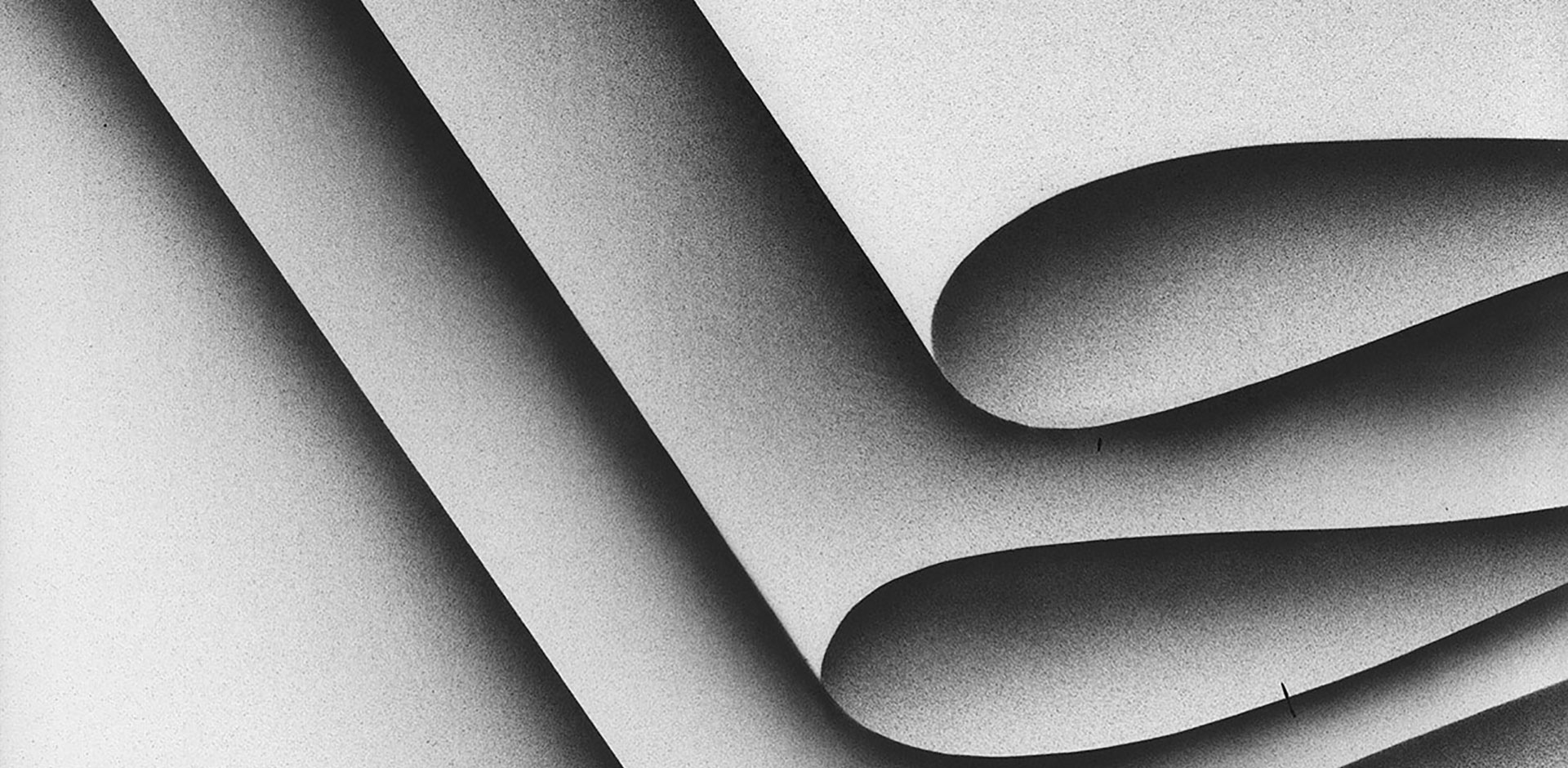
Lasse, Born in Lübeck, Northern Germany, currently resides in Berlin as an illustrator, animator and comic artist. “There are no clear stories being told, no punchlines or cliffhangers, but the pictures can be read as something coherent, the reading experience being closer to that of a poem. The works are drawings in pencil and coloured pencil, media that don’t allow for much correction. The process of drawing leaves behind traces that communicate my direct and intuitive approach to the pictures.
Originally from South Korea, Jeong currently lives and works in Gerswalde as an illustrator and painter. She tells abstract and geometric stories from the physical world and the world of objects. Jeong experiments with airbrush painting, stencils, and unique book-binding techniques. Weserhalle will exhibit a part of Jeong’s Horizon series; an experiment with airbrush, straight lines and curves of light, shadow and forms.
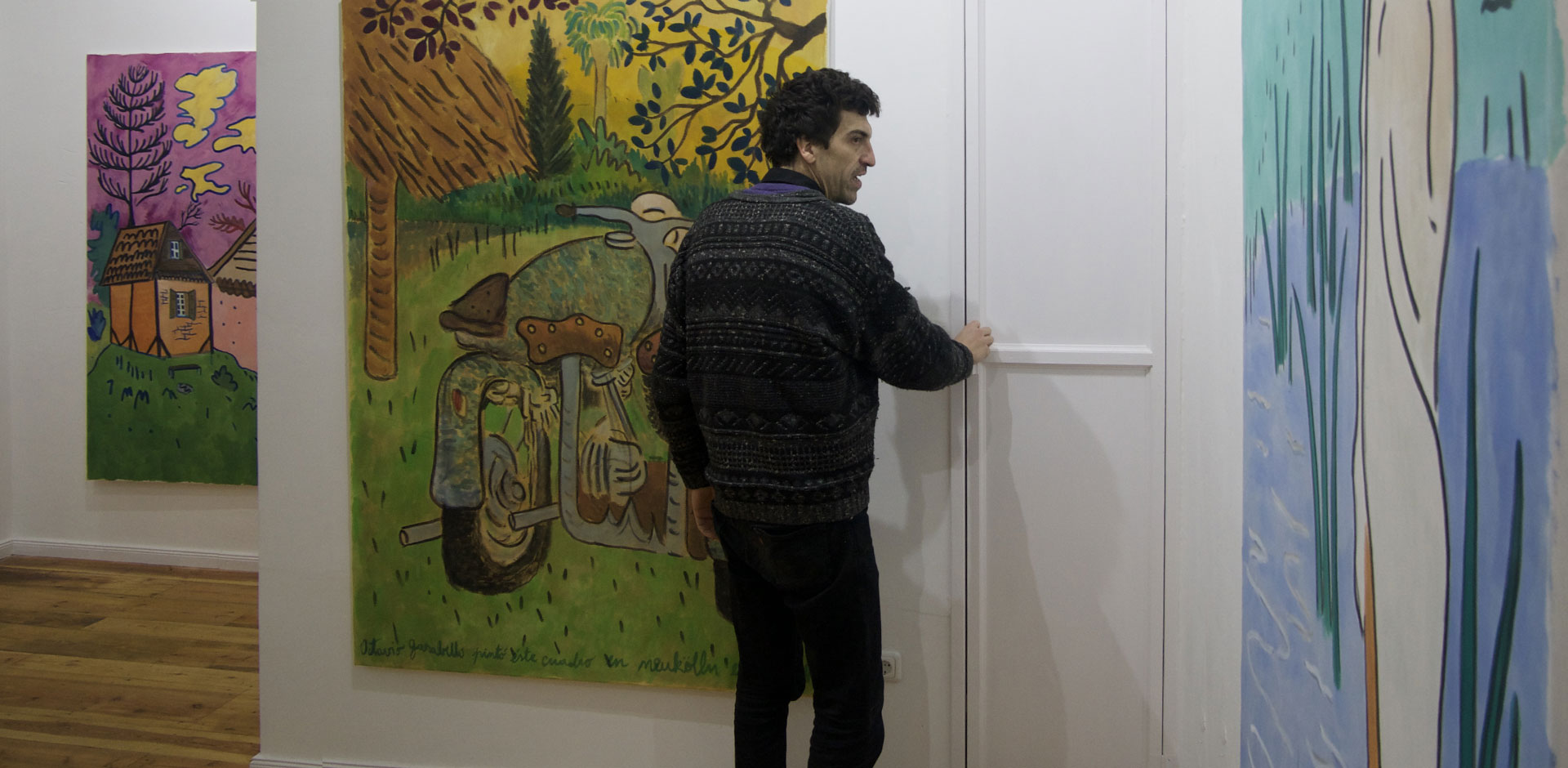
Octavio Garabello is constantly capturing moments in his sketchbook, whatever time, place or situation he encounters.
He uses these drawings to trigger the emotions of the past, bringing this into the present with bold colours creating a new interpretation of a memory.
In this series, he brings us a selection of his latest large scale paintings guided by a handful of loose lines sketched in the woods of Vilnius: A 3 day experience of kaleidoscopic moments with freaky people and music.
You can view the documentary film WEEKEND IN LITHUANIA here.
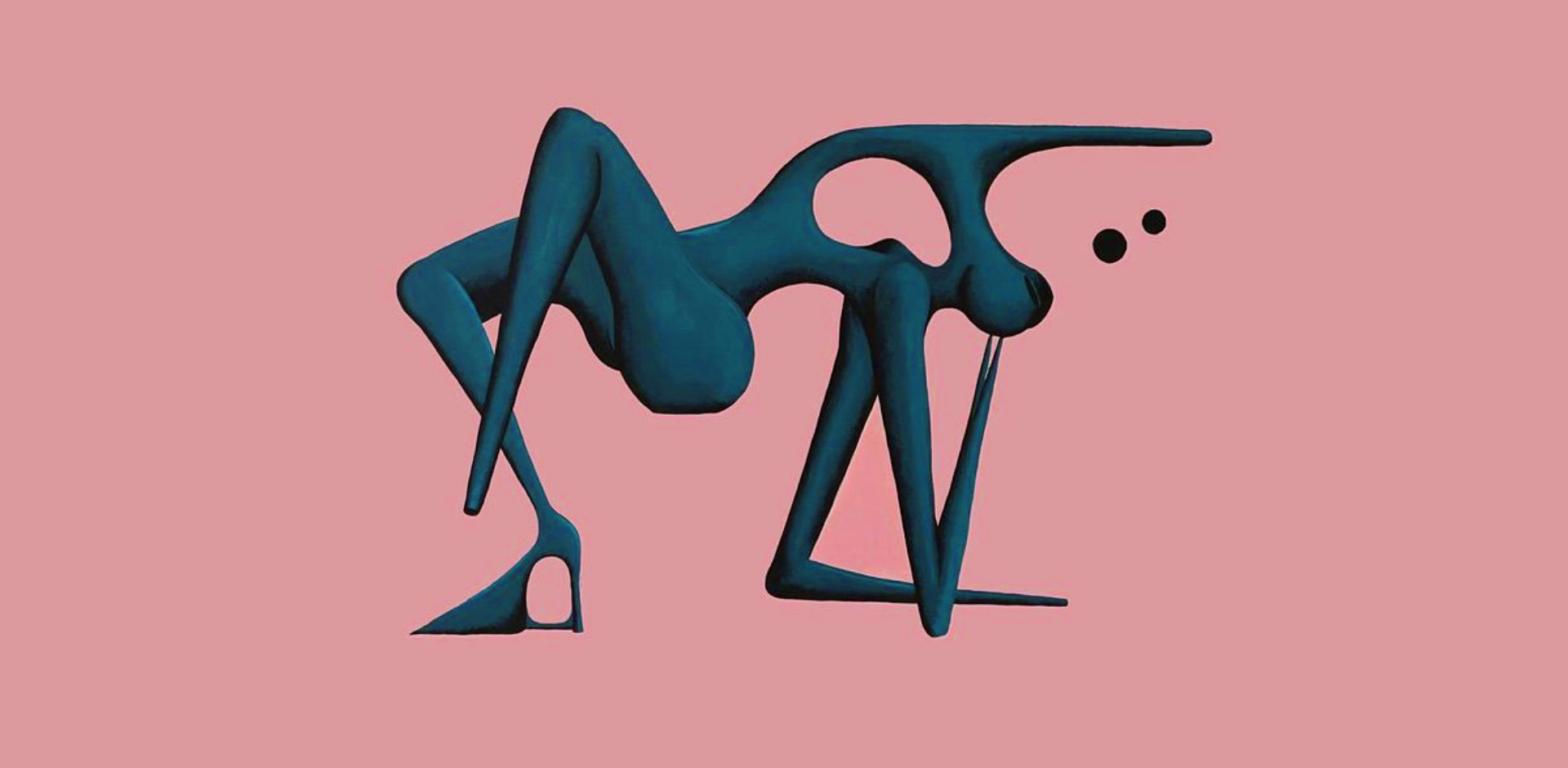
Having presented in both group and duo exhibitions internationally, producing album covers and poster artwork for artists such as Jex Opolis, Rat & Co, Moodymann and Ge-ology New York based artist Elvis Barlow-Smith presents his first solo exhibition ‘Poolside’.
‘Poolside’ is a series of paintings that explore exaggerated shapes, postures, and shadows created by bare bodied structures. The figures are presented in moments of leisure and indulgence by the pool.














